
Title: The Philosophy of Health; Volume 1 (of 2)
Author: Southwood Smith
Release date: November 23, 2019 [eBook #60773]
Most recently updated: October 17, 2024
Language: English
Credits: Produced by Chris Curnow, Brian Wilsden and the Online
Distributed Proofreading Team at http://www.pgdp.net (This
file was produced from images generously made available
by The Internet Archive)

The cover image was created by the transcriber and is placed in the public domain.
OR,
AN EXPOSITION
OF THE
PHYSICAL AND MENTAL CONSTITUTION OF MAN,
WITH A VIEW TO THE PROMOTION OF
HUMAN LONGEVITY AND HAPPINESS.
BY
SOUTHWOOD SMITH, M.D.,
Physician to the London Fever Hospital, to the Eastern Dispensary, and to the Jews' Hospital.
IN TWO VOLUMES. Vol. I.
THIRD EDITION.
LONDON:
C. COX, 12, KING WILLIAM STREET, STRAND.
1847.
London: Printed by W. Clowes and Sons, Stamford Street.
| Introduction | Page 1 | |
| CHAPTER I. | ||
| Characters by which living beings are distinguished from inorganic bodies—Characters by which animals are distinguished from plants—Actions common to plants and animals—Actions peculiar to animals—Actions included in the ORGANIC circle—Actions included in the ANIMAL circle—Organs and functions defined—Action of physical agents on organized structures—Processes of supply, and processes of waste—Reasons why the structure of the animal is more complex than that of the plant | 13 | |
| CHAPTER II. | ||
| Two distinct lives combined in the animal—Characters of the apparatus of the organic life—Characters of the apparatus of the animal life—Characteristic differences in the action of each—Progress of life—Progress of death | 51 | |
| CHAPTER III. | ||
| Ultimate object of organization and life—Sources | ||
| of pleasure—Special provision by which the organic organs influence consciousness and afford pleasure—Point at which the organic organs cease to affect consciousness [Pg iv] and why—The animal appetites: the senses: the intellectual faculties: the selfish and sympathetic affections: the moral faculty—Pleasure the direct, the ordinary, and the gratuitous result of the action of the organs—Pleasure conducive to the development of the organs, and to the continuance of their action—Progress of human knowledge—Progress of human happiness | 73 | |
| CHAPTER IV. | ||
| Relation between the physical condition and happiness, and between happiness and longevity—Longevity a good, and why—Epochs of life—The age of maturity the only one that admits of extension—Proof of this from physiology—Proof from statistics—Explanation of terms—Life a fluctuating quantity—Amount of it possessed in ancient Rome: in modern Europe: at present in England among the mass of the people and among the higher classes | 106 | |
| CHAPTER V. | ||
| Ultimate elements of which the body is composed— Proximate principles—Fluids and solids—Primary tissues— Combinations—Results—Organs, systems, apparatus— Form of the body—Division into head, trunk, and extremities—Structure and function of each—Regions— Seats of the more important internal organs | 148 | |
| CHAPTER VI. | ||
| Of the blood—Physical characters of the blood: colour, fluidity, specific gravity, temperature; quantity—Process of coagulation —Constituents of the blood; proportions—Constituents of the body contained in the blood—Vital properties of the blood —Practical applications | 334 | |
| CHAPTER VII.[Pg v] | ||
| Of the circulation—Vessels connected with the heart; chambers of the heart—Position of the heart—Pulmonic circle; systemic circle—Structure of the heart, artery, and vein—Consequences of the discovery of the circulation to the discoverer—Action of the heart; sounds occasioned by its different movements—Contraction; dilatation—Disposition and action of the valves—Powers that move the blood —Force of the heart—Action of the arterial tubes; the pulse; action of the capillaries; action of the veins—Self-moving power of the blood—Vital endowment of the capillaries; functions—Practical applications | 357 | |
| FOOTNOTES. | 408 |
The object of the present work is to give a brief and plain account of the structure and functions of the body, chiefly with reference to health and disease. This is intended to be introductory to an account of the constitution of the mind, chiefly with reference to the development and direction of its powers. There is a natural connexion between these subjects, and an advantage in studying them in their natural order. Structure must be known before function can be understood: hence the science of physiology is based on that of anatomy. The mind is dependent on the body: hence an acquaintance with the physiology of the body should precede the study of the physiology of the mind. The constitution of the mind must be understood before its powers and affections can be properly developed and directed: hence a knowledge of the physiology of the mind is essential to a sound view of education and morals.
In the execution of the first part of this work, that which relates to the organization of the body, [Pg 2] a formidable difficulty presents itself at the outset. The explanation of structure is easy when the part described can be seen. The teacher of anatomy finds no difficulty in communicating to the student a clear and exact knowledge of the structure of an organ; because, by the aid of dissection, he resolves the various complex substances, of which it is built up, into their constituent parts, and demonstrates the relation of these elementary parts to each other. But the case is different with him who attempts to convey a knowledge of the structure of an organ merely by the description of it. The best conceived and executed drawing is a most inadequate substitute for the object itself. It is impossible wholly to remove this difficulty: what can be done, by the aid of plates, to lessen it, is here attempted. A time may come when the objects themselves will be more generally accessible: meanwhile, the description now given of the chief organs of the body may facilitate the study of their structure to those who have an opportunity of examining the organs themselves, and will, it is hoped, enable every reader at once to understand much of their action.
Physical science has become the subject of popular attention, and men of the highest endowments, who have devoted their lives to the cultivation [Pg 3] of this department of knowledge, conceive that they can make no better use of the treasures they have accumulated, than that of diffusing them. Of this part of the great field of knowledge, to make "the rough places plain, and the crooked places straight," is deemed a labour second in importance only to that of extending the boundaries of the field itself. But no attempt has hitherto been made to exhibit a clear and comprehensive view of the phenomena of life; the organization upon which those phenomena depend; the physical agents essential to their production, and the laws, as far as they have yet been discovered, according to which those agents act. The consequence is, that people in general, not excepting the educated class, are wholly ignorant of the structure and action of the organs of their own bodies, the circumstances which are conducive to their own health, the agents which ordinarily produce disease, and the means by which the operation of such agents may be avoided or counteracted; and they can hardly be said to possess more information relative to the connexion between the organization of the body and the qualities of the mind, the physical condition and the mental state; the laws which regulate the production, combination, and succession of the trains of pleasurable [Pg 4] and painful thought, and the rules deducible from those laws, having for their object such a determination of voluntary human conduct, as may secure the pleasurable and avoid the painful.
Yet nothing would seem a fitter study for man than the nature of man in this sense of the term. A knowledge of the structure and functions of the body is admitted to be indispensable to whoever undertakes, as the business of his profession, to protect those organs from injury, and to restore their action to a sound state when it has become disordered; but surely some knowledge of this kind may be useful to those who have no intention to practise physic, or to perform operations in surgery; may be useful to every human being, to enable him to take a rational care of his health, to make him observant of his own altered sensations, as indications of approaching sickness; to give him the power of communicating intelligibly with his medical adviser respecting the seat and the succession of those signs of disordered function, and to dispose and qualify him to co-operate with his physician in the use of the means employed to avert impending danger, or to remove actual disease.
But if to every human being occasions must continually occur, when knowledge of this kind [Pg 5] would be useful, the possession of it seems peculiarly necessary to those who have the exclusive care of infancy, almost the entire care of childhood, a great part of the care of the sick, and whose ignorance, not the less mischievous because its activity is induced by affection, constantly endangers, and often defeats, the best concerted measures of the physician.
The bodily organization and the mental powers of the child depend mainly on the management of the infant; and the intellectual and moral aptitudes and qualities of the man have their origin in the predominant states of sensation, at a period far earlier in the history of the human being than is commonly imagined. The period of infancy is divided by physiologists into two epochs; the first, commencing from birth, extends to the seventh month: the second, commencing from the seventh month, extends to the end of the second year, at which time the period of infancy ceases, and that of childhood begins. The first epoch of infancy is remarkable for the rapidity of the development of the organs of the body: the processes of growth are in extreme activity; the formative predominates over the sentient life, the chief object of the action of the former being to prepare the apparatus of the latter. The second epoch of [Pg 6] infancy is remarkable for the development of the perceptive powers. The physical organization of the brain, which still advances with rapidity, is now capable of a greater energy, and a wider range of function. Sensation becomes more exact and varied; the intellectual faculties are in almost constant operation; speech commences, the sign, and, to a certain extent, the cause of the growing strength of the mental powers; the capacity of voluntary locomotion is acquired, while passion, emotion, affection, come into play with such constancy and energy, as to exert over the whole economy of the now irritable and plastic creature a prodigious influence for good or evil. If it be, indeed, possible to make correct moral perception, feeling, and conduct, a part of human nature, as much a part of it as any sensation or propensity—if this be possible for every individual of the human race, without exception, to an extent which would render all more eminently and consistently virtuous than any are at present (and of the possibility of this, the conviction is the strongest in the acutest minds which have studied this subject the most profoundly), preparation for the accomplishment of this object must be commenced at this epoch. But if preparation for this object be really commenced, it [Pg 7] implies, on the part of those who engage in the undertaking, some degree of knowledge; knowledge of the physical and mental constitution of the individual to be influenced; knowledge of the mode, in which circumstances must be so modified in adaptation to the nature of the individual being, as to produce upon it, with uniformity and certainty, a given result. The theory of human society, according to its present institutions, supposes that this knowledge is possessed by the mother; and it supposes, further, that this adaptation will actually take place in the domestic circle through her agency. Hence the presumed advantage of having the eye of the mother always upon the child; hence the apprehension of evil so general, I had almost said instinctive, whenever it is proposed to take the infant, for the purpose of systematic physical and mental discipline, from beyond the sphere of maternal influence. But society, which thus presumes that the mother will possess the power and the disposition to do this, what expedients has it devised to endow her with the former, and to secure the formation of the latter? I appeal to every woman whose eye may rest on these pages. I ask of you, what has ever been done for you to enable you to understand the physical and mental constitution of that [Pg 8] human nature, the care of which is imposed upon you? In what part of the course of your education was instruction of this kind introduced? Over how large a portion of your education did it extend? Who were your teachers? What have you profited by their lessons? What progress have you made in the acquisition of the requisite information? Were you at this moment to undertake the guidance of a new-born infant to health, knowledge, goodness, and happiness, how would you set about the task? How would you regulate the influence of external agents upon its delicate, tender, and highly-irritable organs, in such a manner as to obtain from them healthful stimulation, and avoid destructive excitement? What natural and moral objects would you select as the best adapted to exercise and develope its opening faculties? What feelings would you check, and what cherish? How would you excite aims; how would you apply motives? How would you avail yourself of pleasure as a final end, or as the means to some further end? And how would you deal with the no less formidable instrument of pain? What is your own physical, intellectual, and moral state, as specially fitting you for this office? What is the measure of your own self-control, without a large portion of which no [Pg 9] human being ever yet exerted over the infant mind any considerable influence for good? There is no philosopher, however profound his knowledge, no instructor, however varied and extended his experience, who would not enter upon this task with an apprehension proportioned to his knowledge and experience; but knowledge which men acquire only after years of study, habits which are generated in men only as the result of long-continued discipline, are expected to come to you spontaneously, to be born with you, to require on your part no culture, and to need no sustaining influence.
But, indeed, it is a most inadequate expression of the fact, to say that the communication of the knowledge, and the formation of the habits which are necessary to the due performance of the duties of women, constitute no essential part of their education: the direct tendency of a great part of their education is to produce and foster opinions, feelings, and tastes, which positively disqualify them for the performance of their duties. All would be well if the marriage ceremony, which transforms the girl into the wife, conferred upon the wife the qualities which should be possessed by the mother. But it is rare to find a person capable of the least difficult part of education, [Pg 10] namely, that of communicating instruction, even after diligent study, with a direct view to teaching; yet an ordinary girl, brought up in the ordinary mode, in the ordinary domestic circle, is intrusted with the direction and control of the first impressions that are made upon the human being, and the momentous, physical, intellectual, and moral results that arise out of those impressions!
I am sensible of the total inadequacy of any remedy for this evil, short of a modification of our domestic institutions. Mere information, however complete the communication of it, can do little beyond affording a clearer conception of the end in view, and of the means fitted to secure it. Even this little, however, would be something gained; and the hope of contributing, in some degree, to the furtherance of this object, has supplied one of the main motives for undertaking the present work. Meantime, women are the earliest teachers; they must be nurses; they can be neither, without the risk of doing incalculable mischief, unless they have some understanding of the subjects about to be treated of. On these grounds I rest their obligation to study them; and I look upon that notion of delicacy, which would exclude them from knowledge calculated, in an extraordinary [Pg 11] degree, to open, exalt, and purify their minds, and to fit them for the performance of their duties, as alike degrading to those to whom it affects to show respect, and debasing to the mind that entertains it.
Though each part of this work will be made as complete in itself as the author is capable of rendering it, and to that extent independent of any other part, yet there will be found to be a strict connexion between the several portions of the whole; and greatly as the topics included in the latter differ from those which form the earlier subjects, the advantage of having studied the former before the latter are entered on, will be felt precisely as the word study can be justly applied to the operation of the mind on such matters.
In the expository portion of the work I have not been anxious to abstain from the employment of technical terms, when a decidedly useful purpose was to be obtained by the introduction of them; but I have been very careful to use no such term without assigning the exact meaning of it. A technical term unexplained is a dark spot on the field of knowledge; explained, it is a clear and steady light.
In order really to understand the states of health and disease, an acquaintance with the nature of [Pg 12] organization, and of the vital processes of which it is the seat and the instrument, is indispensable: it is for this reason that the exposition of structure and function, attempted in this first part of the work, is somewhat full; but there cannot be a question that, if it accomplish its object, it will not only enable the account of health and disease in the subsequent part of it to be much more brief, but that it will, at the same time, render that account more intelligible, exact, and practical.
S. S.
THE
PHILOSOPHY OF HEALTH.
Characters by which living beings are distinguished from inorganic bodies—Characters by which animals are distinguished from plants—Actions common to plants and animals—Actions peculiar to animals—Actions included in the organic circle—Actions included in the animal circle—Organs and functions defined—Action of physical agents on organized structures—Processes of supply, and processes of waste—Reasons why the structure of the animal is more complex than that of the plant.
The distinction between a living being and an inorganic body, between a plant and a stone, is, that the plant carries on a number of processes which are not performed by the stone. The plant absorbs food, converts its food into its own proper substance, arranges this substance into bark, wood, vessels, leaves, and other organized structures; grows, arrives at maturity, and decays; generates and maintains a certain degree of heat; derives from a parent the primary structure and the first impulse upon which these varied [Pg 14] actions depend; gives origin to a new being similar to itself, and, after a certain time, terminates its existence in death.
No such phenomena are exhibited by the stone; it neither absorbs food, nor arranges the matter of which it is composed into organized structure; nor grows, nor decays, nor generates heat, nor derives its existence from a parent, nor gives origin to a new being, nor dies. Nothing analogous to the processes by which these results are produced, is observable in any body that is destitute of life; all of them are carried on by every living creature. These processes are, therefore, denominated vital, and, being peculiar to the state of life, they afford characters by which the living being is distinguished from the inorganic body.
In like manner the distinction between an animal and a plant is, that the animal possesses properties of which the plant is destitute. It is endowed with two new and superior powers, to which there is nothing analogous in the plant; namely, the power of sensation, and the power of voluntary motion; the capacity of feeling, and the capacity of moving from place to place as its feeling prompts. The animal, like the plant, receives food, transforms its food into its own proper substance, builds this substance up into structure, generates, and maintains a certain temperature, derives its existence from a parent, produces an offspring like itself, and terminates its existence in [Pg 15] death. Up to this point the vital phenomena exhibited by both orders of living creatures are alike: but at this point the vital processes of the plant terminate, while those of the animal are extended and exalted by the exercise of the distinct and superior endowments of sensation and voluntary motion. To feel, and to move spontaneously, in accordance with that feeling, are properties possessed by the animal, but not by the plant; and therefore these properties afford characters by which the animal is distinguished from the plant.
The two great classes of living beings perform, then, two distinct sets of actions: the first set is common to all living creatures; the second is peculiar to one class: the first set is indispensable to life; the second is necessary only to one kind of life, namely, the animal. The actions included in the first set, being common to all living or organized creatures, are called ORGANIC; the actions included in the second class, belonging only to one part of living or organized creatures, namely, animals, are called ANIMAL. The ORGANIC actions consist of the processes by which the existence of the living being is maintained, and the perpetuation of its species secured: the ANIMAL actions consist of the processes by which the living being is rendered percipient, and capable of spontaneous motion. The ORGANIC processes comprehend those of nutrition, respiration, circulation, secretion, excretion, and reproduction; the first five [Pg 16] relate to the maintenance of the life of the individual being; the last to the perpetuation of its species. The ANIMAL processes comprehend those of sensation and of voluntary motion, often denominated processes of relation, because they put the individual being in communication with the external world. There is no vital action performed by any living creature which may not be included in one or other of these processes, or in some modification of some one of them. There is no action performed by any inorganic body which possesses even a remote analogy to either of these vital processes. The line of demarcation between the organic and the inorganic world is, therefore, clear and broad; and the line of demarcation between the two great divisions of the organic world, between the inanimate and the animate, that is, between plants and animals, is no less decided: for, of the two sets of actions which have been enumerated, the one, as has just been stated, is common to the whole class of living beings, while the second set is peculiar to one division of that class. The plant performs only the organic actions: all the vital phenomena it exhibits are included in this single circle; it is, therefore, said to possess only organic life: but the animal performs both organic and animal actions, and is therefore said to possess both organic and animal life.
Both the organic and the animal actions are [Pg 17] accomplished by means of certain instruments, that is, organized bodies which possess a definite structure, and which are moulded into a peculiar form. Such an instrument is called an organ, and the action of an organ is called its function. The leaf of the plant is an organ, and the conversion of sap by the leaf into the proper juice of the plant, by the process called respiration, is the function of this organ. The liver of the animal is an organ; and the conversion of the blood that circulates through it into bile, by the process of secretion, is its function. The brain is an organ; the sentient nerve in communication with it is also an organ. The extremity of the sentient nerve receives an impression from an external object, and conveys it to the brain, where it becomes a sensation. The transmission of the impression is the function of the nerve; the conversion of the impression into a sensation is the function of the brain.
The living body consists of a congeries of these instruments or organs: the constituent matter of these organs is always partly in a fluid and partly in a solid state. Of the fluids and solids which thus invariably enter in combination into the composition of the organs, the fluids may be regarded as the primary and essential elements, for they are the source and the support of the solids. There is no solid which is not formed out of a fluid; no solid which does not always contain, as a constituent [Pg 18] part of it, some fluid, and none which is capable of maintaining its integrity without a continual supply of fluids.
Whatever be the intimate composition of the fluids out of which the solids are formed, the investigation of which is more difficult than that of the solids and the nature of which is therefore less clearly ascertained, it is certain that all the matter which enters into the composition of the solid is disposed in a definite order. It is this disposition of the constituent matter of the living solid in a definite order that constitutes the arrangement so characteristic of all living substance. Definite arrangements are combined in definite modes, and the result is what is termed organization. From varied arrangements result different kinds of organized substances, each endowed with different properties, and exhibiting peculiar characters. By the recombination of these several kinds of organized substances, in different proportions and different modes, are formed the special instruments, or organs, of which we have just spoken; while it is the combining, or the building up of these different organized substances into organs, that constitutes structure.
In the living body, not only is each distinct organ alive, but, with exceptions so slight that they need not be noticed here, every solid which enters into the composition of the organ is endowed with vital properties. This is probably the [Pg 19] case with the primary substances or tissues which compose the several organs of the plant; but that the animal solids are alive is indubitable; nay, the evidence is complete, that many even of the animal fluids possess vitality. The blood in the animal is as truly alive as the brain, and the bone as the flesh. The organized body, considered as a whole, is the seat of life; but life also resides in almost every component part of it.
Yet the matter out of which these living substances is formed is not alive. By processes of which we know nothing, or, at least, of which we see only the first steps,—matter, wholly destitute of life, is converted into living substance. The inorganic matter, which is the subject of this wonderful transformation, is resolvable into a very few elementary substances. In the plant, these substances consist of three only, namely, oxygen, hydrogen, and carbon. The first two are aëriform or gaseous bodies; the last is a solid substance, and it is of this that the plant is chiefly composed: hence the basis of the plant is a solid. The elementary bodies, into which all animal substance is resolvable, are four, namely, azote, oxygen, hydrogen, and carbon. Into every animal fluid and solid this new substance azote enters so largely, that it may be considered as the fundamental and distinctive element of the animal organization: hence the basis of the animal is an aëriform or gaseous fluid. The animal is composed [Pg 20] of air, the plant of solid matter; and this difference in their elementary nature gives origin to several distinctive characters between the plant and the animal, in addition to those which have been already stated.
Thus the characters of the plant are solidity, hardness, fixedness, and durability; while the animal is comparatively fluid, soft, volatile, and perishable; and the reason is now manifest. The basis of the animal being an aëriform fluid, its consistence is softer than that of the plant, the basis of which is a firm solid; and, at the same time, the component elements of the animal being more numerous than those of the plant, and the fluidity of these elements, and of the compounds they form, greatly favouring their action and reaction on each other and on external agents, the animal body is more volatile and perishable during life, and more readily decomposed after death.
It has been stated, that the object of every structure or organ of the living body, is the performance of some special action or function,—the ultimate object of the fluids being the production of the solids; the ultimate object of the solids being the formation of organs; the ultimate object of organs being the performance of actions or functions; while it is in the performance of actions or functions that life consists. Functions carried on by organs; organs in action; special organs performing definite actions, this it is that [Pg 21] constitutes the state of life. Every particle of matter which enters into the composition of the living body has thus its own place, forming, or destined to form, a constituent part of some organ; every organ has its own action; all the organs of the body form the body; and all the actions of all the organs constitute the aggregate of the vital phenomena.
Every organ is excited to action, or its function is called into operation by means of some external body. The external bodies capable of exciting and maintaining the functions of living organs, consist of a definite class. Because these bodies belong to that department of science which is called physical, they are termed physical agents. They are air, water, heat, cold, electricity, and light. Without the living organ, the physical agent can excite no vital action: without the physical agent, the living organ can carry on no vital process. The plant cannot perform the vital process of respiration without the leaf, nor, with the leaf, without air. The physical agent acts upon the living organ; the living organ reacts upon the physical agent, and the action between both is definite. In the lung of the animal a certain principle of the air unites, in definite proportions, with a certain principle of the blood; the oxygen of the air combines with the carbon of the blood; the air is changed by the abstraction of its oxygen; the blood is changed by the abstraction of [Pg 22] its carbon. Atmospheric air goes to the lung, but atmospheric air does not return from the lung; it is converted into a new substance by the action of the organ: it is changed into carbonic acid by the union of a given quantity of oxygen, which it transmits to the organ, with a given quantity of carbon which the organ conveys to it. Venous blood goes to the lung, but venous blood does not return from the lung; it is converted, by the instrumentality of the organ, into a new substance, into arterial blood, by giving to the air carbon, and by receiving from the air oxygen. In this manner the change in the physical agent is definite and uniform; and the change in the living substance is equally definite and uniform.
It is this determinate interchange of action between the living organ and the physical agent that constitutes what is termed a vital process. All vital processes are carried on by living organs; the materials employed in all vital processes are physical agents; the processes themselves are vital functions. All the changes produced by all the organs of the plant upon physical agents, and all the changes produced by all physical agents upon the organs of the plant, constitute all the vital processes of the plant—comprehend the whole sum of its vital phenomena. The root, the trunk, the woody substance, the bark, the ascending vessels bearing sap, the descending vessels bearing secreted fluids, the leaves, the flowers, [Pg 23] these are the living organs of the plant. Air, water, heat, cold, electricity, light, these are the physical agents which produce in these organs definite changes, and which are themselves changed by them in definite modes; and the whole of these changes, taken together, comprehend the circle of actions, or the range of functions performed by this living being.
In the state of life, during the interchange of action which thus incessantly goes on between physical agents and vital organs, the laws to which inorganic matter is subject are resisted, controlled, and modified. Physical and chemical attractions are brought under the influence of a new and superior agency, with the laws of which we are imperfectly acquainted, but the operation of which we see, and which we call the agency of life. Air, water, heat, electricity, are physical agents, which subvert the most intimate combinations of inorganic bodies, resolving them into their simple elements, and recombining these elements in various modes, and thus forming new bodies, endowed with totally different properties; but the physical and chemical agencies by which these changes are wrought in the inorganic, are resisted, controlled, and modified by the living body: resisted, for these physical agents do not decompose the living body; controlled and modified, for the living body converts these very agents into the material for sustaining its own existence [Pg 24] Of all the phenomena included in that circle of actions which we designate by the general term life, this power of resisting the effects universally produced by physical agents on inorganic matter, and of bringing these very agents under subjection to a new order of laws, is one of the most essential and distinctive.
All vital processes are processes of supply, or processes of waste. By every vital action performed by the organized body, some portion of its constituent matter is expended. Numerous vital actions are constantly carried on for the sole purpose of compensating this expenditure. Every moment old particles are carried out of the system; every moment new particles are introduced into it. The matter of which the organized, and more especially the animal, body is composed, is thus in a state of perpetual flux; and in a certain space of time it is completely changed, so that of all the matter that constitutes the animal body at a given point of time, not a single particle remains at another point of time at a given distance.
All the wants of the economy of the plant are satisfied by a due supply of air, water, heat, cold, electricity, and light. Some of these physical agents constitute the crude aliment of the plant; others produce in this aliment a series of changes, by which it is converted from crude aliment into proper nutriment, while others act as stimulants, by which movements are excited, the ultimate [Pg 25] object of which is the distribution of the nutriment to the various parts of the economy of the plant.
The same physical agents are indispensable to the support of the animal body; but the animal cannot be sustained by these physical agents alone; for the maintenance of animal life, in some shape or other, vegetable or animal matter, or both in a certain state of combination, must be superadded: hence another distinction between the plant and the animal,—the necessity, on the part of the animal, of an elaborated aliment to maintain its existence. By the vital processes of its economy, the plant converts inorganic into organic matter; by the vital processes of its economy, the animal converts matter, already rendered organic, into its own proper substance. The plant is thus purveyor to the animal: but it is more than purveyor to it; for while it provides, it also prepares its food; it saves the animal one process, that of the transmutation of inorganic into organic matter. The ultimate end, or the final cause of the vital processes performed by the first class of living beings, is thus the elaboration of aliment for the second: the inferior life is spent in ministering, and the great object of its being is to minister to the existence of the superior.
At the point at which organization commences structure is so simple that there is no manifest distinction of organs. Several functions are performed [Pg 26] apparently by one single organized substance. The lowest plants and the lowest animals are equally without any separate organs, as far as it is in our power to distinguish them, for carrying on the vital actions they perform. An organized tissue, apparently of an homogeneous nature, containing fluid matter, is all that can be made out by which the most simply-constructed plant carries on its single set, and by which the most simply-constructed animal carries on its double set, of actions. But this simplicity of structure exists only at the very commencement of the organized world. Every advancement in the scale of organization is indicated by the construction of organs manifestly separate for the performance of individual functions; and, invariably, the higher the being, the more complete is this separation of function from function, and, consequently, the greater the multiplication of organs, and the more elaborate and complex the structure;—and hence another distinction between the plant and the animal. The simplicity of the structure of the plant is in striking contrast to the complexity of the structure of the animal; and this difference is not arbitrary; it is a matter of absolute necessity, and the reason of this necessity it will be instructive to contemplate.
The plant, as has been shown, performs only one set of functions, the organic; while the animal performs two sets of functions, the organic and the animal. The animal, then, performs more [Pg 27] functions than the plant, and functions of a higher order; it carries on its functions with a greater degree of energy; its functions have a more extended range, and all its functions bear a certain relation to each other, maintaining an harmonious action. The number, the superiority, the relation, the range, and the energy of the functions performed by the animal are, then, so many conditions, which render it absolutely indispensable that it should possess a greater complexity of structure than the plant.
1. To build up structure is to create, to arrange, and to connect organs. Organs are the instruments by which functions are performed, and without the instrument there can be no action. With as many more organs than the plant possesses the animal must, therefore, be provided, as are necessary to carry on the additional functions it performs. Organs, for its organic functions, it must have as well as the plant; but to these must be superadded organs of another class, for which the plant has no need, namely, organs for its animal functions. Two sets of organs must, therefore, be provided for the animal, while the plant requires but one.
2. Some functions performed by the animal are of a higher order than any performed by the plant, and the superior function requires a higher organization. The construction of an organ is complex as its action is elevated; the instrument is [Pg 28] elaborately prepared in proportion to the nobleness of its office.
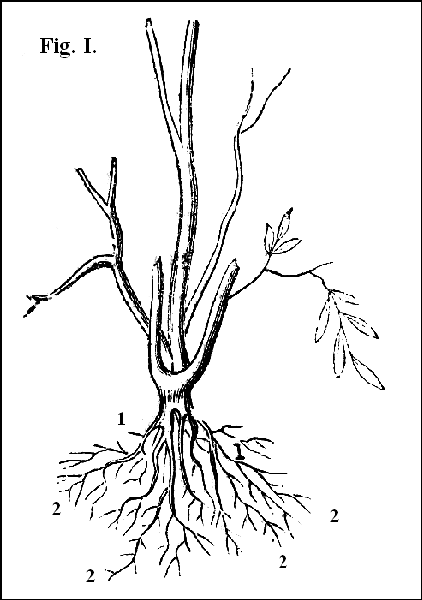

3. But this is not all; for the addition of a superior function requires not only the addition of an organ having a corresponding superiority of structure, but it requires, further, that a certain elevation of structure should be communicated to all the organs of all the inferior functions, on account of the relation which it is necessary to establish between function and function. Unless the organ of an inferior function be constructed with a perfection corresponding to that of the organ of a superior function, the inferior will be incapable of working in harmony with the superior. Take, for example, the inferior function of nutrition: nutrition is an organic function equally necessary to the plant and to the animal, and requiring in both organs for performing it; but this function cannot be performed in the animal by organs as simple as suffice for the plant. Nutrition, in the plant, is carried on in the following mode:—The root of the plant is divided, like the trunk, into numerous branches (fig. I. 1). These branches divide and subdivide into smaller and smaller branches, until at last they reach an extreme degree of minuteness (fig. I. 2 2). The smallest of these divisions, called, from their hair-like tenuity, capillary (fig. I. 2 2), are provided with a peculiar structure, which is endowed with a specific function. In most plants this peculiar structure [Pg 29] is found at the terminal point of the rootlet (fig. I. 2 2); but in some plants the capillary branches of the rootlets are provided with distinct bodies (fig. II. 1 2), scarcely to be discerned when the root has been removed some time from the soil, and has become dry (fig. II. 2 2); but which, in a few minutes after the root has been plunged in water, provided the plant be still alive, become turgid with fluid, and, consequently, distinctly visible (fig. II. 1 1 1). These bodies, when they exist, or the terminal point of the rootlet when these bodies are absent, are termed spongeolæ, or spongeoles; and the structure and function of the organ, in both cases, are conceived to be precisely the same. In both the organ consists of a minute [Pg 30] cellular structure. Fig. III. 1, shows this structure as it appears when the object is magnified. The office of this organ is to absorb the aliment of the plant from the soil; and so great is its absorbing power, that, as is proved by direct experiment, it absorbs the colouring molecules of liquids, though these molecules will not enter the ordinary pores, which are of much greater magnitude. With the spongeoles are connected vessels which pass through the substance of the stem or trunk to the leaf. Fig. III. 2, shows these tubes springing from the cellular structure of the spongeole, and passing up to the stem or trunk. Fig. IV. 2, exhibits a magnified view of the appearance of the mouths of these tubes on making an horizontal section of the spongeole. Fig. V. 1 1 1, exhibits a view of these tubes passing to the leaf. Figs. VI. and VII. 1 1 1 1, show these vessels spread out upon, and ramifying through, the leaf. The crude aliment, borne by these tubes to the leaf, is there converted into proper nutriment; and from the leaf, when duly elaborated, [Pg 31] this proper nutriment is carried out by ducts to the various organs of the plant, in order to supply them with the aliment they need.
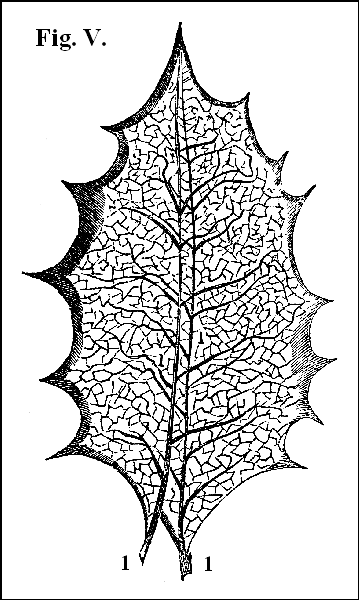
Now, for carrying on the process of nutrition in this mode, there must be organs to absorb the crude aliment, organs to convey the crude aliment to the laboratory, the leaf, in which it is converted into proper nutriment; and, finally, organs for carrying out this proper nutriment to the system. Complication of structure, to this extent, is indispensable; and, accordingly, with spongeolæ, with sap-vessels, with leaves, with distributive ducts, the plant is provided. Without all the parts of this apparatus it could not carry on its function: any further complication would be useless.

But, suppose a new and superior function to be added to the plant; suppose it to be endowed with the power of locomotion, what would be the consequence of communicating to it this higher power? That its former state of simplicity would [Pg 33] no longer suffice for the inferior function. Why? because the exercise of the superior would interrupt the action of the inferior function. Nutrition by imbibition, and the exercise of locomotion, cannot go on simultaneously in the same being. The plant is fixed in the soil by its roots; and from this, its state of immobility, results this most important consequence, that its spongeolæ are always in contact with its food.

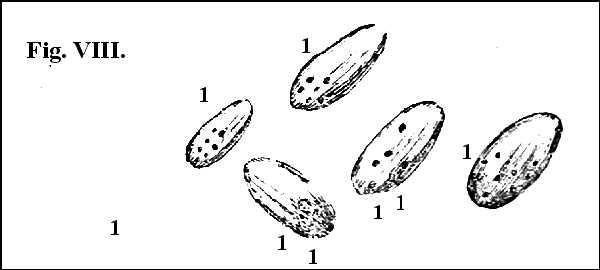
But we may imagine a plant not fixed to the soil; a plant so constituted as to be capable of moving from place to place; such a plant would not be always in contact with its food, and therefore, as it exercised its faculty of locomotion, it [Pg 34] could not but interrupt or suspend its function of nutrition. In a being capable of carrying on these two functions simultaneously, the entire apparatus of the function of nutrition must then be modified. Instead of having spongeolæ fixed immovably in the earth, and spread out in a soil adapted to transmit to these organs nutrient matter in a state fitted for absorption, it must be provided with a reservoir for containing its food, in order that it may carry its aliment about with it in all its changes of place. And such is the modification uniformly found in all animals: an internal reservoir for containing its food is provided, perhaps, for every animal without exception. Even the simplest and minutest creatures with which the microscope has made us acquainted, the lowest tribes of the Infusoria (fig. VIII.), the sentient, self-moving cellules, placed at the very bottom of the animal scale, possess this modification of structure. For a long time it was conceived that these minute and simple creatures were without distinction of parts, that they had no separate organs for the reception and digestion of their food; that they absorbed their [Pg 35] aliment through the porous tissue of which their body is composed; that thus, instead of having a separate stomach, their entire body is a stomach, and instead of having even as much as a separate organ for absorption, like the more perfect plant, the whole body might be considered as a single spongeole.
But, by a simple and beautiful experiment, a German physiologist has shown the incorrectness of this opinion, and has established the fact, that the distinction between the plant and the animal, here contended for, is found even at the very lowest point of the animal scale. Like other physiologists, conceiving that the difficulty of discovering the structure of the lower tribes of the animalculi might be owing to the transparency or the tissues of which they are composed, it struck Ehrenberg, that if he could feed them with coloured substances, he might obtain some insight into their organization. In his first endeavours to accomplish this object he failed, for he employed the pigments in ordinary use; but either the animals would not touch aliment thus adulterated, or those that did so were instantly killed. It then occurred to him, that these colours are adulterated with lead and other substances, in all probability noxious to the little subjects of his experiment. "What I require," said he, "is some vegetable or animal colouring matter perfectly pure." He then tried perfectly pure indigo and perfectly pure [Pg 36] carmine. His success was now complete: in a minute or two, after mixing with their food pure vegetable colouring matter, he observed in the interior of the body of these creatures minute spots of a definite figure, and of the colour of the pigment employed (fig. VIII. 1 1 1 1). The form and magnitude of these spots were different in different tribes, but the same in the same individual, and even in the same species (fig. IX. 1 1, fig. X. 1 1). No other parts of the body were tinged with the colour, though the animals remained in the coloured fluid for days together. This was decisive. This physiologist had now obtained an instrument capable of revealing to him the interior organization of a class [Pg 37] of beings, the structure of which had heretofore been wholly unknown. On applying it to the Monas Termo (fig. VIII.), the animated point, or cellule, which stands at the bottom of the animal scale, he discovered, in the posterior portion of its body, several coloured spots which constitute its stomachs (fig. VIII. 1 1 1 1). The different situations [Pg 38] and different forms of the stomach in different tribes of these creatures, are represented by the coloured portions (fig. VIII. 1, fig. IX. 1, fig. X. 1), in which the currents of fluid flowing to their mouths are seen (fig. IX. 2, fig. X. 2). These experiments go far towards establishing the fact, that every animal, even the very lowest, has an external mouth and an internal stomach, and that it takes its food by an act of volition.
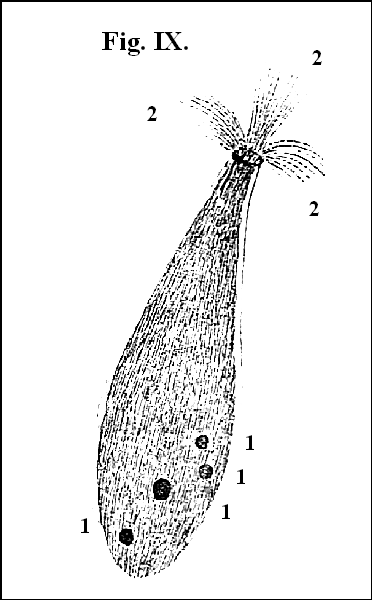
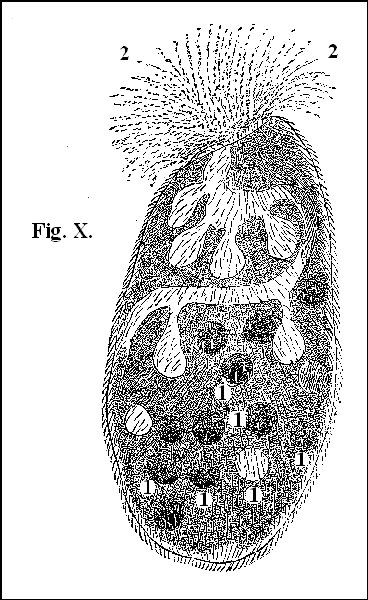
But if the proof of this must be admitted to be still imperfect with regard to the lowest tribes of animals, it is certain that, as we ascend in the scale of organization, the nutritive apparatus is uniformly arranged in this mode. Every animal of every class large enough to be distinctly visible, and the structure of which is not rendered inappreciable by the transparency of its solids and fluids, is manifestly provided with a distinct internal reservoir for containing its food. On the internal surface of this reservoir open the mouths of vessels, minute in size but countless in number, which absorb the food from the stomach.
Fig. XI. shows these vessels opening on the inner surface of the stomach, the white points representing their mouths, turgid with the food they have absorbed. Fig. XII. exhibits magnified views of the same vessels, the points representing their open mouths, and the lines the vessels themselves in continuation with their mouths. Fig. XIII. shows the appearance of the inner surface of the intestine [Pg 39] soon after the animal has taken food; the smaller white lines (1 1 1 1) representing the absorbent vessels full of digested food, and the larger lines (2 2 2 2) the trunks of the absorbent vessels formed by the union of many of the smaller.
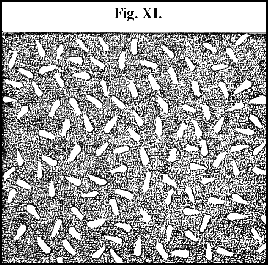

From this account, it is clear that the absorbing vessels of the stomach perform an office precisely analogous to that of the spongeoles of the root. What the soil is to the [Pg 40] plant, the stomach is to the animal. The absorbing vessels diffused through the stomach, as long as the stomach contains food, are in exactly the same condition as the spongeoles of the root spread out in the soil; and the absorbing vessels of the stomach are as much and as constantly in contact with the aliment, which it is their office to take into the system, as the spongeoles of the root. Such, then, is the expedient adopted to render the function of nutrition compatible with the function of locomotion. A reservoir of food is placed in the interior of the animal, provided with absorbent vessels which are always in contact with the aliment. In this mode, contact with aliment is not disturbed by continual change of place; the organic [Pg 41] process is not interrupted by the exercise of the animal function.
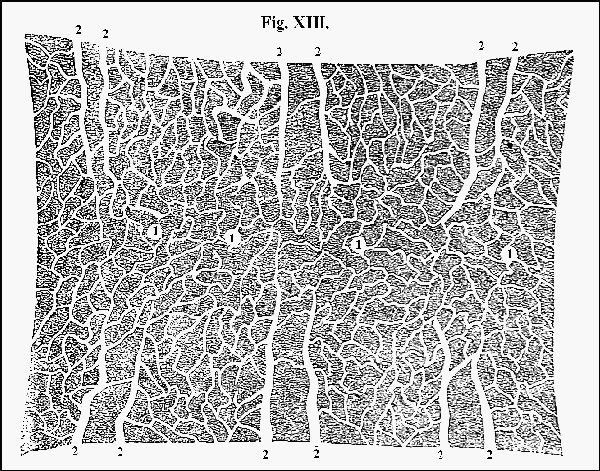
But the more elaborate organization which it is necessary to impart to the apparatus of the inferior function, in consequence of the communication of a superior faculty, is not completed simply by the addition of this new organ, the stomach. Other complications are indispensable; for if food be contained in an isolated organ, placed in the interior of the body, means must be provided for conveying the food into this organ; hence the necessity of an apparatus for deglutition. Moreover, the food having been conveyed to the stomach, and having undergone there the requisite changes, means must next be provided for conveying it from the stomach to the other parts of the body; hence the necessity of an apparatus for the circulation. But food, however elaborately prepared by the stomach, is incapable of nourishing the body, until it has been submitted to the action of atmospheric air; hence the necessity of an additional apparatus, either for conveying food to the air, or for transmitting air to the food, or for bringing both the food and the air into contact in the same organ. And, when structure after structure has been built up, in order to carry on this extended series of processes, the number of provisions required is not even yet complete; for of the most nutritious fond the whole mass is not nutritive; and even the whole of that portion of it which is [Pg 42] actually applied to the purpose of nutrition, becomes, after a time, worn out, and must be removed from the system; hence the necessity of a further apparatus for excretion.
That nutrition and locomotion may go on together, it is clear, then, that there must be provided a distinct apparatus for containing food, a distinct apparatus for deglutition, a distinct apparatus for circulation, a distinct apparatus for respiration, a distinct apparatus for excretion, and so on; and that, in this manner, the communication of a single function of a superior order renders a modification not merely of one but of many inferior functions absolutely indispensable, in order to adjust the one to the other, and to enable them to act in harmony.
But the necessary complication of structure does not stop even here; for the communication of one function of a superior order imposes the necessity of communicating still another. Locomotion cannot be exercised without perception; sensation is indispensable to volition, and volition, of course, to voluntary motion. A being endowed with the power of moving from place to place, without possessing the power of perceiving external objects, must be speedily destroyed. The communication of sensation to a creature fixed immovably to a single spot, conscious of the approach of bodies, but incapable of avoiding their contact, would be not only useless but pernicious, [Pg 43] since it would be to make a costly provision for the production of pain, and nothing else; but the communication of locomotion without sensation would be as unwisely defective, as the former would be perniciously expensive; since it would be to endow a being with a faculty, the exercise of which would be fatal to it for the want of a second faculty to guide the first. Nor could the possession of locomotion, without the further possession of sensation, be otherwise than fatal, for another reason. Consciousness is not necessary to nutrition as performed by the plant, but it is indispensable to nutrition as performed by the animal: for if the food of the animal be not always on the same spot with itself; if it be under the necessity of searching for it, and of conveying it, when found, into the interior of its body, it must, of course, possess the power of perceiving it when within its reach, and of apprehending and appropriating it by an act of volition, of none of which actions is it capable without the possession of sensation. Again, then, we see that, in order to secure harmonious action, function must be put in relation with function. In order to prevent jarring and mutually-destructive action, function must be superadded to function, and throughout the animal creation the complication of structure, which is necessary for the accomplishment of these ends, is given without parsimony, but without profusion: nothing is given which is not needed, nothing is withheld which is required.
4. As we ascend in the scale of organization, numerous functions being carried on, and numerous organs constructed for performing them, it is obvious that the range of each function must be proportionally extended; the range necessarily increasing with the multiplication of organ and function: and this is another cause of the unavoidable complication of structure. Slight consideration will suffice to show the necessary connexion between an extended range of action and complication of structure. Take, as an example, the organic function of respiration: respiration is the function by which air is brought into contact with food; it is the completion of digestion. The sole end of all the apparatus that belongs to this function is to bring the air and the food into a certain degree of proximity. Now, when all the substances that enter into the composition of the body of an animal are slight, delicate, and permeable to air (as in fig. XIV.), and when the body is always surrounded by air, air must at all times be in contact with the particular organ that contains the food, no less than with the general system to which the food is distributed. In this case, to construct a separate apparatus for containing air would be useless, because wherever food is, there air must be, since it constantly permeates every part of the body.

When, on the other hand, the tissues are so firm and dense as to be impermeable; when they are folded into bulky and complex organs, and when [Pg 45] these organs are placed in situations to which the external air cannot reach, the construction of a separate apparatus for respiration is indispensable. The respiratory apparatus consists either of organs for carrying air to the food, or of organs for carrying food to the air. The one or the other is adopted, according to the nature of the body. If the size of the animal be small; if the tissues which form the solid portion of its body be delicate in texture; if, at the same time, the wants of its economy require that its food should be highly aërated (for there is the closest connexion between energy of function and perfect aëration of [Pg 46] the food), an apparatus of sufficient magnitude to aërate the food in a high degree would occupy the entire bulk of the body. In such a case, it is easier to carry air to the food than food to the air; it is better to make the entire body a respiratory organ, than to construct a respiratory organ disproportioned to the magnitude of the body. Air-tubes diffused through every part of the body, and opening on its external surface, would obviously afford to every point of the system an easy access of air. By an expedient of this kind the system might be highly aërated, while the respiratory apparatus would occupy but a comparatively small space; the function might be performed on an extended scale, while there would be no necessity for encumbering a minute body with a bulky organ. And this is the mode in which respiration is carried on in large tribes of creatures, whose body is small in size and delicate in texture, and the functions of whose economy are performed with energy (fig. XV.).
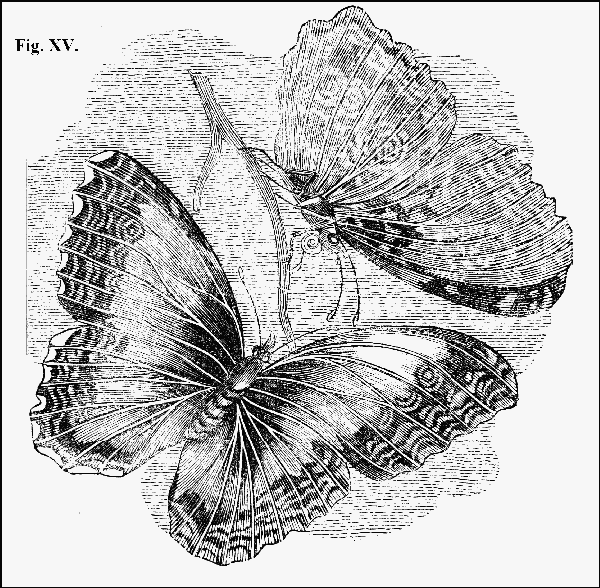
But this contrivance will not do when the animal is of large magnitude; when its body is divided into numerous compartments; when these compartments extend far beneath the external surface; when important organs are placed in deeply-seated cavities; and when the substances that compose the organs are dense, hard, thick, and convoluted. To construct air-tubes of the requisite diameter and length, always open, always [Pg 47] in a condition to permit the ingress and egress of an adequate current of air to and from the remotest nook and corner of a body such as this, would be difficult, if not impossible. At all events, it is easier, in such a case, to carry the food to the air, than the air to the food. But, for the accomplishment [Pg 48] of this purpose, what is necessary? An organ for containing food; an organ for containing air; vessels to carry food to and from the receptacle of the aliment; vessels to carry air to and from the receptacle of the air; expedients to expose a stream of food to a current of air; and, finally, tubes to carry out to the system the product of this complicated operation. Accordingly, a reservoir of food and a reservoir of air; an apparatus by which both are conveyed to their respective receptacles; and an apparatus by which both are brought into contact sufficiently close to admit of their mutual action, are all combined in the lung of the animal, and in the mechanism by which its movements are effected. The object is accomplished, but the apparatus by which it is effected is as complex in structure as it is efficient in action; the result simple; the means by which the result is secured, highly complicated.
And if this be true of an inferior or organic function, it is still more strikingly true of a superior or animal function. The relation is still stricter between the complexity of the apparatus of sensation and the range of feeling, than between the complexity of the apparatus of respiration and the range of the respiratory process. The greater the number of the senses, the greater the number of the organs of sense; the more accurate and varied the impressions conveyed by each, the more complex the structure of the instrument by which [Pg 49] they are communicated; the more extended the range of the intellectual operations, the larger the bulk of the brain, the greater the number of its distinct parts, and the more exquisite their organization. From the point of the animal scale, at which the brain first becomes distinctly visible, up to man, the basis of the organ is the same; but, as the range of its function extends, part after part is superadded, and the structure of each part becomes progressively more and more complex. The evidence of this, afforded by comparative anatomy, is irresistible, and the interest connected with the study of it can scarcely be exceeded.
5. In the last place, structure is complex in proportion to the energy of function. The greater the power with which voluntary motion is capable of being exerted, the higher the organization of the apparatus by which it is performed; the more compact and dense the shell, the cartilage, the bone, the firmer the fibre of the muscle, and, in general, the greater its comparative bulk. The wing of the eagle is as much more developed than the wing of the wren, as its flight is higher, and its speed swifter. The muscles which give to the tiger the rapidity and strength of its spring possess a more intense organization than those which slowly move on the tardigrade sloth. The structure of the brain of man is more exquisite than that of the fish, as his perceptions are more acute, [Pg 50] and capable of greater combination, comprehension, and continuity.
Thus we see that the organization of the animal is more complex than that of the plant, not from an arbitrary disposition, but from absolute necessity. The few and simple functions performed by the plant require only the few and simple organs with which it is provided: the numerous and complicated functions performed by the animal require its numerous and complicated organs: the plant, simple as it is in structure, is destitute of no organ required by the nature of its economy; the animal, complex as it is in structure, is in possession of no organ which it could dispense with: from the one, nothing is withheld which is needed; to the other, nothing is given which is superfluous: in the one, there is economy without niggardliness; in the other, munificence without waste.
Two distinct lives combined in the animal—Characters of the apparatus of the organic life—Characters of the apparatus of the animal life—Characteristic differences in the action of each—Progress of life—Progress of death.
Of the two sets of functions carried on by living beings, it has been shown, that the plant performs only one, while the animal exercises both. The two lives thus in continual play in the animal differ from each other as much as the process of vegetation differs from that of thought, yet they are united so closely, and act so harmoniously, that their existence as distinct states is not only not apparent to ordinary observation, but the very discovery of the fact is of recent date, and forms one among the splendid triumphs of modern physiology. Their action is perfect, yet their separate identity is so distinctly preserved, that each has its own apparatus and its own action, which are not only not the same, but, in many interesting circumstances, are in striking contrast to each other.
1. In general the organs that belong to the apparatus of the organic life are single, and not symmetrical; the organs that belong to the apparatus [Pg 52] of the animal life are either double, or symmetrical, or both. As will be shown hereafter, the heart, the lungs, the stomach, the intestines, the liver, the pancreas, the spleen, the instruments by which the most important functions of the organic life are carried on, are single organs. (Chap. 5.) The figure of each is more or less irregular, so that if a line were carried through their centre, it would not divide them into two equal and precisely corresponding portions. On the contrary, the organs of the animal life are symmetrical. The brain and the spinal cord are divisible into two perfectly equal parts. (Chap. 5.) The nerves which go off from these organs for the most part go off in pairs equal in size and similar in distribution. (Ibid.) The trunk, so important an instrument of voluntary motion, when well formed, is divisible into two perfectly corresponding portions. (Ibid.) The muscular apparatus of one half of the body is the exact counterpart of that of the other; while the arms, the hands, and the lower extremities are not only double, but the organization of the one is precisely similar to that of its fellow.
2. In general, the apparatus of the organic life is placed in the interior of the body, while that of the animal life is placed on the external surface. The organic organs are the instruments by which life is maintained. There is no action of any one of them that can be suspended even for a short space of time [Pg 53] without the inevitable extinction of life. But the animal organs are not so much instruments of life as means by which a certain relation is established between the living being and external objects. And this difference in their office is the reason of the difference in their position. Existence depending on the action of the organic organs, they are placed in the interior of the body; they are fixed firmly in their situation in order that they may not be disturbed by the movements of locomotion; they are enveloped in membranes, covered by muscles, placed under the shelter of bones, and every possible care is taken to secure them from accident and to shield them from violence. Existence not being immediately dependent on the action of the organs of the animal life, they do not need to be protected from the contact of external objects with extraordinary care, but it is necessary to the performance of their functions that they should be placed at the exterior of the body. And there they are placed, and so placed as to afford an effectual defence to the organic organs. Thus the groundwork of the animal is made the bulwark of the organic life. The muscles, the immediate agents by which voluntary motion is effected, and the bones, the fixed points and the levers by which that motion acquires the nicest precision and the most prodigious rapidity and power, are so disposed that, while the latter accomplish, in the most perfect manner, their primary [Pg 54] and essential office in relation to the muscles, they serve a secondary but scarcely less important office in relation to the internal viscera. As we advance in our subject, we shall see that a beautiful illustration of this is afforded in the structure and action of the trunk; that the trunk is moveable; that it is composed of powerful muscles, and of firm and compact bones; and that while its movements are effected by the action of the muscles which are attached to the bones, these bones enclose a cavity, in which are placed the lungs, the heart, the great trunks of the venous system, the great trunks of the arterial system, and the main trunk of the thoracic duct, the vessel by which the digested aliment is carried into the blood. (Chap. 5.) Thus, by these strong and firm bones, together with the thick and powerful muscles that rest upon them, is formed a secure shelter for a main portion of the apparatus of the organic functions of respiration, circulation, and digestion. The bones and muscles of the thorax, themselves performing an important part in the function of respiration, afford to the lungs the chief organ of this function, composed of tender and delicate tissues, easily injured, and the slightest injury perilling life, a free and secure place to act in. The fragile part of the apparatus is defended by the osseous portion of it, the play of the latter being equally essential to the function [Pg 55] as that of the former. In like manner the tender and delicate substance of the brain and spinal cord, the central seat of the animal life, with which all the senses are in intimate communion, is protected by bones and muscles which perform important voluntary movements while the organs of sense which put us in connexion with the external world, which render us susceptible of pleasure, and which give us notice of the approach of objects capable of exciting pain, are placed where external bodies may be brought most conveniently and completely into contact with them; and where alone they can be efficient as the sentinels of the system. For this reason, with the exception of the sense of touch, which, though placed especially at the extremities of the fingers, is also diffused over the whole external surface of the frame, all the senses have their several seats in the head, the most elevated part of the body, of an ovoid figure, capable of moving independently of the rest of the fabric, and which, being supported on a pivot, is enabled to describe at least two-thirds of a circle.
Such is the difference in the structure and position of the apparatus of the two lives, but the difference in their action is still more striking.
1. The action of the apparatus of the organic life when sound is without consciousness; the object of the action of the apparatus of the animal life is the production of consciousness. The final cause of the action of the apparatus of the organic [Pg 56] life is the maintenance of existence; the final cause of the action of the apparatus of the animal life is the production of conscious existence. What purpose would be answered by connecting consciousness with the action of the organic organs? Were we sensible of the organic processes; did we know when the heart beats, and the lung plays, and the stomach digests, and the excretory organ excretes, the consciousness could not promote, but might disturb the due and orderly course of these processes. Moreover they would so occupy and engross our minds that we should have little inclination or time to attend to other objects. Beneficently therefore are they placed equally beyond our observation and control. Nevertheless, when our consciousness of these processes may be of service; when they are going wrong; when their too feeble or too intense action is in danger of destroying existence, the animal life is made sensible of what is passing in the organic, in order that the former may take beneficial cognizance of the latter, may do what experience may have taught to be conducive to the restoration of the diseased organ to a sound state, or avoid doing what may conduce to the increase or maintenance of its morbid condition.
But while the action of the organic organs is thus kept alike from our view and feeling, the sole object of the action of the animal organs is to produce and maintain a state of varied and extended [Pg 57] consciousness. We do not know when the heart dilates to receive the vital current, nor when it contracts to propel it with renewed impetus through the system; nor when the blood rushes to the lung to give out its useless and noxious particles; nor when the air rushes to the blood to take up those particles, to replace them by others, and thus to purify and renovate the vital fluid. Many processes of this kind are continually going on within us during every moment of our existence, but we are no more conscious of them than we are of the motion of the fluids in the blade of grass on which we tread. On the contrary when an external object produces, in a sentient nerve, that change of state which we denote by the words "an impression;" when the sentient nerve transmits this impression to the brain; when the brain is thereby brought into the state of perception, the animal life is in active operation, and percipient or conscious existence takes place. Consciousness does not belong to the organic, it is the animal life.
2. The functions of the organic life are performed with uninterrupted continuity; to those of the animal life rest is indispensable. The action of the heart is unceasing; it takes not and needs not rest. On it goes, for the space of eighty or ninety years, at the rate of a hundred thousand strokes every twenty-four hours, having at every stroke a great resistance to overcome, yet it continues [Pg 58] this action for this length of time without intermission. Alike incessant is the action of the lung, which is always receiving and always emitting air; and the action of the skin, which is always transpiring and always absorbing; and the action of the alimentary canal, which is always compensating the loss which the system is always sustaining.
But of this continuity of action the organs and functions of the animal life are incapable. No voluntary muscle can maintain its action beyond a given time; no effort of the will can keep it in a state of uninterrupted contraction; relaxation must alternate with contraction; and even this alternate action cannot go on long without rest. No organ of sense can continue to receive impression after impression without fatigue. By protracted exertion the ear loses its sensibility to sound, the eye to light, the tongue to savour, and the touch to the qualities of bodies about which it is conversant. The brain cannot carry on its intellectual operations with vigour beyond a certain period; the trains of ideas with which it works become, after a time, indistinct and confused; nor is it capable of reacting with energy until it has remained in a state of rest proportioned to the duration of its preceding activity.
And this rest is sleep. Sleep is the repose of the senses, the rest of the muscles, their support and sustenance. What food is to the organic, sleep is to the animal life. Nutrition can no more go on [Pg 59] without aliment, than sensation, thought, and motion without sleep.
But it is the animal life only that sleeps: death would be the consequence of the momentary slumber of the organic. If, when the brain betook itself to repose, the engine that moves the blood ceased to supply it with its vital fluid, never again would it awake. The animal life is active only during a portion of its existence; the activity of the organic life is never for a moment suspended; and in order to endow its organs with the power of continuing this uninterrupted action, they are rendered incapable of fatigue: fatigue, on the contrary, is inseparable from the action of the organs of the animal life; fatigue imposes the necessity of rest, rest is sleep, and sleep is renovation.
3. Between all the functions of the organic life there is a close relation and dependence. Without the circulation there can be no secretion; without secretion, no digestion; without digestion, no nutrition; without nutrition, no new supply of circulating matter, and so through the entire circle. But the functions of the animal life are not thus dependent on each other. One of the circle may be disordered without much disturbance of the rest; and one may cease altogether, while another continues in vigorous action. Sensation may be lost, while motion continues; and the muscle may contract though it cannot feel. One organ of sense may [Pg 60] sleep while the rest are awake. One intellectual faculty may be in operation while others slumber. The muscle of volition may act, while there is no consciousness of will. Even the organs of the voice and of progression may perform their office while the sensorium is deeply locked in sleep.
4. The two lives are born at different periods, and the one is in active operation before the other is even in existence. The first action observable in the embryo is a minute pulsating point. It is the young heart propelling its infant stream. Before brain, or nerve, or muscle can be distinguished, the heart is in existence and in action; that is, the apparatus of the organic function of the circulation is built up and is in operation before there is any trace of an animal organ. Arteries and veins circulate blood, capillary vessels receive the vital fluid, and out of it form brain and muscle, the organs of the animal, no less than the various substances that compose the organs of the organic life. The organic is not only anterior to the animal life, but it is by the action of the organic that existence is given to the animal life. The organic life is born at the first moment of existence; the animal life not until a period comparatively distant; the epoch emphatically called the period of birth, namely, the period when the new being is detached from its mother; when it first comes into contact with external objects; when it carries on all the functions of its economy [Pg 61] by its own organs, and consequently enjoys independent existence.
5. The functions of the organic life are perfect at once. The heart contracts as well, the arteries secrete as well, the respiratory organs work as well the first moment they begin to act as at any subsequent period. They require no teaching from experience, and they profit nothing from its lessons. On the contrary, the operations of the brain, and the actions of the voluntary muscles, feeble and uncertain at first, acquire strength by slow degrees, and attain their ultimate perfection only at the adult age. How indistinct and confused the first sensations of the infant! Before it acquire accuracy, precision, and truth, how immense the labour spent upon perception! Sensations are succeeded by ideas; sensations and ideas coalesce with sensations and ideas; combinations thus formed suggest other combinations previously formed, and these a third, and the third a fourth, and so is constituted a continuous train of thought. But the infantile associations between sensation and sensation, between idea and idea, and between sensations and ideas, are, to a certain extent, incorrect, and to a still greater extent inadequate; and the misconception necessarily resulting from this early imperfection in the intellectual operations is capable of correction only by subsequent and more extended impressions. During its making hours, a large portion [Pg 62] of the time of the infant is spent in receiving impressions which come to it every instant from all directions, and which it stores up in its little treasury; but a large portion is also consumed in the far more serious and difficult business of discrimination and correction. Could any man, after having attained the age of manhood, reverse the order of the course through which he has passed; could he, with the power of observation, together with the experience that belong to manhood, retrace with perfect exactness every step of his sentient existence, from the age of forty to the moment that the air first came into contact with his body at the moment of his leaving his maternal dwelling, among the truths he would learn, the most interesting, if not the most surprising, would be those which relate to the manner in which he dealt with his earliest impressions; with the mode in which he combined them, recalled them, laid them by for future use; made his first general deduction; observed what subsequent experience taught to be conformable, and what not conformable, to this general inference; his emotions on detecting his first errors, and his contrasted feelings on discovering those comprehensive truths, the certainty of which became confirmed by every subsequent impression. Thus to live backwards would be, in fact, to go through the analysis of the intellectual combinations, and, consequently, to obtain a perfect insight into the constitution of the [Pg 63] mind; and among the curious results which would then become manifest, perhaps few would appear more surprising than the true action of the senses. The eye, when first impressed by light, does not perceive the objects that reflect it; the ear, when first impressed by sound, does not distinguish the sonorous body. When the operation for cataract has been successfully performed in a person born blind, the eye immediately becomes sensible to light, but the impression of light does not immediately give information relative to the properties of bodies. It is gradually, not instantaneously; it is even by slow degrees that luminous objects are discerned with distinctness and accuracy. To see, to hear, to smell, to taste, to touch, are processes which appear to be performed instantaneously, and which actually are performed with astonishing rapidity in a person who observes them in himself; but they were not always performed thus rapidly: they are processes acquired, businesses learnt; processes and businesses acquired and learnt, not without the cost of many efforts and much labour. But the senses afford merely the materials for the intellectual operations of memory, combination, comparison, discrimination, induction, operations the progress of which is so slow, that they acquire precision, energy, and comprehensiveness only after the culture of years.
And the same is true of the muscles of volition. [Pg 64] How many efforts are made before the power of distinct articulation is acquired! how many before the infant can stand! how many before the child can walk! The organic life is born perfect; the animal life becomes perfect only by servitude, and the aptitude which service gives.
6. The organic life may exist after the animal life has perished. The animal life is extinguished when sensation is abolished, and voluntary motion can be performed no more. But disease may abolish sensation and destroy the power of voluntary motion, while circulation, respiration, secretion, excretion, in a word, the entire circle of the organic functions continues to be performed. In a single instant apoplexy may reduce to drivelling fatuity the most exalted intellect, and render powerless and motionless muscles of gigantic strength; while the action of the heart and the involuntary contractions of the muscles may not only not be weakened, but may act with preternatural energy. In a single instant, apoplexy may even completely extinguish the animal life, and yet the organic may go on for hours, days, and even weeks; while catalepsy, perhaps the most singular disease to which the human frame is subject, may wholly abolish sensation and volition, while it may impart to the voluntary muscles the power of contracting with such unnatural energy and continuity, that the head, the trunk, the limbs may become immoveably fixed in whatever attitude they happen to be at [Pg 65] the moment the paroxysm comes on. In this extraordinary condition of the nervous system, however long the paroxysm last, and however complete the abolition of consciousness, the heart continues to beat, and the pulse to throb, and the lungs to respire, and all the organic organs to perform their ordinary functions. Dr. Jebb gives the following description of the condition of a young lady who was the subject of this curious malady.
"My patient was seized with an attack just as I was announced. At that moment she was employed in netting; she was in the act of passing the needle through the mesh; in that position she became immoveably rigid, exhibiting, in a pleasing form, a figure of death-like sleep, beyond the power of art to imitate, or the imagination to conceive. Her forehead was serene, her features perfectly composed. The paleness of her colour, and her breathing, which at a distance was scarcely perceptible, operated in rendering the similitude to marble more exact and striking. The position of her fingers, hands, and arms was altered with difficulty, but preserved every form of flexure they acquired: nor were the muscles of the neck exempted from this law, her head maintaining every situation in which the hand could place it, as firmly as her limbs."
In this condition of the system the senses were in a state of profound sleep; the voluntary muscles, on the contrary, were in a state of violent action; [Pg 66] but this action not being excited by volition, nor under its control, the patient remained as motionless as she was insensible. The brain was in a state of temporary death; the muscle in a state of intense life. And the converse may happen: the muscle may die, while the brain lives; contractility may be destroyed, while sensibility is perfect; the power of motion may be lost, while that of sensation may remain unaffected. A case is on record, which affords an illustration of this condition of the system. A woman had been for some time confined to her bed, labouring under severe indisposition. On a sudden she was deprived of the power of moving a single muscle of the body; she attempted to speak, but she had no power to articulate; she endeavoured to stretch out her hand, but her muscles refused to obey the commands of her will, yet her consciousness was perfect, and she retained the complete possession of her intellectual faculties. She perceived that her attendants thought her dead, and was conscious of the performance upon her own person of the services usually paid to the dead; she was laid out, her toes were bound together, her chin was tied up; she heard the arrangements for her funeral discussed, and yet she was unable to make the slightest sign that she was still in the possession of sense, feeling, and life.
In one form of disease, then, the animal life, both the sensitive and the motive portions of it, [Pg 67] may perish; and in another form of disease, either the one or the other part of it may be suspended, while the organic life continues in full operation: it follows that the two lives, blended as they are, are distinct, since the one is capable of perishing without immediately and inevitably involving the destruction of the other.
7. And, finally, as the organic life is the first born, so it is the last to die; while the animal life, as it is the latest born, and the last to attain its full development, so it is the earliest to decline and the first to perish. In the process of natural death, the extinction of the animal is always anterior to that of the organic life. Real death is a later, and sometimes a much later event than apparent death. An animal appears to be dead when, together with the abolition of sensation and the loss of voluntary motion, respiration, circulation, and the rest of the organic functions can no longer be distinguished; but these functions go on some time after they have ceased to afford external indications of their action. In man, and the warmblooded animals in general, suspension or submersion extinguishes the animal life, at the latest, within the space of four minutes from the time that the atmospheric air is completely excluded from the lung; but did the organic functions also cease at the same period, it would be impossible to restore an animal to life after apparent death from drowning [Pg 68] and the like. But however complete and protracted the abolition of the animal functions, re-animation is always possible as long as the organic organs are capable of being restored to their usual vigour. The cessation of the animal life is but the first stage of death, from which recovery is possible; death is complete only when the organic together with the animal functions have wholly ceased, and are incapable of being re-established.
In man, the process of death is seldom altogether natural. It is generally rendered premature by the operation of circumstances which destroy life otherwise than by that progressive and slow decay which is the inevitable result of the action of organized structure. Death, when natural, is the last event of an extended series, of which the first that is appreciable is a change in the animal life and in the noblest portion of that life. The higher faculties fail in the reverse order of their development; the retrogression is the inverse of the progression, and the noblest creature, in returning to the state of non-existence, retraces step by step each successive stage by which it reached the summit of life.
In the advancing series, the animal is superadded to the organic life; sensation, the lowest faculty of the animal life, precedes ratiocination, the highest. The senses called into play at the moment of birth soon acquire the utmost perfection [Pg 69] of which they are capable; but the intellectual faculties, later developed, are still later perfected, and the highest the latest.
In the descending series, the animal life fails before the organic, and its nobler powers decay sooner and more rapidly than the subordinate. First of all, the impressions which the organs of sense convey to the brain become less numerous and distinct, and consequently the material on which the mind operates is less abundant and perfect; but at the same time, the power of working vigorously with the material it possesses more than proportionally diminishes. Memory fails; analogous phenomena are less readily and less completely recalled by the presence of those which should suggest the entire train; the connecting links are dimly seen or wholly lost; the train itself is less vivid and less coherent; train succeeds train with preternatural slowness, and the consequence of these growing imperfections is that, at last, induction becomes unsound just as it was in early youth; and for the same reason, namely, because there is not in the mental view an adequate range of individual phenomena; the only difference being that the range comprehended in the view of the old man is too narrow, because that which he had learnt he has forgotten; while in the youth it is too narrow, because that which it is necessary to learn has not been acquired.
And with the diminution of intellectual power [Pg 70] the senses continue progressively to fail: the eye grows more dim, the ear more dull, the sense of smell less delicate, the sense of touch less acute, while the sense of taste immediately subservient to the organic function of nutrition is the last to diminish in intensity and correctness, and wholly fails but with the extinction of the life it serves.
But the senses are not the only servants of the brain; the voluntary muscles are so equally; but these ministers to the master-power, no longer kept in active service, the former no longer employed to convey new, varied, and vivid impressions, the latter no longer employed to execute the commands of new, varied, and intense desires, become successively feebler, slower, and more uncertain in their action. The hand trembles, the step totters, and every movement is tardy and unsteady. And thus, by the loss of one intellectual faculty after another, by the obliteration of sense after sense, by the progressive failure of the power of voluntary motion; in a word, by the declining energy and the ultimate extinction of the animal life, man, from the state of maturity, passes a second time through the stage of childhood back to that of infancy; lapses even into the condition of the embryo: what the fœtus was, the man of extreme old age is: when he began to exist, he possessed only organic life; and before he is ripe for the tomb, he returns to the condition of the plant.
And even this merely organic existence cannot [Pg 71] be long maintained. Slow may be the waste of the organic organs; but they do waste, and that waste is not repaired, and consequently their functions languish, and no amount of stimulus is capable of invigorating their failing action. The arteries are rigid and cannot nourish; the veins are relaxed and cannot carry on the mass of blood that oppresses them; the lungs, partly choked up by the deposition of adventitious matter, and partly incapable of expanding and collapsing by reason of the feeble action of the respiratory apparatus, imperfectly aërate the small quantity of blood that flows through them; the heart, deprived of its wonted nutriment and stimulus, is unable to contract with the energy requisite to propel the vital current; the various organs, no longer supplied with the quantity and quality of material necessary for carrying on their respective processes, cease to act; the machinery stops, and this is death.
And now the processes of life at an end, the body falls within the dominion of the powers which preside universally over matter; the tie that linked all its parts together, holding them in union and keeping them in action, in direct opposition to those powers dissolved, it feels and obeys the new attractions to which it has become subject; particle after particle that stood in beautiful order fall from their place; the wonderful structures they composed melt away; the very substances of which those structures were built up are resolved into their [Pg 72] primitive elements; these elements, set at liberty, enter into new combinations, and become constituent parts of new beings; those new beings in their turn perish; from their death springs life, and so the changes go on in an everlasting circle.
As far as relates to the organized structures in which life has its seat, and to the operations of life dependent on those structures, such is its history; a history not merely curious, but abounding with practical suggestions of the last importance. The usefulness of a familiar acquaintance with the phenomena which have now been elucidated will be apparent at every step as we proceed.
Ultimate object of organization and life—Sources of pleasure—Special provision by which the organic organs influence consciousness and afford pleasure—Point at which the organic organs cease to affect consciousness, and why—The animal appetites: the senses: the intellectual faculties: the selfish and sympathetic affections: the moral faculty—Pleasure the direct, the ordinary, and the gratuitous result of the action of the organs—Pleasure conducive to the development of the organs, and to the continuance of their action—Progress of human knowledge—Progress of human happiness.
The object of structure is the production of function. Of the two functions combined in the living animal, one is wholly subservient to the other. To build up the apparatus of the animal life, and to maintain it in a condition fit for performing its functions, is the sole object of the existence of the organic life. What then is the object of the animal life? That object, whatever it be, must be the ultimate end of organization, and of all the actions of which it is the seat and the instrument.
Two functions, sensation and voluntary motion, are combined in the animal life. Of these two functions, the latter is subservient to the former: voluntary motion is the servant of sensation, and exists only to obey its commands.
Is sensation, then, the ultimate object of organization? Simple sensation cannot be an ultimate object, because it is invariably attended with an ultimate result; for sensation is either pleasurable or painful. Every sensation terminates in a pleasure or a pain. Pleasure or pain, the last event in the series, must then be the final end.
Is the production of pain the ultimate object of organization? That cannot be, for the production of pain is the indirect, not the direct,—the extraordinary, not the ordinary, result of the actions of life. It follows that pleasure must be the ultimate object, for there is no other of which it is possible to conceive. The end of organic existence is animal existence; the end of animal existence is sentient existence; the end of sentient existence is pleasurable existence; the end of life therefore is enjoyment. Life commences with the organic processes; to the organic are superadded the animal; the animal processes terminate in sensation; sensation ends in enjoyment; it follows, that enjoyment is the final end. For this every organ is constructed; to this every action of every organ is subservient; in this every action ultimately terminates.
And without a single exception in the entire range of the sentient creation, the higher the organized structure the greater the enjoyment, mediately or immediately, to which it is subservient. From its most simple to its most complex state, every successive addition to structure, by [Pg 75] which function is rendered more elevated and perfect, proportionally increases the exquisiteness of the pleasure to which the function ministers, and in which it terminates.
Pleasure is the result of the action of living organs, whether organic or animal; pleasure is the direct, the ordinary, and the gratuitous result of the action of both sets of organs; the pleasure resulting from the action of the organs is conducive to their complete development, and thereby to the increase of their capacity for affording enjoyment; the pleasure resulting from the action of the organs, and conducive to their development, is equally conducive to the perpetuation of their action, and consequently to the maintenance of life; it follows not only that enjoyment is the end of life, but that it is the means by which life is prolonged. Of the truth of each of these propositions, it will be interesting to contemplate the plenitude of the proof.
1. In the first place, pleasure is the result of the action of the organic organs. It has indeed been shown that the very character by which the action of these organs is distinguished is that they are unattended with consciousness. Nevertheless, by a special provision, consciousness is indirectly connected with the processes of this class, limited in extent indeed, and uniformly terminating at a certain point; but the extent and the limitation alike conducing to the pleasurableness of its nature. [Pg 76] And this is an adjustment in the constitution of our frame which is well deserving of attention.
Organic processes are dependent on a peculiar influence derived from that portion of the nervous system distinguished by the term organic. The organic nerves, distributed to the organic organs, take their origin and have their chief seat in the cavities that contain the main instruments of the organic life, namely, the chest and abdomen (see chap. v.). As will be fully shown hereafter, these nerves encompass the great trunks of the blood-vessels that convey arterial blood to the organic organs. In all its ramifications through an organic organ, an arterial vessel is accompanied by its organic nerve; so that wherever the capillary arterial branch goes, secreting or nourishing, there goes, inseparably united with it, an organic nerve, exciting and governing.
Among the peculiarities of this portion of the nervous system, one of the most remarkable is, that it is wholly destitute of feeling. Sensibility is inseparably associated with the idea commonly formed of a nerve. But the nervous system consists of two portions, one presiding over sensation and voluntary motion, hence called the sentient and the motive portions; the other destitute of sensation, but presiding over the organic processes, hence called the organic portion. If the communication between the organic organ and the organic [Pg 77] nerve be interrupted, the function of the organ, whatever it be, is arrested. Without its organic nerves, the stomach cannot secrete gastric juice; the consequence is, that the aliment is undigested. Without its organic nerves, the liver cannot secrete bile, the consequence is, that the nutritive part of the aliment is incapable of being separated from its excrementitious portion. The organic organ receives from its organic nerve an influence, without which it cannot perform its function; but the nerve belonging to this class neither feels nor communicates feeling, and hence it imparts no consciousness of the operation of any process dependent upon it. Yet there is not one of these processes that does not exert a most important influence over consciousness. How? By a special provision, as curious in its nature as it is important in its result.
Branches of sentient nerves are transmitted from the animal to the organic system, and from the organic to the animal; and an intimate communication is established between the two classes. The inspection of fig. XVI. will illustrate the mode in which this communication is effected. A B represents a portion of the spinal cord (one of the central masses of the sentient system), covered with its membranes. The part here represented is a front view of that portion of the spinal cord which belongs to the back, and which is technically called the dorsal portion.
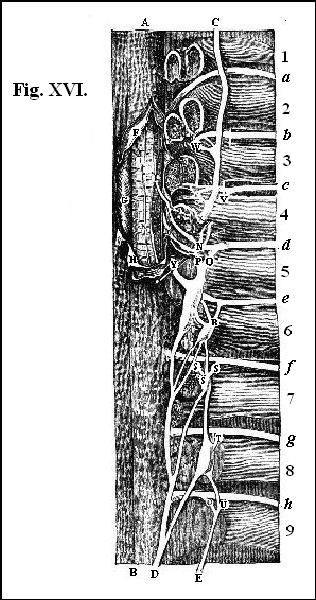
1, 2, 3, 4, 5, 6, 7, 8, 9, the second, &c. ribs with the corresponding dorsal (sentient) nerves, a, b, c, d, e, f, g, h, going out to supply their respective organs with sensation.
C D E, a portion of the main trunk of the organic (non-sentient) nerve, commonly called the Great Sympathetic.
F G H, the membrane of the spinal cord cut open and exposing I K, the spinal cord itself, L, the anterior branch of one of the dorsal nerves, arising from the anterior surface of the spinal cord by several bundles of fibres.
M, the posterior branch of the same nerve, arising in like manner from the posterior surface of the spinal cord by several branches of fibres.
The anterior and posterior branches uniting to form one trunk N.
Two branches, P Q, sent off from the spinal (sentient) trunk to unite with the organic (non-sentient) trunk.
R S T U V W, other branches of the sentient, connected with the branches of the non-sentient nervous trunks in the same mode.
X Y, the main trunk of the sympathetic (non-sentient) nerve cut across and turned aside, in order that the parts beneath it (P N) may be more distinctly seen.
From this description, it is apparent that each sentient nerve, before it goes out to the animal organs, to which it is destined to communicate [Pg 80] sensation, sends off two branches to the organic or the non-sentient. These sentient nerves mix and mingle with the insensible nerves; accompany them in their course to the organic organs, and ramify with them throughout their substance. It is manifest, then, that sentient nerves, that nerves not necessary to the organic processes, having, as far as is known, nothing whatever to do with those processes, enter as constituent parts into the composition of the organic organs. What is the result? That organic organs are rendered sentient; that organic processes, in their own nature insensible, become capable of affecting consciousness. What follows? What is the consciousness excited? Not a consciousness of the organic process. Of that we still remain wholly insensible. Not simple sensation. The result uniformly produced, as long as the state of the system is that of health, is pleasurable consciousness. The heart sends out to the organs its vital current. Each organ, abstracting from the stream the particles it needs, converts them into the peculiar fluid or solid it is its office to form. The stomach, from the arterial streamlets circulating through it, secretes gastric juice; the liver, from the venous streamlets circulating through it, secretes bile. When these digestive organs have duly prepared their respective fluids, they employ them in the elaboration of the aliment. We are not conscious of this elaboration, though it go on within us every moment; but is [Pg 81] consciousness not affected by the process? Most materially. Why? Because sentient mingle with organic nerves; because the sentient nerves are impressed by the actions of the organic organs. And how impressed? As long as the actions of the organic organs are sound, that is, as long as their processes are duly performed, the impression communicated to the sentient nerves is in its nature agreeable; is, in fact, THE PLEASURABLE CONSCIOUSNESS WHICH CONSTITUTES THE FEELING OF HEALTH. The state of health is nothing but the result of the due performance of the organic organs: it follows that the feeling of health, the feeling which is ranked by every one among the most pleasurable of existence, is the result of the action of organs of whose direct operations we are unconscious. But the pleasurable consciousness thus indirectly excited is really the consequence of a special provision, established for the express purpose of producing pleasure. Processes, in their own nature insensible, are rendered sentient expressly for this purpose, that, over and above the special object they serve, they may afford enjoyment. In this case, the production of pleasure is not only altogether gratuitous, not only communicated for its own sake, not only rested in as an ultimate object, but it is made to commence at the very confines of life; it is interwoven with the thread of existence: it is secured in and by the actions that build up and that support the [Pg 82] very framework, the material instrument of our being.
But if the communication of sensibility to processes in their own nature incapable of exciting feeling, for the purpose of converting them into sources of pleasurable consciousness, indicate an express provision for the production of enjoyment, that provision is no less exemplified in the point at which this superadded sensibility is made to cease.
Some of the consequences of a direct communication of consciousness to an organic process have been already adverted to. Had the eye, besides transmitting rays of light to the optic nerve, been rendered sensible of the successive passage of each ray through its substance, the impression excited by luminous bodies, which is indispensable to vision, the ultimate object of the instrument, if not wholly lost, must necessarily have become obscure, in direct proportion to the acuteness of this sensibility. The hand of the musician could scarcely have executed its varied and rapid movements upon his instrument, had his mind been occupied at one and the same instant with the process of muscular contraction in the finger, and the idea of music in the brain. Had the communication of such a twofold consciousness been possible, in no respect would it have been beneficial, in many it would have been highly pernicious; and the least of the evils resulting from it would have been, that the inferior would have interrupted [Pg 83] the superior faculty, and the means deteriorated the end. But in some cases the evil would have been of a much more serious nature. Had we been rendered sensible of the flow of the vital current through the engine that propels it; were the distension of the delicate valves that direct the current ever present to our view; by some inward feeling were we reminded, minute by minute, of the progress of the aliment through the digestive apparatus, and were the mysterious operations of the organic nerves palpable to sight, the terror of the maniac, who conceived that his body was composed of unannealed glass, would be the ordinary feeling of life. Every movement would be a matter of anxious deliberation; and the approach of every body to our own would fill us with dismay. But adjusted as our consciousness actually is, invariably the point at which the organic process begins is that at which sensation ends. Had sensation been extended beyond this point, it would have been productive of pain: at this point it uniformly stops. Nevertheless, by the indirect connexion of sensation with the organic processes, a vast amount of pleasure might be created: a special apparatus is constructed for the express purpose of establishing the communication. There is thus the twofold proof, the positive and the negative, the evidence arising as well from what they do, as from what they abstain from doing, that the organic processes are, and are intended to be, sources of enjoyment.
But the production of pleasure, commencing at this the lowest point of conscious existence, increases with the progressive advancement of organization and function.
The appetite for food, and the voluntary actions dependent upon it, may be considered as the first advancement beyond a process purely organic. The function by which new matter is introduced into the system and converted into nutriment, is partly an animal and partly an organic operation. The animal part of it consists of the sensations of hunger and thirst, by which we are taught when the wants of the system require a fresh supply of aliment, together with the voluntary actions by which the aliment is introduced into the system. The organic part of the function consists of the changes which the aliment undergoes after its introduction into the system, by which it is converted into nutriment. Sensations always of a pleasurable nature arise indirectly in the manner already explained, from the due performance of the organic part of the function; but pleasure is also directly produced by the performance of the animal part of it. Wholesome food is grateful; the satisfaction of the appetite for food is pleasurable. Food is necessary to the support of life; but it is not indispensable to the maintenance of life that food should be agreeable. Appetite there must be, that food may be eaten; but the act of eating might have been secured without connecting it with pleasure. [Pg 85] Pleasure, however, is connected with it, first directly, by the gratefulness of food, and secondly indirectly, by the due digestion of the food. And the annexation of pleasure in this twofold mode to the performance of the function of nutrition is another case of the gratuitous bestowment of pleasure; another instance in which pleasure is communicated for its own sake, and rested in as an ultimate object. Pleasures of this class are sometimes called low; they are comparatively low; but they are not the less pleasures, because they are exceeded in value by pleasures of a nobler nature. Man may regard them with comparative indifference, because he is endowed with faculties which afford him gratifications superior in kind and larger in amount; but it is no mark of wisdom to despise and neglect even these: for they are annexed to the exercise of a function which is the first to exalt us above a merely organic existence; they are the first pleasures of which, considered merely as sentient creatures, we are susceptible; they amount in the aggregate to an immense sum; and they mark the depth in our nature in which are laid the fountains of enjoyment.
Organs of sense, intellectual faculties, social affections, moral powers, are superadded endowments of a successively higher order: at the same time, they are the instruments of enjoyment of a nature progressively more and more exquisite.
An organ of sense is an instrument composed of a peculiar arrangement of organized matter, by which it is adapted to receive from specific agents definite impressions. Between the agent that produces and the organ that receives the impression, the adaptation is such, that the result of their mutual action is, in the first place, the production of sensation, and, in the second place, the production of pleasure. The pleasure is as much the result as the sensation. This is true of the eye in seeing, the ear in hearing, the hand in touching, the organ of smell in smelling, and the tongue in tasting. Pleasure is linked with the sense; but there might have been the sense without the pleasure. A slight difference in the construction of the organ, or in the intensity of the agent, would not merely have changed, it would even have reversed the result; would have rendered the habitual condition of the eye, the ear, the skin, not such as it now is in health, but such as it is in the state of inflammation. But the adjustment is such as habitually to secure that condition of the system in which every action that excites sensation produces pleasure as its ordinary concomitant; and the amount of enjoyment which is thus secured to every man, and which every man without exception actually experiences in the ordinary course of an ordinary life, it would be beyond his power to estimate were he always sensible of the boon; but the calculation is [Pg 87] altogether impossible, when, as is generally the case, he merely enjoys without ever thinking of the provisions which enable him to do so.
But if the pleasures that arise from the ordinary operations of sense form, in the aggregate, an incalculable sum, how great is the accession brought to this stock by the endowments next in order in the ascending scale, namely, the intellectual faculties!
There is one effect resulting from the operation of the intellectual faculties on the senses that deserves particular attention. The higher faculties elevate the subordinate in such a manner as to make them altogether new endowments. In illustration of this, it will suffice to notice the change wrought, as if in the very nature of sensation, the moment it becomes combined with an intellectual operation, as exemplified in the difference between the intellectual conception of beauty, and the mere perception of sense. The grouping of the hills that bound that magnificent valley which I behold at this moment spread out before my view; the shadow of the trees at the base of some of them, stretching its deep and varied outline up the sides of others; the glancing light now brightening a hundred different hues of green on the broad meadows, and now dancing on the upland fallows; the ever-moving, ever-changing clouds; the scented air; the song of birds; the still more touching music which the breeze awakens in the scarcely trembling branches of those pine trees,—the elements of [Pg 88] which this scene is composed, the mere objects of sense, the sun, the sky, the air, the hills, the woods, and the sounds poured out from them, impress the senses of the animals that graze in the midst of them; but on their senses they fall dull and without effect, exciting no perception of their loveliness, and giving no taste of the pleasures they are capable of affording. Nor even in the human being, whose intellectual faculties have been uncultivated, do they awaken either emotions or ideas; the clown sees them, hears them, feels them no more than the herds he tends: yet in him whose mind has been cultivated and unfolded, how numerous and varied the impressions, how manifold the combinations, how exquisite the pleasures produced by objects such as these!
And from the more purely intellectual operations, from memory, comparison, analysis, combination, classification, induction, how still nobler the pleasure! Not to speak of the happiness of him who, by his study of natural phenomena, at length arrived at the stupendous discovery that the earth and all the stars of the firmament move, and that the feather falls to the ground, by the operation of one and the same physical law; nor of the happiness of him who sent his kite into the cloud, and brought down from its quiet bed the lightning which he suspected was slumbering there; nor of the happiness of him who concentrated, directed, and controlled that mighty power which has enabled [Pg 89] the feeble hand of man to accomplish works greater than have been feigned of fabled giant; which has annihilated distance; created, by economizing time; changed in the short space in which it has been in operation the surface of the habitable globe; and is destined to work upon it more and greater changes than have been effected by all other causes combined; nor of the happiness of him who devoted a longer life with equal success to a nobler labour, that of REARING THE FABRIC OF FELICITY BY THE HAND OF REASON AND OF LAW. The intellectual pleasures of such men as Newton, Franklin, Watt, and Bentham, can be equalled only by those who possess equal intellectual power, and who put forth equal intellectual energy: to be greatly happy as they were, it were necessary to be as highly endowed; but to be happy, it is not necessary to be so endowed. In the ordinary intellectual operations of ordinary men, in their ordinary occupations, there is happiness. Every human being whose moments have passed with winged speed, whose day has been short, whose year is gone almost as soon as it seemed commenced, has derived from the exercise of his intellectual faculties pleasures countless in number and inestimable in value.
But the sympathetic pleasures, out of which grow the social, are of a still higher order even than the intellectual. The pleasures that result from the action of the organic organs, from the exercise [Pg 90] of the several senses, and from the operation of the intellectual faculties, like the sensations in which they arise, belong exclusively to the individual being that experiences them, and cannot be communicated to another. Similar sensations and pleasures may be felt by beings similarly constituted; but the actual sensations and pleasures afforded by the exercise of a person's own organs and faculties are no more capable of becoming another's than his existence. These, then, are strictly the selfish pleasures; and the provision that has been made for securing them has been shown.
But there are pleasures of another class, pleasures having no relation whatever to a person's own sensation or happiness; pleasures springing from the perception of the enjoyment of others. The sight of pleasure not its own affects the human heart, provided its state of feeling be natural and sound, just as it would be affected were it its own. Not more real is the pleasure arising from the gratification of appetite, the exercise of sense, and the operation of intellect, than that arising from the consciousness that another sentient being is happy. Pleasures of this class are called sympathetic, in contradistinction to those of the former class, which are termed selfish.
There are then two principles in continual operation in the human being, the selfish and the sympathetic. The selfish is productive of pleasure of a certain kind; the sympathetic is productive of pleasure [Pg 91] of another kind. The selfish is primary and essential; the sympathetic, arising out of the selfish, is superadded to it. And so precisely what the animal life is to the organic, the sympathetic principle is to the selfish; and just what the organic life gains by its union with the animal, the mental constitution gains by the addition of the sympathetic to the selfish affection. The analogy between the combination in both cases is in every respect complete. As the organic life produces and sustains the animal, so the sympathetic principle is produced and sustained by the selfish. As the organic life is conservative of the entire organization of the body, so the selfish principle is conservative of the entire being. As the animal life is superadded to the organic, extending, exalting, and perfecting it, so the sympathetic principle is superadded to the selfish, equally extending, exalting, and perfecting it. The animal life is nobler than the organic, whence the organic is subservient to the animal; but there is not only no opposition, hostility, or antagonism between them, but the strictest possible connexion, dependence, and subservience. The sympathetic principle is nobler than the selfish, whence the selfish is subservient to the sympathetic; but there is not only no opposition, hostility, or antagonism between them, but the strictest possible connexion, dependence, and subservience. Whatever is conducive to the perfection of the organic, is equally conducive to the perfection of the animal [Pg 92] life; and whatever is conducive to the attainment of the true end of the selfish is equally conducive to the attainment of the true end of the sympathetic principle. The perfection of the animal life cannot be promoted at the expense of the organic, nor that of the organic at the expense of the animal; neither can the ultimate end of the selfish principle be secured by the sacrifice of the sympathetic, nor that of the sympathetic by the sacrifice of the selfish. Any attempt to exalt the animal life beyond what is compatible with the healthy state of the organic, instead of accomplishing that end, only produces bodily disease. Any attempt to extend the selfish principle beyond what is compatible with the perfection of the sympathetic, or the sympathetic beyond what is compatible with the perfection of the selfish, instead of accomplishing the end in view, only produces mental disease. Opposing and jarring actions, antagonizing and mutually destructive powers, are combined in no other work of nature; and it would be wonderful indeed were the only instance of it found in man, the noblest of her works, and in the mind of man, the noblest part of her noblest work.
No one supposes that there is any such inharmonious combination in the organization of his physical frame, and the notion that it exists in his mental constitution, as it is founded in the grossest ignorance, so it is productive of incalculable mischief. In both, indeed, are manifest two great [Pg 93] powers, each distinct; each having its own peculiar operation; and the one being subservient to the other, but both conducing alike to one common end. By the addition of the apparatus of the animal to that of the organic life, a nobler structure is built up than could have been framed by the organic alone: by the addition of the sympathetic to the selfish part of the mental constitution, a happier being is formed than could have been produced by the selfish alone. And as the organic might have existed without the animal life, but by the addition of the animal a new and superior being is formed, so might the selfish part of the mental constitution, and the pleasures that flow from it, have existed alone; but by the addition of the sympathetic, a sum is added to enjoyment, of the amount of which some conception may be formed by considering what human life would be, with every selfish appetite and faculty gratified in the fullest conceivable degree, but without any admixture whatever of sympathetic or social pleasure. Selfish enjoyment is not common. If any one set himself to examine what at first view might seem a purely selfish pleasure, he will soon be sensible that, of the elements composing any given state of mind to which he would be willing to affix the term pleasurable, a vast preponderance consists of sympathetic associations. The more accurately he examine, and the farther he carry his analysis, the stronger will become his conviction, that a purely selfish enjoyment, that [Pg 94] is, a truly pleasurable state of mind, in no degree, mediately or immediately, connected with the pleasurable state of another mind, is exceedingly rare.
But if the constitution of human nature and the structure of human society alike render it difficult for the human heart to be affected with a pleasure in no degree derived from—absolutely and totally unconnected with sympathetic association, of that complex pleasure which arises out of social intercourse, partly selfish and partly sympathetic, how far sweeter the sympathetic than the selfish part; and as the sympathetic preponderates over the selfish, how vast the increase of the pleasure! And when matured, exalted into affection—affection, that holy emotion which exerts a transforming influence over the selfish part of human nature, turning it into the sympathetic; affection, which renders the happiness of the beloved object inexpressibly dearer to the heart than its own; affection, among the benignant feelings of which as there is none sweeter so there is none stronger than that of self-devotion, nay, sometimes even of self-sacrifice; affection, which is sympathy pure, concentrated, intense—Oh how beautiful is the constitution of this part of our nature, by which the most transporting pleasures the heart receives are the direct reflection of those it gives!
Nor ought it to be overlooked, that, while nearly all the selfish, like all the sensual pleasures, cannot [Pg 95] be increased beyond a fixed limit, cannot be protracted beyond a given time, are short-lived in proportion as they are intense, and satiate the appetite they gratify, the sympathetic pleasures are capable of indefinite augmentation; are absolutely inexhaustible; no limit can be set to their number, and no bound to their growth; they excite the appetite they gratify; they multiply with and by participation, and the more is taken from the fountain from which they flow, the deeper, the broader, and the fuller the fountain itself becomes.
But not only is the mental state of affection in all its forms and degrees highly pleasurable, but the very consciousness of being the object of affection is another pleasure perfectly distinct from that arising immediately from the affection itself. It has been said of charity, that it is twice blessed, that it blesses alike him that gives and him that receives; but love has in it a threefold blessing: first, in the mental state itself; secondly, in the like mental state which the manifestation of it produces in another; and thirdly, in the mental state inseparable from the consciousness of being the object of affection. And this reflex happiness, this happiness arising from the consciousness of being the object, is even sweeter than any connected with being the subject of affection.
In like manner there is pleasure in the performance of beneficent actions; in energetic, constant, and therefore ultimately successful exertions to [Pg 96] advance the great interests of human kind, in art, in science, in philosophy, in education, in morals, in legislation, in government; whether those exertions are put forth in the study, the school, the senate, or any less observed though perhaps not less arduous nor less important field of labour. Exertions of this kind beget in those for whom, towards those by whom, they are made, benignant feelings—respect, veneration, gratitude, love. With such feelings the philosopher, the instructor, the legislator, the statesman, the philanthropist, knows that he is, or that, sooner or later, he will be regarded by his fellow men; and in this consciousness there is happiness: but this is another source of happiness perfectly distinct from that arising from the performance of beneficent actions; it is a new happiness superadded to the former, and, if possible, still more exquisite. Thus manifold is the beneficent operation of the sympathetic affection: thus admirable is the provision made in the constitution of our nature for the excitement and extension of this affection, and, through its instrumentality, for the multiplication and exaltation of enjoyment!
In affections and actions of the class just referred to, and in the pleasures that result from them, there is much of the nature which is commonly termed moral. And the power to which the moral affections and actions are referred is usually and justly considered as the supreme faculty of the [Pg 97] mind; for it is the regulator and guide of all the others; it is that by which they attain their proper and ultimate object. Of whatever pleasure human nature is capable in sensation, in idea, in appetite, in passion, in emotion, in affection, in action; whatever is productive of real pleasure, in contradistinction to what only cheats with the false hope of pleasure; whatever is productive of pure pleasure, in contradistinction to what is productive partly of pleasure and partly of pain, and consequently productive not of pure, but of mixed pleasure; whatever is productive of a great degree of pleasure in contradistinction to what is productive of a small degree of pleasure; whatever is productive of lasting pleasure, in contradistinction to what is productive of temporary pleasure; whatever is productive of ultimate pleasure, in contradistinction to what is productive of immediate pleasure, but ultimate pain; this greatest and most perfect pleasure it is the part of the moral faculty to discover. In the degree in which the operation of this faculty is correct and complete, it enables the human being to derive from every faculty of his nature the greatest, the purest, the most enduring pleasure; that is, the maximum of felicity. This is the proper scope and aim of the moral faculty; to this its right exercise is uniformly conducive; and this, as it is better cultivated and directed, it will accomplish in a higher degree, in a continual progression, to which no limit can be [Pg 98] assigned. But if the operation of this faculty be to render every other in the highest degree conducive to happiness, conformity to the course of conduct required by it, must of course be that highest happiness. Conformity to the course of conduct pointed out by the moral faculty as conducive in the highest degree to happiness is moral excellence, or, in the definite and exact sense of the word, virtue. And in this sense it is that virtue is happiness. It is because it discriminates the true sources of happiness, that is, directs every other faculty into its proper course, and guides it in that course to the attainment of its ultimate object, that the moral faculty is ranked as the highest faculty of the mind. Supposing the operation of this faculty to be perfect, it is but an identical expression to say, that to follow its guidance implicitly is to follow the road that leads to the most perfect happiness. But, over and above the happiness thus directly and necessarily resulting from yielding uniform and implicit obedience to the moral faculty, there is, in the very consciousness of such conformity, a new happiness, as pure as it is exalted. Thus, in a twofold manner, is the moral the highest faculty of the mind, the source of its highest happiness; and thus manifest it is, from every view that can be taken of the constitution of human nature, that every faculty with which it is endowed, from the highest to the lowest, not only affords its own proper and peculiar pleasure, but [Pg 99] that each, as it successively rises in the scale, is proportionately the source of a nobler kind, and a larger amount of enjoyment.
And the pleasure afforded by the various faculties with which the human being is endowed is the immediate and direct result of their exercise. With the exception of the organic organs, and the reason for the exception in regard to them has been assigned, the action of the organs is directly pleasurable. From the exercise of the organs of sense, from the operation of the intellectual faculties, from appetite, passion, and affection, pleasure flows as directly as the object for which the instrument is expressly framed.
And pleasure is the ordinary result of the action of the organs; pain is sometimes the result, but it is the extraordinary not the ordinary result. Whatever may be the degree of pain occasionally produced, or however protracted its duration, yet it is never the natural, that is, the usual or permanent state, either of a single organ, or of an apparatus, or of the system. The usual, the permanent, the natural condition of each organ, and of the entire system, is pleasurable. Abstracting, therefore, from the aggregate amount of pleasure, the aggregate amount of pain, the balance in favour of pleasure is immense. This is true of the ordinary experience of ordinary men, even taking their physical and mental states such as they are at present; but the ordinary physical and mental states, considered [Pg 100] as sources of pleasure of every human being, might be prodigiously improved; and some attempt will be made, in a subsequent part of this work, to show in what manner and to what extent.
It has been already stated that there are cases in which pleasure is manifestly given for its own sake; in which it is rested in as an ultimate object: but the converse is never found: in no case is the excitement of pain gratuitous. Among all the examples of secretion, there is no instance of a fluid, the object of which is to irritate and inflame: among all the actions of the economy, there is none, the object of which is the production of pain.
Moreover, all such action of the organs, as is productive of pleasure, is conducive to their complete development, and consequently to the increase of their capacity for producing pleasure; while all such action of the organs as is productive of pain is preventive of their complete development, and consequently diminishes their capacity for producing pain. The natural tendency of pleasure is to its own augmentation and perpetuity. Pain, on the contrary, is self-destructive.
Special provision is made in the economy, for preventing pain from passing beyond a certain limit, and from enduring beyond a certain time. Pain, when it reaches a certain intensity, deadens the sensibility of the sentient nerve; and when it lasts beyond a certain time, it excites new actions in the organ affected, by which the organ is either [Pg 101] restored to a sound state, or so changed in structure that its function is wholly abolished. But change of structure and abolition of function, if extensive and permanent, are incompatible with the continuance of life. If, then, the actions of the economy, excited by pain, fail to put an end to suffering by restoring the diseased organ to a healthy state, they succeed in putting an end to it by terminating life. Pain, therefore, cannot be so severe and lasting as materially to preponderate over pleasure, without soon proving destructive to life.
But the very reverse is the case with pleasure. All such action of the organs as is productive of pleasure is conducive to the perpetuation of life. There is a close connexion between happiness and longevity. Enjoyment is not only the end of life, but it is the only condition of life which is compatible with a protracted term of existence. The happier a human being is, the longer he lives; the more he suffers, the sooner he dies; to add to enjoyment, is to lengthen life; to inflict pain, is to shorten the duration of existence. As there is a point of wretchedness beyond which life is not desirable, so there is a point beyond which it is not maintainable. The man who has reached an advanced age cannot have been, upon the whole, an unhappy being; for the infirmity and suffering which embitter life cut it short. Every document by which the rate of mortality among large numbers of human beings can be correctly ascertained [Pg 102] contains in it irresistible evidence of this truth. In every country, the average duration of life, whether for the whole people or for particular classes, is invariably in the direct ratio of their means of felicity; while, on the other hand, the number of years which large portions of the population survive beyond the adult age may be taken as a certain test of the happiness of the community. How clear must have been the perception of this in the mind of the Jewish legislator when he made the promise, that thy days may be long in the land which the Lord thy God hath given thee—the sanction of every religious observance, and the motive to every moral duty!
Deeply then are laid the fountains of happiness in the constitution of human nature. They spring from the depths of man's physical organization; and from the wider range of his mental constitution they flow in streams magnificent and glorious. It is conceivable that from the first to the last moment of his existence, every human being might drink of them to the full extent of his capacity. Why does he not? The answer will be found in that to the following question. What must happen before this be possible? The attainment of clear and just conceptions on subjects, in relation to which the knowledge hitherto acquired by the most enlightened men is imperfect. Physical nature, every department of it, at least, which is capable of influencing human existence and human sensation; [Pg 103] human nature, both the physical and the mental part of it; institutions so adapted to that nature as to be capable of securing to every individual, and to the whole community, the maximum of happiness with the minimum of suffering—this must be known. But knowledge of this kind is of slow growth. To expect the possession of it on the part of any man in such a stage of civilization as the present, is to suppose a phenomenon to which there is nothing analogous in the history of the human mind. The human mind is equally incapable of making a violent discovery in any department of knowledge, and of taking a violent bound in any path of improvement. What we call discoveries and improvements are clear, decided, but for the most part gentle, steps in advancement of the actual and immediately-preceding state of knowledge. The human mind unravels the great chain of knowledge, link by link; when it is no longer able to trace the connecting link, it is at a stand; the discoverer, in common with his contemporaries, seeing the last ascertained link, and from that led on by analogies which are not perceived by, or which do not impress, others, at length descries the next in succession; this brings into view new analogies, and so prepares the way for the discernment of another link; this again elicits other analogies which lead to the detection of other links, and so the chain is lengthened. And no link, once made out, is lost.
Chemists tell us that the adjustment of the component elements of water is such, that although they readily admit of separation and are subservient to their most important uses in the economy of nature by this very facility of decomposition, yet that their tendency to recombination is equal, so that the quantity of water actually existing at this present moment in the globe is just the same as on the first day of the creation, neither the operations of nature, nor the purposes to which it has been applied by man, having used up, in the sense of destroying, a single particle of it. Alike indestructible are the separate truths that make up the great mass of human knowledge. In their ready divisibility and their manifold applications, some of them may sometimes seem to be lost; but if they disappear, it is only to enter into new combinations, many of which themselves become new truths, and so ultimately extend the boundaries of knowledge. Whatever may have been the case in time past, when the loss of an important truth, satisfactorily and practically established, may be supposed possible, such an event is inconceivable now when the art of printing at once multiplies a thousand records of it, and, with astonishing rapidity, makes it part and parcel of hundreds of thousands of minds. A thought more full of encouragement to those who labour for the improvement of their fellow beings there cannot be. No onward step is lost; no onward step is final; every such step [Pg 105] facilitates and secures another. The savage state, that state in which gross selfishness seeks its object simply and directly by violence, is past. The semi-savage or barbarous state, in which the grossness of the selfishness is somewhat abated, and the violence by which it seeks its object in some degree mitigated, by the higher faculties and the gentler affections of our nature, but in which war still predominates, is also past. To this has succeeded the state in which we are at present, the so-called civilized state—a state in which the selfish principle still predominates, in which the justifiableness of seeking the accomplishment of selfish purposes by means of violence, that of war among the rest, is still recognized, but in which violence is not the ordinary instrument employed by selfishness, its ends being commonly accomplished by the more silent, steady, and permanent operation of institutions. This state, like the preceding, will pass away. How soon, in what precise mode, by what immediate agency, none can tell. But we are already in possession of the principle which will destroy the present and introduce a better social condition, namely, the principle at the basis of the social union, THE MAXIMUM OF THE AGGREGATE OF HAPPINESS; THE MAXIMUM OF THE AGGREGATE OF HAPPINESS SOUGHT BY THE PROMOTION OF THE MAXIMUM OF INDIVIDUAL HAPPINESS!
Relation between the physical condition and happiness, and between happiness and longevity—Longevity a good, and why—Epochs of life—The age of maturity the only one that admits of extension—Proof of this from physiology—Proof from statistics—Explanation of terms—Life a fluctuating quantity—Amount of it possessed in ancient Rome: in modern Europe: at present in England among the mass of the people and among the higher classes.
Life depends on the action of the organic organs. The action of the organic organs depends on certain physical agents. As each organic organ is duly supplied with the physical agent by which it carries on its respective process, and as it duly appropriates what it receives, the perfection of the physical condition is attained; and, according to the perfection or imperfection of the physical condition, supposing no accident interrupt its regular course, is the length or the brevity of life.
It is conceivable that the physical condition might be brought to a high degree of perfection, the mind remaining in a state but little fitted for enjoyment; because it is necessary to enjoyment that there be a certain development, occupation, and direction of the mental powers and affections: [Pg 107] and the mental state may be neglected, while attention is paid to the physical processes. But the converse is not possible. The mental energies cannot be fully called forth while the physical condition is neglected. Happiness presupposes a certain degree of excellence in the physical condition; and unless the physical condition be brought to a high degree of excellence, there can be no such development, occupation, and direction of the mental powers and affections as is requisite to a high degree of enjoyment.
That state of the system in which the physical condition is sound is in itself conducive to enjoyment; while a permanent state of enjoyment is in its turn conducive to the soundness of the physical condition. It is impossible to maintain the physical processes in a natural and vigorous condition if the mind be in a state of suffering. The bills of mortality contain no column exhibiting the number of persons who perish annually from bodily disease, produced by mental suffering; but every one must occasionally have seen appalling examples of the fact. Every one must have observed the altered appearance of persons who have sustained calamity. A misfortune, that struck to the heart, happened to a person a year ago; observe him some time afterwards; he is wasted, worn, the miserable shadow of himself; inquire about him at the distance of a few months, he is no more.
It is stated by M. Villermé, that the ordinary [Pg 108] rate of mortality in the prisons of France, taking all together, is one in twenty-three—a rate which corresponds to the age of sixty-five in the common course of life. But in the vast majority of cases the unfortunate victims of the law are no older than from twenty-five to forty-five years of age. Taking them at the mean age of thirty-five, it follows that the suffering from imprisonment, and from the causes that lead to it, is equivalent to thirty years wear and tear of life. But this is not all; for it is found that, during imprisonment, the ordinary chances of death are exactly quadrupled.
In regard to the whole population of a country, indigence may be assumed to be a fair measure of unhappiness, and wealth of happiness. If the rate of mortality in the indigent class be compared with that of the wealthy, according to M. Villermé, it will be found in some cases to be just double. Thus it is affirmed that, in some cases in France, taking equal numbers, where there are one hundred deaths in a poor arrondissement, there are only fifty in a rich; and that taking together the whole of the French population, human life is protracted twelve years and a half among the wealthy beyond its duration among the poor: consequently, in the one class, a child, newly born, has a probability of living forty-two and a half years; in the other only thirty years.
In the great life-insurance establishments in England, a vast proportion of the persons who [Pg 109] insure their lives are persons compelled to do so by their creditors; while three-fourths of those who voluntarily insure their lives are professional men, living in great towns, and experiencing the anxieties and fatigues, the hopes and disappointments of professional life. In one of these establishments in London, out of 330 deaths that happened in twenty-six years preceding the year 1831, it was found that eleven died by suicide, being one in thirty, implying the existence of an appalling amount of mental suffering. The number of persons belonging to an insurance office who perish by suicide is sure to be accurately known, death by suicide rendering the policy void. It would be most erroneous to suppose that these persons put an end to their existence under the mere influence of the mental states of disappointment and despondency. The mind reacted upon the body: produced physical disease, probably inflammation of the brain, and under the excitement of this physical disease, the acts of suicide were committed. More than one case has come to my knowledge in which inflammation of the brain having been excited by mental suffering, suicide was committed by cutting the throat. During the flow of blood, which was gradual, the brain was relieved; the mind became perfectly rational; and the patient might have been saved had a surgeon been upon the spot, or had the persons about the patient known where and how to apply the pressure [Pg 110] of the finger to staunch the flow of blood, until surgical aid could be procured.
By a certain amount and intensity of misery life may be suddenly destroyed; by a smaller amount and intensity, it may be slowly worn out and exhausted. The state of the mind affects the physical condition; but the continuance of life is wholly dependent on the physical condition: it follows that in the degree in which the state of the mind is capable of affecting the physical condition, it is capable of influencing the duration of life.
Were the physical condition always perfect, and the mental state always that of enjoyment, the duration of life would always be extended to the utmost limit compatible with that of the organization of the body. But as this fortunate concurrence seldom or never happens, human life seldom or never numbers the full measure of its days. Uniform experience shows, however, that, provided no accident occur to interrupt the usual course, in proportion as body and mind approximate to this state, life is long; and as they recede from it, it is short. Improvement of the physical condition affords a foundation for the improvement of the mental state; improvement of the mental state improves up to a certain point the physical condition; and in the ratio in which this twofold improvement is effected, the duration of life increases.
Longevity then is a good, in the first place, because [Pg 111] it is a sign and a consequence of the possession of a certain amount of enjoyment; and in the second place, because this being the case, of course in proportion as the term of life is extended, the sum of enjoyment must be augmented. And this view of longevity assigns the cause, and shows the reasonableness of that desire for long life which is so universal and constant as to be commonly considered instinctive. Longevity and happiness, if not invariably, are generally, co-incident.
If there may be happiness without longevity, the converse is not possible: there cannot be longevity without happiness. Unless the state of the body be that of tolerable health, and the state of the mind that of tolerable enjoyment, long life is unattainable: these physical and mental conditions no longer existing, nor capable of existing, the desire of life and the power of retaining it cease together.
An advanced term of life and decrepitude are commonly conceived to be synonymous: the extension of life is vulgarly supposed to be the protraction of the period of infirmity and suffering, that period which is characterized by a progressive diminution of the power of sensation, and a consequent and proportionate loss of the power of enjoyment, the "sans teeth, sans eyes, sans taste, sans every thing." But this is so far from being true, that it is not within the compass of human power to protract in any sensible degree the period of old age properly so called, that is, the stage of decrepitude. [Pg 112] In this stage of existence, the physical changes that successively take place clog, day by day, the vital machinery, until it can no longer play. In a space of time, fixed within narrow limits, the flame of life must then inevitably expire, for the processes that feed it fail. But though, when fully come, the term of old age cannot be extended, the coming of the term may be postponed. To the preceding stage, an indefinite number of years may be added. And this is a fact of the deepest interest to human nature.
The division of human life into periods or epochs is not an arbitrary distinction, but is founded on constitutional differences in the system, dependent on different physiological conditions. The periods of infancy, childhood, boyhood, adolescence, manhood, and old age, are distinguished from each other by external characters, which are but the outward signs of internal states. In physiological condition, the infant differs from the child, the child from the boy, the boy from the man, and the adult from the old man, as much in physical strength as in mental power. There is an appointed order in which these several states succeed each other; there is a fixed time at which one passes into another. That order cannot be inverted: no considerable anticipation or postponement of that fixed time can be effected. In all places and under all circumstances, at a given time, though not precisely at the same time in all [Pg 113] climates and under all modes of life, infancy passes into childhood, childhood into boyhood, boyhood into adolescence, and adolescence into manhood. In the space of two years from its birth, every infant has ceased to be an infant, and has become a child; in the space of six years from this period, every male child will have become a boy; add eight years to this time, and every boy will have become a young man; in eight years more, every young man will have become an adult man; and in the subsequent ten years, every adult man will have acquired his highest state of physical perfection. But at what period will this state of physical perfection decline? What is the maximum time during which it can retain its full vigour? Is that maximum fixed? Is there a certain number of years in which, by an inevitable law, every adult man necessarily becomes an old man? Is precisely the same number of years appointed for this transition to every human being? Can no care add to that number? Can no imprudence take from it? Does the physiological condition or the constitutional age of any two individuals ever advance to precisely the same point in precisely the same number of years? Physically and mentally, are not some persons older at fifty than others are at seventy? And do not instances occasionally occur in which an old man, who reaches even his hundredth year, retains as great a degree of juvenility as the majority of those who attain to eighty?
If this be so, what follows? One of the most interesting consequences that can be presented to the human mind. The duration of the periods of infancy, childhood, boyhood, and adolescence, is fixed by a determinate number of years. Nothing can stay, nothing retard, the succession of each. Alike incapable of any material protraction is the period of old age. It follows that every year by which the term of human existence is extended is really added to the period of mature age; the period when the organs of the body have attained their full growth and put forth their full strength; when the physical organization has acquired its utmost perfection; when the senses, the feelings, the emotions, the passions, the affections, are in the highest degree acute, intense, and varied; when the intellectual faculties, completely unfolded and developed, carry on their operations with the greatest vigour, soundness, and continuity; in a word, when the individual is capable of receiving and of communicating the largest amount of the highest kind of enjoyment.
A consideration more full of encouragement, more animating, there cannot be. The extension of human life, in whatever mode and degree it may be possible to extend it, is the protraction of that portion of it, and only of that portion of it, in which the human being is capable of RECEIVING AND OF COMMUNICATING THE LARGEST MEASURE OF THE NOBLEST KIND OF ENJOYMENT.
Considerations, purely physiological, establish this indubitably; but it is curious that a class of facts, totally different from those of a physiological nature, equally prove it; namely, the results obtained from the observation of the actual numbers that die at different ages, and the knowledge consequently acquired of the progressive decrement of life. Mortality is subject to a law, the operation of which is as regular as that of gravitation. The labours of my valued friend Mr. Finlaison, the actuary of the National Debt, have not only determined what that law is in relation to different nations at different periods of their history, but this celebrated calculator has also invented a striking mode of expressing and representing the fact. He constructed a chart on which 100 perpendicular lines, answering to the respective ages of human life, are laid down and numbered in succession. These are crossed at right angles by 500 horizontal lines; so that, in the manner of musical notation, a point may be laid down either on the horizontal line, or on the space between any two of them: and thus, 1000 points may be laid down on each of the perpendicular lines. The horizontal lines are in like manner numbered from 1 to 1000, ascending from the base. Taking any observation which shows the number of living persons that commence, and in like manner the number that die in each particular year of human life, the calculator reduced by the rule of three every such [Pg 116] actual number of living persons for every separate year to 10,000: he next showed the corresponding proportion of deaths out of such 10,000. These proportions he represented on the chart by a point inserted on the horizontal line or space for the number of deaths, and on the perpendicular line for the particular age. He then connected all the points so laid down, and the result is a curve, representing the track of death through an equal number of human beings existing at each age of life. As the curve rises on the perpendicular line, at any given age, it indicates by so much an increase of the mortality at that age; and as the curve falls, the reverse is denoted.
Now, it is a highly interesting fact, that the curves on this chart drawn upon it before the physiological phenomena were known to the operator, placed there because such he found to be the actual path along which death marshals his course, exactly correspond to the epochs which physiology teaches to be determinate stages of human existence. The infant, the child, the boy, the adolescent, the man, the old man, are not exposed to the same danger. The liability of each to death is not merely different; it is widely different; the liability of each class is uniformly the same, the circumstances influencing life remaining the same; and under no known change of circumstances does the relative liability of the class vary; under no change does the liability of the adolescent become [Pg 117] that of the infant, or the liability of the adult that of the aged. Take from any statistical document any number of persons; observe out of this number the proportion that dies at the different stages just enumerated; and the period of human life which admits of extension will be strikingly manifest. Take with this view the Prussian statistical tables, the general correctness of which is admitted. From these tables it appears, and the correctness of the result is confirmed by a multitude of other tables, that out of a million living male births, there will die in the first year of life 180,492 infants, and out of the like number of living female births, there will die 154,705 infants. Let us follow up the decrement of life through the different epochs of human existence, confining our observations to the male sex, in which the development is more emphatically marked.
In Mr. Finlaison's report, printed by the House of Commons on the 30th of March, 1829, there are six original observations on the mortality of as many separate sets of annuitants of the male sex.
From an examination and comparison of these observations, it appears—1st. That the rate of mortality falls to a minimum at the close of the period of childhood. 2d. That from this point the mortality rises until the termination of adolescence or the commencement of adult age. 3d. That from the commencement of adult age the mortality again declines, and continues to decline [Pg 118] to the period of perfect maturity. And 4th. That from the period of perfect maturity, the mortality rises, and uniformly, without a single exception, returns, at the age of forty-eight, to the point at which it stood at the termination of adolescence. These results clearly indicate that certain fixed periods are marked by nature as epochs of human life; and that at the date of the recorded facts which furnish the data for these observations, and as far as regards the class of persons to which they relate, the age of forty-eight was the exact point at which the meridian of life was just passed, and a new epoch began. The following table exhibits at one view the exact results of each of the observations. For example,
| According to the observation No. | The mortality is at a minimum at the age of | From whence it rises until the age of | From this point it declines to the age of | And from this age it again rises but is not equal to mortality in the 2d column until the age of |
| 15 | 13 | 23 | 34 | 48 |
| 16 | 13 | 23 | 35 | 48 |
| 17 | 14 | 22 | 33 | 48 |
| 18 | 13 | 23 | 33 | 48 |
| 19 | 13 | 24 | 34 | 48 |
| 20 | 13 | 24 | 34 | 48 |
The observation, No. 15, is founded on the large mass of 9,347 lives and 4,870 deaths. From this observation, it appears that, at the age of thirteen, the mortality out of a million is 5,742, being 174,750 less than in the first year of infancy [Pg 119] At the age of twenty-three, it is 15,074, being 9,332 more than at the close of childhood. At the age of thirty-four, the period of complete manhood, it falls to 11,707, being 3,367 less than at the close of adolescence. At the age of forty-eight, the mortality returns to 14,870, all but identically the same as at twenty-three, the adult age. From the age of forty-eight, when, as has been stated, life just begins to decline from its meridian, the mortality advances slowly, but in a steady and regular progression. Thus, at the age of fifty-eight it is 29,185, being 14,315 more than at the preceding decade, or almost exactly double. At the age of sixty-eight, it is 61,741, being 32,556 more than at the preceding decade, or more than double. At the age of seventy-eight, it is 114,255, being 52,514 more than at the preceding decade. At the age of eighty-eight, it is 246,803, being 132,548 more than at the preceding decade.
During the first year of infancy, as has been shown, the mortality out of a million is 180,492. At the extreme age of eighty-four, it is 178,130, very nearly the same as in the first year of infancy. Greatly as the mortality of all the other epochs of life is affected by country, by station, by a multitude of influences arising out of these and similar circumstances; yet the concurrent evidence of all observation shows that at this and the like advanced ages the mean term of existence is nearly [Pg 120] the same in all countries, at all periods, and among all classes of society. Thus, among the nobility and gentry of England, the expectation of life at eighty-four is four years; among the poor fishermen of Ostend, it is precisely the same. M. De Parcieux, who wrote just ninety years ago, establishes the expectation of life at that time in France, at the same age, to have been three and a half years; and Halley, who wrote 120 years ago, and whose observations are derived from documents which go back to the end of the seventeenth century, states the expectation of life at eighty-four to be two years and nine months.
From these statements, then, it is obvious, that from the termination of infancy at three years of age, a decade of years brings childhood to a close, during which the mortality, steadily decreasing, comes to its minimum. Another decade terminates the period of adolescence, during which the mortality as steadily advances. A third decade changes the young adult into a perfect man, and during this period, the golden decade of human life, the mortality again diminishes; while, during another decade and a half, the mortality slowly rises, and returns at the close of the period to the precise point at which it stood at adult age. Thus the interval between the period of birth and that of adult age includes a term of twenty-three years. The interval between the period of adult age and that when life just begins to decline from its meridian, [Pg 121] includes a term of twenty-four years: consequently, a period more than equal to all the other epochs of life from birth to adult age is enjoyed, during which mortality makes no advance whatever. Now the term of years included in the several epochs that intervene between birth and adult age is rigidly fixed. Thus the period of infancy includes precisely three years, that of childhood ten years, and that of adolescence ten years. Within the space of time comprehended in these intervals, physiological changes take place, on which depend every thing that is peculiar to the epochs. These changes cannot be anticipated, cannot be retarded, except in a very slight degree. In all countries, among all classes, they take place in the same order and nearly in the same space of time. In like manner, in extreme old age, or the age of decrepitude, which may be safely assumed to commence at the period when the mortality equals that of the first year of infancy, namely, the age of eighty-four, physiological changes take place, which, within a given space of time, inevitably bring life to a close. That space of time, in all countries, in all ranks, in all ages, or rather as far back as any records enable us to trace the facts, appears to be the same. As within a given time the boy must ripen into manhood, so within a given time the man of extreme old age must be the victim of death. Consequently, it is the interval between the adult age and the age of decrepitude, [Pg 122] and only this, that is capable of extension. During the interval between adult age and the perfect meridian of life, comprehending at present, as we have seen, a period of twenty-four years, the constitution remains stationary, mortality making no sensible inroad upon it. But there is no known reason why this stationary or mature period of life should, like the determinate epochs, be limited to a fixed term of years. On the contrary, we do in fact know that it is not fixed; for we know that the physiological changes on which age depends are, in some cases, greatly anticipated, and in others, proportionately postponed; so that some persons are younger at sixty, and even at seventy, than others are at fifty; whereas, an analogous anticipation or postponement of the other epochs of life is never witnessed. So complete is the proof, that the extension of human life can consist in the protraction neither of the period of juvenility, nor in that of senility, but only in that of maturity.
Were it necessary to adduce further evidence of this most interesting fact, it would be found equally in the statistics of disease as in those of mortality. Indeed, the evidence derived from both these sources must be analogous, because mortality is invariably proportionate to the causes of mortality, of which causes, sickness, in all its forms, may be taken as the general or collective expression.
We do not possess the same means of illustrating the prevalence of disease through all the epochs [Pg 123] of life as we do of showing the intensity of mortality; yet the report of Mr. Finlaison, already referred to, enables us to show its comparative prevalence at several of those stages. Thus, from this document, it appears, that among the industrious poor of London, members of benefit societies, out of a million of males, the proportion constantly sick at the age of twenty-three, is 19,410; at the age of twenty-eight, it is 19,670; at the age of thirty-three, it is 19,400; at the age of thirty-eight, it is 23,870; at the age of forty-three, it is 26,260; at the age of forty-eight, it is 26,140; at the age of fifty-three, it is 27,060; at the age of fifty-eight, it is 36,980; at the age of sixty-three, it is 57,000; at the age of sixty-eight, it is 108,040; at the age of seventy-three and upwards, it is 317,230. The prevalence of sickness is not an exact and invariable measure of the intensity of mortality; but there is a close connexion between them, as is manifest from the progressively increasing amount of sickness, as age advances. Thus, in the first ten years from the age of twenty-three to that of thirty-three, there is no increase of sickness, its prevalence is all but identically the same; in the next ten years from the age of thirty-three to that of forty-three, the increase of sickness, as compared with that of the preceding decade, is 6,860; in the next ten years from the age of forty-three to that of fifty-three, the increase is only 800; in the next ten years from the age of [Pg 124] fifty-three to that of sixty-three, the increase is 29,940, while from the age of sixty-three to seventy-three, it is 260,230.
Such are the results derived from the experience of disease considered in the aggregate, all its varied forms taken together. I am enabled further to present an exact and most instructive proof, that one particular disease which, in this point of view, may be considered as more important than any other, because it is the grand agent of death, namely fever, carries on its ravages in a ratio which steadily and uniformly increases as the age of its victim advances. Having submitted the experience of the London Fever Hospital for the ten years preceding January 1834, an observation including nearly 6,000 patients affected with this malady, to Mr. Finlaison, it was subjected by him to calculation. Among other curious and instructive results to be stated hereafter, it was found that the mortality of fever resolves itself into the following remarkable progression. Thus suppose 100,000 patients to be attacked with this disease between the ages of 5 and 16, of these there would die - 8,266 and of an equal number
| between | 15 and 26 | there would die | 11,494 |
| 25 and 36 | """ | 17,071 | |
| 35 and 46 | """ | 21,960 | |
| 45 and 56 | """ | 30,493 | |
| 55 and 66 | """ | 40,708 | |
| 65 and upwards | """ | 44,643 |
Thus the risk of life from this malady is twice as great at the age of thirty-one as it is at eleven. It is also nearly twice as great at forty-one as it is at twenty-one. It is five times as great at sixty-one as it is at eleven, and nearly four times as great above sixty-five as it is at twenty-one.
From the whole of the foregoing statements, it is manifest that life is a fluctuating quantity. In order to compare this fluctuating quantity under different circumstances, writers on this branch of statistics use several terms, the exact meaning of which it is desirable to explain. It is, for example, very important to have a clear understanding of what is meant by such expressions as the following: the expectation, the probability, the value, the decrement of life, and the law of mortality.
1. The Expectation of Life. It is important to bear in mind that several expressions in common use have a signification perfectly synonymous with this: namely, share of existence; mean duration of life; la vie moyenne.
By these terms is expressed the total number of years, including also the fractional parts of a year, ordinarily attained by human beings from and after any given age. Suppose, for example, that one thousand persons enter on the eighty-sixth year of their age: suppose the number of years and days which each one of them lives afterwards be observed and recorded; suppose the number ultimately attained by each be formed into a sum [Pg 126] total; suppose this total be divided equally among the thousand, the quotient of this division is said to be each one's share of existence, or his mean duration of life, or his expectation of life. Thus, of the thousand persons in the present case supposed to commence the age of eighty-five, suppose the number of years they collectively attain amount to 3,500 years: the one-thousandth part of 3,500 is three and a half: three years and a half then is said to be the expectation of life at the age of eighty-five, because, of all the persons originally starting, this is the equal share of existence that falls to the lot of each.
2. Probability of Life; or the probable duration of life, la vie probable. These are synonymous terms, in use chiefly among continental writers as an expression of the comparative duration of life. The tabular methods of setting forth the duration of life consist, for the most part, in assuming that 10,000 infants are born; and that at the age of one, two, three, and each successive year of life, there are so many still remaining in existence. Fix on any age; observe what number remain alive to commence that age; note at what age this number decreases to one-half; the age at which they so come to one-half is called the probable term of life; because, say the continental writers, it is an equal wager whether a person shall or shall not be alive at that period. Thus, suppose one thousand males commence together the age of [Pg 127] eighty-four; suppose the table indicate that there will be alive at the age of eighty-five, 817; at the age of eighty-six, 648; at the age of eighty-seven, 493; at the age of eighty-eight, 357, and so on. In the present case, the probable duration of life at eighty-four is said to be very nearly three years, because, at the age of eighty-seven there are left alive 493, very nearly one-half of the thousand that originally started together.
3. Value of Life. This term, when used accurately, expresses the duration of life as measured by one or other of the methods already expounded. But it is sometimes popularly used in a loose and singularly inaccurate sense. Thus it is very commonly said—"Such a man's life is not worth ten years' purchase," which is the same thing as to say, that an annuity, suppose a hundred pounds a year, payable during the life of the person in question, is not worth ten times its magnitude, that is one thousand pounds. If a thousand pounds be put into a bank at some rate of interest to be agreed upon, and if a hundred pounds be drawn every year from the stock, the expression under consideration affirms that the person in question will be dead before the principal and interest are exhausted. For instance, at four per cent., the value of an annuity of one hundred pounds to a man of the age of twenty-five is 1694l., which is 16-9/10 years' purchase; whereas, his expectation of life at that age is 35-9/10 years.
4. Law of Mortality. By this term is expressed the proportion out of any determinate number of human beings who enter on a given year of age, that will die in that year. Every observation on the duration of life presents certain numbers, which, by recorded facts, are found to pass through each year of age, and also shows how many have died or failed to pass through every year of age. Those numbers, by the rule of three, are converted into the proportions who would die at each age out of one million of persons, if such a number had commenced it. Suppose, then, a million of persons to be in existence at the first year of age; suppose a million to be in existence at the second year of age; suppose a million to be in existence at the third year of age; and in this manner suppose an equal number to be in existence at the commencement of each and every year to the extreme term of human life. Now, the proportions that by actual observation are found to die at each and every year out of the million that were alive at the commencement of it, form separately the law of mortality for each year, and collectively for the whole of life.
5. Decrement of Life. Assuming, as before, that a million of male children are born alive (for the still-born must be excluded from the calculation) if it be found that 180,492 would die in the first year, it follows that the difference, namely, 819,508, will enter upon the age of one year. [Pg 129] Suppose the law of mortality indicate that the proportion that will die, out of a million, between the age of one and two, is 30,000; it is plain that the number who would die out of 819,508 will by the rule of three be 27,863, and consequently that the residue, namely, 791,615, will remain alive, and so enter on the age of two years. This method being pursued through each and every age to the extreme term of life, when none of the original million survive, the result is a table of mortality in the form in which it is commonly presented in the works of writers on this branch of science. In the table thus constructed there is a column containing the number of living persons who, out of the original million, lived to enter upon each and every year. Of this rank of numbers the difference between each term and its next succeeding one, is the number who die in that particular interval: that number is the measure of what is technically called the decrement of life for that particular year, and the whole of the decrements for each and every year taken collectively is termed the decrement of life. The decrement of life, then, is not only not the same as the law of mortality, but is carefully to be distinguished from it. The law of mortality is derived from observing the number who die out of one and the same number which is always supposed to enter on each and every year. The decrement of life constitutes a rank of numbers arising out of the successive deaths; that is, [Pg 130] out of the original million in the first year; out of the survivors of that million in the second year; out of the survivors of those survivors in the third year, and so on. In the first case the number of the living is always the same; the number that die is the variable quantity: in the second case the number of the living is the variable quantity, while the number that die may remain pretty much the same for a succession of years; and on casting the eye on the tables constructed in the ordinary mode, it will be seen that the number often does remain the same for a considerable series of years.
We have said that life is a fluctuating quantity. It fluctuates in different countries at the same period; in the same country at different periods; in the same country, at the same period, in different places; in the same country, at the same period, in the same place, among different classes; in the same country, at the same period, in the same place, among the same class, at the different determinate stages of life. Some few of these fluctuations, and more especially the last, depend on the primary constitution of the organization in which life itself has its seat, over which man has little or no control. The greater part of them depend on external and adventitious agencies over which man has complete control. Human ignorance, apathy, and indolence, may render the duration of life, in regard to large classes and entire countries, short; human knowledge, energy and perseverance, [Pg 131] may extend the duration of life far beyond what is commonly imagined. It will be interesting and instructive to select a few of the more striking examples of this from the records we possess, few and imperfect as they are, in relation to this subject.
Of the duration of life in the earlier periods of the history of the human race we know nothing with exactness, though there are incidental statements which afford the means of deducing with some probability the rate of mortality in particular situations. There has come down to us one document through Domitius Ulpianus, a judge, who flourished in the reign of Alexander Severus, which enables us to form a probable conjecture at least of the opinion of the Roman people of the value of life among the citizens of Rome in that age. It happened at Rome as in other countries, that when an estate came into the possession of an individual it was burthened with a provision for another person during the life of the latter, a younger brother, for example. This provision was called by the Romans an aliment. No estate, burthened with such a provision, could be sold by the heir in possession, unless the purchaser retained in his hands so much of the price as was deemed adequate to secure the regular and continuous payment of the aliment. This imposed upon the Romans the necessity of considering what the term of life would probably be from and after any given age. What they did conceive that term to be is stated in a [Pg 132] document of Ulpianus, recorded by Justinian, and given in the note below.[1] This document imports that from infancy up to the age of
| 20, | there should be allowed | 30 | years | |
| From | 20 to 25 | "" "" | 28 | " |
| 25 to 30 | "" "" | 25 | " | |
| 30 to 35 | "" "" | 22 | " | |
| 35 to 40 | "" "" | 20 | " | |
| ———— | ||||
| From | 50 to 55 | "" "" | 9 | " |
| 55 to 60 | "" "" | 7 | " | |
| And at all ages | above 60 | "" "" | 5 | " |
But between 40 and 50, as many years were to be allowed as the age of the party fell short of 60, deducting one year.
No clue has hitherto been obtained to the discovery of the real meaning of this document. It is, however, highly probable that the Romans had fallen on one of the two methods of measuring the value of life already explained; namely, that termed the Probability of Life. Of the two modes of determining the value of life, the probability was more likely to occur to a Roman judge than the expectation. He had no tables, no registers to guide him. What course, then, would he be likely to take? Probably he would form a list of his own school-fellows and others within his own knowledge, of the age, say, of twenty. By prevailing on persons of his own age, on whose correctness he could rely, to draw out similar lists, he might accumulate some thousand names. In this list it is probable that the male sex alone would be included, on account of the greater ease of ascertaining both their exact age and the exact date of their death. For the same reason, it is probable that the list [Pg 134] would consist only of the nobility and the inhabitants of towns. Having thus completed his list, the next step would be to frame another list of all who died at the age of twenty-one; and next, another list of all who died at the age of twenty-two, and so on through each and every year of life. Now by subtracting the number in the list, No. 1, that is, those who died between twenty and twenty-one, from the number who originally started at twenty, which, in other words, would be to find the decrement of life, in the mode already explained, he would see how many lived to commence the age of twenty-one, and so on, through each year of life. But this would be to construct a table, showing the probable duration of life; that is, a table from which he could observe at what advanced age the number originally starting at twenty, and so on, came to diminish to one-half, when it would naturally occur to him that it is an equal wager whether such younger life would or would not be in existence at the advanced age so ascertained. If we suppose this to have been the method actually adopted by the Roman judge, and apply it to the table of Ulpianus, the result obtained is consistent in an extraordinary degree, and is highly interesting.
There is reason to believe that the mortality at present throughout Europe, taking all countries together, including towns and villages, and combining all classes into one aggregate, is one in thirty-six. Süssmilch, a celebrated German writer, [Pg 135] who flourished about the middle of the last century, estimated it at this average at that period. The result of all Mr. Finlaison's investigations is a conviction that the average for the whole of Europe does not materially differ at the present time. He has ascertained by an actual observation, that in the year 1832 it was precisely this in the town of Ostend. Taking this town, then, as the subject of comparison, it is found that the probable duration of life among the male sex at Ostend exceeds the Roman allowance by the following number of years; namely,
| numbers is | 5 | years. | |
| 22 | "" | 5 | |
| 27 | "" | 5 | |
| 32 | "" | 5 | |
| 37 | "" | 3 | |
| 42 | "" | 3 | |
| 47 | "" | 5 | |
| 52 | "" | 5 | |
| 57 | "" | 4 | |
| 62 | "" | 4 | |
| 67 | "" | 2 | |
| 72 | "" | 1 | |
| 77 | "" | 0 |
But it is not improbable that the Romans made some deduction from what they knew to be the real value of life among the citizens of Rome, on account of the use of the money appropriated to [Pg 136] the aliment, which the purchaser of the estate retained in his own hands. It has been shown that the average mortality at present at Ostend is one in thirty-six; which is the same thing as to assert that a new-born child at Ostend has an expectation of thirty-five and a half years of life. The Roman allowance from birth, à primâ ætate, was thirty years. If we suppose the Romans deducted from the real value of life five and a half years for the interest of money, it would bring the Roman allowance and the duration of life at Ostend to the same. The like deduction at the age of seventeen would likewise bring the probability of life in both cases to the same. It is not likely that the Romans, without any record of the individual facts, and acting only on a general principle of utility, the best they could find, would make any variation for the intermediate years of childhood and youth: consequently the presumption is, that the duration of life at Rome, 1300 years ago, was very much the same as it is throughout Europe at the present day. This estimate, however, for the reasons already assigned, includes only the resident citizens of Rome, the male sex, and the higher classes. What the mortality was at Rome among the lower class, including the slaves—what it was in the Roman provinces, and in the less civilized countries of that age—we have no means of forming even a conjecture. What it was in Europe during the succeeding ages of barbarism we do not know. In [Pg 137] civilized Rome, the value of life had probably reached a very high point; in barbarian Europe we may be sure it fell to an exceedingly low point. From that low point, in civilized Europe, it has been slowly but gradually rising, until, in modern times, the whole mass of the European population has, to say the very least, reached the highest point attained by the select class in ancient Rome. But in some favoured spots in Europe, the whole mass has advanced considerably beyond the select class in ancient Rome. In England, for example, the expectation of life, at the present day, for the mass of the people, as compared with that of the mass at Ostend, which, as has been shown, is the same as that of the whole of Europe, is as follows:—
| At | birth | 41½ | years. |
| At | 12 | 46¾ | |
| 17 | 41½ | ||
| 22 | 38⅜ | ||
| 27 | 35¼ | ||
| 32 | 32 | ||
| 37 | 28¾ | ||
| 42 | 25½ | ||
| 47 | 22¼ | ||
| 52 | 19 | ||
| 57 | 16 | ||
| 62 | 13 | ||
| 67 | 10½ | ||
| 72 | 8 | ||
| 77 | 6 |
It should be borne in mind that the females of the mass exceed in duration the lives of the males at every age by two or three years.
The earliest statistical document bearing on the rate of mortality, in any European nation, emerging from the state of barbarism, appears to be a manuscript of the fourteenth century, relating to the mortality of Paris, from which M. Villermé has calculated that the mortality of Paris at that period was one in sixteen. How the individual facts contained in this manuscript were collected, from which M. Villermé's calculation is made, does not appear; and it makes the mortality so excessive as to be altogether incredible. Yet a statement scarcely less extraordinary is made with regard to Stockholm, in the middle of the last century. From a table given by Dr. Price, vol. ii., p. 411, it appears that, for all Sweden, between the years 1756 and 1763, the expectation of life
Of males at birth, was Females,
33¼ years.35¾ years.
while at the same time it was at Stockholm,
For males at birth,Females,
14¼ years.18 years.
Whereas, for the twenty years preceding 1800, it
was, for all Sweden, at birth,
MalesFemales,
34¾37½ years.
Hitherto, in all places which man has made his abode, noxious agents have been present which act injuriously upon his body, tending to disturb the [Pg 139] actions of its economy, and ultimately to extinguish life. All these noxious agents, of whatever name or quality, may be included under the term Causes of Mortality. Inherent in the constitution of the body are conservative powers, the tendency of which is to resist the influence of these causes of mortality. The actual mortality at all times will of course be according to the relative strength of these destructive agents, and the relative weakness of these conservative powers. There are states of the system tending to enfeeble these conservative powers. Such states become tests, often exceedingly delicate, of the presence and power of the destructive agents to which the body is exposed; and such, more especially, are, the states of parturition, infancy, and sickness. During the prevalence of these states, in which the conservative powers of the body are weak, life is destroyed by causes which do not prove mortal in other conditions of the system. Accordingly, in every age and country, the rate of mortality among its lying-in women, its infants and its sick, may be taken as a measure of the degree in which the state of the whole population is favourable or unfavourable to life.
The change that has taken place in the condition of lying-in women during the last century in all the nations of Europe cannot be contemplated without astonishment. The mortality of lying-in women in France, at the Hôtel Dieu of Paris, in [Pg 140] 1780, is stated to have been one in 15. In 1817, for the whole kingdom of Prussia, including all ranks, it was one in 112. In England, in the year 1750, at the British Lying-in Hospital of London, it was one in 42; in 1780, it diminished to one in 60; in the years between 1789 and 1798, it further decreased to one in 288; in 1822, at the Lying-in Hospital of Dublin, it was no more than one in 223; while during the last fifteen years at Lewes, a healthy provincial town, out of 2410 cases there have been only two deaths, that is, one in 1205. There is no reason to suppose that the mortality in the state of parturition is less at Lewes than in any other equally healthy country-town in England.
Equally striking is the proof of the diminished violence of the prevalent causes of disease and death derived from the diminished mortality of children, the vital power of resistance being always comparatively weak in the human infant, and consequently, the agents that prove destructive to life exerting their main force on the new born, and on those of tender age. From mortuary tables, preserved with considerable accuracy at Geneva since the year 1566, it appears that at the time of the Reformation one-half of the children born died within the sixth year; in the seventeenth century, not till within the twelfth year; in the eighteenth century, not until the twenty-seventh year; consequently, in the space of about three centuries, the [Pg 141] probability that a child born in Geneva would arrive at maturity has increased fivefold. In the present day, at Ostend, only half of the new-born children attain the age of thirty; whereas, in England, they attain the age of forty-five.
No less remarkable is the progressive diminution of mortality among the sick of all ages. Hippocrates has left a statement, which has come down to our times, of the history and fate of forty-two cases of acute disease. Out of this number, thirty-seven were cases of continued fever; of these thirty-seven febrile cases twenty-one died, above half of the whole. The remaining five were cases of local inflammation, and of these four were fatal; thus, of the whole number of the sick (forty-two), twenty-five were lost. Now, even in the Fever Hospital of London, to which, for the most part, only the worst cases that occur in the metropolis are sent, and even of these many not until so late a period of the disease that all hope of recovery is extinct, the mortality ranges in different years from one in six to one in twelve; and for a period of ten consecutive years, it is no more than one in seven; while, in the Dublin Fever Hospital, where most of the cases are sent very early, the average mortality from 1804 to 1812 was one in twelve. At the Imperial Hospital at Petersburg, the average mortality for fourteen years, ending in 1817, was one in four and a half. In the Charité of Berlin, on an average of twenty years, from 1796 to 1817, [Pg 142] it was one in six. At Dresden, it was one in seven; at Munich, it was one in nine, the lowest of any hospital of equal size in Germany. In the year 1685, the average mortality at St. Bartholomew's and St. Thomas's Hospitals was from one in seven to one in ten. During the ten years from 1773 to 1783, it decreased to one in fourteen. From 1803 to 1813, it was one in sixteen. The average for fifty years from 1764 to 1813, was one in fifteen. In the smaller towns, the mortality is still less. It is less in Edinburgh and Dublin than in London; while in the hospital at Bath during 1827, even among the physician's patients, the mortality was only one in twenty. In the German provincial towns, the diminution is still more remarkable. In the hospital at Gottingen, for example, it is only one in twenty-one.
If the accuracy of these statements could be relied on, they would not only afford striking illustrations of the well-known fact that extraordinary differences prevail in the rate of mortality in different places, at different periods, and under different circumstances; but they would further prove that, during the last century, a steady and progressive diminution of mortality has taken place in all the countries of Europe. But of the truth of this there is much more certain evidence than can be derived from calculations, the trustworthiness of the data of which is not established, and the correctness of the calculators not known. Both the [Pg 143] fluctuations of mortality and the increase in the value of life in the different countries of Europe, from the earliest period when statistical facts began to be collected and compared, are exhibited in a striking point of view in the following table, drawn up by Mr. Finlaison. The facts relating to selected lives and to the mass of the people are distinguished from each other, in order that they may be contrasted. The data are derived from the most authentic sources, and the calculations are made by men of the highest authority.
| Let it be conceived, that at each of the following ages, viz. | │ | 50│ | 55│ | 60│ | 65│ | 70│ | 75│ | 80│ | 85│ | |
| │ | Yrs.│ | Yrs.│ | Yrs.│ | Yrs.│ | Yrs.│ | Yrs.│ | Yrs.│ | Yrs.│ | ||
| The average duration of Human Life of both sexes collectively | │ | │ | │ | │ | │ | │ | │ | │ | │ | |
| may thenceforward be assumed at a maximum of[2] | │ | 23│ | 19│ | 16│ | 13│ | 11│ | 8│ | 6│ | 3│ | |
| – | ——— | ——— | ——— | ——— | ——— | ——— | ——— | ——— | ||
| By how many weeks does the average duration which results | ||||||||||
| from the most authentic Tables at present known fall short of the | ||||||||||
| maximum Term thus assumed? | ||||||||||
| Answer. | Name of the | |||||||||
| Observer. | │ | Wks.│ | Wks.│ | Wks.│ | Wks.│ | Wks.│ | Wks.│ | Wks.│ | Wks.│ | |
| Among the higher classes of people exclusively. | │ | │ | │ | │ | │ | │ | │ | │ | │ | |
| │ | │ | │ | │ | │ | │ | │ | │ | │ | ||
| In England—Among the Government Annuitants, | │ | │ | │ | │ | │ | │ | │ | │ | │ | |
| between 1775 and 1822 | John Finlaison. | │ | 35│ | 1│ | 7│ | 10│ | 47│ | 11│ | 14│ | 53│ |
| │ | │ | │ | │ | │ | │ | │ | │ | │ | ||
| Among the Lives assured at the Equitable | │ | │ | │ | │ | │ | │ | │ | │ | │ | |
| Office, between 1760 and 1834 | Arthur Morgan. | │ | 119│ | 83│ | 87│ | 81│ | 96│ | 33│ | 10│ | 27│ |
| │ | │ | │ | │ | │ | │ | │ | │ | │ | ||
| Among the Nominees of the Tontine of 1693 | │ | │ | │ | │ | │ | │ | │ | │ | │ | |
| —between that year and 1775 | John Finlaison. | │ | 269│ | 195│ | 170│ | 141│ | 157│ | 110│ | 90│ | 89│ |
| │ | │ | │ | │ | │ | │ | │ | │ | │ | ||
| In France — Among the Nominees of the Tontine of 1693 | │ | │ | │ | │ | │ | │ | │ | │ | │ | |
| —between that year and 1745 | M. de Parcieux. | │ | 133│ | 88│ | 87│ | 86│ | 118│ | 70│ | 55│ | 65│ |
| │ | │ | │ | │ | │ | │ | │ | │ | │ | ||
| In Holland — Among the Public Annuitants, between 1615 and 1740 | │ | │ | │ | │ | │ | │ | │ | │ | │ | |
| and 1740 | M. Kersseboom. | │ | 186│ | 118│ | 104│ | 75│ | 96│ | 61│ | 48│ | 84│ |
| │ | │ | │ | │ | │ | │ | │ | │ | │ | ||
| In regard to the mass of the people. | │ | │ | │ | │ | │ | │ | │ | │ | │ | |
| │ | │ | │ | │ | │ | │ | │ | │ | │ | ||
| In Breslau in Silesia, between 1700 and 1725, | Dr. Halley. | │ | 275│ | 211│ | 181│ | 150│ | 166│ | 100│ | 36│ | 137│ |
| In Sweden, between 1775 and 1795, | M. Nicander, | │ | │ | │ | │ | │ | │ | │ | │ | │ |
| and Mr. Milne. | │ | 207│ | 161│ | 164│ | 146│ | 156│ | 94│ | 60│ | 60│ | |
| In Northampton, in England, between 1735 and 1780, | Dr. Price. | │ | 209│ | 178│ | 145│ | 110│ | 125│ | 76│ | 65│ | 85│ |
| In Carlisle, in England, between 1779 and 1787, | Dr. Heysham, | │ | │ | │ | │ | │ | │ | │ | │ | │ |
| and Mr. Milne. | │ | 98│ | 74│ | 86│ | 63│ | 94│ | 52│ | 26│ | 46│ | |
| In all England and Wales, between 1811 and 1831, | John Finlaison. | │ | 100│ | 59│ | 65│ | 58│ | 87│ | 48│ | 37│ | 49│ |
| In the town of Ostend, in Flanders, between 1805 and 1832, | John Finlaison. | │ | 276│ | 210│ | 184│ | 146│ | 143│ | 76│ | 50│ | 75│ |
| In all Belgium, between 1725 and 1832, | M. Quetelet. | │ | 183│ | 133│ | 133│ | 117│ | 112│ | 84│ | 50│ | 61│ |
Let us trace from this table the differences that have taken place, in different countries at different periods, in the duration of life at a given age. Let us take the age given in the first column, namely, fifty. Assuming, then, the highest degree of longevity hitherto attained at the age of fifty to be twenty-three years, it appears that, between the years 1700 and 1725, the mass of the people in Breslau, in Silesia, fell short of reaching this period by 275 weeks; the inhabitants of the town of Ostend in Flanders, between 1805 and 1832, by 276 weeks; the nominees of the tontine of England, between the years 1693 and 1775, by 269 weeks; the inhabitants of the town of Northampton in England, between 1735 and 1780, by 209 weeks; the mass of the people in Sweden, between 1775 and 1795, by 207 weeks; the public annuitants of Holland, between 1615 and 1740, by 186 weeks; the inhabitants of all Belgium, between 1725 and 1832, by 183 weeks; the persons assured at the Equitable Office, between 1760 and 1834, by 119 weeks; the inhabitants of all England and Wales, between 1811 and 1831, by 100 weeks; the English government annuitants, between 1775 and 1832, only by 35 weeks.
From these statements, it appears that, towards the close of the seventeenth century, the duration of life in England was considerably less than in France: less even than in Holland nearly a century earlier. Thus, the nominees of the tontine of [Pg 146] France, between the years 1693 and 1745, at the age of fifty, according to M. De Parcieux, fell short of the maximum longevity by 133 weeks; the public annuitants of Holland, seventy-eight years before, namely, between the years 1615 and 1740, according to M. Kersseboom, fell short of the maximum longevity by 186 weeks; whereas, the nominees of the tontine of England, between the years 1693 and 1775, according to Mr. Finlaison, fell short of it by 269 weeks; a difference nearly double that of Holland, and quite double that of France in persons of the corresponding rank in society.
Since that period, surprising changes have taken place in all the nations of Europe; but in none has the change been so great as in England. From that period, when its mortality exceeded that of any great and prosperous European country, its mortality has been steadily diminishing, and at the present time the value of life is greater in England than in any other country in the world. Not only has the value of life been regularly increasing until it has advanced beyond that of any country of which there is any record; but the remarkable fact is established, that the whole mass of its people now live considerably longer than its higher classes did in the seventeenth and eighteenth centuries. Thus, by inspecting the preceding table, it will be seen that between the years 1693 and 1715, the nominees of the tontine of England, at [Pg 147] the age of fifty, fell short of the maximum longevity by 269 weeks; whereas, the mass of the people in all England and Wales, between the years 1811 and 1831, fell short of it only by 100 weeks; the entire mass having not only reached the select class, but absolutely advanced beyond it by 169 weeks.
There cannot be a more interesting and instructive thing than to connect these facts with their causes. This will be attempted in a subsequent part of this work; but the reader will be incomparably better prepared for the investigation when the processes of life have been explained, and the influence of physical and moral agents upon them traced. And with this exposition we now proceed.
Ultimate elements of which the body is composed—Proximate principles—Fluids and solids—Primary tissues—Combinations—Results—Organs, systems, apparatus—Form of the body—Division into head, trunk, and extremities—Structure and function of each—Regions—Seats of the more important internal organs.
1. The ultimate elements of which the human body is composed are azote, oxygen, and hydrogen (gaseous fluids); and carbon, phosphorus, calcium, sulphur, sodium, potassium, magnesium, and iron (solid substances). These bodies are called elementary and ultimate, because they are capable of being resolved by no known process into more simple substances.
2. These elementary bodies unite with each other in different proportions, and thus form compound substances. A certain proportion of azote uniting with a certain proportion of oxygen, hydrogen, and carbon, forms a compound substance possessing certain properties. Another proportion of azote uniting with a different proportion of oxygen, hydrogen, and carbon, forms another compound substance possessing properties different from the former. Oxygen, hydrogen, and carbon, uniting in still different proportions without any admixture [Pg 149] of azote, form a third compound possessing properties different from either of the preceding. The compounds thus formed by the primary combinations of the elementary substances with each other are called PROXIMATE PRINCIPLES.
3. Each proximate principle constitutes a distinct form of animal matter, of which the most important are named gelatin, albumen, fibrin, oily or fatty matter, mucus, urea, pichromel, osmazome, resin, and sugar.
4. By chemical analysis it is ascertained that all the proximate principles of the body, however they may differ from each other in appearance and in properties, are composed of the same ultimate elements. Gelatin, for example, consists (in 100 parts) of azote 16-988/1000, oxygen 27-207/1000, hydrogen 7-914/1000, carbon 47-881/1000 parts. The elementary bodies uniting in the above proportions form an animal substance, soft, tremulous, solid, soluble in water, especially when heated, and on cooling, which may be considered as its distinctive property, separating from its solution in water into the same solid substance, without undergoing any change in its chemical constitution.
5. Again, albumen consists of azote 15-705/1000, oxygen 23-872/1000, hydrogen 7-540/1000, carbon 52-888/1000, parts. The elementary bodies uniting in these different proportions, there results a second proximate principle, an adhesive fluid, transparent, destitute of smell and taste, miscible in water, but [Pg 150] when subjected to a temperature of about 165°, converted into a solid substance no longer capable of being dissolved in water. This conversion of albumen from a fluid, which is its natural state, into a solid, by the application of heat, is called coagulation. It is a process familiar to every one. The white of egg is nearly pure albumen, naturally a glary and adhesive fluid: by boiling, it is coagulated into a white and firm solid.
6. In like manner, fibrin consists of azote 19-934/1000, oxygen 19-685/1000, hydrogen 7-021/1000, carbon 53-360/1000 parts, forming a solid substance of a pale whitish colour and firm consistence, the peculiar character of which is its disposition to arrange itself into minute threads or fibres.
7. On the other hand, fat or oil, which is a fluid substance of a whitish yellow colour, inodorous, nearly insipid, unctuous, insoluble in water and burning with rapidity, consists of a larger proportion of hydrogen, a small proportion of oxygen, and a still smaller proportion of carbon, without any admixture of azote.
8. From this account of the composition of the proximate principles, which it is not necessary to extend further, it is manifest that all of them consist of the same ultimate elements, and that they derive their different properties from the different proportions in which their elements are combined.
9. The ultimate elements that compose the body are never found in a separate or gaseous [Pg 151] state, but always in combination in the form of one or other of the proximate principles.
10. In like manner, the proximate principles never exist in a distinct and pure state, but each is combined with one or more of the others. No part consists wholly of pure albumen, gelatin, or mucus, but albumen is mixed with gelatin, or both with mucus.
11. Simple or combined, every proximate principle assumes the form either of a fluid or of a solid, and hence the most general and obvious division of the body is into fluids and solids. But the terms fluid and solid are relative, not positive; they merely express the fact that some of the substances in the body are soft and liquid compared with others which are fixed and hard; for there is no fluid, however thin, which does not hold in solution some solid matter, and no solid, however dense, which does not contain some fluid.
12. Fluids and solids are essentially the same in nature; they differ merely in their mode of aggregation; hence the easy and rapid transition from the one to the other which incessantly takes place in the living body, in which no fluid long remains a fluid, and no solid a solid, but the fluid is constantly passing into the solid and the solid into the fluid.
13. The relative proportion of the fluids in the human body is always much greater than that of the solids; hence its soft consistence and rounded [Pg 152] form. The excess, according to the lowest estimate, is as 6 to 1, and according to the highest, as 10 to 1. But the proportion is never constant; it varies according to age and to the state of the health. The younger the age, the greater the preponderance of the fluids. The human embryo, when first perceptible, is almost wholly fluid: solid substances are gradually but slowly superadded, and even after birth the preponderance is strictly according to age; for in the infant, the fluids abound more than in the child; in the child, more than in the youth; in the youth, more than in the adolescent; in the adolescent, more than in the adult; and in the adult, more than in the aged. Thus, among the changes that take place in the physical constitution of the body in the progress of life, one of the most remarkable is the successive increase in the proportion of its solid matter: hence the softness and roundness of the body in youth; its hard, unequal, and angular surface in advanced life; its progressively increasing fixedness and immobility in old age, and ultimate inevitable death.
14. The fluids are not only more abundant than the solids, but they are also more important, as they afford the immediate material of the organization of the body; the media by which both its composition and its decomposition are effected. They bear nourishment to every part, and by them are carried out of the system its noxious and useless [Pg 153] matter. In the brain they lay down the soft and delicate cerebral substance; in the bone, the hard and compact osseous matter; and the worn-out particles of both are removed by their instrumentality. Every part of the body is a laboratory in which complicated and transforming changes go on every instant; the fluids are the materials on which these changes are wrought; chemistry is the agent by which they are effected, and life is the governing power under whose control they take place.
15. The fluids, composed principally of water holding solid matter in solution, or in a state of mechanical division, either contribute to the formation of the blood, or constitute the blood, or are derived from the blood; and after having served some special office in a particular part of the system, are returned to the blood; and according to the nature and proportion of the substances they contain, are either aqueous, albuminous, mucous, gelatinous, fibrinous, oleaginous, resinous, or saline.
16. When the analysis of the different kinds of animal matter that enter into the composition of the body has been carried to its ultimate point, it appears to be resolvable into two primitive forms: first, a substance capable of coagulation, but possessing no determinate figure; and secondly, a substance having a determinate figure and consisting of rounded particles. The coagulable substance [Pg 154] is capable of existing by itself; the rounded particles are never found alone, but are invariably combined with coagulated or coagulable matter. Alone or combined with the rounded particles, the coagulable matter forms, when liquid, the fluids, when coagulated, the solids.
17. When solid, the coagulable substance is disposed in one of two forms, either in that of minute threads or fibres, or in that of minute plates or laminæ; hence every solid of the body is said to be either fibrous or laminated. The fibres or laminæ are variously interwoven and interlaced, so as to form a net-work or mesh; and the interspaces between the fibres or laminæ are commonly denominated areolæ or cells (fig. XVII).
18. This concrete substance, fibrous or laminated, is variously modified either alone or in combination with the rounded particles. These different modifications and combinations constitute different kinds of organic substance. When so distinct as obviously to possess a peculiar structure and peculiar properties, each of these modifications is considered as a separate form of organized matter, and is called a PRIMARY TISSUE. Anatomists and physiologists have been at great pains to discriminate and classify these primary tissues; for it is found that when employed in the composition of the body, each preserves its peculiar structure and properties wherever placed, however combined, and to whatever purpose applied, undergoing [Pg 155] only such modification as its local connexions and specific uses render indispensable. Considering every substance employed in the construction of the body, not very obviously alike, as a distinct form of organized matter, these primary tissues may be said to consist of five, namely, the membranous, the cartilaginous, the osseous, the muscular, and the nervous.
19. The first primary tissue is the peculiar substance termed MEMBRANE. It has been already stated (16) that one of the ultimate forms of animal matter is a coagulable substance, becoming concrete or solid under the process of coagulation. The commencement of organization seems to be the arrangement of this concrete matter into straight thready lines, at first so small as to be imperceptible to the naked eye. Vast numbers of these threads successively uniting, at length form a single thread of sufficient magnitude to be visible, but still smaller than the finest thread of the silkworm. If the length of these threads be greater than their breadth, they are called fibres; if, on the contrary, their breadth exceed their length, they are termed plates or laminæ. By the approximation of these fibres or plates in every possible direction, and by their accumulation, combination, and condensation, is constituted the simplest form of organized substance, the primary tissue called membrane.
20. Membrane once formed is extensively employed [Pg 156] in the composition of the body: it is indeed the material principally used in producing, covering, containing, protecting, and fixing every other component part of it. It forms the main bulk of the cartilaginous tissue; it receives into its cells the earthy matter on which depend the strength and hardness of the osseous tissue; it composes the canals or sheaths in which are deposited the delicate substance of the muscular, and the still more tender pulp of the nervous tissue; it gives an external covering to the entire body; it lines all its internal surfaces; it envelopes all internal organs; it enters largely as a component element into the substance of every organ of every kind; it almost wholly constitutes all the internal pouches and sacs, such as the stomach, the intestines, the bladder; and all tubes and vessels, such as arteries, veins, and lymphatics; it furnishes the common substance in which all the parts of the body are, as it were, packed; it fills up the interstices between them; it fixes them in their several situations; it connects them all together; in a word, it forms the basis upon which the other parts are superinduced; or rather the mould into which their particles are deposited; so that were it possible to remove every other kind of matter, and to leave this primary tissue unaltered in figure and undiminished in bulk, the general form and outline of the body, as well as the form and outline of all its individual parts, would remain unchanged.
21. The properties which belong to membrane are cohesion, flexibility, extensibility, and elasticity. By its property of cohesion, the several parts of the body are held together; by its combined properties of cohesion, flexibility, and extensibility, the body in general is rendered strong, light, and yielding, while particular parts of it are made capable of free motion. But elasticity, that property by which parts removed from their situation in the necessary actions of life are restored to their natural position, may be regarded as its specific property. The varied purposes accomplished in the economy by the property of elasticity will be apparent as we advance in our subject. Meantime, it will suffice to observe that it is indispensable to the action of the artery in the function of the circulation; to the action of the thorax in the function of respiration; to the action of the joints in the function of locomotion: in a word, to the working of the entire mechanism by which motion of every kind and degree is effected. All these properties are physical, not vital; vital properties do belong even to this primary form of animal matter; but they are comparatively obscure. In the tissue with which organization commences, and which is the least removed from an inorganic substance, the properties that are prominent and essential are merely physical.
22. By chemical analysis, membrane is found to contain but a small proportion of azote, the [Pg 158] peculiar element of animal matter. Its proximate principles are gelatin, albumen, and mucus. In infancy and youth, gelatin is the most abundant ingredient; at a more advanced period, albumen predominates[3]. Gelatin differs from albumen in containing a less proportion of azote and a greater proportion of oxygen; on both accounts it must be regarded as less animalized. Thus animalization bears a certain relation to organization. The simplest animal tissue is the least animalized, and the least of all at the earliest period of life. Not only are the physical and mental powers less developed in the young than in the adult, but the very chemical composition of the primary tissue of which the body is constructed is less characteristic of the perfect animal.
23. Membrane exists under several distinct forms; a knowledge of the peculiarities of which will materially assist us in understanding the composition of the body. The simplest form of membrane, and that which is conceived to constitute the original structure from which all the others art produced, is termed the cellular. When in thin slices, cellular membrane appears as a semi-transparent and colourless substance; when examined in thicker masses, [Pg 159] it is of a whitish or greyish colour. It consists of minute threads, which cross each other in every possible direction, leaving spaces between them, and thus forming a mesh or net-work (fig. XVII.), not unlike the spider's web. The term cells, given to these interspaces, is employed rather in a figurative sense than as the expression of the fact; for there are no such distinct partitions as the term cell implies. The best conception that can be formed of the arrangement of the component parts of this structure is, to suppose a substance consisting of an infinite number of slender thready lines crossing each other in every possible direction (fig. XVII.). The interspaces between these lines during life, and in the state of health, are filled with a thin [Pg 160] exhalation of an aqueous nature, a vapour rather than a fluid, rendering and keeping the tissue always moist. This vapour consists of the thinner part of the blood, poured into these interstitial spaces by a process hereafter to be described, termed secretion. When occupying those spaces, it makes no long abode within them, but is speedily removed by the process of absorption. In health, these two operations exactly equal each other; but if any cause arise to disturb the equilibrium, the vapour accumulates, condenses and forms an aqueous fluid, which distends the cells and gravitates to the most depending parts. Slightly organized as this tissue is, and indistinct as its vita functions may be, it is obvious that it must be the seat of at least two vital functions, secretion and absorption.
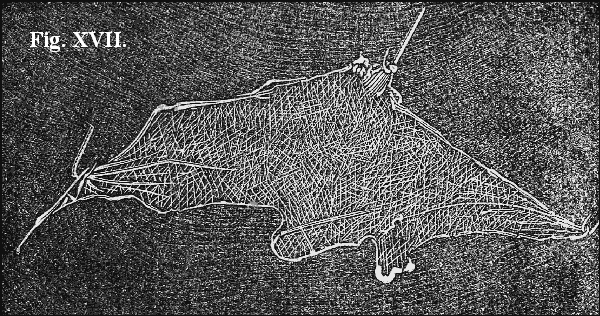
24. It is certain that the interspaces or cells of this membrane have no determinate form or size, that they communicate freely with each other, and that this communication extends over the whole body; for if a limb which has been infiltrated be frozen, a thousand small icicles will be formed, assuming the shape of the containing cells, some of which are found to be circular and others cylindrical, and so on. If air or water escape into any particular part of the body, it is often effused over the whole extent of it, and butchers are observed to inflate animals by making a puncture in some part where the cellular tissue is loose, and from [Pg 161] this one aperture the air is forced to the most distant parts of the body.
25. Cellular membrane, variously modified and disposed, forms the main bulk of all the other solid parts of the body, constituting their common envelope and bond of union, and filling up all their interstices. It is dense or loose, coarse or fine, according to its situation and office. Wherever it is subject to pressure, it is dense and firm, as in the palm of the hand and the sole of the foot; around the internal organs it is more loose and delicate, and it becomes finer and finer as it divides and subdivides, in order to envelope the soft and tender structures of the body.
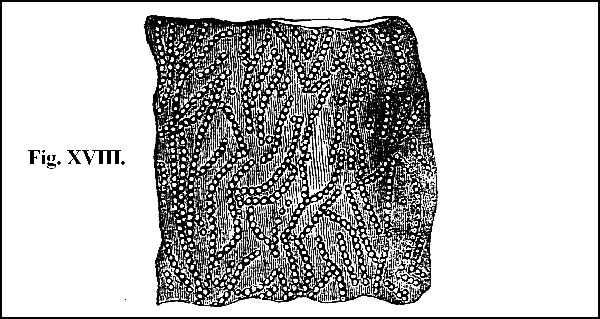
26. According to some who have carefully examined with the microscope its component threads, they consist of minute particles of a globular figure (fig. XVIII.); other microscopical observers regard [Pg 162] the cellular threads as coagulated or condensed animal substance, perfectly amorphous (without form).
27. Every part of this tissue is penetrated by arteries, veins, absorbents, and nerves, endowing it with properties truly vital, though in a less degree than any of the other primary tissues; and varied and important as the uses are which it serves in the economy, the most manifest, though certainly not the only ones, are those which depend upon its physical properties of cohesion, flexibility, extensibility, and elasticity.
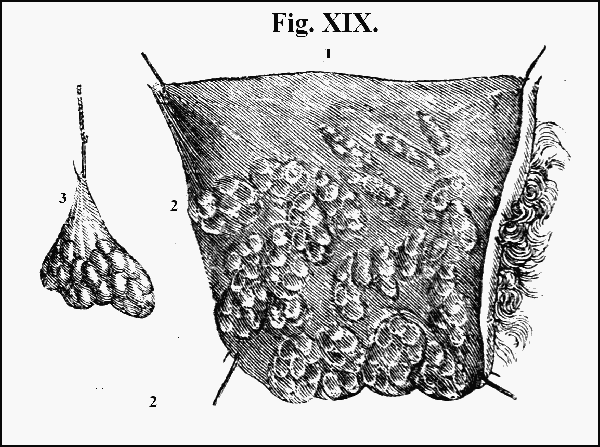
28. The tissue which contains the fat, termed the adipose, is the second form of membrane; it is obviously a modification of the cellular, from [Pg 163] which it differs both in the magnitude of its fibres, whence it constitutes a tougher and coarser web, and in their arrangement; for it is so disposed as to form distinct bags in which the fat is contained. Adipose tissue consists of rounded packets, separated from each other by furrows (fig. XIX. 2, 2); each packet is composed of small spheroidal particles (fig. XIX. 2, 2); each particle is again divisible into still smaller grains, which, on minute inspection, present the appearance of vesicles filled with the adipose matter (fig. XIX. 3).
29. The cells of the cellular tissue, as has been shown (24), are continuous over the whole body; but each adipose vesicle is a distinct bag, having no communication whatever with any other (fig. XIX. 2, 2). The cellular tissue is universally diffused; but the adipose is placed only in particular parts of the body; principally beneath the skin, and more especially between the skin and the abdominal muscles, and around some of the organs contained in the chest and abdomen, as the heart, the kidneys, the mesentery, and the omenta. In most of these situations some portion of it is generally found, whatever be the degree of leanness to which the body may be reduced; while in the cranium, the brain, the eye, the ear, the nose, and several other organs, there is none, whatever be the degree of corpulency. The uses of the fat, which are various, will be stated hereafter.
30. The third form of membrane is termed the
serous. Like the adipose, serous membrane is a modification of the cellular, and, like it also, it is limited in its situation to particular parts of the body, that is, to its three great cavities, namely, the head, the chest, and the abdomen. To the two latter it affords an internal lining, and to all the organs contained in all the three cavities, it affords a covering. By its external surface it is united to the wall of the cavity or the substance of the organ it invests; by its internal surface it is free and unattached; whence this surface is in contact only with itself, forming a close cavity or shut sac, having no communication with the external air. Smooth and polished (fig. XX.), it is rendered moist by a fluid which is supposed to be exhaled in a gaseous state from the serum of the blood; and from this serous fluid the membrane derives its name.

31. Though thin, serous membrane is dense, compact, and of great strength in proportion to its bulk: it is extensible and elastic; extensible, for it expands with the dilatation of the chest in inspiration; elastic, for it contracts with the diminished size of the chest in expiration. In like manner, it stretches with the enlargement of the stomach during a hearty meal, and contracts as the stomach gradually diminishes on emptying itself of its contents. It is furnished with no blood-vessels large enough to admit the colouring matter of the blood; but it is supplied with a great number of the colourless vessels termed exhalents, with the vessels termed absorbents, and with a few nerves. It indicates no vital properties, but those which are common to the simple form of the primary tissue. Its specific uses are to afford a lining to the internal cavities; to furnish a covering to the internal organs; by its polished and smooth surface, to allow a free motion of those organs on each other, and by the moisture with which it is lubricated, to prevent them from adhering together, however closely, or for however long a period they may be in contact.
32. The fourth form of membrane, the fibrous, named from the obvious arrangement of its component parts, consists of longitudinal fibres, large enough to be visible to the naked eye, placed parallel to each other, and closely united. Sometimes these fibres are combined in such a manner [Pg 166] as to form a continuous and extended surface, constituting a thin, smooth, dense, and strong membrane, such as that which lines the external surface of bones termed PERIOSTEUM, or the internal surface of the skull (dura mater). At other times, they form a firm and tough expansion (aponeurosis) which descends between certain muscles, separating them from each other, and affording a fixed point for the origin or insertion of neighbouring muscles; or which is stretched over muscles, and sometimes over even an entire limb, in order to confine the muscles firmly in their situation, and to aid and direct their action (fig. XXVII.). Fibrous membrane also constitutes the compact, strong, tough, and flexible bands used for tying parts firmly together, termed LIGAMENTS, principally employed in connecting the bones with each other, and particularly about the joints; and lastly, fibrous membrane forms the rounded white cords in which muscles often terminate, called TENDONS (fig. XXV., XXVI.), the principal use of which is to connect the muscles with the bones, and to serve as cords or ropes to transmit the action of the muscle to a distant point, in the accomplishment of which purposes their operation appears to be entirely mechanical.
33. The fifth form of membrane, the mucous (fig. XXI.), derives its name from the peculiar fluid with which its surface is covered, called mucus, and which is secreted by numerous minute glands, [Pg 167] imbedded in the substance of the membrane. As serous membrane forms a shut sac, completely excluding the air, mucous membrane, on the contrary, lines the various cavities which are exposed to the air, such as the mouth, the nostrils, the wind-pipe, the gullet, the stomach, the intestines, the urinary organs, and the uterine system. Its internal surface, or that by which it is attached to the passages it lines, is smooth and dense; its external surface, or that which is exposed to the contact of the air, is soft and pulpy, like the pile of velvet (fig. XXI.). It bears a considerable resemblance to the external surface of the rind of the ripe peach.
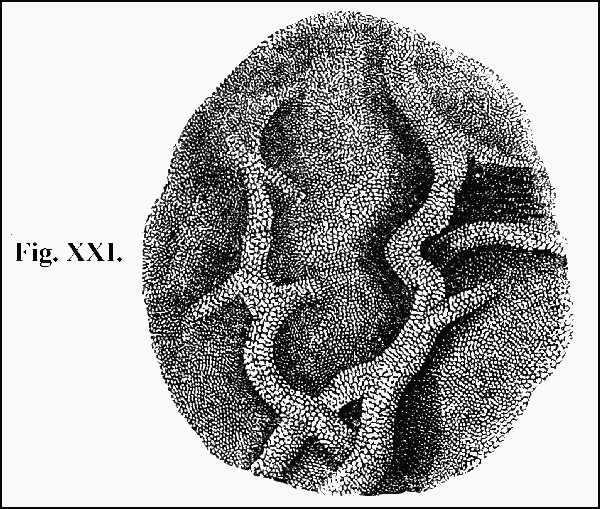
Unlike all the other tissues of this class, the mucous membranes are the immediate seat of some of the [Pg 168] most important functions of the economy; in the lung, of respiration; in the stomach, of digestion; in one part of the intestine, of chylification; in another, of excretion; while in the mouth and nose, they are the seat of the animal functions of taste and smell; and they are highly organized in accordance with the importance of the functions they perform.
34. The last form of membrane which it is necessary to our present purpose to particularize, is that which constitutes the external covering of the body, and which is called the skin. The skin is everywhere directly continuous with the mucous membranes that line the internal passages, and its structure is perfectly analogous. Both the external and the internal surface of the body may be said therefore to be covered by a continuous membrane, possessing essentially the same organization, and almost identically the same chemical composition. The skin is an organ which performs exceedingly varied and important functions in the economy, to the understanding of which it is necessary to have a clear conception of its structure; some further account of it will therefore be required; but this will be more advantageously given when the offices it serves are explained.
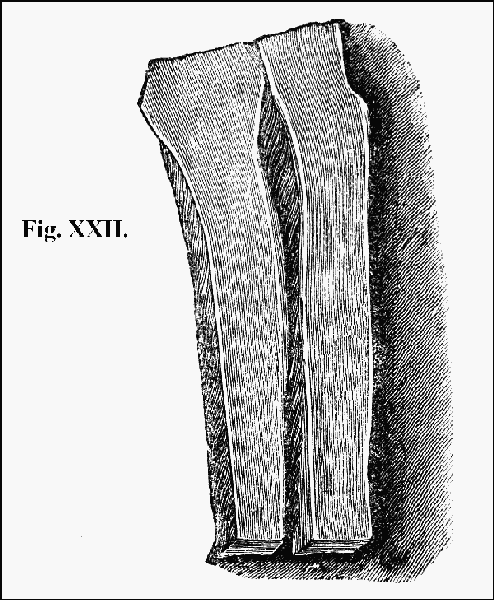
35. Such is the structure, and such are the properties, of the first distinct form of organized matter. The second primary tissue, termed the CARTILAGINOUS (fig. XXII.), is a substance intermediate [Pg 169] between membrane and bone. The nature of its organization is not clearly ascertained. By some anatomists, it is regarded as a uniform and homogeneous substance, like firm jelly, without fibres, plates, or cells; others state that they have been able to detect in it longitudinal fibres, interlaced by other fibres in an oblique and transverse direction, but without determinate order. All are agreed that it is without visible vessels or nerves: not that it is supposed to be destitute of them, but that they are so minute as to elude observation. Its manifest [Pg 170] properties are wholly mechanical. It is dense, strong, inextensible, flexible, and highly elastic. It is chiefly by its property of elasticity that it accomplishes the various purposes it serves in the economy. It is placed at the extremities of bones, especially about the joints, where, by its smooth surface, it facilitates motion, and, by its yielding nature, prevents the shock or jar which would be produced were the same kind and degree of motion effected by a rigid and inflexible substance. Where a certain degree of strength with a considerable degree of flexibility are required, it supplies the place of bone, as in the spinal column, the ribs and the larynx.
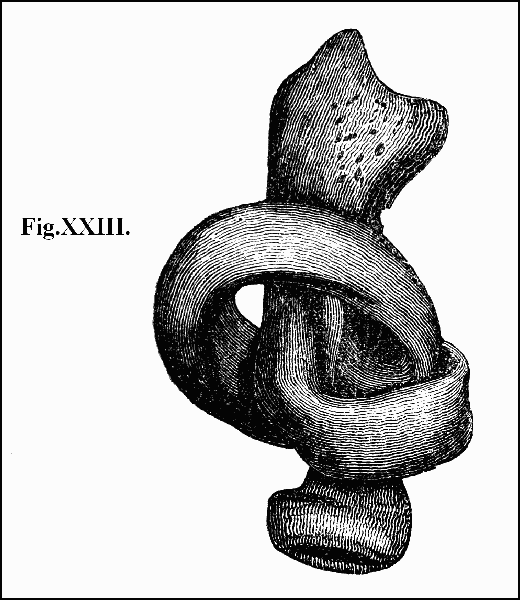
36. The third distinct form of organized matter is termed the OSSEOUS tissue. Bone is composed of two distinct substances, an animal and an earthy matter: the former organic, the latter inorganic. The animal or organic matter is analogous both in its nature and in its arrangement to cellular tissue; the earthy or inorganic matter consists of phosphoric acid combined with lime, forming phosphate of lime. The cellular tissue is aggregated into plates or laminæ, which are placed one upon another, leaving between them interspaces or cells, in which is deposited the earthy matter (phosphate of lime). If a bone, for example, the bone called the radius, one of the bones of the fore-arm, be immersed in diluted sulphuric, nitric, muriatic, or acetic acid, it retains its original bulk [Pg 171] and shape; it loses, however, a considerable portion of its weight, while it becomes so soft and pliable, that it may be tied in a knot (fig. XXIII.). In this case, its earthy matter is removed by the agency of the acid, and is held in solution in the fluid; what remains is membranous matter (cellular tissue). If the same bone be placed in a charcoal fire, and the heat be gradually raised to whiteness, it appears on cooling as white as chalk; it is extremely brittle; it has lost much of its weight, yet its bulk and shape continue but little changed. In this case, the membraneous matter is [Pg 172] wholly consumed by the fire, while the earth is left unchanged (fig. XXIV.). Every constituent atom of bone consists, then, essentially of animal and earthy matter intimately combined. A little more than one-third part consists of animal matter (albumen), the remaining two-thirds consist of earthy matter (phosphate of lime); other saline substances, as the fluate of lime and the phosphate of magnesia, are also found in minute quantity, but they are not peculiar to bone.

37. In general, the osseous tissue is placed in the interior of the body. Even when bone approaches the surface, it is always covered by soft parts. It is supplied with but few blood-vessels, with still fewer nerves, with no absorbents large enough to be visible, so that though it be truly alive, yet its vital properties are not greatly developed. The arrangement of its component particles is highly curious; the structure, the disposition, and the connexion of individual bones afford striking examples of mechanism, and accomplish most important uses in the economy; but those [Pg 173] uses are dependent rather upon mechanical than vital properties. The chief uses of bone are— 1. By its hardness and firmness to afford a support to the soft parts, forming pillars to which the more delicate and flexible organs are attached and kept in their relative positions. 2. To defend the soft and tender organs by forming a case in which they are lodged and protected, as that formed by the bones of the cranium for the lodgment and protection of the brain (fig. XLVII.); by the bones of the spinal column for the lodgment and protection of the spinal cord (fig. XLVIII.); by the bones of the thorax (fig. LIX.), for the lodgment and protection of the lungs, the heart, and the great vessels connected with it (fig. LIX.). 3. By affording fixed points for the action of the muscles, and by assisting in the formation of joints to aid the muscles in accomplishing the function of locomotion.
38. All the primary tissues which have now been considered consist of precisely the same proximate principles. Albumen is the basis of them all; with the albumen is always mixed more or less gelatin, together with a minute quantity of saline substance: to the osseous tissue is superadded a large proportion of earthy matter. With the exception of the mucous, the organization of all these tissues is simple; their vital properties are low in kind and in degree; their decided properties are physical, and the uses they serve in the economy are almost wholly mechanical.
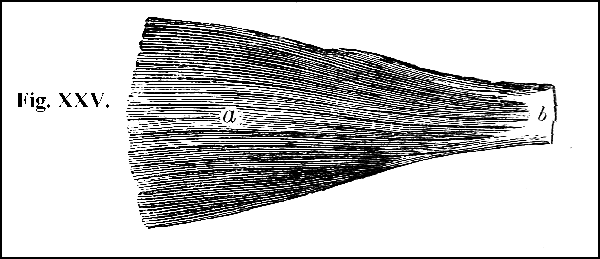
39. But we next come to a tissue widely different in every one of those circumstances, a tissue consisting of a new kind of animal matter, and endowed with a property not only peculiar to itself, but proper to living substance, and characteristic of a high degree of vital power. Muscular tissue, the fourth distinct form of animal matter, commonly known under the name of flesh, is a substance resembling no other in nature. It consists of a soft and pulpy substance, having little cohesive power, arranged into fibres which are distinctly visible to the naked eye, and which are disposed in a regular and uniform manner, being placed close and parallel to each other (fig. XXV.). These fibres are every where pretty uniformly the same in shape, size, and general appearance, being delicate, soft, flattened, and though consisting only of a tender pulp, still solid (fig. XXV.). When examined under the microscope, fibres, which to the naked eye appear to be single threads, are seen to divide successively into smaller threads, the [Pg 175] minutest or the ultimate division not exceeding, as is supposed, the 40,000th part of an inch in diameter. On the other hand, the fibres which are large enough to be visible to the naked eye, are obviously aggregated into bundles of different magnitude in different muscles, but always of the same uniform size in the same muscle (fig. XXV.).
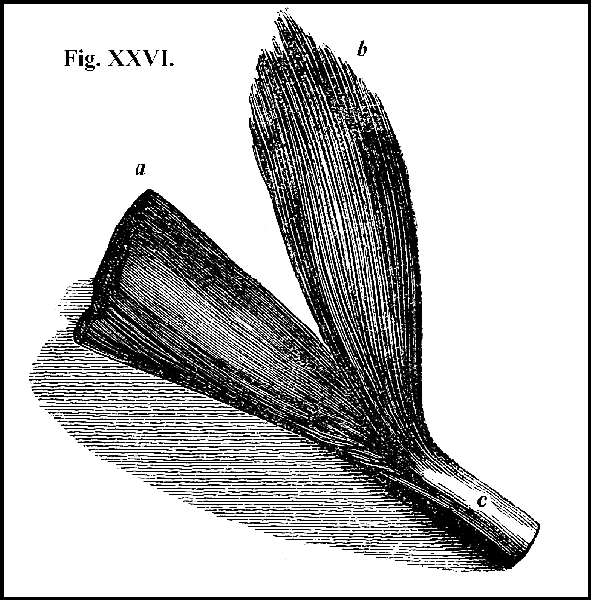
40. The ultimate thread, or the minutest division of which the muscular fibre is susceptible, is called a filament; the smallest thread which can be distinguished by the naked eye is termed a[Pg 176] fibre (fig. XXVI.); and the bundle which is formed by the union of fibres is denominated a fasciculus. The proper muscular substance is thus arranged into three distinct forms progressively increasing in size,—the filament, the fibre, and the fasciculus. The filament, the fibre, the fasciculus, as well as the muscle itself, formed by the aggregation of fasciculi, is each inclosed in its own distinct sheath of cellular membrane (fig. XXVI. a).
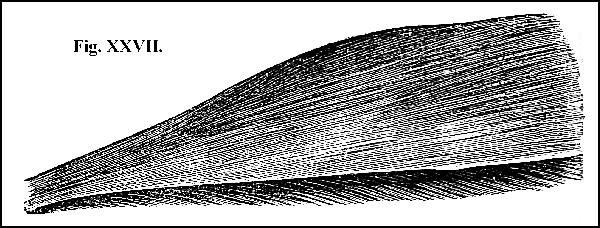
41. The composition of the ultimate filament has been very carefully examined by many distinguished physiologists with microscopes of high magnifying power. Under some of these microscopes the filament appears to consist of a series of rounded particles or globules of the same size as the particles of the blood when deprived of their colouring matter, so that it looks like a string of pearls (fig. XXVIII.), each globule being commonly stated to be about the 2000th part of an inch in diameter. But it is [Pg 177] now pretty generally agreed that this globular appearance of the ultimate muscular fibre vanishes under the more improved microscopes of the present day, and, as viewed by the latter, appears as a peculiar pulpy substance arranged into threads of extreme minuteness, placed close and parallel to each other, intersected by a great number of delicate lines passing transversely across the muscular threads (fig. XXIX.),
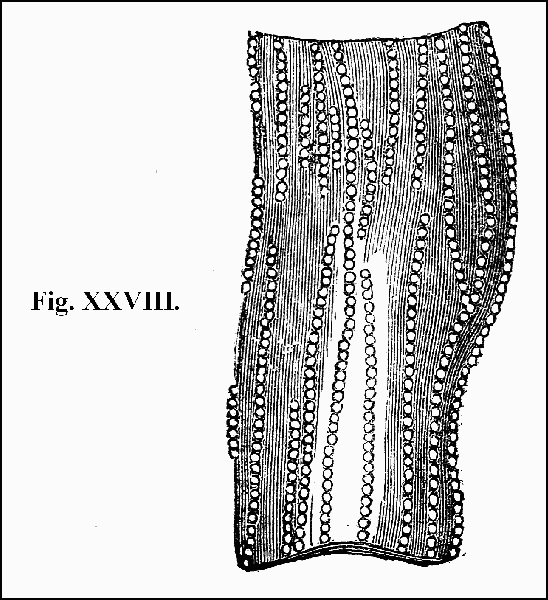
42. With the exception of the organs of sense, the muscular tissue is more abundantly supplied with arteries, veins, and nerves, than any other substance of the body. Every ultimate thread or filament appears to be provided with the ultimate [Pg 178] branch of an artery, vein, and nerve. These vessels are seen ramifying on the surface of the delicate web of membrane that incloses the pulp, but cannot be traced into it.

43. The proximate principle of which the muscular pulp is composed is fibrin. From the pulp, when inclosed in its sheath of membrane, albumen, jelly, various salts, and a peculiar animal extract called osmazome, are also obtained; but these substances are probably derived from the membranous, not the muscular, matter. Fibrin contains a larger proportion of azote, the element peculiar to the animal body, and by the possession of which its chemical composition is distinguished from that of the vegetable, than any other animal substance.

44. Muscular tissue possesses a slight degree of [Pg 179] cohesion, a high degree of flexibility and extensibility, but no degree of elasticity; for although muscle, considered as a compound of muscular substance and membrane, be highly elastic, yet this property is probably altogether owing to the membranous matter in which it is enveloped. Its peculiar and distinctive property is vital, not physical, and consists in the power of diminishing its length, or of contracting or shortening itself on the application of a stimulus. This property, which is termed contractility, is the great, if not the sole source of motion in the body. Without doubt, elasticity and gravity, under the generating and controlling powder of contractility, aid in accomplishing various kinds of motion. Thus membranes, tendons, ligaments, cartilages, and bones, by their physical and mechanical properties, modify, economize, facilitate, concentrate and direct [Pg 180] the motive power generated by the pure muscular substance; but still the only real source of motion in the body is muscular tissue, and the only mode in which motion is generated is by contractility. This will be more fully understood hereafter.
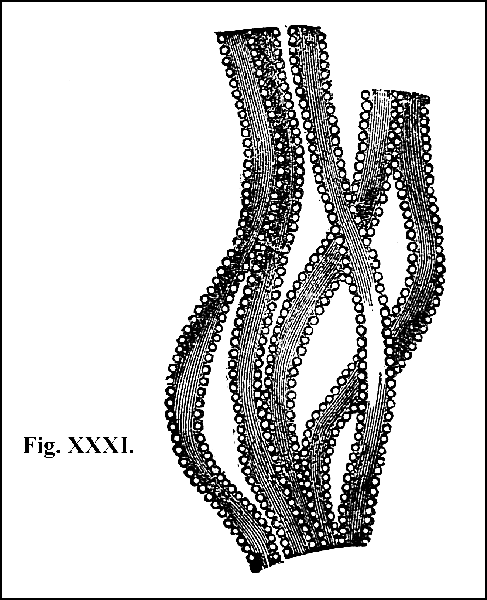
45. The last primary tissue, termed the NERVOUS, is equally distinct in nature and peculiar in property. It consists of a soft and pulpy matter, of a brownish white colour (fig. XXX.). According to some, the nervous, like the muscular pulp, is composed of minute globules, arranged in the same manner like a string of pearls (fig. XXXI.); according to others, [Pg 181] it consists of solid elongated threads, of a cylindrical form, differing in thickness from that of a hair to the finest fibre of silk. The pulp, whatever its form of aggregation, is inclosed in a sheath of delicate cellular tissue. This external or containing membrane is called the neurilema, or the nerve-coat; the internal or contained substance, the proper nervous matter, is termed the nerve-string. The nerve-string, enveloped in its nerve-coat, constitutes the nervous filament. As in the muscle, so in the nerve, many filaments unite to form a fibre, many fibres to form a fasciculus, and many fasciculi to form the large cord termed a nerve. Moreover, as in the muscle, so in the nerve, the filament, the fibre, the fasciculus, the nervous cord itself, are each enveloped in its own distinct sheath of cellular membrane; but the arrangement of the nervous fibres differs from that of the muscular in this, that though the nervous fibres are placed in juxtaposition, yet they do not, like the muscular, maintain through their entire course a parallel disposition, but cross and penetrate each other, so as to form an intimate interlacement (fig. XXXII.).
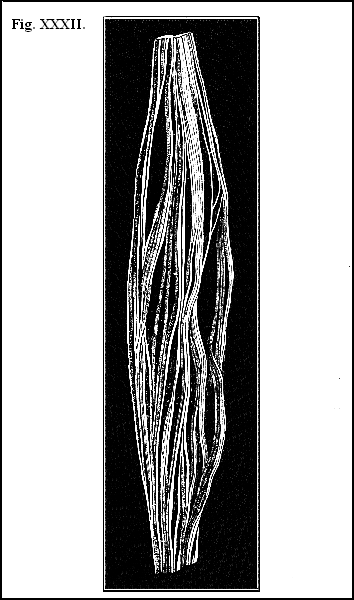
46. The nervous pulp is at least as liberally supplied with blood-vessels as the muscular; the vessels are spread out upon the nerve-coat, in which they divide into innumerable branches of extreme minuteness, the distribution of which is so perfect, that there is not a particle of nervous [Pg 183] matter which is not supplied both with an arterial and a venous vessel. Hence the neurilema is not merely a sheath containing and protecting the nervous pulp, but it affords an extended mechanical surface for sustaining the arterial vessels, from which the pulp is probably secreted, and certainly nourished.
47. Albumen, in conjunction with a peculiar fatty matter, constitutes the chief proximate principles of which the nervous tissue is composed. To these are added a small proportion of the animal substance termed osmazome, a minute quantity of phosphorus, some salts, and a very large proportion of water; for out of one hundred parts of nervous substance, water constitutes as much as eighty. Its peculiar vital property is sensibility; and as all motion depends on the contractility of the muscular fibre, so all sensation depends on the sensibility of the nervous substance.
48. Such are the primary tissues, or the several kinds of organized matter of which the body is composed; and from this account it is obvious that they consist of three only—namely, the concrete matter forming the basis of membrane, the pulpy matter forming the proper muscular substance, and the pulpy matter forming the proper nervous substance. Of these three kinds of animal matter the component parts of the body consist. In combining to form the different structures, these primary substances are intermixed and arranged in a great [Pg 184] variety of modes; and from these combinations and arrangements result either an organ, a system, or an apparatus.
49. As filaments unite to form fibres, and fibres to form tissues, so tissues unite to form organs: that is, bodies having a determinate size and figure, and capable of performing specific actions. The cellular, the muscular, and the nervous tissues are not organs; membranes, muscles, and nerves are organs. The tissue, the simple animal substance, is merely one of the elements of which the organ is composed; the organ is compounded of several of those simple substances, arranged in a determinate manner, and moulded into a given shape, and so constituting a specific instrument. The basis of the muscle is muscular tissue; but to this are added, invariably, membrane, often tendon, and always vessels and nerves. It is this combination that forms the specific instrument called a muscle, and that renders it capable of performing its specific action. And every such combination, with its appropriate endowment, constitutes an organ.
50. Organs are arranged into groups or classes, according as they possess an analogous structure, and perform an analogous function; and this assemblage constitutes a SYSTEM. All the muscles of the body, for example, whatever their size, form, situation, or use, have an analogous structure, and perform an analogous function, and hence are [Pg 185] classed together under the name of the muscular system. All the bones, whatever their figure, magnitude, density, position, or office, are analogous in structure and function; and hence are classed together under the name of the osseous system. For the same reason, all the cartilages, ligaments, vessels and nerves, form respectively the cartilaginous, ligamentous, vascular and nervous systems.
51. An APPARATUS, on the contrary, is an assemblage of organs, it may be differing widely from each other in structure, and exercising various and even opposite functions; but all nevertheless concurring in the production of some common object. The apparatus of nutrition consists of the organs of mastication, deglutition, digestion, absorption, and assimilation. Among the individual organs which concur in carrying on these functions may be reckoned the lips, the teeth, the tongue, the muscles connected with the jaws, the gullet, the stomach, the duodenum, the small intestines, the pancreas, the liver, the lacteal vessels, the mesenteric glands, and the lungs. Many of these organs have no similarity in structure, and few have any thing analogous in function; yet all concur, each in its appropriate mode and measure, to the conversion of the aliment into blood. In the apparatus of respiration, in that of circulation, of secretion, of excretion; in the apparatus of locomotion, in the apparatus of sensation, and more especially in the apparatus of the specific sensations,—vision, [Pg 186] hearing, smell, taste, touch, organs are combined which have nothing in common but their concurrence in the production of a common end: but this concurrence is the principle of their combination; and the individual organs having this conjoint operation, taken together, constitute an apparatus.
52. A clear idea may now be affixed to the terms structure and organization. Structure may be considered as synonymous with arrangement; the disposition of parts in a determinate order; that which is constructed or built up in a definite mode, according to a determinate plan. The arrangement of the threads of the cellular web into areolæ or cells; the combination of the primary threads into fibres or laminæ; the disposition of the muscular pulp into filaments, placed parallel to each other; the investment of the filaments in membraneous sheaths; the combination of the filaments, included in their sheaths, into fibres; the aggregation of fibres into fasciculi; and the analogous arrangement and combination of the nervous pulp, are examples of structure. But when those structures are applied to particular uses; when they are so combined and disposed as to form a peculiar instrument, endowed with a specific function; when the cellular fibres, for example, are so arranged as to make a thin, dense, and expanded tissue; when to this tissue are added blood-vessels, absorbents, and nerves; when, in a word, a membrane is constructed, an organ is formed; when, [Pg 187] in like manner, to the muscular and the nervous fibres, arranged and moulded in the requisite mode, are added blood-vessels, absorbents, and nerves, other organs are constructed capable of performing specific functions: and this is organization—the building up of organs—the combination of definite structures into special instruments. Structure is the preparatory process of organization; the one is the mere arrangement of the material; the other is the appropriation of the prepared material to a specific use.
53. The term organization is employed in reference both to the component parts of the body, and to the body considered as a whole. We speak of an organized substance and of an organized body. An organized substance is one in which there is not only a definite arrangement of its component parts (structure), but in which the particular arrangement is such as to fit it for accomplishing some special use. Every organized substance is therefore essentially a special organ; limited in its object it may be, and perhaps only conducive to some further object; but still its distinctive character is, that it has a peculiar structure, fitting it for the accomplishment of some appropriate purpose. On the other hand, an organized body is a congeries of organs—the aggregate of the individual organs. Attention was directed in the early part of this work to one peculiar and essential character, by which such an organized [Pg 188] is distinguished from an unorganized body. Between the individual parts of the organized body there is so close a relation, that no one of them can be removed or injured, or in any manner affected without a corresponding affection of the whole. The action of the heart cannot cease without the cessation of the action of the lung; nor that of the lung without that of the brain; nor that of the brain without that of the stomach; in a word, there is no organ in whatever distant nook of the system it be placed, or however apparently insignificant its function, that is not necessary to the perfection of the whole. But into whatever number of portions an unorganized body may be divided, each portion retains the properties of the mass, and constitutes in itself a perfect existence; there being no relation between its individual parts, excepting that of physical attraction: on the contrary, each component part of an organized body, being endowed with some appropriate and specific power, on the exercise of which the powers of all the other parts are more or less dependent, the whole must necessarily suffer if but one part fail.
54. From the whole, then, we see that the human body is a congeries of organs; that those organs are constructed of a few simple tissues; and that all its parts, numerous, diversified, and complex as they are, are composed of but three primary forms of animal matter variously modified and combined.
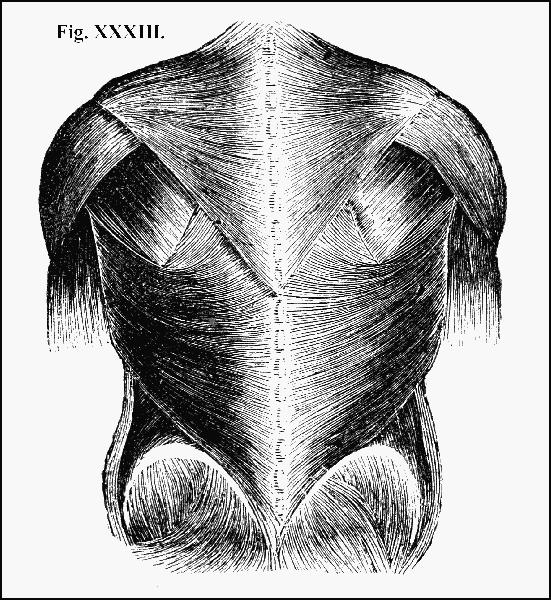
55. But though by the analysis of its component parts, this machine, so complex in its construction, and so wonderfully endowed, may be reduced to this state of simplicity; and although this analytical view of it be highly useful in enabling us to form a clear conception of the nature of its composition; yet it is only by considering its individual parts such as they actually are, and by studying their situation, connexion, structure, and action, that [Pg 190] we can understand it as a whole, and apply our knowledge of it to any practical use.
56. Viewing then the human body as a complicated whole, as a congeries of organs made up of various combinations of simple tissues, it may be observed, in reference to its external configuration, that it is rounded. This rounded form is principally owing to the large proportion of fluids which enter into its composition. The roundness of the face, limbs, and entire surface of the child, are in striking contrast to the unequal and irregular surface of the old man, whose humours are comparatively very much smaller in quantity.
57. The length of the human body exceeds its breadth and thickness; the degree of the excess varying at different periods of life, and according to the peculiar constitution of the individual. In the extremities, the bones, muscles, vessels, and nerves, are especially distinguished by their length.
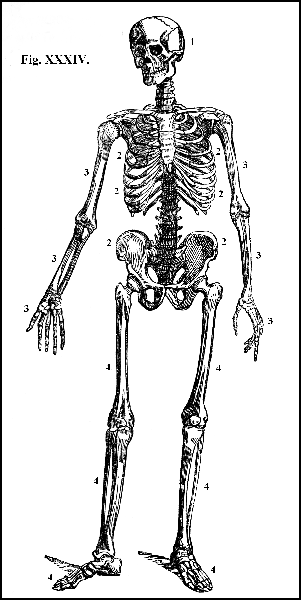
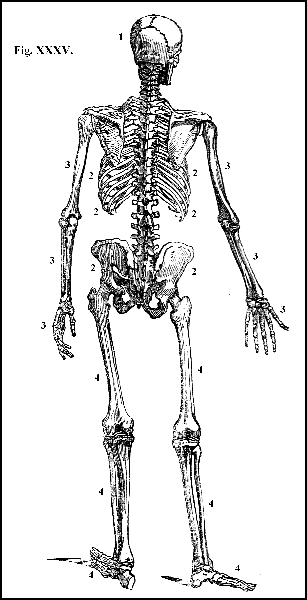
58. The form of the human body is symmetrical, that is, it is capable of being divided into two lateral and corresponding halves. Suppose a median line to pass from the vertex of the head through the centre of the spinal column (fig. XXXIV. 1, 2); if the body be well formed, it will be divided by this line into two exactly equal and corresponding portions (fig. XXXV. 1). This symmetrical disposition of the body is not confined to its external configuration. It is true of many of the internal organs; but principally, as has been already stated, of those that belong to the animal life. The brain and the spinal cord are divisible into two exactly equal halves (figs. XLVIII. d, and XLIX. 1, 2, 3); the organs of sense are double and symmetrical: the muscles of one side of the body exactly correspond to those of the other (fig. XXXIII.); the two hands and arms and the two lower extremities are alike (figs. XXXIV., XXXV.); but for the most part, the organs of the organic life, the stomach, the intestines, the liver, the spleen, for example, are single, and not symmetrical.
59. The human body is divided into three great portions, the head, the trunk, and the extremities (figs. XXXIV. and XXXV. 1, 2, 3, 4).
60. By the head is meant all that part of the body which is placed above the first bone of the neck (fig. XXXIV. 1). It is of a spheroidal figure, broader and deeper behind than before, somewhat like an egg in shape, with the broad end behind; it is flattened at its sides (figs. XXXV. 1, and XXXVI. 2, 4). Its peculiar figure renders it at once stronger and more capacious than it could have been had it possessed any other form. It is supported by its base on the spinal column, to which it is attached by the peculiar structure termed a joint (fig. XXXIV.), and fastened by ligaments of exceeding strength.
61. The head contains the central organ of the nervous system; the organs of the senses, with the exception of that of touch; and the organs of [Pg 194] mastication. It comprehends the cranium and the face. Both are composed partly of soft parts, as the teguments, namely, skin, fat, &c., and muscles; and partly of bones.
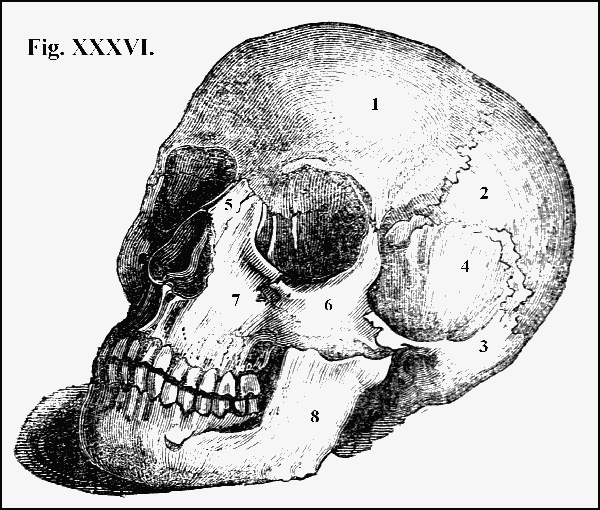
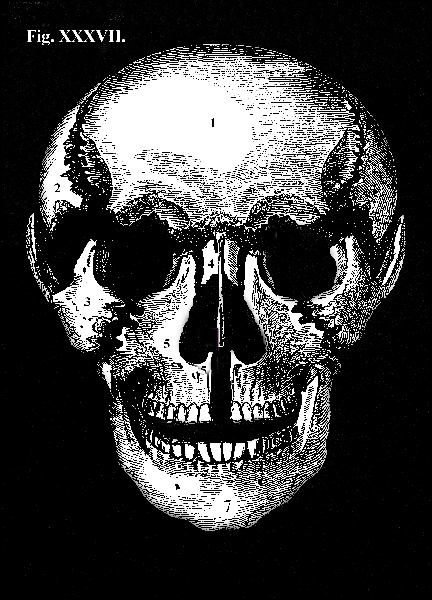
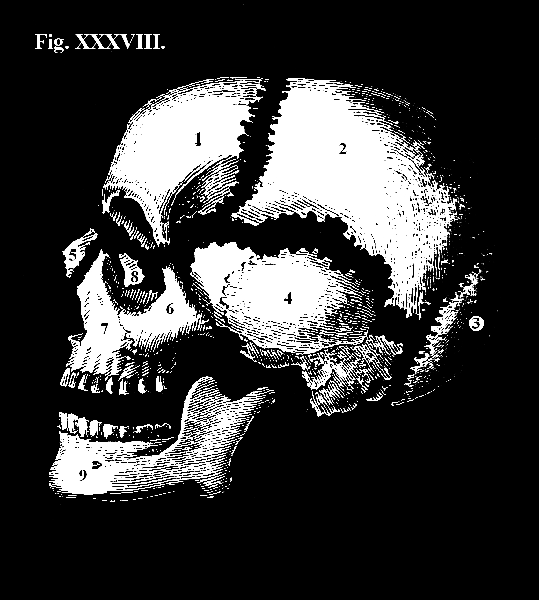
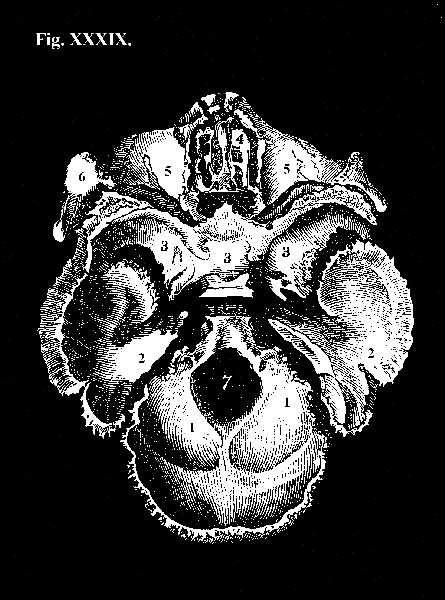
62. The bones of the cranium are eight in number, six of which are proper to the cranium, and two are common to it and to the face. The six bones proper to the cranium are the frontal (fig. XXXVII. 1), the two parietal (fig. XXXVI. 2), the two temporal (fig. XXXVIII. 4), and the occipital (fig. XXXVIII. 3); the two common to the cranium and face are the ethmoidal (fig. XXXIX. 4), and the sphenoidal (fig. XXXIX.3). The frontal bone forms the entire forepart of the vault (fig. XXXVII. 1); the two parietal form the upper and middle part of it (fig. XXXVIII. 2); the two temporal form the lower part of the sides (fig. XXXVIII. 4); the occipital forms the whole hinder part, together with a portion of the base (figs. XXXVIII. 3, XXXVI. 3, XXXIX. 1); while the ethmoidal forms the forepart, and the sphenoidal the middle part of the base (fig. XXXIX. 3, 4).
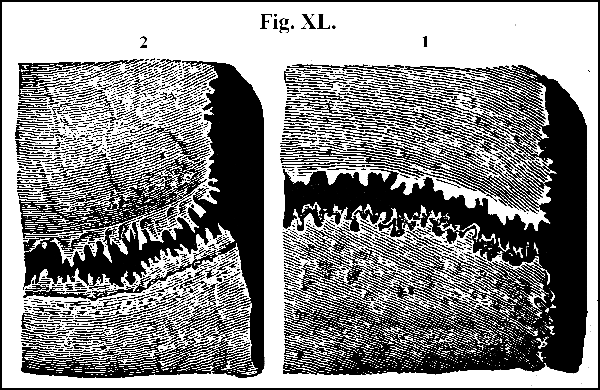
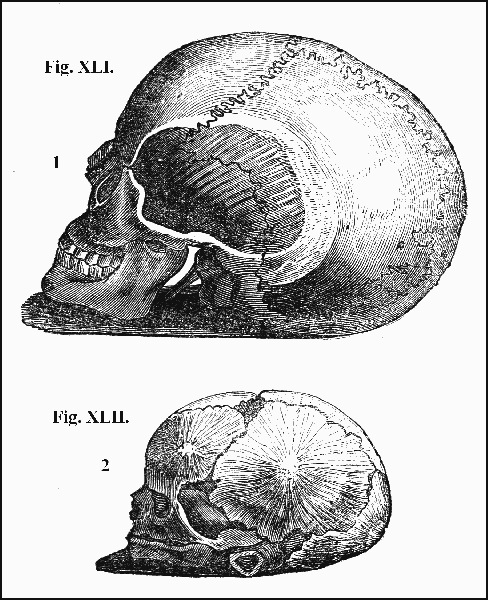
63. These bones are firmly united together. The union of bones is technically called an articulation or joint. All joints are either immoveable or moveable. The union of the bones of the cranium affords an example of an immoveable articulation. Prominences and indentations, like the teeth of a saw, are formed in the margins of the contiguous bones (figs. XXXVIII. and XL.). At these inequalities of surface, which are exactly adapted to each other (figs. XXXVIII. and XL.), the two bones are in immediate apposition in such a manner as to preclude the possibility of motion, and even to render the separation extremely difficult. This mode of articulation is termed a suture. There are certain advantages in constructing the cranium of several distinct bones, and in uniting [Pg 200] them in this peculiar mode. 1. The walls of the vault are stronger than they could have been had they been formed of a single piece. 2. In the fœtus, the bones are at some distance from each other (fig. XLII.); at birth, they yield and overlap one another; and in this manner they conduce to the security and ease of that event. 3. Minute vessels pass abundantly and securely through the interstices of the sutures to and from the interior of the cranium; in this manner, a free communication is established between the vessels within and without this cavity. 4. It is probable that the shock produced by external violence is diminished in consequence of the interruption of the vibration occasioned by the suture; it is certain that fracture is prevented by it from extending as far as it would do in one continued bony substance.
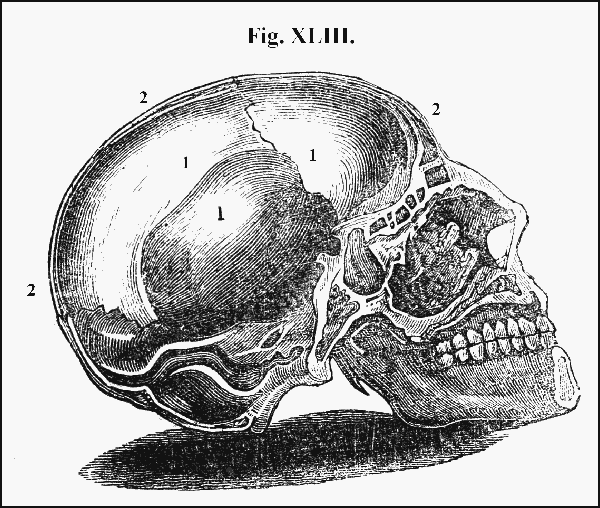
64. The vault of the cranium forms a cavity which contains the brain (fig. XLIII.and XLVIII.) The size of this cavity is invariably proportioned to that of the organ it lodges and protects. The form and magnitude of the cavity, and consequently the shape and size of the cranium, depend upon the brain, and not of the brain upon the cranium. The soft parts model and adapt to themselves the hard, and not the hard the soft. The formation of the brain in the fœtus is anterior to that of the case which ultimately contains it; and the hard bone is moulded upon the soft pulp, not the pulp upon the bone. At every period of life, on the [Pg 201] inner surface of the cranium there are visible impressions made by the convolutions of the brain, and the ramifications of the arteries (figs. XXXIX. 1, 2, and XL. 2), and on its external surface are depressions occasioned by the action of the external muscles. Nor does the modifying power of the brain over the bones of the cranium terminate at birth. The formation of bone, always a slow process, is never completed until the child has attained its third or fourth year, and often not until a much later period. At this tender age, the bones, which in advanced life are hard and rigid, are comparatively soft and yielding, and consequently more readily [Pg 202] receive and retain the impression of the convolutions and of the other projecting parts of the brain, by which they are sometimes so deeply marked, that an attentive examination of the inner surface of the cranium is of itself sufficient to determine not only that some part, but to indicate the very part of the brain which has been preternaturally active. At this tender age, pressure, internal or external, general or partial, may readily change the form of the cranium. If, by a particular posture, the head of a child be unequally balanced on the spine, the brain will press more on that side of the cranium than on the other; the organ will expand in the direction to which it inclines; that portion of it will become preternaturally developed, and consequently the balance of its functions will be disturbed. An awkward way of standing or sitting, perhaps contracted inadvertently and kept up by habit; a wry neck; any cause that keeps the head constantly inclined to one side, may produce this result, examples of which and of its consequences will be given hereafter.
65. Tracing them from without inwards we see, then, that the various coverings afforded to the brain, the central organ of the animal life, seated in its vaulted cavity, are: 1. The tegument, consisting of the skin and of cellular and adipose membrane. 2. Beneath the tegument, muscles, in the forepart and at the vertex, comparatively slender and delicate; at the sides and posteriorly, [Pg 203] thick, strong, and powerful (fig. XLIV.). 3. Beneath the muscles, a thin but dense membrane, termed the pericranium, lining the external surface of the cranial bones. 4. Beneath the pericranium, the bony substance of the cranium, consisting of two firm and hard bony plates, with a spongy, bony structure, called diploë, interposed between them (fig. XLIII. 2). 5. Immediately in contact with the inner surface of the bony substance of the cranium, and forming its internal lining, the dense and strong membrane, called the dura mater, not only affording a general covering to the brain, but sending firm partitions between individual portions of it (fig. XLVIII. c.). 6. A serous membrane lining the internal surface of the dura mater, and reflected over the entire surface of the brain, termed the arachnoid tunic. 7. A thin and delicate membrane in immediate contact with the substance of the brain, descending between all its convolutions, lining all its cavities and enveloping all its fibres, called the pia mater. 8. An aqueous fluid, contained between the arachnoid membrane and the pia mater. Skin, muscle, pericranium, bone, dura mater, arachnoid membrane, pia mater, and aqueous fluid, superimposed one upon another, form, then, the covering and defence of the brain; so great is the care taken to protect this soft and tender substance.
66. The bones of the face consist of fourteen, namely, the two superior maxillary or jaw-bones [Pg 204] (fig. XXXVII. 5), the two malar or cheek bones (fig. XXXVII. 3), the two nasal bones (fig. XXXVII. 4), the two palate bones, the two ossa unguis (fig. XXXVIII. 8), the two inferior turbinated bones, the vomer (fig. XXXVII. 6), and the inferior maxilla or the lower jaw (fig. XXXVII. 7.) This irregular pile of bones is divided into the superior and inferior maxilla or jaws; the superior maxilla being the upper and immoveable portion of the face; the inferior maxilla being the lower and moveable portion of it. Besides these bones, the face contains thirty-two teeth, sixteen in each jaw. The bones of the upper jaw are united together by sutures, and the union is so firm, that they have no motion but what they possess in common with the cranium. The lower jaw is united by a distinct articulation with the cranium (figs. XXXIV. and XXXV.).
67. Besides the bones and the teguments, the face contains a number of muscles, which for the most part are small and delicate (fig. XLIV.), together with a considerable portion of adipose matter; while, as has been stated, the face and head together contain all the senses, with the exception of that of touch, which is diffused, more or less, over the entire surface of the body.
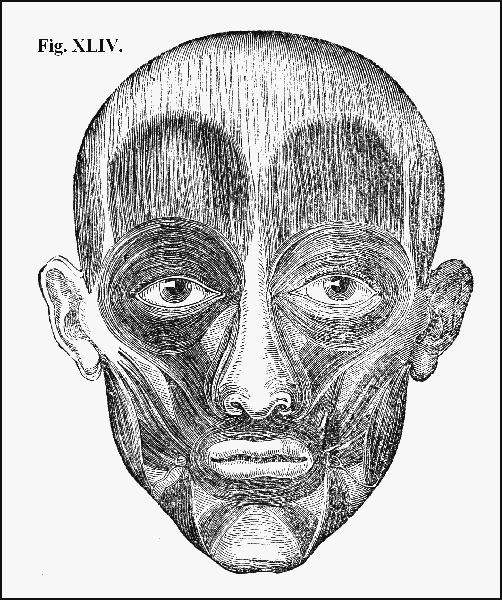
68. The second great division of the body, termed the TRUNK, extends from the first bone of the neck to that called the pubis in front, and to the lower end of the coccyx behind (fig. XXXIV. 2). It is subdivided into the thorax, the abdomen, and the pelvis (fig. XLV.).
69. The thorax or chest extends above from the first bone of the neck, by which it is connected with the head, to the diaphragm below, by which it is divided from the abdomen (figs. XLV. and [Pg 206] LXI.). It consists partly of muscles and partly of bones; the muscular and the osseous portions being in nearly equal proportions. Both together form the walls of a cavity in which are placed the central organs of circulation and respiration (fig. LX. 2, 5). The chief boundaries of the cavity of the thorax before, behind, and at the sides, are osseous (fig. XLV.); being formed before, by the sternum or breast-bone (fig. XLV. 6); behind, by the spinal column or back bone (fig. XLV. 2, 4); and at the sides, by the ribs (fig. XLV. 7). Below, the boundary is muscular, being formed by the diaphragm (fig. LXI. 2), while above the thorax is so much contracted (fig. XLV.), that there is merely a space left for the passage of certain parts which will be noticed immediately.
70. The figure of the thorax is that of a cone, the apex being above (fig. XLV.), through the aperture of which pass the tubes that lead to the lungs and stomach, and the great blood-vessels that go to and from the heart (fig. LX.). The base of the cone is slanting, and is considerably shorter before than behind, like an oblique section of the cone (fig. XLV.).
71. The osseous portion of the walls of the thorax is formed behind by the spinal column, a range of bones common indeed to all the divisions of the trunk; for it constitutes alike the posterior boundary of the thorax, abdomen, and pelvis (fig. [Pg 207] XLV. 2, 4, 6). It is composed of thirty distinct bones, twenty-four of which are separate and moveable on one another, and on this account are called true vertebræ (fig. XLV. 2, 4); the other five, though separate at an early period of life, are subsequently united into a single solid piece, called the sacrum (fig. XLV. 5). The bones composing this solid piece, as they admit of no motion on each other, are called false vertebræ (fig. XLV. 5). To the extremity of the sacrum is attached the last bone of the series, termed the coccyx (fig. XXXV.).
72. From above downwards, that is, from the first bone of the neck to the first bone of the sacrum, the separate bones forming the column progressively increase in size; for this column is the chief support of the weight of the head and trunk, and this weight is progressively augmenting to this point (fig. XLV. 2, 4). From the sacrum to the coccyx, the bones successively diminish in size, until, at the extremity of the coccyx, they come to a point (fig. XXXV.). The spinal column may therefore be said to consist of two pyramids united at their base (fig. XLV. 4, 5). The superior pyramid is equal in length to about one third of the height of the body, and it is this portion of the column only that is moveable.
73. The two surfaces of the spinal column, the anterior and the posterior, present a striking contrast (figs. XXXIV. and XXXV.). The anterior [Pg 208] surface, which in its whole extent is rounded and smooth, is broad in the region of the neck, narrow in the region of the back, and again broad in the region of the loins (fig. XLV. 2, 4.). It presents three curvatures (fig. XLV. 2, 4); the convexity of that of the neck being forwards, that of the back backwards, and that of the loins again forwards (fig. XLV. 2, 4).
74. From the posterior surface of the column, which is every where irregular and rough, spring, along the median line, in regular series, strong, sharp, and pointed projections of bone (fig. XXXV.), which from being sharp and pointed, like elongated spines, are called spinous processes, and have given name to the whole chain of bones. These processes afford fixed points for the action of powerful muscles. Extending the whole length of the column, from the base of the skull to the sacrum, on each side of the spinous processes, are deep excavations, which are filled up with the powerful muscles that maintain the trunk of the body erect.
75. From the lateral surfaces of the column likewise spring short but strong projections of bone, termed transverse processes, which also give attachment to powerful muscles (fig. XLVI.).
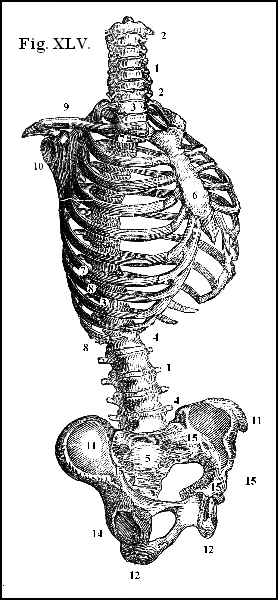
76. The separate bones of the series have a kind of turning motion on each other; hence each is called a vertebra, and the name of vertebral column is often given to the entire series, as well as [Pg 210] that of spinal column. That portion of the column which forms the neck consists of seven distinct bones, called cervical vertebræ (fig. XLV. 2); that portion which forms the back consists of twelve, called dorsal vertebræ (fig. XLV. 3); that portion which forms the loins consists of five, called lumbar vertebræ (fig. XLV. 4). Between each of these classes of vertebræ there are specific differences, but they need not be described here: all that is necessary to the present purpose is an account of the structure which is common to every vertebra.
77. By inspecting fig. XLVI. 1, it will be seen that the upper and under edges of each vertebra consist of a ring of bone, of a firm and compact texture, rendering what may be called the body of the vertebra exceedingly strong (fig. XLVI. 3). This ring of bone forms a superficial depression (fig. XLVI. 2), for the reception of a peculiar substance, immediately to be described, which is interposed between each vertebra (fig. XLVII. 2).
78. The anterior surface of the body of the vertebra is convex (fig. XLVI. 3); its posterior surface is concave (fig. XLVI. 4); from the posterior surface springs a bony arch (figs. XLVI. 5 and LIII. 1), which, together with the posterior concavity, forms an aperture of considerable magnitude (fig. XLVI. 6), a portion of the canal for the passage of the spinal cord (figs. XLVII. 3, and XLIX. 3).
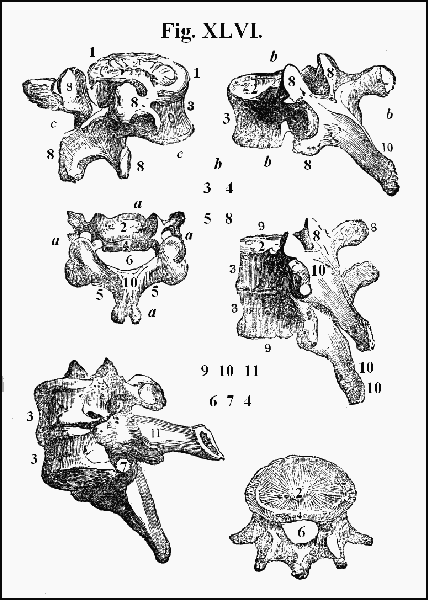
79. Both the upper and under edges of the arch form a notch (fig. XLVI. 7.), which, together with a corresponding notch in the contiguous vertebra, completes another aperture rounder and smaller than the former, but still of considerable size (fig. XLVI. 7.), the passage of the spinal nerves (fig. XLVII. 3).
80. From both the upper and under sides of the arch proceed two short but strong projections of bone (fig. XLVI. 8.), termed the articulating processes, because it is chiefly by these processes that the vertebræ are connected together. From the beginning to the end of the series, the two upper processes of the one vertebra are united with the two lower processes of the vertebra immediately above it (fig. XLVI. 9), and around the edges of all the articulating processes are visible rough lines, which mark the places to which the articulating ligaments are attached.
81. No vertebra, except the first, rests immediately upon its contiguous vertebra (fig. XLV. 2, 4). Each is separated from its fellow by a substance of a peculiar nature interposed between them, termed the intervertebral substance (figs. [Pg 213] XLVII. 2, and L. 2). This substance partakes partly of the nature of cartilage, and partly of that of ligament. It is composed of concentric plates, formed of oblique fibres which intersect each other in every direction. This substance, for about a quarter of an inch from its circumference towards its centre, is tough, strong, and unyielding; then it becomes softer, and is manifestly elastic; and so it continues until it approaches the centre, when it becomes pulpy, and is again inelastic. The exterior tough and unyielding matter is for the firmness of the connexion of the several vertebræ with each other; the interior softer and elastic matter is for the easy play of the vertebræ upon each other; the one for security, [Pg 214] the other for pliancy. And the adjustment of the one to the other is such as to combine these properties in a perfect, manner. The quantity of the unyielding substance is not so great as to produce rigidity; the quantity of the elastic substance is not so great as to occasion insecurity. The firm union of its solid matter renders the entire column strong; the aggregate elasticity of its softer substance renders it springy.
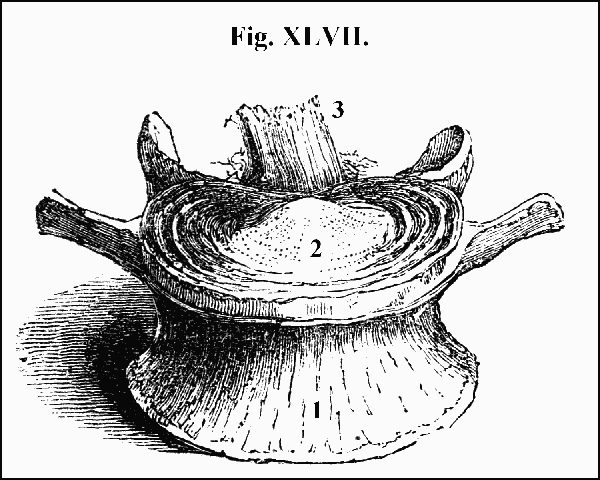
82. The column is not constructed in such a manner as to admit of an equal degree of motion in every part of it. Every thing is contrived to give to that portion which belongs to the neck freedom of motion, and, on the contrary, to render that portion which belongs to the back comparatively fixed. In the neck the mechanism of the articulating processes is such as to admit of an equal degree of sliding motion forwards, backwards, and from side to side, together with a turning motion of one bone upon another; at the same time, the intervertebral substance between the several vertebræ is thick. In consequence of this mechanism, we can touch the breast with the chin, the back with the hind head, and the shoulders with the ear, while we can make the head describe more than a semicircle. But, in the back, the articulating processes are so connected as to prevent the possibility of any motion, either forwards or backwards, or any turning of one vertebra upon another, while the intervertebral substance is comparatively [Pg 215] thin (fig. XLV. 2, 4). That portion of the column which belongs to the back is intended to afford a fixed support for the ribs, a support which is indispensable to their action in the function of respiration. In the loins, the articulating processes are so connected as to admit of a considerable degree of motion in the horizontal direction, and from side to side, and the intervertebral substance here progressively increases in thickness to the point at which the upper portion of the column is united to the sacrum (fig. XLV. 2, 4), where the degree of motion is extensive.
83. The canal for the spinal cord, formed partly by the concavity in the posterior surface of the vertebra, and partly by the arch that springs from it (fig. XLVI. 6.), is lined by a continuation of the dense and strong membrane that constitutes the internal periosteum of the cranium, the dura mater (fig. XLVIII. c), which, passing out of the opening in the occipital bone, called the foramen magnum (figs. XXXIX. 7, and XLIX. 3), affords a smooth covering to the canal throughout its whole extent.
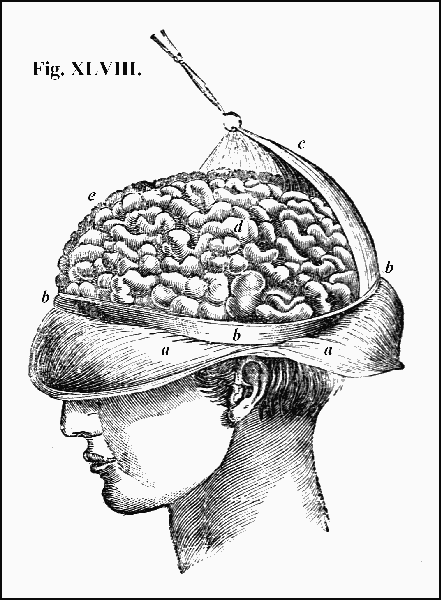
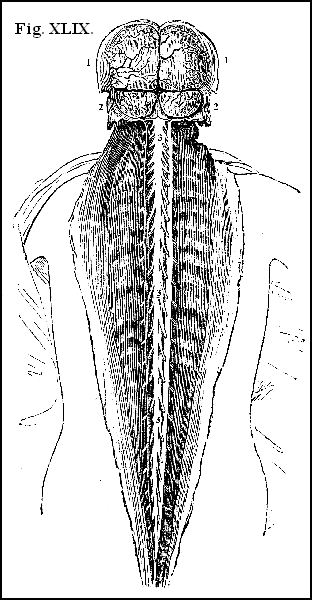
84. The spinal cord itself, continuous with the substance of the brain, passes also out of the cranium through the foramen magnum into the spinal canal (fig. XLIX. 3), enveloped in the delicate membranes that cover it, and surrounded by the aqueous fluid contained between those membranes. The size of the spinal canal, accurately adapted to that of the spinal cord, which it lodges and protects, is of considerable size, and of a triangular shape in its cervical portion (fig. XLIX. 3), smaller and rounded in its dorsal portion (fig. XLIX. 3), and again large and triangular in its lumbar portion (fig. XLIX. 3).
85. The spinal column performs several different, and apparently incompatible, offices.
First, it affords a support and buttress to other bones. It sustains the head (fig. XXXIV. 1); it is a buttress to the ribs (fig. XLVI. 7); through the sternum and ribs it is also a buttress to the superior, and through the pelvis, to the lower, extremities (fig. XXXIV. 2, 3, 4).
Secondly, it affords a support to powerful muscles, partly to those that maintain the trunk of the body in the erect posture against the force of gravitation, and partly to those that act upon the superior and inferior extremities in the varied, energetic, and sometimes long-continued movements they execute.
Thirdly, it forms one of the boundaries of the great cavities that contain the chief organs of the organic life. To the support and protection of those organs it is specially adapted; hence the surface in immediate contact with them is even and smooth; hence its different curvatures, convexities, and concavities, have all reference to their accommodation; hence in the neck it is convex (fig. XLV. 2), in order to afford a firm support to the esophagus, the wind-pipe, the aorta, and the great trunks of the venous system (fig. LX. 3, 4); in the back it is concave, in order to enlarge the space [Pg 219] for the dilatation of the lung in the act of inspiration (figs. XLV. 3, and LX. 5); in the loins it is convex, in order to sustain and fix the loose and floating viscera of the abdomen (figs. XLV. 4, and LX. 6, 7, 8, 9); in the pelvis it is concave, in order to enlarge the space for lodging the numerous delicate and highly-important organs contained in that cavity (fig. XLV. 5).
Fourthly, it forms the osseous walls of a canal (figs. XLVI. 6, and XLVII. 3) for the lodgment and protection of the soft and tender substance of the spinal cord, one of the great central masses of the nervous system, the seat of the animal life (fig. XLIX. 3).
Fifthly, it affords in its osseous walls secure apertures for the passage of the spinal nerves (figs. XLVI. 7, and XLIX. 3), by which impressions are transmitted from the organs to the spinal cord and brain, in the function of sensation; and from the spinal cord and brain to the organs in the function of volition.
86. For the due performance of these offices, it is indispensable that it should be firm, rigid, strong, and yet to a certain extent readily flexible in every direction. By what mechanism is it endowed with these apparently incompatible properties?
87. By means of the ring of compact bone, which forms so large a part of its body (fig. XLVI. 1) it is rendered firm, rigid, and strong. By means of its numerous separate pieces, exactly adjusted to [Pg 220] each other, and dove-tailed into one another, an increase of strength is gained, such as it would not have been possible to communicate to a single solid piece. By the same mechanism, some degree of flexibility is also obtained; each separate bone yielding to some extent, which, though slight in a single bone, becomes considerable in the twenty-four.
88. But the flexibility required is much greater than could be obtained by this expedient alone. A rigid and immoveable pile of bones, in the position of the spinal column, on which all the other parts of the body rest, and to which they are directly or indirectly attached, would necessarily have rendered all its movements stiff and mechanical; and every movement of every kind impossible, but in a given direction. That the movements of the body may be easy, free, and varied; that it may be possible to bring into play new and complex combinations of motion at any instant, with the rapidity of the changes of thought, at the command of the impulses of feeling, it is indispensable that the spinal column be flexible in every direction, forwards, backwards, and at the sides: it is equally indispensable that it be thus capable of yielding, without injuring the spinal cord; without injuring the spinal nerves; without injuring the thoracic and abdominal viscera; and without injuring the muscles of the trunk and extremities. The degree in which it possesses this power of flexibility, and the extent to which, by the cultivation [Pg 221] of it, it is sometimes actually brought, is exemplified in the positions and contortions of the posture-master and the tumbler. It is acquired by means of the intervertebral substance, the compressible and elastic matter interposed between the several vertebræ. So compressible is this substance, that the human body is half an inch shorter in the evening than in the morning, having lost by the exertions of the day so much of its stature; yet, so elastic is this matter, that the stature lost during the day is regained by the repose of the night. The weight of the body pressing in all directions upon the spinal column; muscles, bones, cartilages, ligaments, membranes, with all their vessels and all the fluids contained in them; the weight of all these component parts of the head, trunk, and extremities, pressing, without the cessation of an instant, during all the hours of vigilance, upon the intervertebral substance, compresses it; but this weight, being taken off during the night, by the recumbent posture of the body, the intervertebral substance, in consequence of its elasticity, regains its original bulk, and of course the spinal column its original length.
89. But the flexibility acquired through the combined properties of compressibility and elasticity is exceedingly increased by the action of the pulpy and inelastic matter in the centre of the intervertebral substance; this matter serving as a pivot to the vertebræ, facilitating their motion on each [Pg 222] other. Its effect has been compared to that of a bladder partly filled with water, placed between two trenchers; in this case, the approximation of the circumference of the two trenchers on one side, would instantly displace a portion of the water on that side, which would occupy the increasing space on the other, with the effect of facilitating the change, in every possible direction, of the position of the two trenchers in relation to each other. To this effect, however, it is indispensable that the matter immediately around this central pivot should be, not like itself, rigid and unyielding, but compressible and elastic. It is an interesting fact, that since this illustration was suggested, it has been discovered that this very arrangement is actually adopted in the animal body. In certain animals, in the very centre of their intervertebral substance, there has been actually found a bag of water, with a substance immediately surrounding the bag, so exceedingly elastic, that when the bag is cut, the fluid contained in it is projected to the height of several feet in a perpendicular stream.
90. But besides securing freedom and extent of motion, the intervertebral substance serves still another purpose, which well deserves attention.
Firmness and strength are indispensable to the fundamental offices performed by the column; and to endow it with these properties, we have seen that the external concentric layers of the intervertebral substance are exceedingly tough and that [Pg 223] they are attached to the bodies of the vertebræ, which are composed of dense and compact bone. But than dense and compact bone, nothing can be conceived better calculated to receive and transmit a shock or jar on the application of any degree of force to the column. Yet such force must necessarily be applied to it in every direction, from many points of the body, during almost every moment of the day; and did it actually produce a corresponding shock, the consequence would be fatal: the spinal cord and brain would be inevitably killed; for the death of these tender and delicate substances may be produced by a violent jar, although not a particle of the substances themselves be touched. A blow on the head may destroy life instantaneously, by what is termed concussion; that is, by the communication of a shock to the brain through the bones of the cranium. The brain is killed; but on careful examination of the cerebral substance after death, not the slightest morbid appearance can be detected: death is occasioned merely by the jar. A special provision is made against this evil, in the structure of the bones of the cranium, by the interposition between its two compact plates of the spongy substance called diploë (fig. XLIII. 2); and this is sufficient to prevent mischief in ordinary cases. A great degree of violence applied directly to the head is not common: when it occurs it is accidental: thousands of people pass through life [Pg 224] without ever having suffered from it on a single occasion: but every hour, in the ordinary movements of the body, and much more in the violent movements which it occasionally makes, a degree of force is applied to the spinal column, and through it transmitted to the head, such as, did it produce a proportionate shock, would inevitably and instantly destroy both spinal cord and brain. The evil is obviated partly by the elastic, and partly by the non elastic properties of the matter interposed between the several layers of compact bone. By means of the elastic property of this matter, the head rides upon the summit of the column as upon a pliant spring, while the canal of the spinal cord remains secure and uninvaded. By means of the soft and pulpy portion of this matter, the vibrations excited in the compact bone are absorbed point by point as they are produced: as many layers of this soft and pulpy substance, so many points of absorption of the tremors excited in the compact bone; so many barriers against the possibility of the transmission of a shock to the delicate nervous substance.
91. Alike admirable is the mechanism by which the separate pieces of the column are joined together. If but one of the bones were to slip off its corresponding bone, or to be displaced in any degree, incurable paralysis, followed ultimately by death, or instantaneous death, would happen; for pressure on the spinal cord in a certain part of [Pg 225] its course is incompatible with the power of voluntary motion, and with the continuance of life for any protracted term; and in another part of its course, with the maintenance of life beyond a few moments. To prevent such consequences, so great is the strength, so perfect the attachment, so unconquerable the resistance of that portion of the intervertebral substance which surrounds the edge of the bodies of the vertebræ, that it will allow the bone itself to give way rather than yield. Yet such is the importance of security to this portion of the frame, that it is not trusted to one expedient alone, adequate as that might seem. Besides the intervertebral substance, there is another distinct provision for the articulation of the bodies of the vertebræ. Commencing at the second cervical vertebra, in its [Pg 226] fore part, and extending the whole length of the column to the sacrum, is a powerful ligament, composed of numerous distinct longitudinal fibres (fig. L.), which are particularly expanded over the intervals between the bones occupied by the intervertebral substance (figs. L. 1, and LI. 2, 2). This ligament is termed the common anterior vertebral, beneath which, if it be raised from the intervertebral substance, may be seen small decussating fibres, passing from the lower edge of the vertebra above, to the upper edge of the vertebra below (fig. L. 3), from which circumstance these fibres are termed crucial.
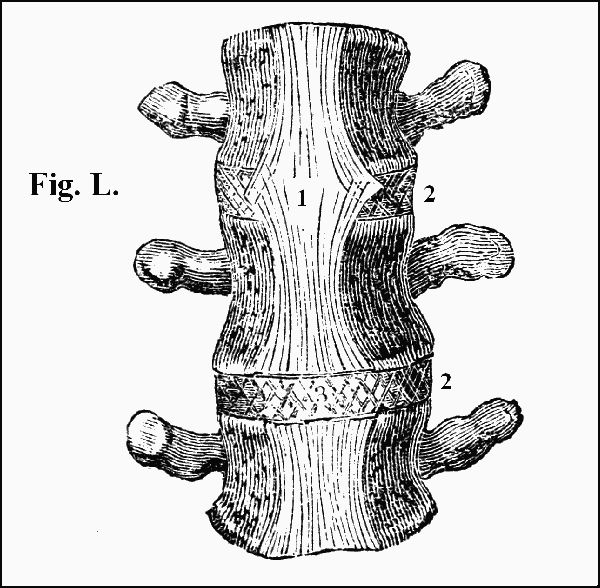
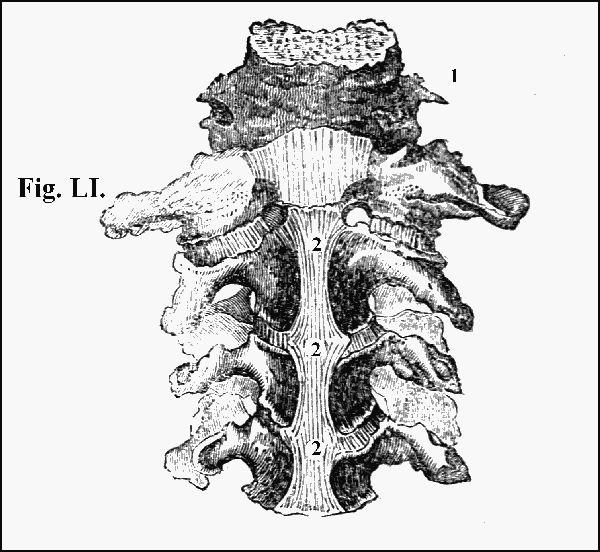
92. Corresponding with the ligament on the [Pg 227] anterior, is another on the posterior part of the spine (fig. LII. 1), which takes its origin from the foramen magnum (fig. LII. 1); descends from thence, within the vertebral canal, on the posterior surface of the bodies of the vertebra (fig. LII. 1), and extends to the sacrum. This ligament is termed the common posterior vertebral, which, besides adding to the strength of the union of the bodies of the vertebræ, prevents the column itself from being bent too much forward.
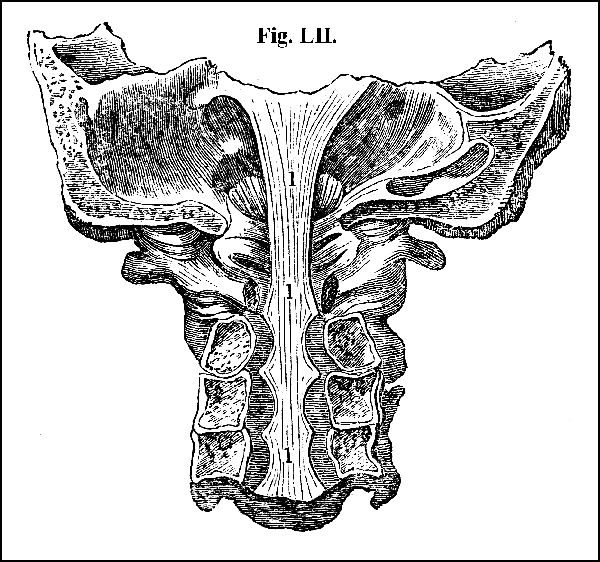
93. Moreover, the bony arches of the vertebræ (fig. LIII. 1) are connected by means of a substance [Pg 228] partly ligamentous, and partly cartilaginous (fig. LIII. 2), which, while it is extremely elastic, is capable of resisting an extraordinary degree of force.
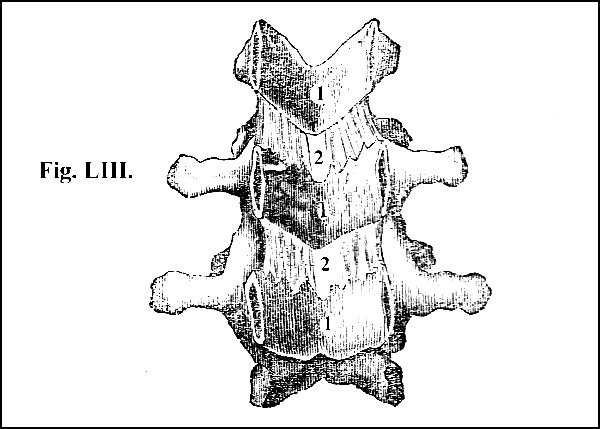
94. And in the last place, the articular processes form so many distinct joints, each being furnished with all the apparatus of a moveable joint, and thus possessing the ordinary provision for the articulation of bones, in addition to the whole of the foregoing securities.
95. "In the most extensive motion of which the spinal column is capable, that of flexion, the common anterior ligament is relaxed; the fore part of the intervertebral substance is compressed, and its back part stretched; while the common posterior ligament is in a state of extension. In the extension [Pg 229] of the column the state of the ligaments is reversed; those which were extended being in their turn relaxed, while the common anterior vertebral is now put upon the stretch. In the lateral inclination of the column, the intervertebral substance is compressed on that side to which the body is bent. In the rotatory motion of the column, which is very limited in all the vertebræ, but more particularly in the dorsal, in consequence of their attachment to the ribs, the intervertebral substance is contorted, as are likewise all the ligaments. All the motions of the column are capable of being aided to a great extent by the motion of the pelvis upon the thighs."
96. "The number and breadth of the attachments of these bones," says an accomplished anatomist and surgeon,[4] "their firm union by ligament, the strength of their muscles, the very inconsiderable degree of motion which exists between any two of them, and lastly, the obliquity of their articular processes, especially in the dorsal and lumbar vertebræ, render dislocation of them, at least in those regions, impossible without fracture; and I much doubt whether dislocation even of the cervical vertebræ ever occurs without fracture, either through their bodies or their articular processes. The effects of each of these accidents would produce precisely the same injury to the [Pg 230] spinal marrow, and symptoms of greater or less importance, according to the part of the spinal column that is injured. Death is the immediate consequence if the injury be above the third cervical vertebra, the necessary paralysis of the parts to which the phrenic and intercostal nerves are distributed causing respiration instantly to cease. If the injury be sustained below the fourth cervical vertebra, the diaphragm is still capable of action, and dissolution is protracted. The symptoms, in fact, are less violent in proportion as the injury to the spinal marrow is further removed from the brain; but death is the inevitable consequence, and that in every case at no very distant period."
97. So the object of the construction of the spinal column being to combine extent and freedom of motion with strength, and it being necessary to the accomplishment of this object to build up the column of separate pieces of bone, the connecting substances by which the different bones are united are constituted and disposed in such a manner as to prove absolutely stronger than the bones themselves. Such is the structure of this important portion of the human body considered as a piece of mere mechanism; but our conception of its beauty and perfection would be most inadequate if we did not bear in mind, that while the spinal column performs offices so varied and apparently so incompatible, it forms an integrant portion of a living machine: it is itself alive: every instant, [Pg 231] blood-vessels, absorbents and nerves, are nourishing, removing, renewing, and animating every part and particle of it.
98. The anterior boundary of the thorax is formed by the bone called the sternum, or the breast-bone, which is broad and thick at its upper, and thin and elongated at its lower extremity (figs. XLV. 6, and LIV.), where it gives attachment to a cartilaginous appendix, which being pointed and somewhat like a broadsword, is called the ensiform cartilage.
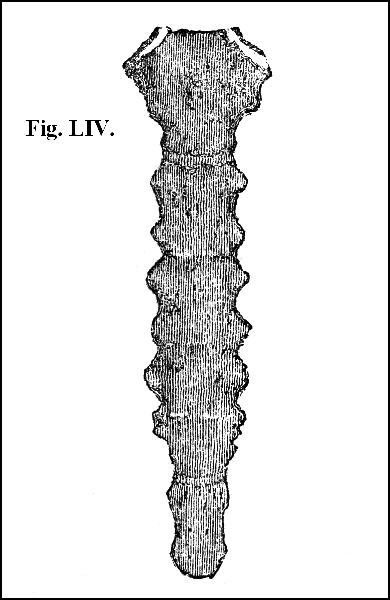
99. Its position is oblique, being near the vertebral column at the top, and distant from it at the bottom (fig. XLV. 6). Its margins are thick, and marked by seven depressions, for the reception of the cartilages of the seven true ribs (fig. LIV). Its anterior surface is immediately subjacent to the skin, and gives attachment to powerful muscles, which act on the superior extremities: its posterior surface is slightly hollowed in order to enlarge the cavity of the thorax (fig. LV.).
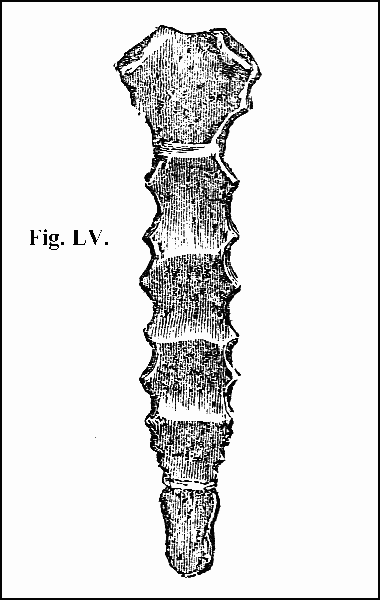
100. The thorax is bounded at the sides by the ribs, which extend like so many arches between [Pg 233] the spinal column and the sternum (fig. XLV. 7, 8). They are in number twenty-four, twelve on each side, of which the seven upper are united to the sternum by cartilage, and are called true ribs (fig. XLV. 7); the cartilages of the remaining five are united with each other and are not attached to the sternum; these are called false ribs (fig. XLV. 8): all of them are connected behind to the spinal column (fig. XXXV.).
101. The ribs successively and considerably increase in length as far as the seventh, by which the cavity they encompass is enlarged; from the seventh they successively diminish in length, and the capacity of the corresponding part of the cavity is lessened. The direction of the ribs from above downwards is oblique (fig. XLV. 7, 8). Their external or anterior surface is convex (fig. XLV. 7, 8); their internal or posterior surface is concave: by the first their strength is increased; by the second the general cavity of the thorax is enlarged (fig. XLV. 7, 8). Their upper margin is smooth and rounded, and gives attachment to a double layer of muscles, called the intercostal, placed in the intervals that separate the ribs from each other (fig. LIX.). Along the lower margin is excavated a deep groove, for the lodgment and protection of the intercostal vessels.
102. The ribs are connected with the spinal column chiefly by what is termed the anterior ligament (fig. LVI. 1), which is attached to the [Pg 234] head of the rib (fig. LVI.), and which, dividing into three portions (fig. LVI. 1), firmly unites every rib to two of the vertebræ, and to the intervertebral substance (fig. LVI. 1). This articulation is fortified by a second ligament (fig. LVI. 2), also attached to a head of the rib, termed the interarticular (fig. LVI. 2), and by three others, one of which is attached on the fore part, and the two others in the back part, to the neck of the rib (fig. LVII. 1).
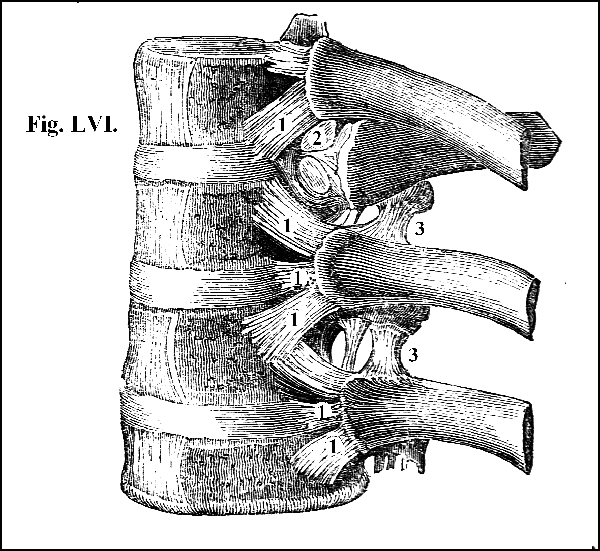
The cartilages of the seven superior ribs are attached to the sternum by a double layer of ligamentous [Pg 235] fibres, termed the anterior and the posterior ligaments of the sternum (fig. LVIII.). So strong are the bands which thus attach the ribs to the spinal column and the sternum, that the ribs cannot be dislocated without fracture. "Such at least is the case in experiments upon the dead body, where, though the rib be subjected to the application of force by means of an instrument best calculated to detach its head from the articulation, yet it is always broken."

While thus firmly attached to their points of support, the ligaments, which fix them, are so disposed as to render the ribs capable of being readily moved upwards and downwards: upwards in inspiration; downwards in expiration; and it is by this alternate action that they enlarge and diminish the cavity of the thorax in the function of respiration.
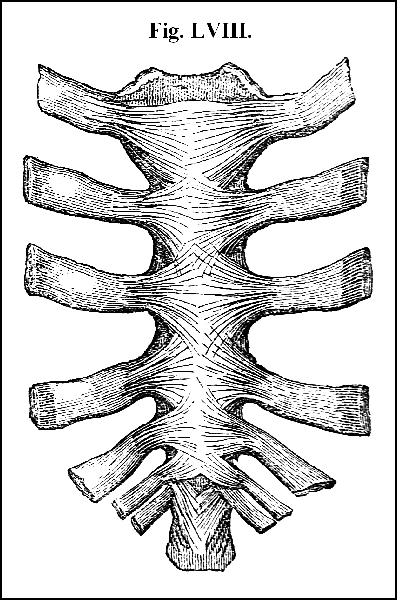
103. Such are the boundaries of the cavity of the thorax as far as its walls are solid. The interspaces between these solid portions at the sides are [Pg 237] filled up by muscles, principally by those termed the intercostal (fig. LIX.); below, the boundary is formed by the diaphragm (fig. LXI. 2); while above, as has been already stated (69), the cavity is so contracted as only to leave an opening for the passage of certain parts to and from the chest.
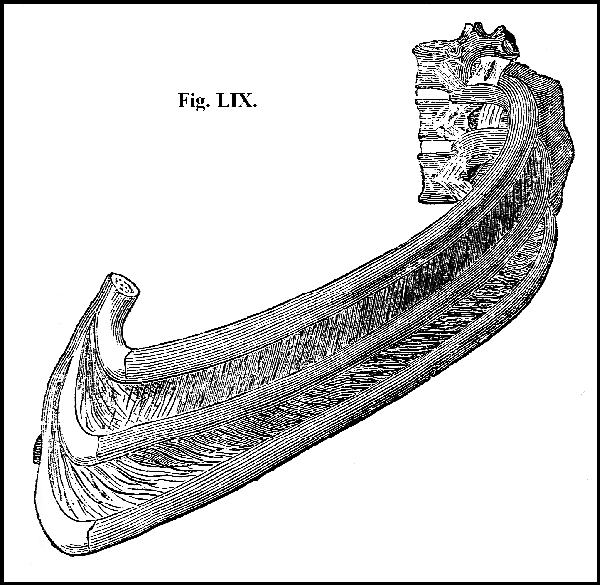
104. The inner surface of the walls of the thorax, in its whole extent, is lined by a serous membrane, exceedingly thin and delicate, but still firm, called the pleura. The same membrane is reflected over [Pg 238] the organs of respiration contained in the cavity, so as to give them an external coat. The membrane itself is every where continuous, and every where the same, whether it line the containing or the contained parts; but it receives a different name as it covers the one or the other: that portion of it which lines the walls of the cavity being called the costal pleura (fig. LXI. a), while that which covers the organs contained in the cavity is termed the pulmonary pleura (fig. LX. 5, 1).
105. A fold of each pleura passes directly across the central part of the cavity of the thorax; extending from the spinal column to the sternum, and dividing the general cavity into two. This portion of the pleura is called the mediastinum, from its situation in the centre of the thorax, and it so completely divides the thoracic cavity into two, that the organs on one side of the chest have no communication with those of the other; so that there may be extensive disease in one cavity (for example, a large accumulation of water,) while the other may be perfectly sound.
106. The main organs contained in the cavity of the thorax are the lungs with their air tube; the heart with its great vessels; and the tube passing from the mouth to the stomach (fig. LX.).
107. The two lungs occupy the sides of the chest (fig. LX. 5). They are completely separated from each other by the membranous partition just described, the mediastinum. Between the two [Pg 239] folds of the mediastinum, namely, in the middle of the chest, but inclining somewhat to the left side, is placed the heart, enveloped in another serous membrane, the pericardium (fig. LX. 2, 1).
108. The lungs are moulded to the cavities they fill; whence their figure is conical, the base of the cone being downwards, resting on the diaphragm (fig. LX. 5, b); and the apex upwards, towards the neck (fig. LX. 5).
109. That surface of each lung which corresponds to the walls of the chest is convex in its whole extent (fig. LX. 5); on the contrary, that surface which corresponds to the mediastinum is flattened (fig. LX. 5). The basis of the lung is concave, adapted to the convexity of the diaphragm on which it rests (fig. LX. 5).
110. The air-vessel of the lungs, termed the bronchus, together with the blood-vessels and nerves, enter the organ at its flattened side, not exactly in the middle, but rather towards the upper and back part. This portion is termed the root of the lung.
111. The lungs are attached to the neck by the trachea (fig. LX. 4), the continuation of which forms the bronchus; to the spinal column by the pleura, and to the heart by the pulmonary vessels (fig. LX. 3, d): their remaining portion is free and unattached.
112. In the living body, the lungs on each side completely fill the cavity of the chest, following passively the movements of its walls, and accurately adapting themselves to its size, whether its capacity enlarge in inspiration, or diminish in expiration, so that the external surface of the lung (the pulmonary pleura) is always in immediate contact with the lining membrane of the walls of the cavity (the costal pleura); consequently, during life, there is no cavity, the chest being always completely full.
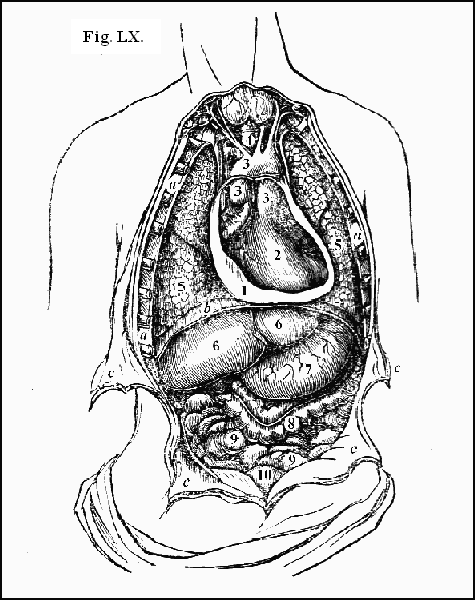
113. The anterior surface of the pericardium, the bag which envelopes the heart, lies immediately behind the sternum, and the cartilages of the second, third, fourth, and fifth ribs, covered at its sides by the pleura, and firmly attached below to the diaphragm (fig. LX. 1).
114. Surrounded by its pericardium, within the mediastinum, the heart is placed nearly in the centre of the chest, but its direction is somewhat oblique, its apex being directly opposite to the interval between the fifth and sixth ribs on the left side (fig. LX. 2); while its basis is directed upwards, backwards, and towards the right (fig. LX. 2). That portion of its surface which is presented to view on opening the pericardium is convex (fig. LX. 2); but its opposite surface, namely, that which rests upon the part of the pericardium which is attached to the diaphragm, is flattened (fig. LX. 1). It is fixed in its situation partly by the pericardium and partly by the great vessels that go to and from it. But under the different states of expiration and inspiration, it [Pg 242] accompanies, in some degree, the movements of the diaphragm; and in the varied postures of the body, the heart deviates to a certain extent from the exact position here described.
115. The second division of the trunk, the abdomen, is bounded above by the diaphragm (fig. LXI. 2), below by the pelvis (fig. LXI. 3), behind and at the sides by the vertebræ and muscles of the loins (fig. LXIII.), and before by the abdominal muscles (fig. LXIII. 9).
116. The organ which forms the superior boundary of the abdomen, the diaphragm (midriff), is a circular muscle, placed transversely across the trunk, nearly at its centre (fig. LXI. 2). It forms a vaulted partition between the thorax and the abdomen (fig. LXI. 2). All around its border it is fleshy (fig. LXI. 2); towards its centre it is tendinous (fig. LXI. 2); the surface towards the abdomen is concave (fig. LXI. 2); that towards the thorax convex (fig. LXI. 2); while its middle tendinous portion ascends into the thorax as high as the fourth rib (fig. LXI. 2).
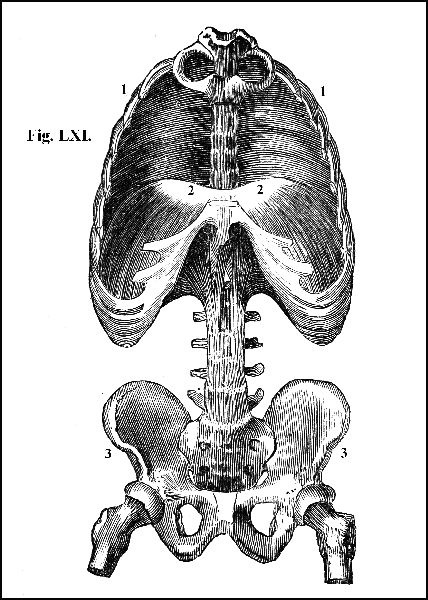
117. The diaphragm is perforated by several apertures, for the transmission of tubes and vessels, which pass reciprocally between the thorax and abdomen (fig. LXII.).
1. A separate aperture is formed to afford an exit from the thorax of the aorta, the common source of the arteries (fig. LXII. 2), and an entrance into the thorax of the thoracic duct, the tube that bears the digested aliment to the heart. 2. A little to the left of the former, there is another aperture, through which passes the esophagus or gullet (fig. LXII. 3), the tube that conveys the food from the mouth to the stomach. 3. On the right side, in the tendinous portion of the diaphragm, very carefully constructed, is a third aperture for the passage of the vena cava (fig. LXII. 4), the great vessel that returns the blood to the heart from the lower parts of the body.
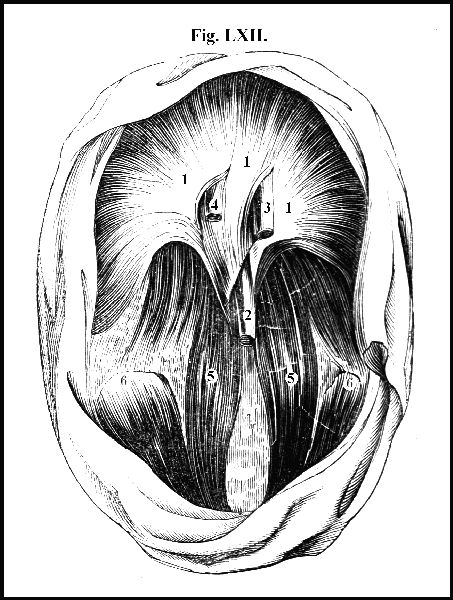
118. The partition formed by the diaphragm between the thorax and abdomen, though complete, is moveable; for as the diaphragm descends in inspiration and ascends in expiration, it proportionally enlarges or diminishes the cavities between which it is placed; consequently, the actual magnitude of these cavities varies every moment, and the size of the one is always in the inverse ratio of that of the other.
119. Between the abdomen and the pelvis there is no separation; one cavity is directly continuous with the other (fig. LXI. 3); but along the inner surface of the expanded bones, which form a part of the lateral boundary of the abdomen, there is a prominent line, termed the brim of the pelvis (fig. XLV. 15), marking the point at which the abdomen is supposed to terminate and the pelvis to commence.
120. Behind and at the sides the walls of the abdomen are completed partly by the lumbar portion of the spinal column and partly by the lumbar muscles (fig. XLV. 4), and before by the abdominal muscles (fig. LXIII. 9).
121. The inner surface of the walls of the abdomen is lined throughout by a serous membrane, termed the peritoneum (fig. LXIII.). From the [Pg 246] walls of the abdomen, the peritoneum is reflected upon the organs contained in the cavity, and is continued over them so as to form their external coat. The peritoneum also descends between the several organs, connecting them together, and holding them firmly in their situation; and it likewise forms numerous folds, in which are embedded the vessels and nerves that supply the organs. It secretes a serous fluid, by which its own surface and that of the organs it covers is rendered moist, polished, and glistening, and by means of which the organs glide smoothly over it, and over one another in the various movements of the body, and are in constant contact without growing together. In structure, distribution, and function, the peritoneum is thus perfectly analogous to the pleura.
122. Like the thorax, the abdomen is always completely full. When the diaphragm is in action, it contracts. When the diaphragm is in the state of contraction, the abdominal and lumbar muscles are in the state of relaxation. By the contraction of the diaphragm, the organs contained in the abdomen are pushed downwards, and the anterior and lateral walls of the cavity being at this moment in a state of relaxation, they readily yield, and, consequently, the viscera are protruded forwards and at the sides. But the abdominal and lumbar muscles in their turn contract, the diaphragm relaxing; and, consequently, the viscera, [Pg 247] forced from the front and sides of the abdomen, are pushed upwards, together with the diaphragm, into the cavity of the thorax. A firm and uniform pressure is thus at all times maintained upon the whole contents of the abdomen: there is an exact adaptation of the containing to the contained parts, and of one organ to another. No space intervenes either between the walls of the abdomen and the organs they enclose, or between one organ and another: so that the term cavity does not denote a void or empty space, but merely the extent of the boundary within which the viscera are contained.
123. The contents of the abdomen consist of the organs which belong to the apparatus of digestion, and of those which belong to the apparatus of excretion.
124. The organs which belong to the apparatus of digestion are—1. The stomach (fig. LXIII. 2) 2. The duodenum (fig. LXIII. 4). 3. The jejunum (fig. LXIII. 5). 4. The ilium (fig. LXIII. 5). The three last organs are called the small intestines, and their office is partly to carry on the digestion of the aliment commenced in the stomach, and partly to afford an extended surface for the absorption of the nutriment as it is prepared from the aliment. 5. The pancreas (fig. LXIV. 5). 6. The liver (fig. LXIV. 2). 7. The spleen (fig. LXIV. 4). The three last organs truly belong to the apparatus of digestion, and their office is to co-operate with the stomach and the small intestines in the conversion of the aliment into nutriment.
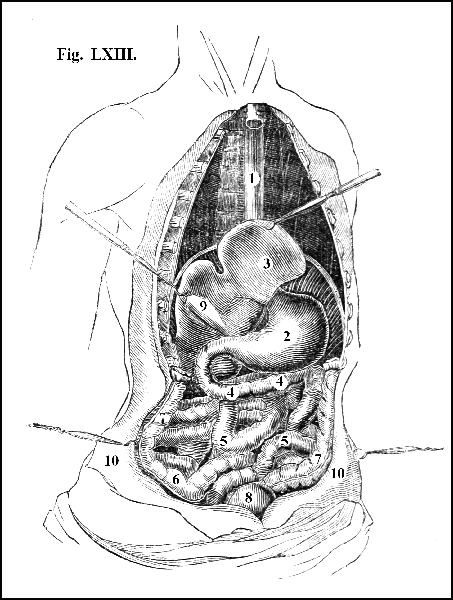
125. The organs which belong to the apparatus of excretion are—1. The large intestines consisting [Pg 249] of the cæcum (fig. LXIII. 6). 2. The colon (fig. LXIII. 7). 3. The rectum (fig. LXIV. 10). It is the office of these organs, which are called the large intestines, to carry out of the system that portion of the alimentary mass which is not converted into nourishment. 4. The kidneys (fig. LXIV. 6), the organs which separate in the form of the urine an excrementitious matter from the blood, in order that it may be conveyed out of the system.
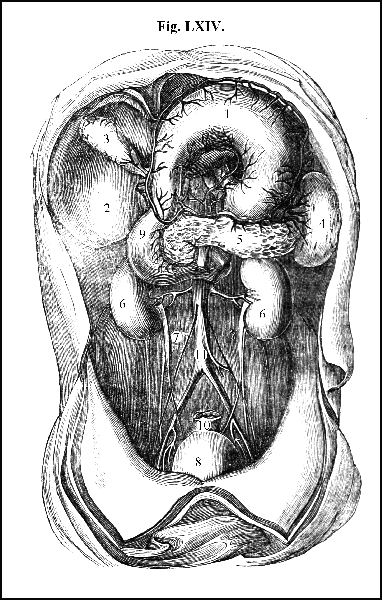
126. The last division of the trunk, called the pelvis (fig. LXI. 3), consists of a circle of large and firm bones, interposed between the lower portion of the trunk and the inferior extremities (fig. XLV.). The bones that compose the circle, distinct in the child, are firmly united in the adult into a single piece; but as the original separation between each remains manifest, they are always described as separate bones. They are the sacrum (fig. XLV. 5), the coccyx (fig. XXXV.), the ilium (fig. XLV. 11), the ischium (fig. XLV. 12), and the pubis (fig. XLV. 13).
127. The sacrum, placed like a wedge between the moveable portion of the spinal column and the lower extremities, forms the posterior boundary of the pelvis. The figure of this bone is triangular (fig. XLV. 5); its anterior surface is concave and smooth, for enlarging the cavity of the pelvis and sustaining the organs contained in it (fig. XLV. 5); its posterior surface is convex, [Pg 251] irregular, and rough (fig. XXXV.), giving origin to the great muscles that form the contour of the hip, and to the strong muscles of the back and loins that raise the spine and maintain the trunk of the body erect.
128. The base or upper part of the sacrum receives the last vertebra of the loins on a large and broad surface (fig. XLV. 4), forming a moveable joint; and the degree of motion at this point is greater than it is at the higher points of the spinal column. Firmly united at its sides with the haunch bones, it admits there of no degree of motion.
129. The coccyx, so named from its resemblance to the beak of the cuckoo, when elongated by a succession of additional bones, forms the tail in quadrupeds; but in man it is turned inwards to support the parts contained in the pelvis, and to contract the lower opening of the cavity. By means of a layer of cartilage, the medium by which this bone is connected with the sacrum, it forms a moveable articulation, continuing moveable in men until the age of twenty-five, and in women until the age of forty-five; continuing moveable in women thus long, in order that by yielding to the force which tends to push it backwards during the period of labour, it may enlarge the lower aperture of the pelvis, and so facilitate the process of parturition and diminish its suffering.
130. The lateral boundaries of the pelvis are [Pg 252] formed by the ilium, the haunch bone (fig. XLV. 11), and by the ischium, the hip bone (fig. XLV. 12). The ilium forms the lower part of the abdomen and the upper part of the pelvis (fig. XLV. 11); its broad expanded wing supports the contents of the abdomen, and gives attachment to the muscles that form the anterior portion of its walls (figs. XLV. 11, and LXIII. 9); its external convex surface sustains the powerful muscles that extend the thigh; and along its internal surface is the prominent line which marks the brim of the pelvis (fig. XLV. 15), and which divides this cavity from that of the abdomen.
131. The ischium or hip bone is the lower part of the pelvis (fig. XLV. 12); at its undermost portion is a rounded prominence called the tuberosity (fig. XLV. 12), in its natural condition covered with cartilage, upon which is superimposed a cushion of fat. It is this part on which the body is supported in a sitting posture.
132. The pubis or share bone forms the upper and fore part of the pelvis (fig. XLV. 13), and together with the two former bones, completes the large and deep socket, termed the acetabulum (fig. XLV. 14), into which is received the head of the thigh-bone (fig. XXXIV. 4). The margin of the acetabulum and the greater part of its internal surface is lined with cartilage, so that in its natural condition it is much deeper than it appears to be when the bones alone remain.
133. The lower aperture of the pelvis, which appears large when all the soft parts are removed, is not really large, for in its natural state it is filled up partly by muscles and partly by ligaments, which sustain and protect the pelvic organs, leaving only just space enough for the passage to and from those which have their opening on the external surface.
134. The cavity of the pelvis, together with all the organs contained in it, are lined by a continuation of the membrane that invests the abdomen and its contents.
135. The organs contained in the pelvis are the rectum (fig. LXIV. 9), which is merely the termination of the large intestines, the urinary bladder (fig. LXIV. 8), and the internal part of the apparatus of reproduction.
136. The large and strong bones of the pelvis not only afford lodgment and protection to the tender organs contained in its cavity, but sustain the entire weight of the body, the trunk resting on the sacrum as on a solid basis (fig. XLV. 5), and the lower extremities being supported in the sockets in which the heads of the thigh-bones play, in the varied movements of locomotion (fig. XXXIV. 4).
137. The last division of the body comprehends the superior and the inferior extremities.
138. The superior extremities consist of the shoulder, arm, fore-arm, and hand.
139. The soft parts of the SHOULDER are composed chiefly of muscles; its bones are two, the scapula or the blade bone, and the clavicle or the collar bone (fig. LXV. 2, 4).
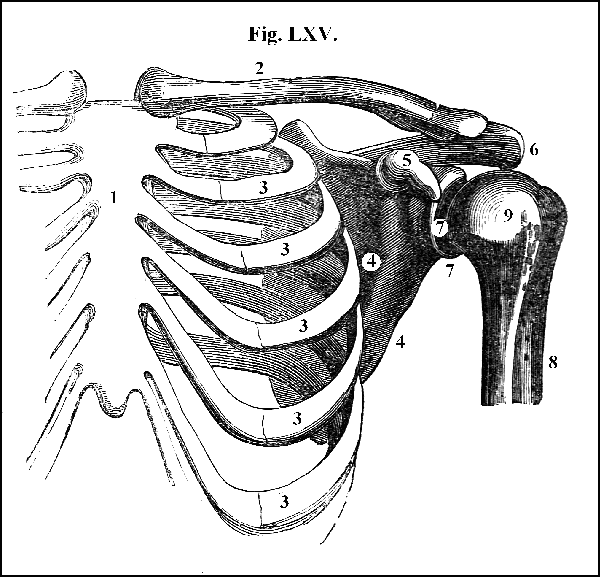
140. The SCAPULA is placed upon the upper and back part of the thorax, and occupies the space from the second to the seventh ribs (fig. LXV. 4)
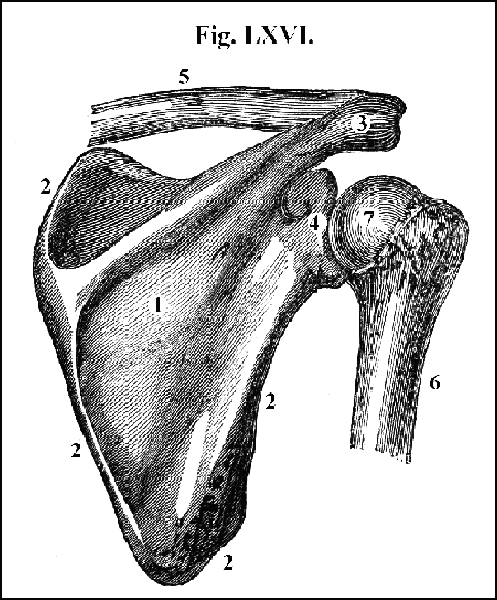
Unlike that of any other bone of the body, it is embedded in muscles, without being attached to any bone of the trunk, excepting at a single point. From the bones of the thorax it is separated by a double layer of muscles, on which it is placed as upon a cushion, and over the smooth surface of which it glides. Originally, like the bones of the skull, it consisted of two tables of compact bone, with an intermediate layer of spongy bony substance (diploë); but, by the pressure of the muscles that act upon it, it gradually grows thinner and thinner, until, as age advances, it becomes [Pg 256] in some parts quite transparent and as thin as a sheet of paper.
141. The figure of the scapula is that of an irregular triangle (fig. LXVI.). Its anterior surface is concave (fig. LXV. 4), corresponding to the convexity of the ribs (fig. XLV. 7); its posterior surface is very irregular (fig. LXVI. 1), being in some parts concave and in others convex, giving origin especially to two large processes (figs. LXV. 5, and LXVI. 3); one of which is termed the acromion (fig. LXVI. 3), and the other the coracoid process of the scapula (fig. LXV. 5). The margins of the bone, whatever the thinness of some portions of it, are always comparatively thick and strong (fig. LXVI. 2), affording points of origin or of insertion to powerful muscles. At what is called the anterior angle of the bone there is a shallow oval depression covered with cartilage and deepened by a cartilaginous margin, called the glenoid cavity of the scapula (figs. LXV. 7, and LXVI. 4), which receives the head of the humerus or bone of the arm (figs. LXV. 9, and LXVI. 7, 6).
142. The clavicle, the second bone of the shoulder,
is a long and slender bone, of the form of an italic
![]() ,
projecting a little forwards towards its
middle, so as to give a slight convexity of outline
to the top of the chest and the bottom of the neck
(fig. LXV. 2). It is attached by one extremity
to the sternum (fig. LXV. 2) and by the other to
[Pg 257]
the scapula (fig. LXV. 2), by moveable joints.
The nature of an immoveable joint has been explained
(63). In the connexion of the bones
of the trunk, while the main object is to secure
firmness of attachment, some degree of motion is
at the same time obtained (81 et seq.): but the
mode in which the several bones of the extremities
are connected with each other and with the trunk,
admits of so great a degree of motion, that these
articulations are pre-eminently entitled to the name
of moveable joints. The component parts of all
moveable joints are bone, cartilage, synovial membrane,
and ligament. The great character of a
moveable joint is the approximation of two or more
bones; yet these bony surfaces are never in actual
contact, but are invariably separated from each
other by cartilage. The cartilage either covers the
entire extent of the articulating surface of the
bones, as in the shoulder-joint, where both the head
of the humerus and the cavity of the scapula that
receives it are enveloped in this substance (fig.
LXV. 7. 9), or a portion of it is placed between
the articulating surfaces of the bones, as in the
joint between the clavicle and sternum (fig. LXVII.
a); which, when so placed, is termed an interarticular
cartilage (fig. LXVII. a). By its
smooth surface cartilage lessens friction; while by
its elasticity it facilitates motion and prevents concussion.
Slightly organized cartilage is provided
with comparatively few blood-vessels and nerves.
[Pg 258]
Had it been vascular and sensible like the skin
and the muscle, the force applied in the movements
of the joint would have stimulated the blood-vessels
to inordinate action, and the sensibility of the
nerves would have been the source of constant
pain: every motion of every joint would have been
productive of suffering, and have laid the foundation
of disease. The facility and ease of motion
obtained by the smoothness, elasticity, and comparative
insensibility of cartilage are still further
promoted by the fluid which lubricates it, termed
synovia, secreted by a membrane called synovial,
which lines the internal surface of the joint, and
which bears a close resemblance to the serous
(30). Synovia is a viscid fluid of the consistence
of albumen (5). It is to the joint what
oil is to the wheel, preventing abrasion and facilitating
motion; but it is formed by the joint
itself, at the moment when needed, and in the
quantity required. The motion of the joint stimulates
the synovial membrane to secretion, and
hence the greater the degree of motion, the larger
the quantity of lubricating fluid that is supplied.
The several parts of the apparatus of moveable
joints are retained in their proper position by ligamentous
substance, which, as has been shown (96
and 97), is oftentimes so strong that it is easier
to fracture the bone than to tear the ligament, and
in every case the kind and extent of motion possessed
by the joint are dependent mainly on the
[Pg 259]
form of the articulatory surfaces of the bones and
on the disposition of the ligaments.
,
projecting a little forwards towards its
middle, so as to give a slight convexity of outline
to the top of the chest and the bottom of the neck
(fig. LXV. 2). It is attached by one extremity
to the sternum (fig. LXV. 2) and by the other to
[Pg 257]
the scapula (fig. LXV. 2), by moveable joints.
The nature of an immoveable joint has been explained
(63). In the connexion of the bones
of the trunk, while the main object is to secure
firmness of attachment, some degree of motion is
at the same time obtained (81 et seq.): but the
mode in which the several bones of the extremities
are connected with each other and with the trunk,
admits of so great a degree of motion, that these
articulations are pre-eminently entitled to the name
of moveable joints. The component parts of all
moveable joints are bone, cartilage, synovial membrane,
and ligament. The great character of a
moveable joint is the approximation of two or more
bones; yet these bony surfaces are never in actual
contact, but are invariably separated from each
other by cartilage. The cartilage either covers the
entire extent of the articulating surface of the
bones, as in the shoulder-joint, where both the head
of the humerus and the cavity of the scapula that
receives it are enveloped in this substance (fig.
LXV. 7. 9), or a portion of it is placed between
the articulating surfaces of the bones, as in the
joint between the clavicle and sternum (fig. LXVII.
a); which, when so placed, is termed an interarticular
cartilage (fig. LXVII. a). By its
smooth surface cartilage lessens friction; while by
its elasticity it facilitates motion and prevents concussion.
Slightly organized cartilage is provided
with comparatively few blood-vessels and nerves.
[Pg 258]
Had it been vascular and sensible like the skin
and the muscle, the force applied in the movements
of the joint would have stimulated the blood-vessels
to inordinate action, and the sensibility of the
nerves would have been the source of constant
pain: every motion of every joint would have been
productive of suffering, and have laid the foundation
of disease. The facility and ease of motion
obtained by the smoothness, elasticity, and comparative
insensibility of cartilage are still further
promoted by the fluid which lubricates it, termed
synovia, secreted by a membrane called synovial,
which lines the internal surface of the joint, and
which bears a close resemblance to the serous
(30). Synovia is a viscid fluid of the consistence
of albumen (5). It is to the joint what
oil is to the wheel, preventing abrasion and facilitating
motion; but it is formed by the joint
itself, at the moment when needed, and in the
quantity required. The motion of the joint stimulates
the synovial membrane to secretion, and
hence the greater the degree of motion, the larger
the quantity of lubricating fluid that is supplied.
The several parts of the apparatus of moveable
joints are retained in their proper position by ligamentous
substance, which, as has been shown (96
and 97), is oftentimes so strong that it is easier
to fracture the bone than to tear the ligament, and
in every case the kind and extent of motion possessed
by the joint are dependent mainly on the
[Pg 259]
form of the articulatory surfaces of the bones and
on the disposition of the ligaments.
143. In the joint formed by the clavicle and the sternum (fig. LXVII. a) an interarticular cartilage is placed between the two bones which are united, first by a strong fibrous ligament, which envelops them as in a capsule (fig. LXVII. 1); by a second ligament, which extends from the cartilage of the first rib to the clavicle (fig. LXVII. 4), by which the attachment of the clavicle to the sternum is materially strengthened; and by a third ligament which passes transversely from the head of one clavicle to that of the other (fig. LXVII. 3). The joint thus formed, though so strong and firm that the dislocation of it is exceedingly [Pg 260] rare, yet admits of some degree of motion in every direction, upwards, downwards, forwards, and backwards; and this articulation is the sole point by which the scapula is connected with the trunk, and consequently by which the upper extremity can act, or be acted upon, by the rest of the body.
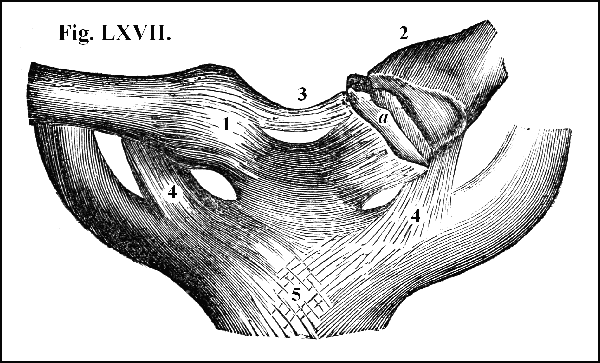
144. The scapular extremity of the clavicle (fig. LXVIII. 6) is attached to the processes of the scapula (fig. LXVIII. 4. 3) by several ligaments of great strength (fig. LXVIII. 7, 8, 9). First by very strong fasciculi which pass from the upper surface of the clavicle to the acromion of the scapula (fig. LXVIII. 6); and secondly by two ligaments [Pg 261] which unite the clavicle with the coracoid process of the scapula (fig. LXVIII. 8, 9). These ligaments are so powerful that they resist a force capable of fracturing the clavicle; and they need to be thus strong, for the clavicle is a shaft which sustains the scapula, and through the scapula the whole of the upper extremity; and the main object of the joint by which these bones are united, is to afford a firm attachment of the scapula to its point of support.
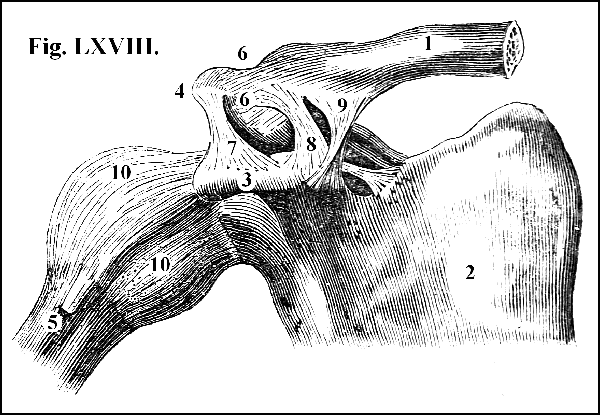
145. The clavicle serves the following uses: it sustains the upper extremity; it connects the upper extremity with the thorax; it prevents the upper extremity from falling forwards upon the thorax; and it affords a fixed point for steadying the extremity in the performance of its various actions.
146. The glenoid cavity of the scapula (fig. LXV. 7) receives the head of the humerus, the bone of the arm (fig. LXV. 9), and the two bones being united by ligament form the shoulder-joint (fig. LXVIII.). This joint is what is termed a ball and socket joint, the peculiarities of which are two: first, beyond all others this mode of articulation admits of free and extensive motion; in the present case, there is the utmost freedom of motion in every direction, upwards, downwards, backwards, and forwards. In the second place, this mode of articulation admits of the motion of the limb without that of the body, or of the motion of the body [Pg 262] without that of the limb. When at rest, the arm may be moved in almost any direction without disturbing the position of any other part of the frame; the manifold advantages of which are obvious. On the other hand, by careful management, very considerable variations in the posture of the body may be effected without the communication of any degree of motion to the limb; an unspeakable advantage when the limb has sustained injury, or is suffering from disease.
147. It does not seem possible to construct a joint of great strength, capable, at the same time, of the degree of motion possessed by the joint of the shoulder. So shallow is the socket of the scapula, and so large the head of the humerus, that it seems as if the slightest movement must dislodge it from its cavity (fig. LXVI. 4. 7). For sustaining heavy weights or resisting a great amount of pressure, applied to it suddenly and in various directions, the arm is obviously unfitted. But this is not its office. The superior extremities are the organs of apprehension—the instruments by which the mind executes the commands of the will. They do not need the strength required by the organs that sustain the weight of the body and that perform the function of locomotion; but they do need freedom and extent of motion: to this strength may be sacrificed, and so it is; yet what can be done to combine strength with mobility is effected. Large and strong processes of bone, proceeding [Pg 263] as has been shown (141), from the convex surface of the scapula (figs. LXV. and LXVI.), overhang, and to a considerable extent surround, the head of the arm-bone, especially resisting the force that would dislodge it from its socket and drive it upwards, inwards, and backwards (fig. LXV.), the directions in which force is most commonly applied to it. By these processes of bone the joint is greatly strengthened, especially in those directions. Moreover, a strong ligament, termed the fibrous capsule (fig. LXVIII. 10) envelops the joint. This ligament, arising from the neck of the scapula (fig. LXVIII. 10), expands itself in such a manner as completely to surround the head of the humerus (fig. LXVIII. 10); and then again contracts in order to be inserted into the neck of the bone (fig. LXVIII. 10). This ligament is strengthened by the tendons of no less than four muscles which are expanded over it, as well as by the powerful substance termed fascia which is reflected upon it from both the processes and ligaments of the scapula. In addition to all these expedients for fortifying the joint, it receives a further security in the position of the scapula, which is loose and unattached; which slides easily over the ribs upon its cushion of flesh; which thus obtains, by its facility of yielding, some compensation for its want of strength, eluding the force which it cannot resist.
148. The arm consists of numerous and powerful [Pg 264] muscles, and of a single bone, the humerus, which belongs to the class of bones termed cylindrical (185).
149. The upper end of the humerus terminates in a circular head (fig. LXV. 9), which is received into the socket of the scapula (fig. LXV. 9. 7) [Pg 265] termed, as has been stated (141), its glenoid cavity. The middle portion of the bone, or what is termed its shaft (fig. LXV. 8), diminishes considerably in magnitude, and becomes somewhat rounded (fig. LXV. 8), while its lower end again enlarges, and is spread out into a flattened surface of great extent (fig. LXIX. 1, 3, 2, 4). Of this broad flattened surface, the middle portion is grooved (fig. LXIX. 2): it is covered with cartilage; it forms the articulating surface by which the arm is connected with the fore-arm. On each side of this groove there is a projection of bone or tubercle, termed condyle (fig. LXIX. 3, 4), the inner (fig. LXIX. 3) being much larger than the outer (fig. LXIX. 4). The inner condyle gives origin to the muscles that bend, the outer to those that extend the fore-arm and the fingers (figs. LXXXIV. 1, 2, and LXXXV. 1).
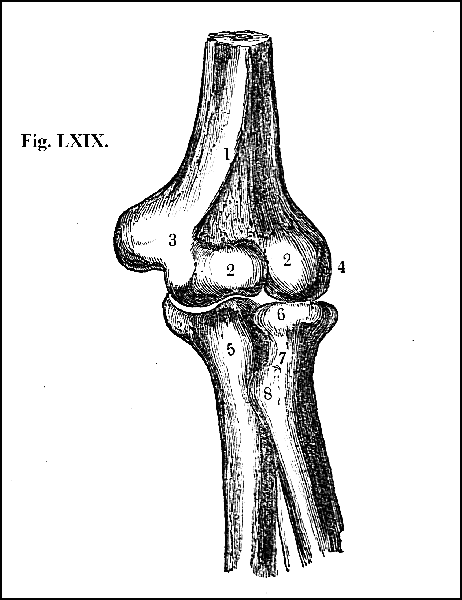
150. The muscles that act upon the arm arise from the back (fig. LXXII. 2), the chest (fig. LXXI. 1), the clavicle (fig. LXXI. 1), and the scapula (fig. LXXI. 3); and they move the arm with freedom and power upwards, downwards, forwards, backwards, inwards, and outwards. The chief muscle that raises the arm is the deltoid (fig. LXXI. 3), which arises partly from the clavicle and partly from the scapula (fig. LXXI. 3). It has the appearance of three muscles proceeding in different directions, the different portions being separated by slight fissures (figs. LXXI. 3, and LXXII. 3). The fibres converging unite and form a powerful muscle which covers the joint of the humerus (fig. LXXI. 3). It is implanted by a short and strong tendon into the middle of the humerus (fig. LXXI. 4). Its manifest action is to pull the arm directly upwards. Its action is assisted by the muscles that cover the back of the scapula, which are in like manner inserted into the humerus, and [Pg 267] which, at the same time that they elevate the arm, support it when raised.
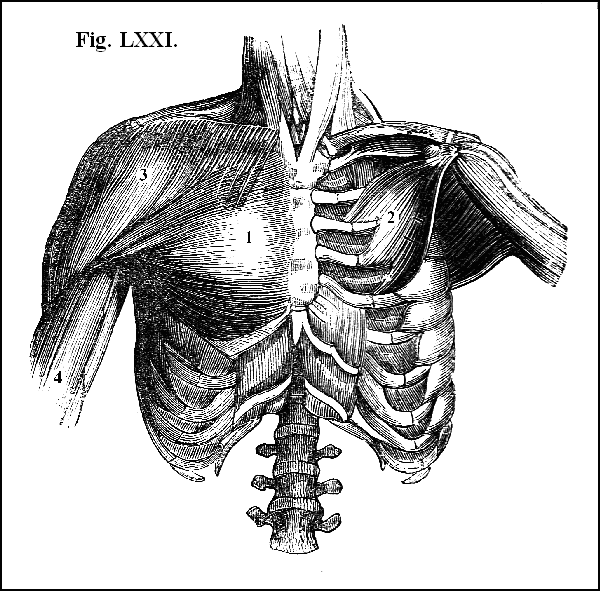
151. The principal muscle that carries the arm downwards is the latissimus dorsi (fig. LXXII. 2), the broadest muscle of the body, which, after having covered all the lower part of the back and loins, terminates in a thin but strong tendon which stretches to the arm, and is implanted into the humerus (fig. LXXII. 2), near the tendon of a muscle immediately to be described,—the great pectoral. When the arm is raised by the deltoid and its assistant muscles, the latissimus dorsi carries it downwards with force, and its powerful action is increased by that of other muscles which arise from the scapula and are inserted into the arm.
152. The principal muscle that carries the arm forwards towards the chest, is the great pectoral (fig. LXXI. 1), which, arising partly from the clavicle (fig. LXXI. 1), partly from the sternum (fig. LXXI. 1), and partly from the cartilages of the second, third, fourth, fifth, and sixth ribs (fig. LXXI. 1), covers the greater part of the breast (fig. LXXI. 1). Its fibres, converging, terminate in a strong tendon, which is inserted near the tendon of the longissimus dorsi into the humerus, about four inches below its head (fig. LXXI. 1). These two muscles form the axilla or armpit, the anterior border of the axilla consisting of the pectoral muscle. Though each of these muscles has its own peculiar office, yet they often act in concert, thereby greatly increasing their power, and the result of their combined action is to carry the arm either directly downwards or to the side of the chest.
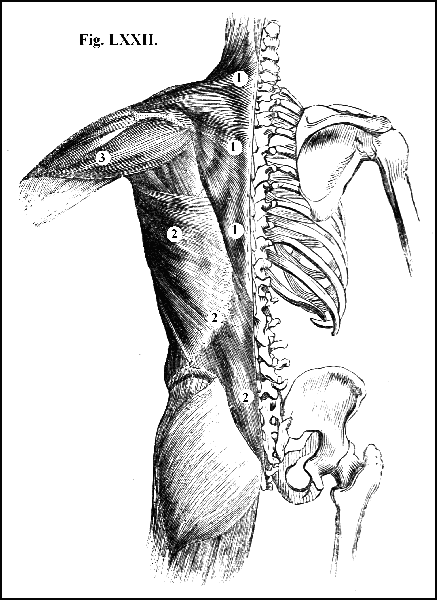
153. Some of the muscles that elevate the arm carry it inwards, and others outwards; the muscles that carry it forwards likewise carry it inwards; while of the muscles that pull it downwards, some direct it forwards and inwards, and others backwards and outwards (151 and 152).
154. It has been already stated that the shoulder-joint is completely surrounded by the muscular fibres or the tendinous expansions of several of these powerful muscles, which have a far greater effect in maintaining the head of the humerus in its socket than the fibrous capsule of the joint; the latter being necessarily loose, in order to allow of the extended and varied motions of the arm, whereas the muscles that encompass the joint adhere closely and firmly to it. Moreover, by virtue of their vital power these muscles act with an efficiency which a mere ligamentous band is incapable of exerting; for they apportion the strength of resistance to the separating force, and react with an energy proportioned to the violence applied.
155. The bones of the fore-arm are two, the ulna and the radius (figs. LXIX. and LXXIII.). The ulna is essentially the bone of the elbow (figs. LXIX. 5, and LXXIII. 3); the radius that of the [Pg 270] hand (fig. LXXV.). Supposing the arm to hang by the side of the body, and the palm of the hand to be turned forwards, the ulna, in apposition with the little finger, occupies the inner; and the radius, in apposition with the thumb, occupies the outer part of the fore-arm (fig. XXXIV. 3).
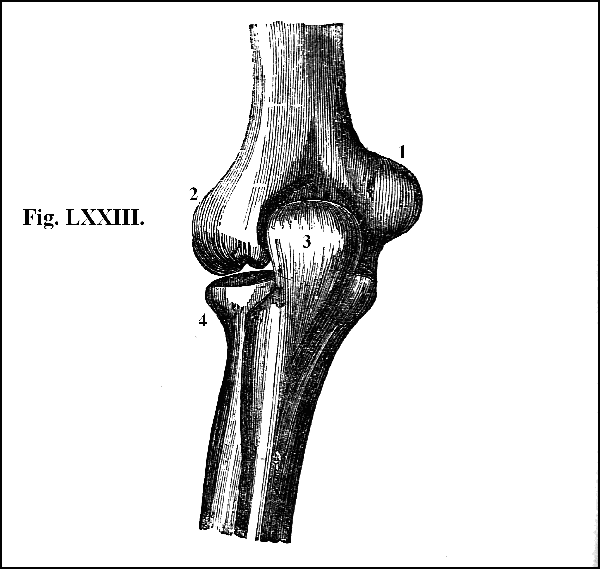
156. The upper end of the ulna belonging to the elbow is large (figs. LXIX. 5, and LXXIII. 3). It sends backwards the large projection commonly named the elbow or olecranon (fig. LXXII. 3), [Pg 271] in the centre of which there is a smooth and somewhat triangular surface (fig. LXXIII. 3) which is always covered by skin of a coarse texture, like that placed over the lower part of the knee-pan, as if nature intended this for a part on which we may occasionally lean and rest. Large at the elbow, the ulna gradually grows smaller and smaller as it descends towards the wrist, where it ends in a small round head (fig. LXXXII. 2), beyond which, on the inner side, or that corresponding to the little finger, it projects downwards a small rounded point, termed the styloid process (fig. LXXXII. 3). As the styloid process and the olecranon, the two extremities of the ulna (figs. LXXIII. 3, and LXXII. 3), are easily and distinctly felt, the length of this bone was primitively used as a measure, called a cubit, which was the ancient name of the bone.
157. The radius, the second bone of the fore-arm, placed along its outer part next the thumb, is small at its upper end (figs. LXIX. 6, and LXXIII. 4); but its body is larger than that of the ulna; while its lower end, next the wrist to which it properly belongs, is very bulky (fig. LXXXII. 1). Its upper end is formed into a small circular head, which is united by distinct joints both to the humerus and to the ulna (fig. LXIX. 6). The top of its rounded head is excavated into a shallow cup (figs. LXIX. 6, and LXXIII. 4) which receives a corresponding convexity of the [Pg 272] humerus (fig. LXIX. 2), and its lower extremity is excavated into an oblong cavity, which receives two of the bones of the wrist (fig. LXXXIII. 1. 4).
158. The joint of the elbow is composed above of the condyles of the humerus (fig. LXIX. 3. 2), and below by the heads of the ulna and radius (fig. LXIX. 5. 6).
159. The upper surface of the ulna is so accurately adapted to the lower surface of the humerus that the one seems to be moulded on the other (figs. LXIX. 5, and LXXIII. 3), and the form of these corresponding surfaces, which are everywhere covered with cartilage, is such as to admit of free motion backwards and forwards, that is, of extension and flexion; but to prevent any degree of motion in any other direction. The joint is therefore a hinge-joint, of which the two motions of flexion and extension are the proper motions. This hinge is formed on the part of the humerus by a grooved surface, with lateral projections (fig. LXIX. 2, 3, 4), and on the part of the ulna by a middle projection with lateral depressions (fig. LXIX. 5): the middle projection of the ulna turning readily on the grooved surface of the humerus (fig. LXIX. 2).
160. The bones are held in their proper situation, first, by a ligament on the fore part of the arm, called the anterior (fig. LXXIV. 6), which arises from the lower extremity of the humerus, and is inserted into the upper part of the ulna and the coronary ligament of the radius (fig. LXXIV. 6. [Pg 273] 8); secondly, by another ligament on the back part of the arm, called the posterior ligament (fig.LXXV. 8), placed in the cavity of the humerus that receives the olecranon of the ulna (fig. LXXV. 8); and thirdly, by two other ligaments at the sides of the ulna (fig. LXXV. 6, 7). The ulna and radius are united, first, by a ligament called the coronary, which, arising from the ulna, passes completely [Pg 274] around the head of the radius (fig. LXXVI. 3), and the attachment of which, while sufficiently close to prevent the separation of the two bones, is yet not adherent to the radius, for a reason immediately to be assigned; secondly, by another ligament which passes in an oblique direction from one bone to the other (fig. LXXVI. 4); and thirdly, by a dense and broad ligament, termed the interosseous (figs. LXXIV. 10, and LXXVI. 5), which fills up the space between the two bones nearly in [Pg 275] their whole extent. This ligament serves other offices besides that of forming a bond of union, affording, more especially, a greater extent of surface for the attachment of muscles, and separating the muscles on the anterior from those on the posterior part of the limb.

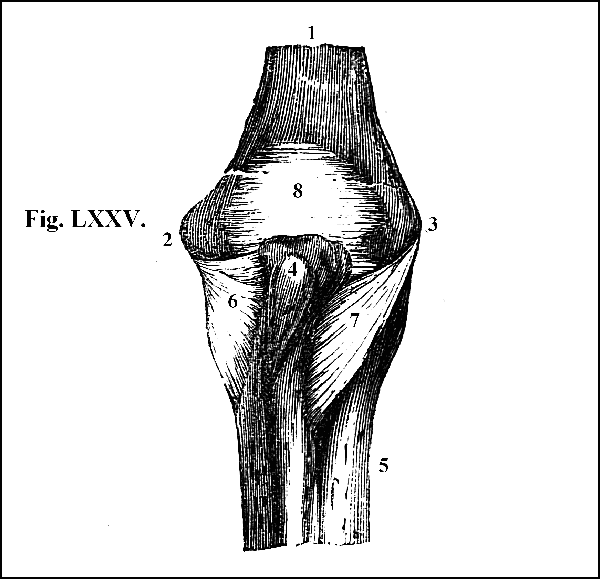
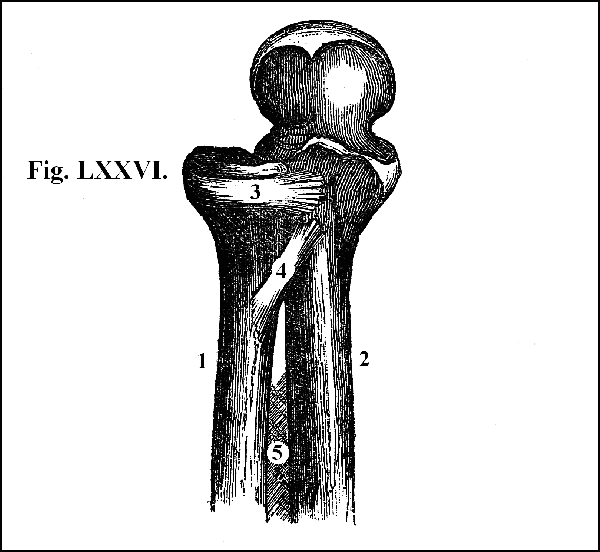
161. At their inferior extremities the ulna and radius are united partly by the interosseous ligament (fig. LXXVII. 1) and partly by ligamentous fibres which pass transversely from one bone to the other (fig. LXXVII. 2) on the anterior and the posterior surface of the fore-arm.
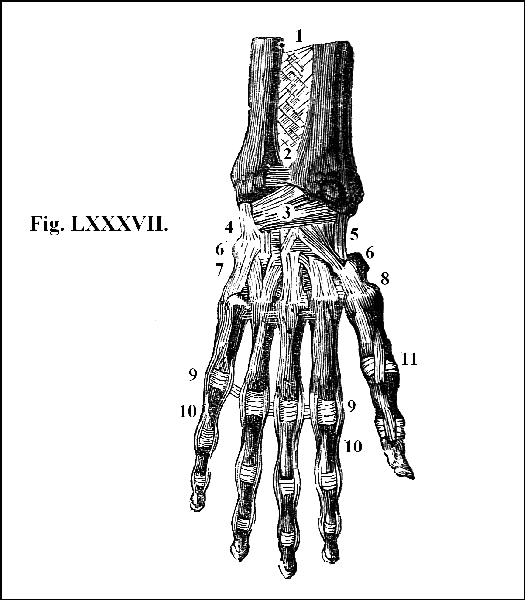
162. The lower extremity of the radius is also united to the wrist; and the hand being attached to the wrist, the junction of the hand and the fore-arm is effected by the articulation of the wrist with the radius (fig. LXXVII.). The ligaments which [Pg 277] connect the bones of the wrist with the radius are bands of exceeding strength (fig. LXXVII. 3).
163. The muscles that act upon the fore-arm are placed upon the arm (fig. LXXVIII.). The joint of the elbow being a hinge-joint, the fore-arm can admit only of two motions, namely, flexion and extension. The muscles by which these motions are effected are four, two for each; the two flexors being placed on the fore part (fig. LXXVIII. 2. 4), and the two extensors on the back part of the arm (fig. LXXIX. 5).
164. The two flexor muscles of the fore-arm are termed the biceps and the brachialis (fig. LXXVIII. 2, 4). The biceps is so called because it has two distinct heads or points of origin (fig. LXXVIII. 2), both of which arise from the scapula (fig. LXXVIII. 2). About a third part down the humerus the two heads meet, unite and form a bulky muscle (fig. LXXVIII. 2), which, when it contracts, may be felt like a firm ball on the fore part of the arm, the upper part of the ball marking the point of union of the two heads (fig. LXXVIII. 2). The muscle gradually becoming smaller, at length terminates in a rounded tendon (fig. LXXVIII. 3), which is implanted into the tubercle of the radius a little below its neck (fig. LXXVIII. 3). It is an exceedingly thick and powerful muscle, and its manifest action is to bend the fore-arm with great strength. But since its tendon is inserted into the radius, besides bending the fore-arm, it assists other muscles that also act upon the radius in the performance of a function to be described immediately (168).
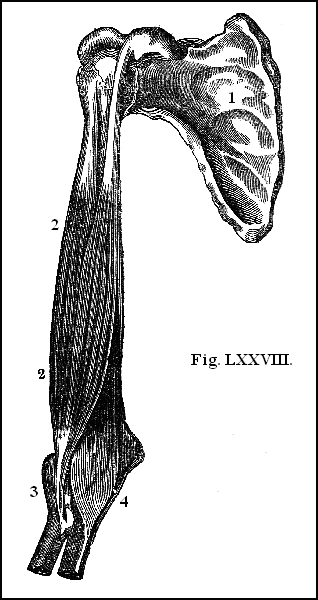
165. The second flexor of the fore-arm, termed the brachialis, is placed immediately under the biceps, and is concealed by it for a considerable part of its course (fig. LXXVIII. 4). Arising from the humerus, on each side of the insertion of the deltoid, it continues its attachment to the bone all the way down the fore part of the humerus, to within inch of the joint; it then passes over the joint, adhering firmly to the anterior ligament (fig. LXXVIII. 4), and is inserted by a strong tendon into the ulna (fig. LXXVIII. 4). It is a thick and fleshy muscle, powerfully assisting the action of the biceps.
166. The two extensor muscles are named the triceps and the anconeous (fig. LXXIX.). The triceps, seated on the back part of the arm, derives its name from having three distinct points of origin, or three separate heads (fig. LXXIX. 5); one of which arises from the scapula and two from the humerus (fig. LXXIX. 5). All these heads adhere firmly to the humerus, as the brachialis does on the fore part of the arm, down to within an inch of the joint (fig. LXXIX. 5), where they form a strong tendon, which is implanted into the olecranon of the ulna (fig. LXXIX. 3); the projection of which affords a lever for increasing the action of the muscle. In all animals that leap and bound, this process of the ulna is increased in length in proportion to their power of performing these movements. The triceps forms an exceedingly thick and strong muscle, which envelops the whole of the back part of the arm (fig. LXXIX.); its action is simple and obvious; it powerfully extends the fore-arm. The anconeous, a small muscle of a triangular form, arising from the external condyle of the humerus, and inserted into the ulna a little below the olecranon, assists the action of the triceps.
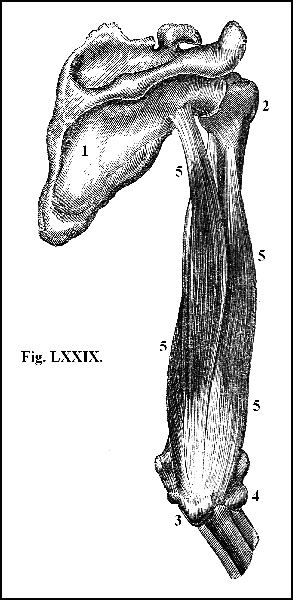
167. Such are the motive powers which act upon the fore-arm, and which produce all the motions of which the hinge-joint of the elbow renders it capable. But besides flexion and extension, the fore-arm is capable of the motion of rotation, which is accomplished by means of the radius. It has been shown (157) that the top of the rounded head of the radius is excavated into a shallow cup (figs. LXIX. 6, and LXXIII. 4) which receives a corresponding convexity of the humerus (figs. LXIX. 2, and LXXIII. 2). In consequence of this articulation with the humerus, the radius, like the ulna, can move backwards and forwards in flexion and extension, the proper movements of the hinge-joint; but that portion of the margin of the hinge of the radius which is in apposition with the ulna is convex (fig. LXIX. 6), and is received into a semilunar cavity hollowed out in the ulna (fig. LXIX. 5). In this cavity the rounded head of the radius revolves, the two bones being held together by the ligament [Pg 282] already described (160), which surrounds the head of the radius (fig. LXXVI. 3), and which holds it firmly without being adherent to it, and without impeding in any degree the rotatory motion of the radius. Below, the surface of the radius next the ulna is hollowed out into a semilunar cavity (fig. LXXXII. 1), which receives a corresponding convex surface of the ulna (fig. LXXXII. 2), upon which convex surface the radius rolls (fig. LXXXII. 1). Thus, by the mode in which it is articulated with the ulna above, the radius turns upon its own axis. By the mode in which it is articulated with the ulna below, the radius revolves upon the head of the ulna; and, in consequence of both articulations, is capable of performing the motion of rotation. Moreover, the hand being attached to the radius through the medium of the wrist (figs. LXXXII. 1. 4. and LXXXIII. 1. 4) must necessarily follow every movement of the radius; the rotation of which brings the hand into two opposite positions. In the one, the palm of the hand is directed upwards (fig. LXXXII.); in the other, it is turned downwards (fig. LXXXIII.). When the hand is turned upwards, it is said to be in the state of supination (fig. LXXXII.); when downwards, in that of pronation (fig. LXXXIII.). A distinct apparatus of muscles is provided for effecting the rotation of the radius, in order to bring the hand into these opposite states: one set for producing its supination, and another its pronation.
168. The principal supinators arise from the external condyle of the humerus (fig. LXXX.), and are called long and short (fig. LXXX. 4, 5). The long supinator extends as far as the lower end of the radius, into which it is inserted (fig. LXXX. 4): the short supinator surrounds the upper part of the radius, and is attached to it in this situation (fig. LXXX. 5.). Moreover, the triceps, being inserted into the radius (164), often cooperates with the supinators and powerfully assists their action.
169. The principal pronators are also two, called the round and the square (figs. LXXXI. and LXXXVI. 1). The round pronator arises from the internal condyle, and passing downwards, is inserted into the middle of the radius (fig. LXXXI. 4); the square pronator is a small muscle between the radius and ulna, at their lower extremities being attached to each (fig. LXXXVI. 1).
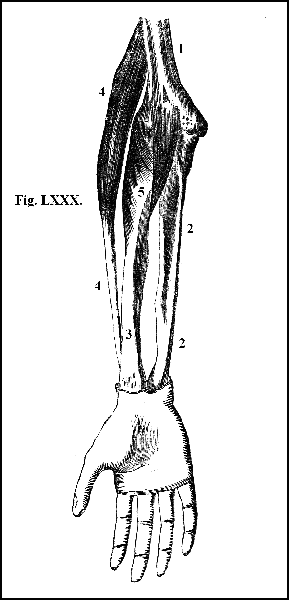
170. The action of these muscles in producing the rotation of the radius, and so rendering the hand supine or prone, is sufficiently manifest from the mere inspection of the diagrams (fig. LXXXI. 4).
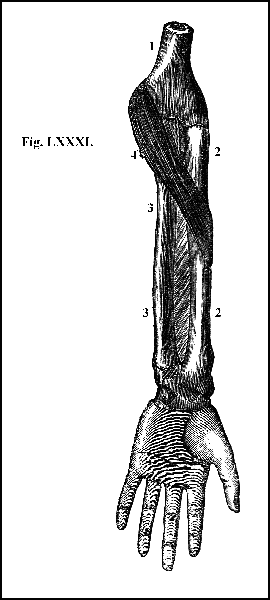
171. The hand is composed of the carpus, metacarpus, and fingers.
172. The carpus (fig. LXXXII. 4) consists of eight small wedge-shaped bones, placed in a double row, each row containing an equal number, and the whole disposed like stones in an arch (fig. LXXXII. 4). They do in fact form an arch, the convexity of which is upwards, on the dorsal surface (fig. LXXXIII. 4); and the concavity downwards, on the palmar surface (fig. LXXXII. 4). But they differ from the stones of an arch in this, that each bone is joined to its fellow by a distinct moveable joint, each being covered with a smooth articulating cartilage. At the same time all of them are tied together by ligaments of prodigious strength, which cross each other in every direction (fig. LXXVII. 6), so that the several separate joints are consolidated into one great joint. The consequence of this mechanism is that some degree of motion is capable of taking place between the several bones, which, when multiplied together, gives to the two rows of bones such an extent of motion, that when the wrist is bent the arch of the carpus forms a kind of knuckle. By this construction a facility and ease of motion, and a power of accommodation to motion and force, are obtained, such as belong to no arch contrived by human ingenuity.
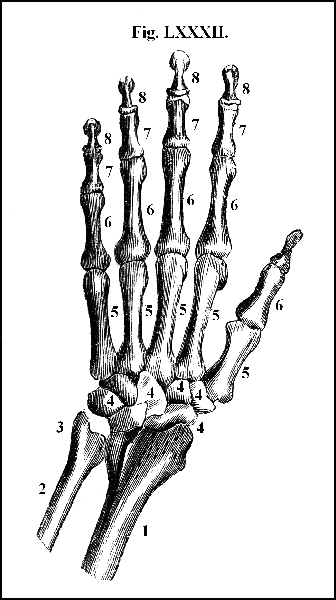
173. The metacarpus (fig. LXXXII. 5), the middle portion of the hand, interposed between the wrist and the fingers, is composed of five bones, which are placed parallel to each other (fig. LXXXII. 5). They are convex outwardly, forming the back (fig. LXXXIII. 5), and concave inwardly, forming the hollow of the hand (fig. LXXXII. 5). They are large at each end, to form the joints by which they are connected with the wrist and fingers (figs. LXXXII. and LXXXIII.): they are small in the middle, in order to afford room for the lodgment and arrangement of the [Pg 289] muscles, that move the fingers from side to side (fig. LXXXVI. 2). Their ends, which are joined to the carpus, are connected by nearly plane surfaces (figs. LXXXII. and LXXXIII.): their ends, which support the fingers, are formed into rounded heads, which are received into corresponding cup-shaped cavities, excavated in the top of the first bones of the fingers (fig. LXXXII. 5.). The powerful ligaments that unite these bones pass, both on the dorsal and the palmar surface, from the inferior extremity of the second row of the carpal to the bases of the metacarpal bones (fig. LXXVII, 7, 8). The ligaments are arranged in such a manner as to limit the motions of the joints chiefly to those of flexion and extension, allowing, however, a slight degree of motion from side to side.
174. Each of the fingers is composed of three separate pieces of bone, called phalanges; the thumb has only two (fig. LXXXII. 6, 7, 8): the phalanges are convex outwardly (fig. LXXXII. 6, 7, 8) for increasing their strength, and flattened inwardly (fig. LXXXIII. 6, 7, 8) for the convenience of grasping. The last bones of the fingers, which are small, terminate at their under ends, in a somewhat rounded and rough surface (fig. LXXXIII. 8), on which rests the vascular, pulpy, and nervous substance, constituting the special organ of touch, placed at the points of the fingers, and guarded on the upper surface by the nail (fig. LXXXII. 8).
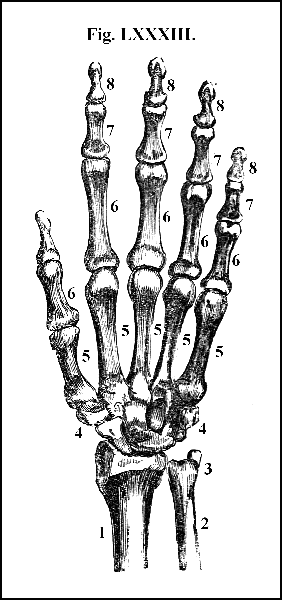
175. The round inferior extremity of the metacarpus is admitted into the cavity of the superior extremity of the first phalanx of the five fingers (figs. LXXXII. and LXXXIII.), and their joints are connected by lateral and transverse ligaments of great strength (fig. LXXVII. 9). The situation and direction of the ligaments which unite the several phalanges of the fingers (fig. LXXVII. 9) are precisely the same as those of the articulation of the phalanges with the metacarpus (fig. LXXVII. 7, 8); and the articulation of these bones with one another is such as to admit only of the motions of flexion and extension.
176. The muscles which perform these motions are seated for the most part on the fore-arm. Independently of the supinators and pronators which have been already described (167 et seq.), there are distinct sets of muscles for bending and extending the wrist and the fingers. The flexors arise from the internal, and the extensors from the external, condyle of the humerus (fig. LXIX. 3, 4). The internal condyle is larger and longer than the external (fig. LXIX. 3, 4); for the flexors require a larger point of origin and a longer fulcrum than the extensor muscles; because to the actions of flexion, such as grasping, bending, pulling, more power is necessary than to the action of extension, which consists merely in the unfolding or the opening of the hand previously to the renewal of the grasp.
177. For the same reason, two muscles are provided [Pg 291] for flexing, while only one is provided for extending the fingers. The flexors, bulky, thick, and strong, are placed on the fore part of the fore-arm (fig. LXXXIV.). The first, named the superficial flexor (fig. LXXXIV. 1), about the middle of the arm, divides into four fleshy portions, each of which ends in a slender tendon (fig. LXXXIV. 1). As these tendons approach the fingers they expand (fig. LXXXIV. 1), and when in apposition with the first phalanx, split and form distinct sheaths for the reception of the tendons of the second flexor (fig. LXXXIV. 3). After completing the sheath, the tendons proceed forward along the second phalanx, into the fore part of which they are implanted, and the chief office of this powerful muscle is to bend the second joint of the fingers upon the first, and the first upon the metacarpal bone. Its action is assisted by a second muscle, called the deep or profound flexor (fig. LXXXIV. 2), because it lies beneath the former; or the perforans, because it pierces it. Bulky and fleshy, this second flexor, like the first, about the middle of the arm, divides into four tendons, which, entering the sheaths prepared for them in the former muscle (where the tendons are small and rounded for their easy transmission and play), pass to the root of the third phalanx of the fingers into which they are implanted (fig. LXXXIV. 3).

118. The muscle that extends the fingers, called the common extensor, is placed on the back part of the fore-arm (fig. LXXXV.), about the middle of which it divides into four portions which terminate in so many tendons (fig. LXXXV. 2). When they reach the back of the metacarpal bones, these tendons become broad and flat, and send tendinous expansions to each other, forming a strong tendinous sheath which surrounds the back of the fingers (fig. LXXXV. 2). These tendinous expansions are inserted into the posterior part of the bones of the four fingers (fig. LXXXV. 2); and their office is powerfully to extend all the joints of all the fingers (fig. LXXXV. 2).
179. On both the palmar and dorsal regions of the wrist are placed ligaments for tying down these tendons, and preventing them from starting from their situation during the action of the muscles (figs. LXXXIV. and LXXXV.). On the palmar region an exceedingly strong ligament passes anteriorly to the concave arch of the carpus (fig. LXXXIV. 4) for the purpose of tying down the tendons of the flexor muscles. On the dorsal surface (fig. LXXXV.), a similar ligament, passing in an oblique direction from the styloid process of the radius to the styloid process of the ulna (fig. LXXXV. 3), performs the same office in tying down the tendons of the extensor muscle. Both these ligaments are called annular.
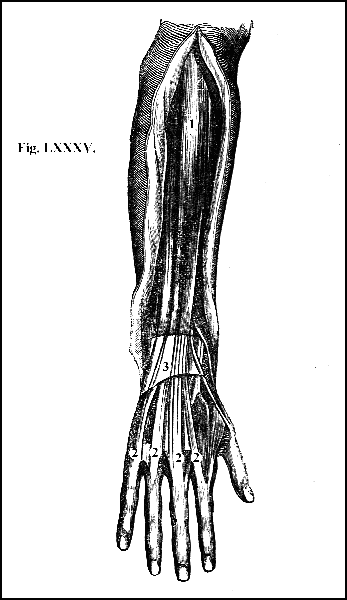
180. In the palm of the hand are placed additional muscles which assist the flexors of the fingers (fig. LXXXVI. 2), being chiefly useful in enabling the fingers to perform with strength and precision short and quick motions. There are especially four small and rounded muscles (fig. LXXXVI. 2), resembling the earth worm in form and size, and hence called lumbricales; but as their chief use is to assist the fingers in executing short and rapid motions, they have also received the better name of the musculi fidicinales.
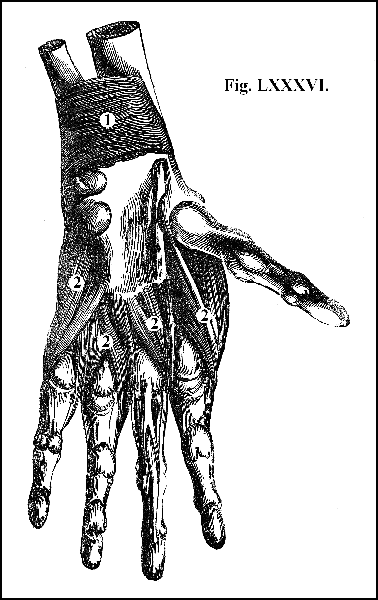
181. The thumb, in consequence of the comparative looseness of its ligaments, is capable of a much greater extent of motion than the fingers, and can be applied to any part of each of the fingers, to different parts of the hand, and in direct opposition to the power exerted by the whole of the fingers and hand, in the act of grasping. The muscles which enable it to perform these varied motions, and which act powerfully in almost every thing we do with the hand, form a mass of flesh at the ball of the thumb (fig. LXXXVII. 1), almost entirely surrounding it. The little finger is also provided with a distinct apparatus of muscles (fig. LXXXVII. 2), which surrounds its root, just as those of the thumb surround its ball, in order to keep it firm in opposition to the power of the thumb in the act of grasping, and in various other motions.
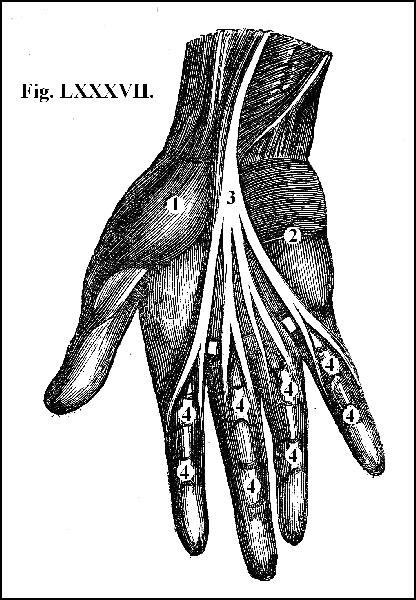
182. The upper extremity is covered by a tendinous expansion or fascia which envelopes the whole arm, encloses its muscles as in a sheath, and affords them, in their strong actions, "that kind of support which workmen feel in binding their arms with thongs." This fascia likewise descends between many of the muscles, forming strong partitions between them, and affording points of origin to many of their fibres, scarcely less fixed than bone itself.
183. From the whole, it appears, that the first joint of the upper extremities, that of the shoulder, is a ball and socket joint, a joint admitting of motion in every direction; that the second joint, that of the elbow, is partly a hinge-joint, admitting of flexion and extension, and partly a rotation joint, admitting of a turning or rotatory motion; and that the joints of the wrist and of the fingers are likewise hinge-joints, admitting at the same time of some degree of lateral motion. When these various motions are combined, the result is that the hand can apply itself to bodies in almost every direction, in any part of the area described by the arm, when all the joints are moved to their utmost extent. There is thus formed an instrument of considerable strength, capable of a surprising variety and complexity of movements, capable of seizing, holding, pulling, pushing and striking with great power, yet at the same time capable of apprehending the minutest objects, and of guiding them with the utmost gentleness, precision, and accuracy, so that there are few conceptions of the designing mind which cannot be executed by the skilful hand.
184. The lower extremities consist of the thigh, leg, and foot.
185. The osseous part of the thigh consists of a single bone, called the femur (fig. XXXIV. 4), the longest, thickest, and strongest bone in the body. It sustains the entire weight of the trunk, and occasionally much heavier loads superimposed upon it. It is constructed in such a manner as to combine strength with lightness. This is effected by rendering the bone what is technically [Pg 299] called cylindrical; that is, a bone in which the osseous fibres are arranged around a hollow cylinder. There are two varieties of osseous matter,—the compact, in which the fibres are dense and solid (fig. LXXXVIII. 1), and the spongy, in which the fibres are comparatively tender and delicate (fig. LXXXVIII. 2). Both varieties are, indeed, combined, more or less, in every bone, the compact substance being always external, and the spongy internal; but in the cylindrical bones the arrangement is peculiar. Every long or cylindrical bone consists of a body or shaft (fig. LXXXVIII. 4.), and of two extremities (fig. LXXXVIII. 5). The body is composed principally of compact substance, which on the external surface is so dense and solid, that scarcely any distinct arrangement is visible; but towards the interior this density diminishes; the fibres become distinct (fig. LXXXVIII. 5), and form an expanded tissue of a cellular appearance (fig. LXXXVIII. 5), the cells being called cancelli, and the structure cancellated. In the centre of the bone even the cancelli disappear; the osseous fibres terminate; and a hollow space is left filled up, in the natural state, by an infinite number of minute membranous bags which contain the marrow (fig. LXXXVIII. 3). In the body of the bone, to which strength is requisite, that part being the most exposed to external violence, the compact matter is arranged around a central cavity. By this means strength is secured [Pg 300] without any addition of weight; for the resisting power of a cylindrical body increases in proportion to its diameter; consequently the same number of osseous fibres placed around the circumference of a circle produce a stronger bone than could have been constructed had the fibres been consolidated in the centre, and had the diameter been proportionally diminished. The hollow space thus gained in its centre, renders the bone lighter by the subtraction of the weight of as many fibres as would have gone to fill up that space; while its strength is not only not diminished by this arrangement, but positively increased. On the other hand, at the extremities of the bone, space, not strength, is required; required for the attachment and arrangement of the tendons of the muscles that act upon it, and for the formation of joints (fig. LXXXVIII. 5). Accordingly, at its extremities the bone swells out into bulky surfaces; but these surfaces are composed, not of dense and solid substance, but of spongy tissue, covered by an exceedingly thin crust of compact matter, and so, as by the former expedient strength is secured without increase of weight, by this, space is obtained without increase of weight.
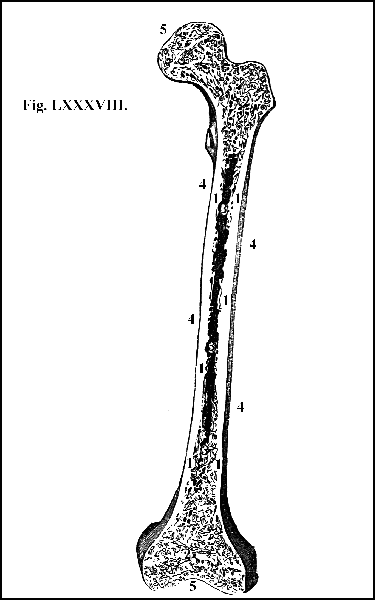
186. The thigh-bone, placed at the under and outer part of the pelvis, has an oblique direction, the under being considerably nearer its fellow than the upper end (fig. XXXIV. 4), in order to afford space for the passages at the bottom of the pelvis, and also to favour the action of walking. The body of the bone, which is of a rounded form (fig. XXXIV. 4), is smooth on its anterior surface (fig. XXXIV. 4), where it is always slightly convex, the convexity being forwards (fig. XXXIV. 4), while its posterior surface is irregular and rough, and forms a sharp prominent line, termed the linea aspera (fig. XXXV. 4), giving attachment to numerous muscles.
187. The superior extremity of the femur terminates in a large ball or head, which forms nearly two-thirds of a sphere (fig. LXXXIX. 4.). It is smooth, covered with cartilage, and received into the socket of the ilium called the acetabulum, which, deep as it is, is still further deepened by the cartilage which borders the brim (fig. LXXXIX. 3). The brim is particularly high in the upper and outer part, because it is in this direction that the reaction of the ground against the descending weight of the trunk tends to dislodge the ball from its socket.
188. Passing obliquely downwards and outwards from the ball, is that part of the femur which is called the neck (fig. LXXXIX. 5). It spreads out archlike between the head and the body of the bone, and is more than an inch in length (fig. LXXXIX. 5). It is thus long in order that the head of the bone may be set deep in its socket, and that its motions may be wide, free, and unembarrassed.

189. From the external surface of the femur, nearly in a line with its axis, proceeds the largest and strongest bony process of the body which gives insertion to its most powerful muscles, namely, those that extend the thigh and that turn it upon its axis (fig. LXXXIX. 6). Because, from its oblique direction, it rotates the thigh, this process is called the trochanter, and, from its size, the trochanter major. At the under and inner part of the neck on the posterior surface of the bone, is a similar process, but much smaller, called the trochanter minor (fig. XXXV. 4), into which are inserted the muscles that bend the thigh.
190. The inferior extremity of the femur, much broader and thicker than the superior (fig. XC. 1), is terminated by two eminences, with smooth surfaces, termed condyles (fig. XC. 2), which, articulated with the tibia, and the patella, form the joint of the knee (figs. XC. 2, 4, 5, and XCI. 1, 2, 3).
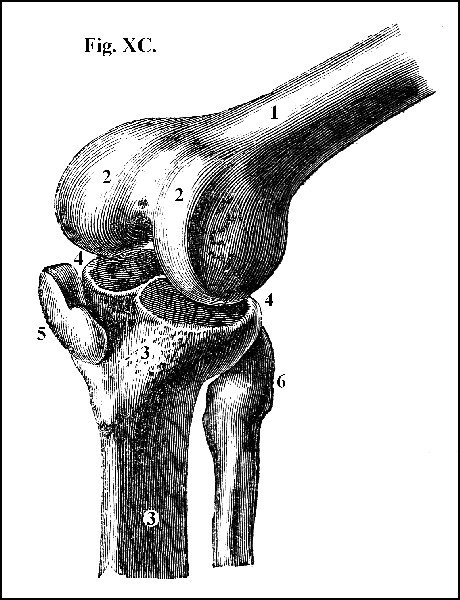
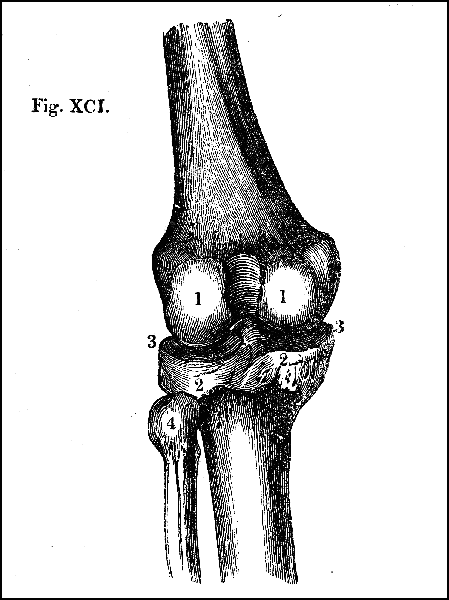
191. The bones of the leg, two in number, consist of the tibia (fig. XC. 3) and fibula (fig. XC. 6). The tibia, next to the femur, the longest bone in the body, is situated at the inner side of the leg (fig. XC. 3). Its superior extremity is bulky and thick (fig. XC. 3). The top of it forms two smooth and slightly concave surfaces, adapted to the convex surfaces of the condyles of the femur (fig. XC. 4, 2). On its outer side there is a smooth surface, to which the head of the fibula is attached (fig. XC. 6). Its lower extremity, which is small, forms a concavity adapted to the convexity of the bone of the tarsus, called the astragalus, with which it is articulated (fig. XCII. 4.) Its inner part is produced so as to form the inner ankle (figs. XCII. 2, and XCIII. 3): its outer side is excavated into a semilunar cavity, for receiving the under end of the fibula, which forms the outer ankle (figs. XCII. 3, and XCIII. 4).
192. The fibula, in proportion to its length the most slender bone of the body, is situated at the outer side of the tibia (fig. XC. 6). Its upper end formed into a head, with a flat surface on its inner side (figs. XC. 6, and XCI. 4), is firmly united to the tibia (fig. XC. 4). Its lower end forms the outer ankle, which is lower and farther back than the inner (fig. XCII. 3, 2).
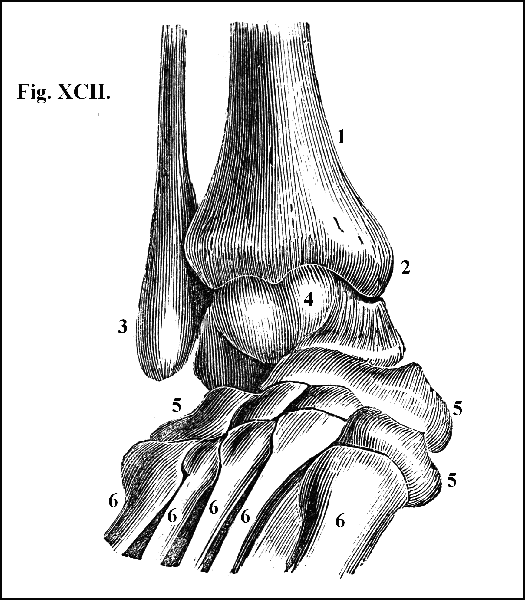
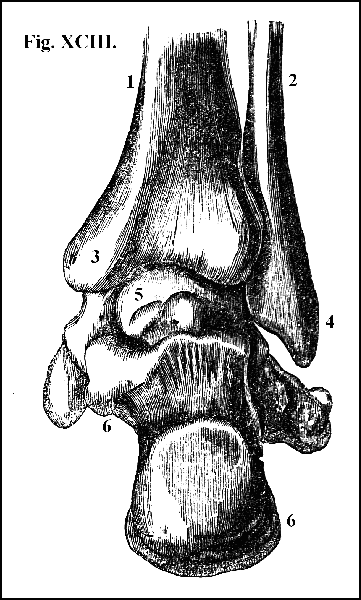
193. The patella, or knee-pan (fig. XC. 5), is a light but strong bone, of the figure of the heart as painted on playing-cards, placed at the fore part of the joint of the knee, and attached by a strong ligament to the tibia, the motions of which it follows (fig. XC. 5). It is lodged, when the knee is extended, in a cavity formed for it in the femur (fig. XC.); when bent, in a cavity formed for it at the fore part of the knee (fig. XC. 5).
194. The foot consists of the tarsus, metatarsus, and toes.
195. The tarsus, or instep, is composed of seven strong, irregular-shaped bones, disposed like those of the carpus, in a double row (fig. XCII. 4, 5). The arrangement of the tarsal bones is such as to form an arch, the convexity of which above, constitutes the upper surface of the instep (fig. XCII. 4, 5): in the concavity below are lodged the muscles, vessels, and nerves that belong to the sole.
196. The metatarsus consists of five bones, which are placed parallel to each other (fig. XCII. 6), and which extend between the tarsus and the proper bones of the toes (fig. XCII. 6). Their extremities, especially next the tarsus, are large, in order that they may form secure articulations with the tarsal bones (fig. XCII. 6). Their bodies are arched upwards (fig. XCII. 6), slightly concave below, and terminate forwards in small, neat, round heads, which receive the first bones of the toes, and with which they form joints, admitting of a much greater degree of rotation than is ever actually exercised, in consequence of the practice of wearing shoes. The natural, free, wide-spreading form of the toes, and the consequent security with which they grasp the ground, is greatly impaired by this custom. Taken together, the bones of the metatarsus form a second arch corresponding to that of the tarsus (fig. XCVIII. 2).
197. Each toe consists of three distinct bones, [Pg 310] called, like those of the fingers, phalanges (fig. XCVIII.), but the great toe, like the thumb, has only two (fig. XCVIII.). That extremity of the first phalanges which is next the metatarsal bones is hollowed into a socket for the head of the metatarsal bones.
198. Besides the bones already described, there are other small bones, of the size and figure of flattened peas, found in certain parts of the extremities, never in the trunk, called sesamoid, from their resemblance to the seed of the sesamum. They belong rather to the tendons of the muscles than to the bones of the skeleton. They are embedded within the substance of tendons, are found especially at the roots of the thumb and of the great toe, and are always placed in the direction of flexion. Their office, like that of the patella, which is, in truth, a bone of this class, is to increase the power of the flexor muscles by altering the line of their direction, that is, by removing them farther from the axis of the bone on which they are intended to act.
199. The ligaments which connect the bones of the lower extremities are the firmest and strongest in the body. Of these, the fibrous capsule of the hip-joint (fig. XCIV. 1), which secures the head of the femur in the cavity of the acetabulum (fig. XCIV.), is the thickest and strongest. It completely surrounds the joint (fig. XCIV. 1). It arises from the whole circumference of the acetabulum, [Pg 311] and, proceeding in a direction outwards and backwards, is attached below to the neck of the femur (fig. XCIV. 1). It is thicker, stronger, and much more closely attached to the bones than the fibrous capsule of the shoulder-joint (144), because the hip-joint is formed, not like the shoulder-joint, for extent of motion, but for strength. Its internal surface is lined by synovial membrane, and its external surface is covered and strengthened by the insertion of muscles that move the thigh-bone. The joint is strengthened by another ligament, which passes from the inner and fore part of the cavity of the acetabulum (fig. XCV.) to be inserted into the head of the femur (fig. XCIV.), called the round ligament, the office of which obviously is to hold the head of the femur firmly in its socket.
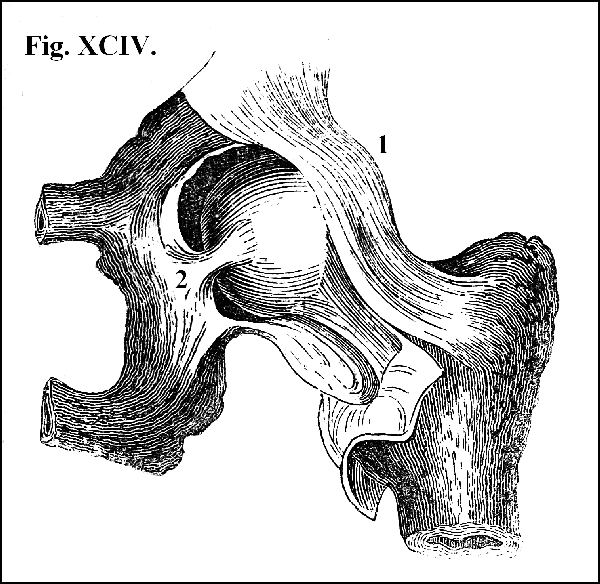
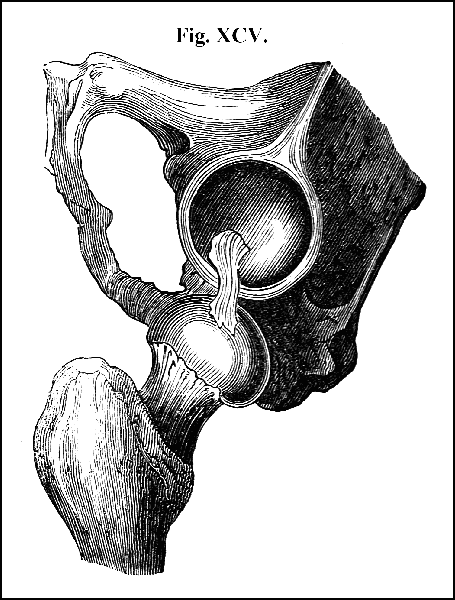
200. Numerous and complicated ligaments connect the bones that form the knee-joint (fig. XCVI.), and the strength of these powerful bands [Pg 313] is greatly increased by the tendons that move the leg (fig. XCVI. 5), which pass over, and more or less surround, the joint.
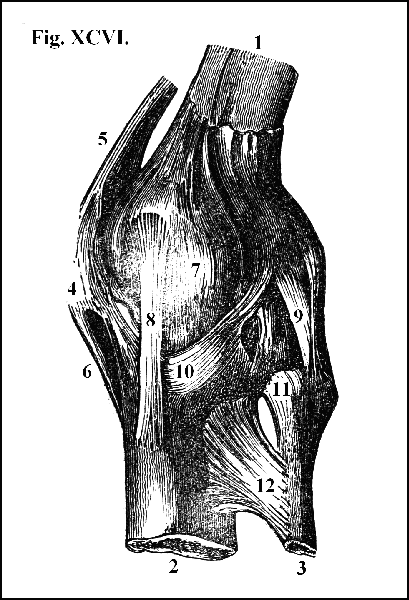
201. Strong ligaments maintain in their proper position the bones that form the ankle-joint (fig. [Pg 314] XCVII.), connect the bones of the tarsus and metatarsus with one another (fig. XCVIII. 1), and articulate the several phalanges of the toes (fig. XCVIII. 2).
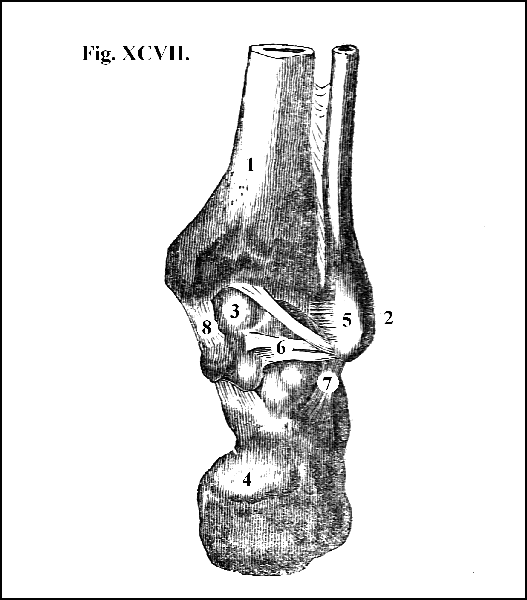
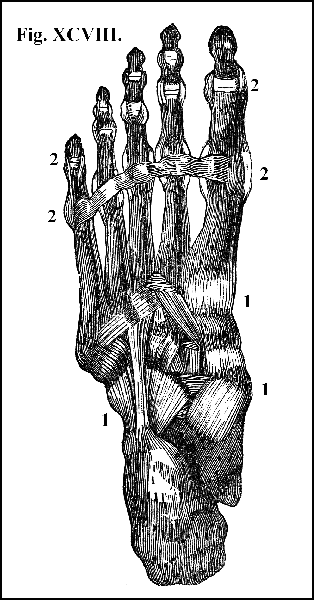
202. The joint of the hip, like that of the shoulder, is capable of flexion, extension, and rotation; but its rotatory motions are to a much less extent, on account of the greater depth of the acetabulum and the stronger and shorter fibrous capsule. When the femur is flexed, the thigh is bent upon the pelvis, and its inferior extremity is [Pg 316] carried forwards. When it is extended, the thigh is carried backwards. The two thighs may be separated from each other laterally (abduction), or brought near to each other (adduction), or the one may be made to cross the other, and they may be rotated outwards or inwards.
203. The apparatus of muscles that produces these varied motions is seated partly on the trunk and partly on the pelvis. Thus, the powerful muscle that flexes the thigh, or that carries it forwards, termed the psoas (fig. XCIX. 1), arises from the last vertebra of the back, and successively from each vertebra of the loins (fig. XCIX. 1), and is inserted into the lesser trochanter of the femur (fig. XCIX. 3). Its action is assisted first by a large and strong muscle named the iliacus (fig. XCIX. 2), which occupies the whole concavity of the ilium (fig. XCIX. 2), and which, like the psoas, is inserted into the lesser trochanter of the femur (fig. XCIX. 3).
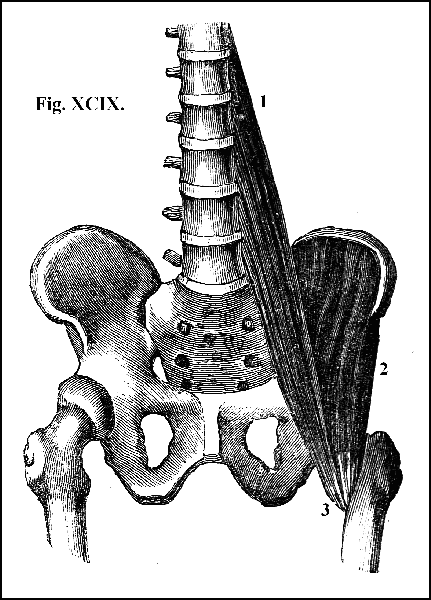
204. The muscles that extend the thigh, or that carry it backwards, named the glutæi, the most powerful muscles of the body, are placed in successive layers, one upon the other, on the back part of the ilium (fig. C. 1, 2, 3), and are inserted into the linea aspera of the femur. They constitute the mass of flesh which forms the hip, and their powerful action in drawing the thigh backwards is assisted by several other muscles (fig. C. 4, 5, 6). Their action is never perfectly simple and direct; for those which move the thigh forwards sometimes carry it inwards, and sometimes outwards; and in like manner, those which move it backwards, at one time carry it inwards and at [Pg 318] another outwards, according to the direction of the fibres of the muscle and the position of the limb when those fibres act; while some of them, and more especially those which carry it backwards, at the same time rotate it, or roll it upon its axis.

205. The knee is a hinge-joint, admitting only of flexion and extension, and is therefore provided only with two sets of muscles, one for bending and the other for extending the leg. The flexors of [Pg 319] the leg arise from the under and back part of the pelvis, are seated on the back part of the thigh, [Pg 320] and are inserted into the upper part either of the tibia or of the fibula (fig. CI). They consist for the most part of three muscles, named the semi-tendinosus, the semi-membranosus (fig. CI. 3), and the biceps of the leg (fig. CI. 1). The tendons of the two former muscles, in passing to be inserted into the leg, form the inner, and that of the latter the outer, hamstrings (fig. CI. 4, 5).
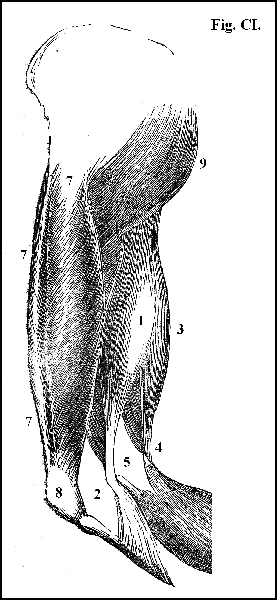
206. Four large muscles, blended together in such a manner as to form one muscle of prodigious size, termed the quadriceps cruris (fig. CI. 7), occupying nearly all the forepart and the sides, and a considerable portion of the back part of the thigh, constitute the great flexor of the thigh. This enormous mass of muscle arises partly from the ischium, and partly from the upper part of the femur (fig. CI. 7), and is all inserted into the patella (fig. CI. 8), which constitutes a pulley for the purpose of assisting the action of these powerful muscles.
207. The muscles which bend the toes and extend the foot, termed the gastrocnemii (fig. CII. 1, 2), are placed on the back part of the leg, and form the mass of muscle which constitutes the calf [Pg 321] of the leg (fig. CII. 1, 2). They arise partly from the lower extremity of the femur (fig. CII.) and partly from the upper and back part of the fibula and tibia; and they form the largest and strongest tendon in the body, termed the tendo achillis (fig. CII. 3), which is implanted into the heel (fig. CII. 4).
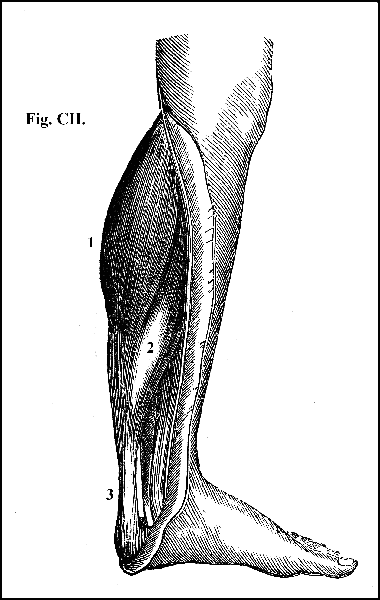
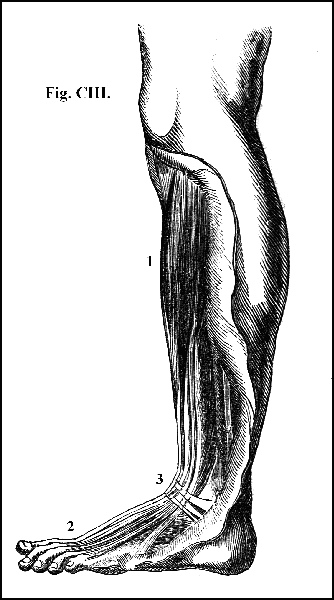

208. The muscles which extend the toes and bend the foot are seated on the fore part of the leg [Pg 324] (fig. CIII.); split into tendons like the analogous muscles of the fingers (fig. CIII. 2); and are bound down by a ligament (fig. CIII. 3), exactly the same in name, disposition, and office, as that which belongs to the hand (fig. CIII. 3). Numerous minute muscles are placed in the sole of the foot (fig. CIV.), which act on the toes as the small muscles in the palm of the hand act on the fingers (fig. LXXXVI.).
209. Such are the moving powers which put in action the complicated mechanism provided for the function of locomotion. And these powers are adequate to their office; but they are what may be termed expensive powers; agents requiring a high degree, of organization and the utmost resources of the economy to support and maintain them. Hence in the construction of the framework of the machine which they have to move, whatever mechanical contrivance may economize their labour, is adopted. The construction, form, and disposition of the several parts of that framework have all reference to two objects: first, the combination of strength with lightness; and secondly, security to tender organs, with the power of executing rapid, energetic, and, sometimes, violent motions. The combination is effected and the object attained in a mode complicated in the detail, simple in the design, and perfect in the result. The weight of the body transmitted from the arch of the pelvis to a second arch, formed by [Pg 325] the neck of the thigh-bone, and from this, in a perpendicular direction, to a third arch formed by the foot, is ultimately received by the heel behind, and by the metatarsal bones and the first phalanges of the toes before, and more especially by the metatarsal joints belonging to the great and little toe, which have a special apparatus of muscles, for the purpose of preserving steadily their relative situation to the heel. The weight of the body is thus sustained on a series of arches, from which it is, in succession, transmitted to the ground, where it ultimately rests upon a tripod: forms known and selected as the best adapted to afford support, and to give security of position. Columns of compact bone superimposed one upon another, and united at different points by bands of prodigious strength, form the pillars of support. But these bony columns never touch each other; are never in actual contact; are all separated by layers of elastic matter which, while they assist in binding the columns together, enable them to move one upon another, as upon so many pliant springs. The layers of cartilage interposed between the several vertebræ; the layer of cartilage interposed between the vertebral column and the pelvis; the layer of cartilage that lines the acetabulum and that covers the head of the femur; the layer of cartilage that covers the lower extremity of the femur and the upper extremity of the tibia and fibula and the tarsus; the successive [Pg 326] layers of cartilage interposed between the several bones of the tarsus; and finally, the layer of cartilage that covers both the tarsal and the digital extremities of the metatarsal bones; are so many special provisions to prevent the weight of the body from being transmitted to the ground with a shock; and, at the same time, so many barriers established between the ground and the spinal cord, the brain and the soft and tender organs contained in the thoracic and abdominal cavities, to prevent these organs from being injured by the reaction of the ground upon the body. The excellence of this mechanism is seen in its results; in contemplating "from what heights we can leap—to what heights we can spring—to what distances we can bound—how swiftly we can run—how firmly we can stand—how nimbly we can dance—and yet how perfectly we can balance ourselves upon the smallest surfaces of support!"
210. It is necessary, in order to complete this general view of the structure of the human body, and of the combination and arrangement of its various parts, to denote the several regions into which, for the purpose of describing with accuracy the situation and relation of its more important organs, the body is divided. It is not needful to the present purpose to describe the regions of the head, because its internal cavity contains only one organ, the brain, and its external divisions do not differ materially from those which are common [Pg 327] and familiar; but the chest, the abdomen, and the upper and lower extremities are mapped out into regions, of which it is very important to have an exact knowledge, which may be acquired by the study of the annexed diagrams.
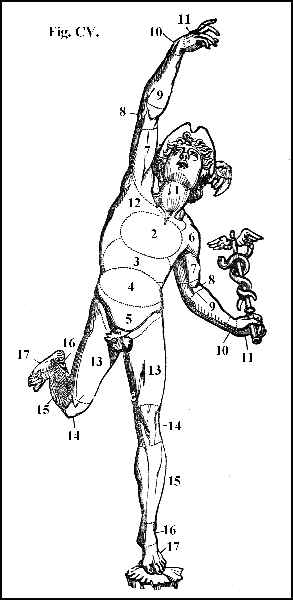
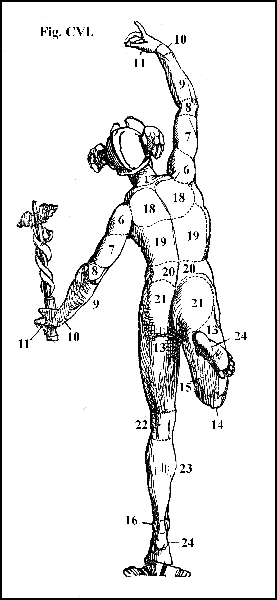
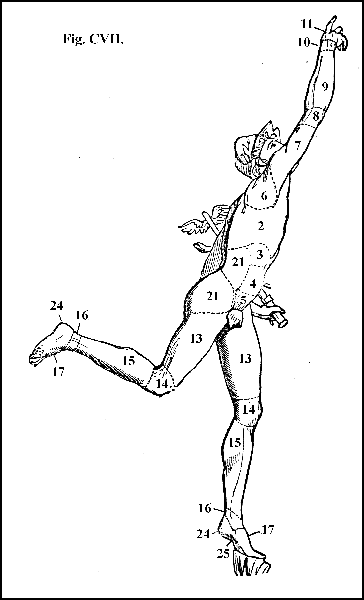
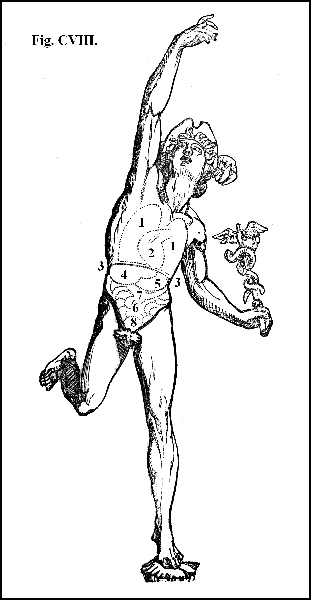
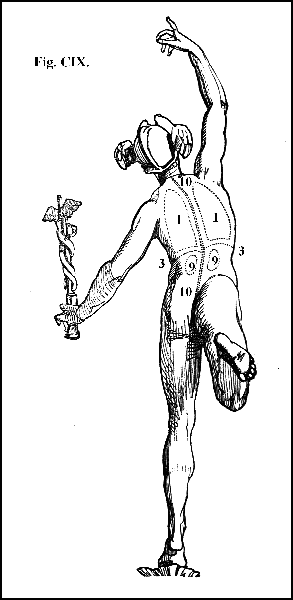

Physical characters of the blood: colour, fluidity, specific gravity, temperature: quantity—Process of coagulation—Constituents of the blood: proportions—Constituents of the body contained in the blood—Vital properties of the blood—Practical applications.
211. Supposing the human body to have been built up in the manner now described, and to be in the full exercise of all its functions, the integrity of its various structures is maintained, and their due action excited by the blood. Out of this substance is formed the blandest fluid, as the milk, and the firmest solid, as the compact bone. The heart, capable of untiring action, as long as the blood is in contact with its internal surface, becomes immovable soon after the supply of this fluid is withdrawn; and in less than one minute from the time it ceases to flow in due quantity and of proper quality through the vessels of the brain, the eye is no longer capable of seeing, nor the ear of hearing, nor the brain of carrying on any intellectual operation.
212. At the moment, and for some time after it has issued from its vessel, the appearance of the [Pg 335] blood is that of a thick, viscid, and tenacious fluid; yet it is essentially a solid, composed of several substances, each possessing its own distinct and peculiar properties, the relation and combination of which cannot be considered without exciting the feeling that our admiration of the structure of the animal frame ought not to be confined to the mechanism of its solid parts, but that the whole is admirable, from the common material of which it is composed, to its most delicate and elaborate instrument.
213. The colour of redness is universally associated with the idea of blood; but redness of colour is not essential to blood. There are many animals with true, yet without red, blood; and there is no animal in which the blood is red in all the parts of its body. The blood of the insect is transparent; that of the reptile is of a yellowish colour; that of the fish, in the greater part of its body, is colourless. Even the red blood of the human body is not equally red in every part of it, there being two distinct systems of blood-vessels, distinguished from each other by carrying blood of different colours.
214. In the state of health, the specific gravity of human blood, water being 1000, is 1080; from which standard it is capable of varying from 1120, the maximum, to 1026, the minimum.
215. The natural temperature of the human blood is 98°. From this it is capable of varying [Pg 336] from 104°, the maximum, to 86°, the minimum; these changes being always the effect of disease.
216. It is estimated that the fluids circulating in the adult man amount to about fifty pounds; of these it is calculated that twenty-eight consist of red blood.
217. Fluid and homogeneous as the blood appears while flowing in its vessel, when a mass of it is collected and allowed to stand at rest, it soon undergoes a very remarkable change. First, a thin film is formed upon its surface; this is followed by the conversion of the whole mass into a soft jelly: this jelly separates into two portions, a fluid and a solid portion. The solid portion again separates into two parts, into a substance of a yellowish-white colour, occupying the upper surface, and into a red mass always found at the under surface.
218. The process by which the constituents of the blood are thus spontaneously disunited, and afforded in a separate form, is denominated COAGULATION; the fluid portion separated by the process is termed the SERUM; the solid portion the COAGULUM or CLOT; the white substance forming the upper part of the clot, the FIBRIN; and the red mass forming the under part of it, the RED PARTICLES.
219. Probably the process of coagulation commences the moment the blood leaves its living vessel. In three minutes and a half it is visible to the eye; in seven minutes the mass is formed [Pg 337] into a jelly; in from ten to twelve minutes the serum separates from the clot; in about twenty the clot is divided into fibrin and red particles, when the coagulation is complete; but occasionally the clot continues to grow firmer and firmer for the space of twenty-four hours.
220. As soon as the coagulation commences, and during all the time the blood preserves its heat, an aqueous vapour arises from it, termed the HALITUS. The halitus consists of water holding in solution a small quantity of animal and saline matter, which communicate to it a fœtid odour of a strong and peculiar nature, manifest on approaching a slaughter-house, and still more manifest in the slaughter-house of human beings, a field of battle.
221. During the process of coagulation, as in every other in which a fluid is converted into a solid, caloric is evolved.
222. During the process of coagulation carbonic acid is also extricated.
223. The process of coagulation affords three distinct substances, the chief constituents of the blood, namely, serum, fibrin, and red particles.
224. The serum, the fluid portion of the blood, when obtained perfectly pure, is of a light straw colour, tinged with green. Its taste is saline, and its consistence adhesive. It is composed principally of water holding in solution animal and saline matter. The animal matter gives it its adhesive [Pg 338] consistence, and the saline its peculiar salt taste. The chief animal matter contained in it is the proximate principle termed albumen, which may be separated from the water that holds it in solution by the application of heat and by certain chemical agents. Heat being applied, when the temperature reaches 160°, fluid serum is converted into a white opaque solid substance of firm consistence. This is found to be albumen, which may be also separated from the watery portion by the application of spirits of wine, acids, oxymuriate of mercury, and several other chemical substances. The quantity of albumen contained in 1000 parts of serum varies from about 78, the maximum, to 58, the minimum.
225. If the albumen yielded by the serum be subjected to pressure, or be cut into small pieces, there flows from it a watery fluid which is termed the serosity. In meat dressed for the table, the serum of the blood contained in the blood-vessels is converted by the heat into solid albumen, from which, when cut, the serosity flows in the form of gravy.
226. Besides albumen, serum holds in solution both a fatty and an oily matter, in the proportion of about one part of each to 1000 parts of serum. The proportion of its saline substances is about ten in 1000 parts. According to M. le Canu, who has made the most recent chemical analysis of serum, 1000 parts contain, of
| Water | 906·00 |
| Albumen | 78·00 |
| Animal matter, soluble in water | |
| and alcohol | 1·69 |
| Albumen combined with soda | 2·10 |
| Crystallizable fatty matter | 1·20 |
| Oily matter | 1·00 |
| Hydrochlorate of soda and | |
| potash | 6·00 |
| Subcarbonate and phosphate of | |
| soda, and sulphate of potash | 2·10 |
| Phosphate of lime, magnesia, | |
| and iron, with subcarbonate | |
| of lime and magnesia | ·91 |
| Loss | 1·00 |
227. All the animal and saline matter held in solution in the serum being removed, the fluid that remains is water, the proportion of which in 1000 parts varies from 853, the maximum, to 779, the minimum.
228. The second constituent of the blood, the fibrin, is the most essential portion of it, being invariably present, whatever other constituent be absent. While circulating in the living vessel, fibrin is fluid and transparent; by the process of coagulation, it is converted into a solid and opaque substance of a yellowish white colour, consisting of stringy fibres, disposed in striæ, which occasionally form a complete net-work (fig. CXI.). These fibres are exceedingly elastic. In their [Pg 340] general aspect and their chemical relations they bear a close resemblance to pure muscular fibre, that is, to muscular fibre deprived of its enveloping membrane and of its colouring matter, and they form the basis of muscle. According to M. le Canu, the proportion of the fibrin varies from seven parts in 1000, the maximum, to one part in 1000, the minimum, the medium of twenty experiments being four parts in 1000.
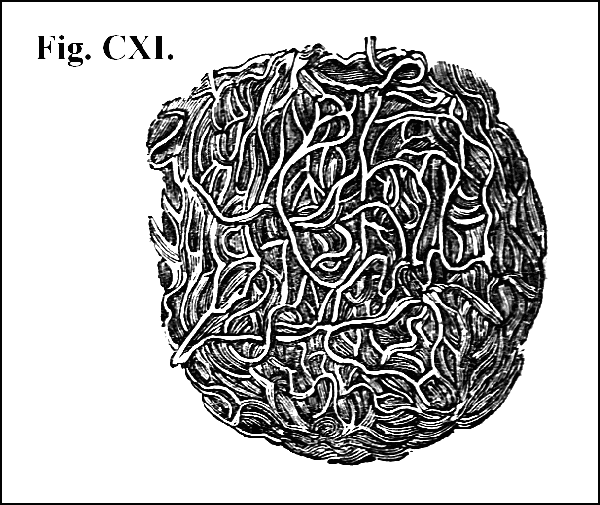
229. The third constituent of the blood, the matter upon which its red colour depends, though, as has been stated, entirely absent in certain classes of animals, and in all animals in some parts of their body, seems to be essential, at least to the organic organs, whenever they perform their functions with a high degree of perfection. Thus in the lowest class of vertebrated animals, the fish, [Pg 341] while the principal part of its body receives only a colourless fluid, its organic organs, as the heart, the gills, the liver, are provided with red blood.
230. The red matter, wherever present, is invariably heavier than the fibrin, and consequently, during the process of coagulation, it gradually subsides to the lower surface, and is always found forming the bottom of the clot. Its proportion to the other constituents varies very remarkably, the maximum being 148, the minimum 68, and the medium 108, in 1000 parts of blood.
231. All observers are agreed that the red matter of the blood consists of minute particles, having a peculiar and definite structure; but in regard to the nature of that structure, there is considerable diversity of opinion, which is not wonderful, since the particles in question are so minute that they can be distinguished only by the microscope, and since, of all microscopical objects, they are perhaps the most difficult to examine, because, being soft and yielding, their figure is apt to change, and because there is reason to suppose that their substance is not uniform in its refractive power.
232. The earlier observers describe the red particles as being of a globular figure, and accordingly name them globules. They conceive that each globule consists of a central solid particle, enveloped in a transparent vesicle. Recently, Sir Everard Home and Mr. Bauer in this country, and MM. Prevost and Dumas on the continent, have revived [Pg 342] this opinion, and describe the red particle as consisting of a central solid white corpuscle contained in an external envelop of a red colour. When the blood is observed with the microscope in a living animal, flowing in its vessels, only two substances can be distinguished, namely, a transparent fluid and the red corpuscles. MM. Prevost and Dumas contend that these two substances are the only component parts of the blood. When the blood coagulates, they conceive that the red envelop separates from the central white corpuscle; that these white corpuscles unite together; that the aggregates resulting from this combination are disposed in the form of filaments, which filaments constitute the fibrin, while the red matter at the bottom of the clot is nothing but the disintegrated envelops of the central particle. But this view is not the common one. In general, physiologists conceive the fibrin to be one constituent and the red particles to be another constituent of the blood. Mr. Lister, who has successfully laboured to improve the microscope, and who, together with his friend Dr. Hodgkin, have very carefully examined with their improved instrument the red particles, contend that the figure of these bodies is not globular, although they state that the instant the particles are removed from the living blood-vessels many things are capable of making them assume a globular appearance; such, for example, as the application of water. With a rapidity which, in [Pg 343] spite of every precaution, the eye in vain attempts to follow, the particles change their real figure for a globular form on the application of the smallest quantity of pure water; while, if the water contain a solution of saline matter, little alteration is occasioned in the figure of the particles. According to these observers, the red particles are flattened cakes, having rounded and very slightly thickened margins (fig. CXII. 1). The thickness of the margin gives to both surfaces the appearance of a slight depression in the middle (fig. CXII. 1), so that the particles bear a close resemblance to a penny piece. There is no appearance of an external envelop. The circular and flattened cake is transparent; when seen singly it is nearly if not quite colourless (fig. CXII. 1); it assumes a reddish tinge only when aggregated in considerable masses.
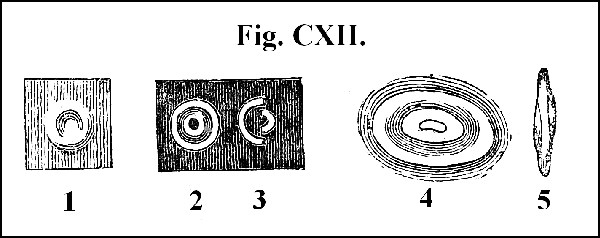
233. The red particle of the human blood is circular (fig. CXII. 1, 2, 3). [Pg 344] It is circular also in all animals belonging to the class mammalia; but in the three lower classes of vertebrated animals, the bird, the reptile, and the fish, it is elliptical (fig. CXII. 4, 5).
234. The magnitude of the red particle of the human blood is variously estimated from the two-thousandth to the six-thousandth part of an inch in diameter. Bauer estimates it at the two-thousandth, Hodgkin and Lister at the three-thousandth, Kater at the four-thousandth, Wollaston at the five-thousandth, and Young at the six-thousandth part of an inch. Its magnitude is uniformly the same in all individuals of the same species, but differs exceedingly in the different classes. The elliptical particles are larger than the circular, but proportionally thinner; larger in fishes than in any other class of animals, and largest of all in the skate.
235. When perfect and entire, the red particles indicate a disposition to arrange themselves in a definite mode. They combine spontaneously into columns of variable length (fig. CXIII.). In order to observe this tendency, a small quantity of blood, the moment it is taken from its living vessel, should be placed between two strips of glass or covered with a bit of talc and placed under the microscope. When thus arranged, a considerable agitation at first takes place among the particles. As soon as this motion subsides, the [Pg 345] particles apply themselves to each other by their broad surfaces, and thus form piles or columns of Considerable length (fig. CXIII.). The columns often again combine one among another, the end of one being attached to the side of another, sometimes producing very curious ramifications (fig. CXIII.). In like manner, the elliptical particles apply themselves to each other by their broad surfaces, but they are not so exactly matched as the circular, one particle partially overlapping another, so that they form less regular columns than the circular.
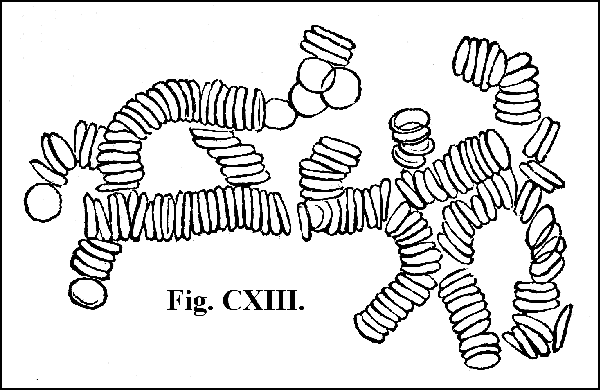
236. The red particles, as far as is known, constitute a distinct and peculiar form of animal matter: the red colour, according to some, depending on an impregnation of iron; according to others, on an animal substance of a gelatinous nature.
237. The exact proportion of the different substances [Pg 346] contained in the blood, according to the most recent analysis of it, that by M. le Canu, is as follows, namely,
| Water | 786·500 |
| Albumen | 69·415 |
| Fibrin | 3·565 |
| Colouring matter | 119·626 |
| Crystallizable fatty matter | 4·300 |
| Oily matter | 2·270 |
| Extractive matter, soluble in | |
| alcohol and water | 1·920 |
| Albumen combined with soda | 2·010 |
| Chloruret of sodium and potassium, | |
| alkaline phosphate, | |
| sulphate, and subcarbonates | 7·304 |
| Subcarbonate of lime and magnesia, | |
| phosphates of lime, | |
| magnesia and iron, peroxide | |
| of iron | 1·414 |
| Loss | 2·586 |
| ———— | |
| 1000· |
238. From the results of this analysis it is manifest that all the proximate principles of which the different tissues are composed exist in the blood, namely, albumen, the proximate principle forming the basis of membrane; fibrin, the proximate principle forming the basis of muscle; fatty matter, forming the basis of nerve and brain; and various [Pg 347] saline and mineral substances, forming a large part of bone, and entering more or less into the composition of every fluid and solid.
239. The blood, which contains all the proximate constituents of the body, and which, by distributing them to the various tissues and organs, maintains their integrity and life, is itself alive. The vitality of the blood is proved,—
240. i. By its undergoing the process of death, which it does just as much as the heart or the brain, every time it is removed from the body. While flowing in its living vessel, the blood is permanently fluid. Its fluidity depends on a force of mutual repulsion exerted by its particles on each other. That repulsive force is a vital endowment, probably derived from the organic nerves so abundantly distributed to the inner coat of the blood-vessels. When this vital influence is withdrawn, which happens on the removal of the blood from its vessel, the mass is no longer capable of remaining fluid; the fibrin is converted into a solid; the red particles, instead of repelling, attract each other, forming the crude aggregate at the bottom of the clot; coagulation is thus a process of death; its commencement indicates a diminution of the vital energy of the blood; during its progress that energy is constantly growing less and less; the blood is dying; and when complete, the blood is dead.
241. Hence in every state of the system in which the vital energy of the blood is preternaturally [Pg 348] increased, coagulation is proportionably slow; in every state in which its energy is diminished, coagulation is rapid. By copious and repeated blood-letting, the vital energy is rapidly exhausted. The effect of blood-letting on coagulation is determined by experiments instituted for the express purpose of ascertaining it. Blood was received from a horse at four periods, about a minute and a half intervening between the filling of each cup.
| Minutes. | Seconds. | |||
| In cup No. | 1. | coagulation began in | 11 | 10 |
| " | 2. | """ | 10 | 5 |
| " | 3. | """ | 9 | 55 |
| " | 4. | """ | 3 | 10 |
242. In like manner three cups were filled with the blood of a sheep, at the interval of half a minute.
| Minutes. | Seconds. | |||
| In cup No. | 1. | coagulation began in | 2 | 10 |
| " | 2. | """ | 1 | 45 |
| " | 3. | """ | 0 | 55 |
The same result was obtained in blood taken from a human subject. A pound and a half of blood was removed from the arm of a woman labouring under fever, a portion of which, received into a tea-cup on the first effusion, remained fluid for the space of seven minutes; a similar quantity, taken immediately before tying up the arm, was coagulated in three minutes thirty seconds. These experiments demonstrate that coagulation [Pg 349] is rapid or slow as the vital energy of the blood is exhausted or unexhausted, or that in proportion to the degree of life possessed by the blood is the space of time it takes in dying.
243. This result is referable to the principle already shown to be characteristic of living substance, —namely, the power of resisting, within a certain range, the ordinary influence of physical agents. The operation of this power is illustrated in a beautiful manner in a series of experiments performed by Mr. Hunter on the egg and on blood. This physiologist exposed a live, that is, a fresh egg to the temperature of the 17th and the 15th degrees of Fahrenheit; it took half an hour to freeze it. The egg was then thawed and exposed to 10° less cold, namely, to the 25th degree of Fahrenheit; it was now frozen in a quarter of an hour. A living egg and one that had been killed by having been first frozen and then thawed, were put together into a freezing mixture at 15°: the dead was frozen twenty-five minutes sooner than the living egg. The undiminished vitality of the fresh egg enabled it to resist the low temperature for the space of twenty-five minutes; the vitality of the frozen egg having been destroyed, it yielded at once to the influence of the physical agent. On subjecting blood to analogous experiments, the result was found to be the same. Blood immediately taken from the living vessel, and blood previously frozen and then thawed, being exposed [Pg 350] to a freezing mixture, a much shorter period and a much less degree of cold were required to freeze the latter than the former.
244. ii. The vitality of the blood is proved by the change it undergoes in becoming a constituent part of an organized tissue. The blood conveys to the several tissues the constituents of which they are composed; each tissue selects from the mass of blood its own constituents and converts them into its own substance, in which conversion, since the blood always goes to the tissue in a fluid form, the blood must necessarily pass from a fluid into a solid. In the vessels the vital endowment of the blood maintains it permanently fluid; in the structures the same power makes it and keeps it solid. One and the same substance in one and the same body, in one part is always fluid, in another always solid; the fluid is every moment passing into the solid and the solid into the fluid, without intermixture and without interference. Nothing analogous to this is ever witnessed in inorganic matter, in physical mechanism; it is peculiar to the organized body and distinctive of the mechanism of life. Sometimes in physical mechanism we can perceive the mechanical arrangements and distinctly trace them from beginning to end: in vital mechanism, even when we can discern the mechanical arrangements, we can seldom trace them beyond a step or two, and never from beginning to end; but arrangement and adaptation we [Pg 351] know there must be in that which goes beyond, no less than in that which keeps within, our perception, and we ought scarcely to question the existence of adjustments, because they elude our sense, when probably the very reason why they do so is that their delicacy and perfection immeasurably exceed any with which sense has made us acquainted.
245. iii. The vitality of the blood is proved by the process of organization. We can trace only a few steps of this process, but these are sufficient to establish the point in question. Blood effused from living vessels into the substance, or upon the surface of living organs, solidifies without losing vitality. If a clot of blood be examined some time after it has thus become solid, it is found to abound with blood-vessels. Some of these vessels are obviously derived from the surrounding living parts. The minute vessels of these parts, as can be distinctly traced, elongate and shoot into the clot. The clot thus acquires blood-vessels of its own. By degrees a complete circulation is established within it. The blood-vessels of the clot act upon the blood they receive just as the vessels of any other part act upon their blood, that is transform it into the animal matter it is their office to elaborate. In this manner a clot of blood is converted into a component part of the body, and acquires the power of exercising its own peculiar and appropriate functions in the economy.
246. But while, in this process, some of the vessels of the clot can be distinctly traced from the surrounding living parts, others appear to have no communication with those parts, at all events no such communication can be traced. These vessels, the origin of which cannot be found external to the clot, are supposed by some physiologists to be formed within it. Within the living egg, during incubation, certain motions or actions are observed spontaneously to arise, which terminate in the development of the chick. Analogous motions arising within the clot terminate, it is conceived, in the development of blood-vessels. According to this view, a simultaneous action takes place in the clot, and in the living part with which it is in contact; each shooting out vessels which elongate, approximate, unite, and thus establish a direct vital communication. Whether this view of the process of organization be the correct one or not does not affect the present argument. It is certain that a clot of blood surrounded by living parts becomes organized; it is certain that no dead substance surrounded by living parts becomes organized; it follows that the blood possesses life.
247. Health and life depend on the quantity, quality, and distribution of the blood. The chief source from which the blood itself is derived is the chyle: hence too much or too little food, or too great or too little activity of the organs that digest it, may render the quantity of the blood preternaturally [Pg 353] abundant or deficient; or though there be neither excess nor deficiency in the quantity of nourishment formed, parts of the blood which ought to be removed may be retained, or parts which ought to be retained may be removed, and hence the actual quantity in the system may be superabundant or insufficient.
248. The relative proportion of every constituent of the blood is capable of varying; and of course in the degree in which the healthy proportion is deranged, the quality of the mass must undergo a corresponding deterioration. The watery portion is sometimes so deficient, that the mass is obviously thickened; while at other times the fluid preponderates so much over the solid constituents, that the blood is thin and watery. The albumen, the quantity of which varies considerably even in health, in disease is sometimes twice as great, and at other times is less than half its natural proportion. In some cases the fibrin preponderates so much, that the coagulum formed by the blood is exceedingly coherent, firm and dense; in other cases the quantity of fibrin is so small, that the coagulation is imperfect, forming only a soft, loose and tender coagulum, and in extreme cases the blood remains wholly fluid. When the vital energy of the system is great, the red particles abound; when it is depressed, they are deficient. In the former state, they are of a bright red colour; in the latter, dusky, purple, or even black. When [Pg 354] the depression of the vital energy is extreme, the power of mutual repulsion exerted by the particles would seem to be so far destroyed as to admit of their adhering to each other partially in certain organs; while in other cases they seem to be actually disorganised, and to have their structures so broken up, that they escape from the current of the circulation as if dissolved in the serum, through the minute vessels intended only for the exhalation of the watery part of the blood. This fearful change is conceived to have an intimate connexion with a diminution of the proportion of the saline constituents. Out of the body, as has been shown, the red particles change their figure instantaneously, and are rapidly dissolved when in contact with pure water; while they undergo little change of form if the water hold saline matter in solution. It would seem that one use of the saline constituents of the blood is to preserve entire the figure and constitution of the red particles. It is certain that any change in the proportion of the saline constituents produces a most powerful effect on the condition of the red particles. It is no less certain that changes do take place in the proportion of the saline constituents. In the state of health, the taste of the blood is distinctly salt, depending chiefly on the quantity of muriate of soda contained in it. In certain violent and malignant diseases, such, for example, as the malignant forms of fever, and more especially that form of it termed pestilential [Pg 355] cholera, this salt taste is scarcely, if at all, perceptible; and it is ascertained that, in such cases, the proportion of saline matter is sensibly diminished.
249. The quality of the blood may be also essentially changed by the disturbance of the balance of certain organic functions: digestion, absorption, circulation, respiration, are indispensable to the formation of the blood and to the nourishment of the tissues. Absorption, nutrition, secretion, circulation, render the blood impure, either by directly communicating to it hurtful ingredients, or by allowing noxious matters to accumulate in it, or by destroying the relative proportion of its constituents. Organs are specially provided, the main function of which is to separate and remove from the blood these injurious substances. Organs of this class are called depurating, and the process they carry on is denominated that of depuration. The lungs, the liver, the kidneys, are depurating organs, and one result at least of the functions they perform is the purification or depuration of the blood. If the lung fail to eliminate carbon, the liver bile, the kidney urine, carbon, bile, urine, or at least the constituents of which these substances are composed, must accumulate in the blood, contaminate it, and render it incapable of duly nourishing and stimulating the organs.
250. But though the blood be good in quality and just in quantity, health and life must still [Pg 356] depend upon its proper distribution. It may be sent out to the system too rapidly or too slowly. It may be distributed to different portions of the system unequally; too much may be sent to one organ, and too little to another: consequently, while the latter languishes, the former may be oppressed, overwhelmed or stimulated to violent and destructive action. In either case health is disturbed and life endangered.
251. Of the mode and degree in which food, air, moisture, temperature, repletion, abstinence, exercise, indolence, influence the quantity, quality, and distribution of the blood; of the mode in which the condition of the blood modifies the actions both of the organic and the animal organs; of the reason why health and disease are wholly dependent on those states and actions, a clear and just conception may be formed when the several functions have been described, and the precise office of each is understood.
Vessels connected with the heart: chambers of the heart—Position of the heart—Pulmonic circle: systemic circle—Structure of the heart, artery, and vein—Consequences of the discovery of the circulation to the discoverer—Action of the heart: sounds occasioned by its different movements—Contraction: dilatation—Disposition and action of the valves—Powers that move the blood—Force of the heart—Action of the arterial tubes: the pulse: action of the capillaries: action of the veins—Self-moving power of the blood—Vital endowment of the capillaries: functions—Practical applications.
252. The blood, being necessary to nourish the tissues and to stimulate the organs, must be in motion in order to be borne to them. An apparatus is provided partly for the purpose of originating an impelling force to put the blood in motion, and partly for the purpose of conveying the blood when in motion to the different parts of the body.
253. The heart is the impelling organ; the great vessels in immediate connexion with it are the transmitting organs (fig. CXIV. 1, 2). The heart is divided into two sets of chambers (fig. CXIV. 3, 4, 10, 11), one for the reception of the blood from the different parts of the body (fig. CXIV. 3, 10); the other for the communication of the [Pg 358] impulse which keeps the blood in motion (fig. CXIV. 4, 11). The chamber which receives the blood is termed an auricle (fig. CXIV. 3, 10), and is connected with a vessel termed a vein (fig. CXIV. 1, 2, 9); that which communicates impulse to the blood is termed a ventricle (fig. CXIV. 4, 11), and is connected with a vessel termed an artery (fig. CXIV. 7, 12). The vein carries blood to the auricle; the auricle transmits it to the ventricle; the ventricle propels it into the artery; the artery, carrying it out from the ventricle, ultimately sends [Pg 359] it again into the vein, the vein returns it to the auricle, the auricle to the ventricle, the ventricle to the artery, and thus the blood is constantly moving in a circle; hence the name of the process, the circulation of the blood.
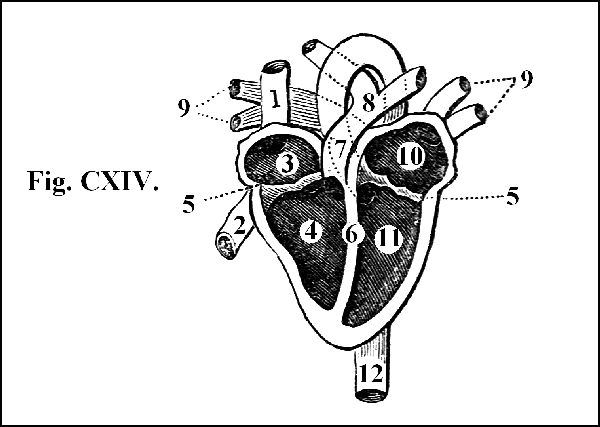
254. In nourishing the tissues and stimulating the organs, the blood parts with its nutritive and stimulating constituents, and receives in return some ingredients which can no longer be usefully employed in the economy, and others which are positively injurious. An apparatus is established for its renovation and depuration; this organ is termed the lung (fig. LIX. 5), and to this organ the blood must in like manner be conveyed. Thus the blood moves in a double circle, one from the heart to the body and from the body back to the heart, termed the systemic circle; the other from the heart to the lung and from the lung back to the heart, termed the pulmonic circle. Hence in the human body the heart is double, consisting of two corresponding parts precisely the same in name, in nature, and in office; the one appropriated to the greater, or the systemic, and the other to the lesser, or the pulmonic circulation (fig. CXIV.).
255. There is a complete separation between these two portions of the heart (fig. CXIV. 6), formed by a strong muscular partition which prevents any communication between them except through the medium of vessels.
256. The heart is situated between the two lungs (fig. LIX. 2, 5), in the lower and fore part of [Pg 360] the chest, nearly in the centre, but inclining a little to the left side. Its position is oblique (fig. LIX. 2, 5). Its basis is directed upwards, backwards, and towards the right (fig. LIX. 2); its apex is directed downwards, forwards, and towards the left, opposite to the interval between the cartilages of the fifth and sixth ribs (fig. LIX. 2). It is inclosed in a bag termed the pericardium (fig. CXV.), which consists of serous membrane. [Pg 361] The pericardium is considerably larger than the heart, allowing abundant space for the action of the organ (fig. CXV.). One part of the pericardium forms a bag around the heart (fig. CXV.); the other part is reflected upon the heart so as to form its external covering (fig. CXV.), and is continued for a considerable distance upon the great vessels that go to and from the heart in such a manner that this bag, like all the serous membranes, constitutes a shut sac. Both that portion of the pericardium which is reflected upon the heart, and that which forms the internal surface of the bag around it, is moistened during life by a serous fluid, which, after death, is condensed into a small quantity of transparent water. That portion of the pericardium which rests on the diaphragm (fig. LXX. 1) is so firmly attached to it that it cannot be separated without laceration, and by this attachment, together with the great vessels at its base, the heart is firmly held in its situation, although in the varied movements of the body it is capable of deviating to a slight extent from the exact position here described.

257. When the interior of the heart is laid open there are brought into view four chambers (fig. CXIV. 3, 4, 10, 11), two for each circle. Those belonging to the pulmonic circle are on the right (fig. CXIV. 3, 4), those to the systemic on the left side of the body (fig. CXIV. 10, 11); [Pg 362] hence the terms right and left are applied to these respective parts of the heart.
258. The veins which carry the blood to the right or the pulmonic chambers are two, one of which brings it from the upper, and the other from the lower parts of the body: the first is called the superior and the second the inferior vena cava (fig. CXIV. 1, 2). Both pour their blood into the first chamber, termed the right auricle (fig. CXIV. 3); from the right auricle the blood passes into the second chamber, denominated the right ventricle (fig. CXIV. 4): from which springs the artery which carries the blood from the heart to the lung, the pulmonary artery (fig. CXIV. 7). This is the pulmonic circle. From the lung the blood is returned to the heart by four veins, termed the pulmonary veins (fig. CXIV. 9), which pour the blood into the third chamber of the heart, the left auricle (fig. CXIV. 10). From the left auricle it passes into the fourth chamber, the left ventricle (fig. CXIV. 11), from which springs the artery which carries out the blood to the system, termed the aorta (figs. CXIV. 12, and CXVII. 11). This is the systemic circle. In the system the minute branches of the aorta unite with the minute branches that form the venæ cavæ, which return the blood to the right auricle of the heart, and thus the double circle is completed.
259. The two chambers called the auricles [Pg 363] occupy the basis of the heart (fig. CXIV. 3, 10). The right auricle is situated at the basis of the right ventricle (figs. CXIV. 3, and CXVI. 4). It [Pg 364] is partly membranous and partly muscular. At its upper and back part is the opening of the vena cava superior (fig. CXVI. 1), which returns the blood to the heart from the head, neck, and all the upper parts of the body. At its lower part is the opening of the vena cava inferior (fig. CXVI. 2), which returns the blood from all the lower parts of the body.
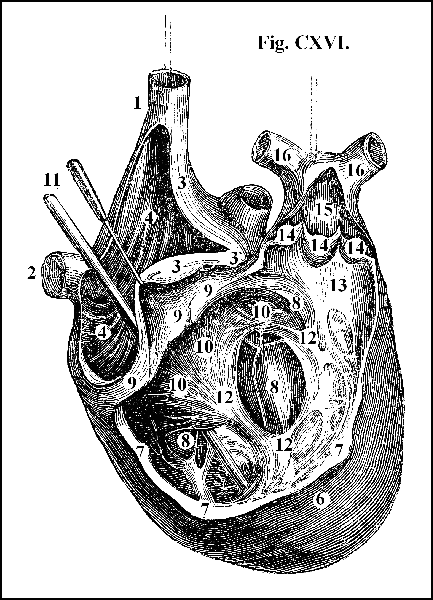
260. The auricle communicates with its corresponding ventricle by a large opening, termed the auricular orifice of the ventricle (figs. CXIV. 5, and CXVI. 9). All around the opening is placed a thin but strong membrane (fig. CXVI. 10), one margin of which is firmly attached to the wall of the ventricle (figs. CXIV. 5, and CXVI. 9), while the other is free (fig. CXVI. 10). This membrane receives the name, and, as will be seen immediately, performs the office of a valve.
261. The ventricle is much thicker and proportionally stronger than the auricle (fig. CXVI. 3, 6). It is composed almost entirely of muscular fibre. Over nearly the whole extent of its internal surface are placed irregular masses of muscular fibres, many of which stand out from the wall of the ventricle like columns or pillars (fig. CXVI. 12); hence they are called fleshy columns (columnæ carneæ). Some of these fleshy columns are adherent by one extremity to the wall of the ventricle, while the other extremity terminates in tendinous threads which are attached to the membrane that forms the valve (fig. CXVI. 12).
262. From the upper and right side of this chamber springs the pulmonary artery (fig. CXVI. 15); at the entrance of which are placed three membranes of a crescent or semilunar shape, termed the semilunar valves (fig. CXVI. 14).
263. The structure of the left side of the heart is perfectly analogous to that of the right. Its auricle, like that on the left side, is placed at the base of the ventricle (figs. CXIV. 10, and CXVII. 2), and like it also is thin, being composed chiefly of membrane. At its upper and back part (figs. CXIV. 9, and CXVII. 1) are the openings of the four pulmonary veins, two from the right, and two from the left lung.
264. At the passage of communication between the left auricle and ventricle is placed a valve analogous to that on the right side (fig. CXVII. 7).

265. The walls of the left ventricle are nearly as thick again as those of the right, and its fleshy columns are much larger and stronger. From the upper and back part of this fourth chamber (fig. CXVII. 11) springs the great systemic artery, the aorta, around the mouth of which are placed three semilunar valves (fig. CXVII. 12), similar to those at the mouth of the pulmonary artery.
266. The partition which divides the two sets of chambers from each other (fig. CXIV. 6) is wholly composed of muscular fibres, and is called the septum of the heart.
267. The external surface of the heart is covered by a thin but strong membrane continued over it from the pericardium. Between this membranous covering and its fleshy substance is lodged, even when the body is reduced to the greatest degree of thinness, a quantity of fat. Immediately beneath this fat are the fleshy fibres that compose the main bulk of the organ. These fibres are arranged in a peculiar manner. The arrangement is not perceptible when the heart is examined in its natural state, but after it has been subjected to long-continued boiling, which, besides separating extraneous matters from the fibres, hardens and loosens without displacing them, the manner in which they are disposed is manifest. Just at the point where the muscular fibres that constitute the septum of the auricles are set upon those which form the septum of the ventricles, and parallel with the origin of the [Pg 368] aorta, the heart is not muscular but tendinous. The substance called tendon, it has been shown, is often employed in the body to afford origin or insertion to muscular fibres, performing, in fact, the ordinary office of bone, and substituted for it in situations where bone would be inconvenient. From the tendinous matter just indicated most of the fibres that constitute the muscular walls of the heart take their origin. From this point the fibres proceed in different directions: those which go to form the wall of the auricles ascend; those which form the wall of the ventricles pursue an oblique course downwards, and the arrangement of the whole is such, that a general contraction of the fibres must necessarily bring all the parts of the heart towards this central tendinous point. The object and the result of this arrangement will be manifest immediately.
268. The internal surface of the chambers of the heart, in its whole extent, is lined by a fine transparent serous membrane, which renders it smooth and moist; and, like all other organs which have important functions to perform, it is plentifully supplied with blood-vessels and nerves.
269. Such is the structure of the organ that moves the blood. The artery, the tube that carries it out from the heart, is a vessel composed of three distinct layers of membrane superimposed one upon another, and intimately united by delicate cellular tissue. These layers are termed [Pg 369] tunics or coats. The external coat (fig. CXVIII. 3), which is also called the cellular, consists of minute whitish fibres, which are dense and tough, and closely interlaced together in every direction. They form a membrane of great strength, the elasticity of which, especially in the longitudinal direction, is such that, in addition to its other names, it has received that of the elastic coat.

270. The middle or the fibrous tunic is composed of yellowish flattened fibres which pass in an oblique direction around the calibre of the vessel, forming segments of circles, which, uniting, produce complete rings (fig. CXVIII. 2). This tunic is thick, consisting of several layers of fibres which it is easy to peel off in succession. They form a firm, solid, elastic, but, at the same time, brittle membrane.
271. The inner tunic, thin, colourless, nearly transparent, and perfectly smooth, is moistened by a serous fluid, and is thence called the serous coat (fig. CXVIII. 1). To the naked eye it presents no appearance of fibres, yet notwithstanding its extreme delicacy, it is so strong that, after the other coats of the artery have been entirely removed in a living animal, it is capable of resisting the impetus of the circulation, and of preventing the dilatation of the artery. The arteries themselves are supplied with arteries, vessels that nourish their tissues, and which are sent to them from neighbouring branches, seldom or never from the vessel itself to which they are distributed. Each individual part of an artery is supplied by its own appropriate vessels, which form but few communications above and below, so that if care be not taken in surgical operations to disturb these nutrient arteries very little, the vessel will perish for want of sustenance.
272. The vein, the tube that carries back the blood to the heart, is composed of the same number of tunics as the artery, which, with the exception of the middle, are essentially the same in structure, but they are all much thinner. The external tunic consists of a less dense and strong cellular membrane; the middle tunic, instead of being formed of elastic rings, is composed of soft and yielding fibres, disposed in a longitudinal direction; while the inner coat, which is still more delicate [Pg 371] than that of the artery, is arranged in a peculiar manner. The inner coat of most veins, at slight intervals, is formed into folds (fig. CXX. 5), one margin of which is firmly adherent to the circumference of the vessel, while the other margin is free and turned in the direction of the heart. These membranous folds are termed valves. In all veins the diameter of which is less than a line the valves are single; in most veins of greater magnitude they are placed in pairs, while in some of the larger trunks they are triple, and in a few instances quadruple, and even quintuple. The veins, like the arteries, are supplied with nutrient vessels and nerves.
273. All the arteries of the body proceed from
the two trunks already described; that connected
with the pulmonic circle, the pulmonary artery, and
that connected with the systemic circle, the aorta.
These vessels, as they go out from the heart and
proceed to their ultimate termination, are arborescent,
that is, they successively increase in number
and diminish in size, like the branches of a tree
going off from the trunk (fig. CXIX. 1, 2, 3).
Each trunk usually ends by dividing into two or
more branches (fig. CXIX. 1, 2), the combined
area of which is always greater than that of the
trunk from which they spring, in the proportion
of about one and a half to one. As the branch
proceeds to its ultimate termination it divides and
subdivides, until at length the vessel becomes so
[Pg 372]
[Pg 373]minute, that it can no longer be distinguished
by the eye. These ultimate branches are called
capillary vessels, from their hair-like smallness
(fig. CXIX. 4); but this term does not adequately
express their minuteness. It has been stated
(234) that the red particle of the blood, at the
medium calculation, is not more than the three-thousandth
part of an inch in diameter; yet vast
numbers of the capillary vessels are so small that
they are incapable of admitting one of these particles,
and receive only the colourless portion of
the blood.
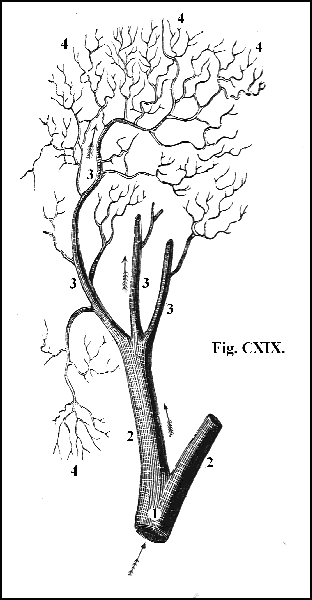
274. Every portion of an artery, by reason of the elasticity of its coats, preserves nearly a cylindrical form, and as the area of the branches is greater than that of the trunks, the blood, in proceeding from the heart to the capillaries, though passing through a series of descending cylinders, is really flowing through an enlarging space.
275. The disposition of the veins, like that of the arteries, is arborescent, but in an inverse order; for the course of the veins is from capillary vessels to visible branches, and from visible branches to large trunks (fig. CXX. 1, 2, 3). In every part of the body where the capillary arteries terminate the capillary veins begin, and the branches uniting to form trunks, and the small to form large trunks, and the trunks always advancing towards the heart, and always increasing in magnitude as they approach it, form at length the two veins which it [Pg 374] has been stated (258) return all the blood of the body to the right auricle of the heart.
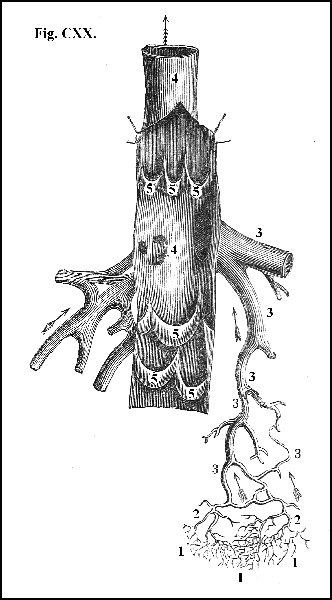
276. The veins are very much more numerous than the arteries, for they often consist of double sets, and they are at the same time more capacious and more extensible. Reckoning the whole of the blood at one-fifth of the weight of the body, it is estimated that, of this quantity, about one-fourth is in the arterial and the remaining three-fourths in the venous system. The combined area of the branches of the veins is much greater than that of the two trunks in which they terminate (fig. CXX. 1, 2, 3, 4): the blood, therefore, in returning to the heart, is always flowing from a large into a smaller space.
277. The divisions and subdivisions of the artery freely communicate in all parts of the body by means of what are called anastomosing branches, and this communication of branch with branch and trunk with trunk is termed anastomosis. The same intercommunication, but with still greater freedom and frequency, takes place among the branches of veins. In both orders of vessels the communication is frequent in proportion to the minuteness of the branch and its distance from [Pg 376] the heart. It is also more frequent in proportion as a part is exposed to pressure; hence the minute arteries and veins about a joint are distinguished for the multitude of their anastomosing branches; and above all, it is frequent in proportion to the importance of the organ; hence the most remarkable anastomosis in the body is in the brain. By this provision care is taken that no part be deprived of its supply of blood; for if one channel be blocked up, a hundred more are open to the current, and the transmission of it to any particular region or organ by two or more channels, instead of through one trunk, is a part of the same provision. Thus the fore-arm possesses four principal arteries with corresponding veins, and the brain receives its blood through four totally independent canals[6].
278. That the blood is really a flowing stream, and that it pursues the course described (258), is indubitable. For,
(1.) With the microscope, in the transparent parts of animals, the blood can be seen in motion (fig. CXXI.); and if its course be attentively observed, its route may be clearly traced.
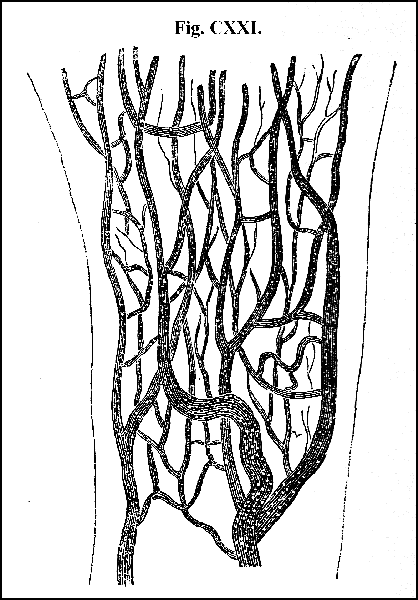
(2.) The membranes termed valves are so placed as to allow of the freest passage to the blood in the circle described, while they either altogether prevent or exceedingly impede its movement in any other direction.
(3.) The effect of a ligature placed around a vein and an artery, and of a puncture made above the ligature in the one vessel and below it in the other, demonstrate both the motion of the blood and the course of it. When a ligature is placed around a vein, that part of the vessel which is most distant from the heart becomes full and turgid on account of the accumulation of blood in it; while the part of the vessel which is between the ligature and the heart becomes empty and [Pg 378]flaccid, because it has carried on its contents to the heart, and it can receive no fresh supply from the body. When, on the contrary, a ligature is placed around an artery, that portion of the vessel which lies between the ligature and the heart becomes full and turgid, and the other portion [Pg 379] empty and flaccid. This can only be because the contents of the two vessels move in opposite directions,—from the heart to the artery, from the artery to the vein, and from the vein to the heart. At the same time, if the vein be punctured above the ligature, there will be little or no loss of blood; while if it be punctured below the ligature, the blood will continue to flow until the loss of it occasions death, which could not be unless the blood were in motion, nor unless the direction of its course were from the artery to the vein and from the vein to the heart.
(4.) If fluids be injected into the veins or arteries, whether of the dead or of the living body, they readily make their way and fill the vessels, if thrown in the direction stated to be the natural course of the circulation; but they are strongly resisted if forced in the opposite direction.
279. Such is the description, and with the exception of the first proof, such the evidence of the circulation of the blood in the human body, pretty much as it was given by the discoverer of it, the illustrious Harvey. Before the time of Harvey, a vague and indistinct conception that the blood was not without motion in the body had been formed by several anatomists. It is analogous to the ordinary mode in which the human mind arrives at discovery (chap. iii., p. 103), that many minds should have an imperfect perception of an unknown truth, before some one mind sees it in its completeness [Pg 380] and fully discloses it. Having, about the year 1620, succeeded in completely tracing the circle in which the blood moves, and having at that time collected all the evidence of the fact, with a rare degree of philosophical forbearance, Harvey still spent no less than eight years in re-examining the subject, and in maturing the proof of every point, before he ventured to speak of it in public. The brief tract which at length he published was written with extreme simplicity, clearness, and perspicuity, and has been justly characterised as one of the most admirable examples of a series of arguments deduced from observation and experiment that ever appeared on any subject.
280. Cotemporaries are seldom grateful to discoverers. More than one instance is on record in which a man has injured his fortune and lost his happiness through the elucidation and establishment of a truth which has given him immortality. It may be that there are physical truths yet to be brought to light, to say nothing of new applications of old truths, which, if they could be announced and demonstrated to-day, would be the ruin of the discoverer. It is certain that there are moral truths to be discovered, expounded, and enforced, which, if any man had now penetration enough to see them, and courage enough to express them, would cause him to be regarded by the present generation with horror and detestation. Perhaps, during those eight years of re-examination, [Pg 381] the discoverer of the circulation sometimes endeavoured in imagination to trace the effect which the stupendous fact at the knowledge of which he had arrived would have on the progress of his favourite science; and, it may be, the hope and the expectation occasionally arose that the inestimable benefit he was about to confer on his fellow men would secure to him some portion of their esteem and confidence. What must have been his disappointment when he found, after the publication of his tract, that the little practice he had had as a physician, by degrees fell off. He was too speculative, too theoretical, not practical. Such was the view taken even by his friends. His enemies saw in his tract nothing but indications of a presumptuous mind that dared to call in question the revered authority of the ancients; and some of them saw, moreover, indications of a malignant mind, that conceived and defended doctrines which, if not checked, would undermine the very foundations of morality and religion. When the evidence of the truth became irresistible, then these persons suddenly turned round and said, that it was all known before, and that the sole merit of this vaunted discoverer consisted in having circulated the circulation. The pun was not fatal to the future fame of this truly great man, nor even to the gradual though slow return of the public confidence even during his own time; for he lived to attain the summit of reputation.
281. It is then indubitably established that the whole blood of the body in successive streams is collected and concentrated at the heart. The object of the accumulation of a certain mass of it at this organ is to subject it to the action of a strong muscle, and thereby to determine its transmission with adequate force and precision through the different sets of capillary vessels.
282. In the accomplishment of this object the heart performs a twofold action; that of contraction and that of dilatation. The auricles contract and thereby diminish their cavities, then dilate and thereby expand them, and the one action alternates with the other. There is the like alternate contraction and dilatation of the ventricles. The first action is termed systole, the second diastole, and both are performed with force.
283. When the heart is laid open to view in a living animal, and its movements are carefully observed, it is apparent that the two auricles contract together; that the two ventricles contract together; that these motions alternate with each other, and that they proceed in regular succession. The interval between these alternate movements is, however, exceedingly short, and can scarcely be perceived when the heart is acting with full vigour; but it is evident when its action is somewhat languid.
284. When the ventricles contract, the apex of the heart is drawn upwards, and at the same time [Pg 383] raised or tilted forwards. It is during this systole of the ventricles, and in consequence of this result of their action, that the apex of the heart gives that impulse against the walls of the chest which is felt in the natural state between the fifth and sixth ribs, and which just perceptibly precedes the pulse at the wrist.
285. When the ear is applied to the human chest, over the situation of the heart, a dull and somewhat prolonged sound is heard, which precedes and accompanies the impulse of the heart against the chest. This dull sound is immediately succeeded by a shorter and sharper sound: after this there is a short pause; and then the dull sound and impulse are again renewed. The duller sound and stronger impulse are ascribed to the contraction of the ventricles, and the sharper sound and feebler impulse to that of the auricles.
286. The movement of the heart is effected by the contraction of its muscular fibres. Those fibres rest, as upon a firm support, on the tendinous matter to which they are attached, from which they diverge, and towards which their contraction must necessarily bring all the parts of the heart (267). The result of their contraction is the powerful compression of all the chambers of the heart, and thereby the forcible ejection of their contents through the natural openings.
287. But the chambers, alternately with forcible contraction, perform the action of forcible dilatation. [Pg 384] This movement of dilatation is effected by the reaction of the elasticity of the tendinous matter on which the muscular fibres are supported (267). This highly elastic substance, by the contraction of the fibres, is brought into a state of extreme tension. The contraction of the fibres ceasing, that moment the tense tendon recoils with a force exactly proportionate to the degree of tension into which it had been brought. Thus the very agent that is employed forcibly to close the chamber is made the main instrument of securing its instantaneous re-opening. A vital energy is appointed to accomplish what is indispensable, and what nothing else can effect, the origination of a motive power; a physical agent is conjoined to perform the easier task to which it is competent; and the two powers, the vital and the physical, work in harmony, each acting alternately, and each, with undeviating regularity and unfailing energy, fulfilling its appropriate office.
288. When the chambers of the heart which open into each other, and which as freely communicate with the great vessels that enter and proceed from them, are forcibly closed, and the blood they contain is projected from them, how is one uniform forward direction given to the current? Why, when the right ventricle contracts, is the blood not sent back into the right auricle, as well as forward into the pulmonary artery? There is but one mode of preventing such an event, which is to place a flood-gate [Pg 385] between the two chambers; and there a flood-gate is placed, and that flood-gate is the valve. As long as the blood proceeds onwards in the direct course of the circulation, it presses this membrane close to the side of the heart, and thereby prevents it from occasioning any impediment to the current. When, on the contrary, the blood is forced backwards, and attempts to re-enter the auricle, being of course driven in all directions, some of it passes between the wall of the ventricle and the valve. The moment it is in this situation it raises up the valve, carries it over the mouth of the passage, and shuts up the channel. There cannot be a more perfect flood-gate.
289. This is beautiful mechanism; but there is another arrangement which surpasses mere mechanism, however beautiful. It has been shown (260) that one edge of the membrane that forms the valve is firmly adherent to the wall of the ventricle, while the other edge, when not in action, appears to lie loosely in the ventricle (fig. CXVI. 10). Were this edge really loose the refluent current would carry it back completely into the auricle, and so counteract its action as a valve; but it is attached to the tendinous threads proceeding from the fleshy columns that stand along the wall of the ventricle (fig. CXVI. 12). By these tendinous threads, as by so many strings, the membrane is firmly held in its proper position (fig. CXVI. 10, 12); and the refluent current [Pg 386] cannot carry it into the auricle. Thus far the arrangement is mechanical. But each of these fleshy columns is a muscle, exerting a proper muscular action. Among the stimulants which excite the contractility of the muscular fibre, one of the most powerful is distension. The refluent current distends the membrane; the distension of the membrane stretches the tendinous threads attached to it; the stretching of its tendinous threads stretches the fleshy column; by this distension of the column it is excited to contraction; by the contraction of the column its thread is shortened; by the shortening of the thread the valve is tightened, and that in the exact degree in which the thread is shortened. So, the greater the impetus of the refluent blood, the greater the distension of the membrane; and the greater the distension of the membrane, the greater the excitement of the fleshy column; the greater the energy with which it is stimulated to act, the greater, therefore, the security that the valve will be held just in the position that is required, with exactly the force that is needed. Here, then, is a flood-gate not only well constructed as far as regards the mechanical arrangement, but so endowed as to be able to act with additional force whenever additional force is requisite; to put forth on every occasion, as the occasion arises, just the degree of strength required, and no more.
290. The contraction of the heart is the power that moves the blood; and this contraction generates [Pg 387] a force which is adequate to impel it through the circle. From experiments performed by Dr. Hales it appears that if the artery of a large animal, such as the horse, be made to communicate with an upright tube, the blood will ascend in the tube to the height of about ten feet above the level of the heart, and will afterwards continue there rising and falling a few inches with each pulsation of the heart. In this animal, then, the heart acts with a force capable of maintaining a column of ten feet. Now a column of ten feet indicates a pressure of about four pounds and a half in a square inch of surface. Suppose the human heart to be capable of supporting a column of blood eight feet high, this will indicate a pressure of four pounds to the square inch; but the left ventricle of the heart, while it injects its column of blood into the aorta, has to overcome the inertia of the quantity of blood projected; of the mass already in the artery, and of the elasticity of the vessel yielding to a momentary increase of pressure: it is probable, therefore, that the heart acts with a force of six pounds on the inch. The left ventricle, when distended, has about ten square inches of internal surface; consequently the whole force exerted by it may be about sixty pounds. According to the calculation of Hales, it is fifty-one and a half. Now, it is proved by numerous experiments, that, after death, a slight impulse with the syringe, certainly much less than that which is acting upon the blood in the same [Pg 388] artery during life, is sufficient to propel a solution of indigo, or fresh drawn blood, from a large artery into the extreme capillary. If, therefore, after death, a slight force will fill the capillaries, a force during life equal to sixty pounds must be adequate to do so.
291. The heart, with a force equal to the pressure of sixty pounds, propels into the artery two ounces of blood at every contraction. It contracts four thousand times in an hour. There passes through the heart, therefore, every hour, eight thousand ounces or seven hundred pounds of blood. It has been stated (216) that the whole mass of blood in an adult is about twenty-eight pounds: on an average the entire circulation is completed in two minutes and a half; consequently a quantity of blood equal to the whole mass passes through the heart from twenty to twenty-four times in an hour. But though the average space of time requisite to accomplish a complete circulation may be two minutes and a half, yet when a stream of blood leaves the heart, different portions of it must finish their circle at very different periods, depending in part upon the length of the course which they have to go, and in part upon the degree of resistance that obstructs their passage. A part of the stream, it is obvious, finishes its course in circulating through the heart itself; another portion takes a longer circuit through the chest; another extends the circle round the head; and [Pg 389] another visits the part placed at the remotest distance from the central moving power. Such is the velocity with which the current sometimes goes, that, in the horse, a fluid injected into the great vein of the neck, on one side, has been detected in the vein on the opposite side, and even in the vein of the foot, within half a minute.
292. It has been shown (282) that the different chambers of the heart have a tendency to perform their movements in a uniform manner, and in a successive order; that they contract and dilate in regular alternation, and at equal intervals; but, moreover, they continue these movements equally without rest and without fatigue. On go the motions, night and day, for eighty years together, at the rate of a hundred thousand strokes every twenty-four hours, alike without disorder, cessation, or weariness. The muscles of the arm tire after an hour's exertion, are exhausted after a day's labour, and can by no effort be made to work beyond a certain period. There is no appreciable difference between the muscular substance of the heart and that of the arm. It is true that the heart is placed under one condition which is peculiar. Muscles contract on the application of stimuli; and different muscles are obedient to different stimuli,—the voluntary muscles to the stimulus of volition, and the heart to that of the blood. The exertion of volition is not constant, but occasional; the muscle acts only when it is excited [Pg 390] by the application of its stimulus: hence the voluntary muscle has considerable intervals of rest. The blood, on the contrary, is conveyed to the heart without ceasing, in a determinate manner, in a successive order; and this is the reason why through life its action is uniform: it uniformly receives a due supply of its appropriate stimulus. But why it is unwearied, why it never requires rest, we do not know. We know the necessities of the system which render it indispensable that it should be capable of untiring action, for we know that the first hour of its repose would be the last of life; but of the mode in which this wonderful endowment is communicated, or of the relations upon which it is dependent, we are wholly ignorant.
293. The force exerted by the heart is vital. It is distinguished from mechanical force in being produced by the very engine that exerts it. In the best-constructed machinery there is no real generation of power. There is merely concentration and direction of it. In the recoil of the spring, in the reaction of condensed steam, the energy of the expansive impulse is never greater than the force employed to compress or condense, and the moment this power is expended all capacity of motion is at an end. But the heart produces a force equal to the pressure of sixty pounds by the gentlest application of a bland fluid. Here no force is communicated to be again given [Pg 391] out, as in every mechanical moving power; but it is new power, power really and properly generated; and this power is the result of vital action, and is never in any case the result of action that is not vital.
294. The heart projects the blood with a given force into the arterial tubes. The arteries in the living body are always filled to distension, and somewhat beyond it, by the quantity of blood that is in them. It has been shown that the elasticity of their coats is such as to give to them, even after death, the form of open hollow cylinders (274). During life they are kept in a state of distension by the quantity of blood they contain. By virtue of their elasticity they react upon their contents with a force exactly proportioned to the degree of their distension, that is, with a force at least adequate to keep them always open and rigid.
295. These open and rigid tubes, already filled to distension, and somewhat beyond it, receive at every contraction of the heart a forcible injection of a new wave of blood. The first effect of the injection of this new wave into a tube previously full to distension, is to cause the current to proceed by jerks or jets, each jerk or jet corresponding to the contraction of the heart. And, accordingly, by this jet-like motion, the flow of the blood in the artery is distinguished from that in the vein, in which latter vessel the current is an equal and tranquil stream.
296. The second effect of this new wave is to occasion some further distension of the already distended artery, and accordingly, when the vessel is exposed in a living animal, and its action carefully observed, a slight augmentation of its diameter is distinguishable at every contraction of the heart. This new wave while it distends must at the same time slightly elongate the vessel; cause its straight portions to bend a little, and its curved portions to bend still more; and, consequently, in some situations, to lift it a little from its place, giving it a slight degree of locomotion;—and these two causes combined produce the pulse. When the finger is pressed gently on an artery, at the instant of the contraction of the heart, the vessel is felt to bound against the finger with a certain degree of force: this, as just stated, is owing to a slight distension of the vessel by the new wave of blood, together with a slight elongation of it, and a gentle rising from its situation.
297. The blood, in flowing through the arterial trunks and branches to the capillaries, through the arterial to the venous capillaries, and through the venous branches and trunks back to the heart, is exposed to numerous and powerful causes of retardation: such, for example, as the friction between the blood and the sides of the vessels, the numerous curves and angles formed by the branches in springing from the trunks, the tortuous course of the vessels in many parts of the body, and the [Pg 393] increasing area of the arterial branches as they multiply and subdivide. Yet the extraordinary fact has been recently discovered, that the blood moves with the same momentum or force in every part of the arterial system, in the aorta, in the artery in the neck which carries the blood to the head (the carotid artery), in the artery of the arm (the humeral artery), in the artery of the lower extremity (the femoral artery); in a word, in the minute and remote capillary, and in the large trunk near the heart. Having contrived an instrument by which the force of the blood as it flows in its vessel could be accurately indicated by the rise of mercury in a tube, M. Poiseuille found that the elevation of the mercury is uniformly the same in the different arteries of the same animal, whatever the size of the artery and its distance from the heart. This tube was inserted, for example, into the common carotid artery of a horse: the diameter of the vessel was 34/100ths of an inch; its distance from the heart was thirty-nine inches; the height to which the mercury rose in the graduated tube was accurately marked. The tube was then inserted into a muscular branch of the artery in the thigh: the diameter of this vessel was 7/100ths of an inch, and its distance from the heart 67½ inches. According to the mean of nine observations, the mercury rose in both tubes to precisely the same elevation. Here is another instance of the beautiful adjustments everywhere established [Pg 394] in the living economy. The blood is sent by a living engine, moving under laws peculiar to the state of life, into living vessels, which in their turn acting under laws peculiar to the state of life, so accommodate themselves to the current as absolutely to offer no resistance to its progress; so accommodate themselves to the moving power, as completely and everywhere to obviate the physical impediments to motion inseparable from inorganic matter.
298. That the arterial tubes do possess and exert a truly vital power, modifying the current of the blood they contain, is indubitably established.
1. If in a living animal the trunk of an artery be laid bare, the mere exposure of it to the atmospheric air causes it to contract to such a degree, that its size becomes obviously and strikingly diminished. This can result only from the exertion of a vital property, for no dead tube is capable in such a manner of diminishing its diameter.
2. If during life an artery be opened and the animal be largely bled, the arteries become progressively smaller and smaller as the quantity of blood in the body diminishes. If the bleeding be continued until the animal dies, and the arteries of the system be immediately examined, they are found to be reduced to a very small size; if again examined some time after death, they are found to have become larger, and they go on growing successively larger and larger until they regain nearly [Pg 395] their original magnitude, which they retain until they are decomposed by putrefaction.
3. M. Poiseuille distended with water the artery of an animal just killed. This water was urged by the pressure of a given column of mercury. The force of the reaction of the artery was now measured by the height of a column of mercury which the water expelled from the artery could support. It was found that the artery reacted with a force greater than that employed to distend it, and greater than the same artery could exert some time after death; but since mechanical reaction can never be greater than the force previously exerted upon it (293), it follows that the excess of the reaction indicated in this case was vital.
4. If an artery be exposed and a mechanical or chemical stimulus be applied to it, its diameter is altered, sometimes becoming larger and sometimes smaller, according to the kind of agent employed.
299. Any one of these facts, taken by itself, affords a demonstration that the arterial trunks and branches are capable of enlarging and diminishing their diameter by virtue of a vital endowment. There is complete evidence that the exertion of this vital power on the part of the arterial trunk is not to communicate to the blood the smallest impulsive force; the engine constructed for the express purpose of working the current generates all the force that is required; but the labour of the engine is economized by imparting [Pg 396] to the tubes that receive the stream a vital property, by which they wholly remove the physical obstructions to its motion.
300. Driven by the heart through the arterial branches into the capillaries, the blood courses along these minute vessels urged by the same power. The most careful observers, from Haller and Spalanzani down to the present time, concur in stating that the pulsatory movement communicated by the heart to the blood in the great arteries is distinctly visible under the microscope in the capillaries. "I have often observed in frogs and tadpoles, and once in the bat," says Wedemeyer, "that when the circulation was becoming feeble, the blood in the finest capillaries advanced by jerks, corresponding with the contractions of the heart. I remarked the same appearance in the fine veins several times in the toad and tadpole, and once in the frog." If an experimenter so dispose the circulation of the limb of an animal that the flow of blood be confined to the branches of a single artery, and a corresponding vein, it is found that the blood stagnates in the vein whenever the current in the artery is stopped by a ligature, but no sooner is the ligature removed from the artery, than the blood begins again to flow freely along the vein, the capillaries of the artery which have to send on the current to those of the vein being now again within the influence of the heart. And if the impulse of the heart be removed from the [Pg 397] capillary system, by placing a ligature around the aorta, the capillary circulation is uniformly and completely stopped.
301. It was found by Dr. Hales, that, under ordinary circumstances, the blood rises in a tube connected with a vein to the height only of six inches, while it has been shown (290) that in the artery it ascends as high as ten feet. This prodigious difference between the venous and the arterial tension led to the conclusion that the impulsive force of the heart was all but exhausted before the blood reached the veins, and set physiologists on the search for other powers to carry on the venous circulation. It was overlooked that the blood has an open and ready escape from the great trunks of the veins through the right chambers of the heart, and that in consequence of this free escape of their fluid, these vessels indicate no greater tension than is just sufficient to lift the blood to the heart, and to overcome friction[7]. M. Magendie having laid bare the chief artery and vein of a living limb, and having raised the vessels in such a manner that he could place a ligature around the former, without including the latter, found that the flow of blood from a puncture made below a ligature on the vein, was rapid or slow, according as the heart was allowed to produce a greater or less degree of tension in the artery, [Pg 398]which tension was regulated by compressing the artery between the fingers. After a similar preparation of a limb, a ligature was placed around the vein; a tube was then inserted into it; it was found that the blood ascended in the tube from the obstructed vein just as high as from the artery.
302. Thus we are able to trace the action of the heart from the beginning to the end of the circle. Of this circle it is the sole moving power; but it is a living engine acting in combination with living vessels. The force it exerts is a vital force, economized by the agency of a vital property communicated to the vessels, by virtue of which they spontaneously and completely remove all physical obstruction to the progress of the stream through its channels.
303. Some German physiologists of great eminence, after a careful and patient observation of the blood, have satisfied themselves that in addition to the contraction of the heart, it is necessary to admit a second original and independent motive force, namely, a self-moving power inherent in the particles of the blood itself. The blood we know is a living substance. No reason can be assigned why the power of originating motion should not be communicated to such a substance as well as to the muscular fibre, of which, indeed, one constituent of the blood affords the basis. Such a power, if found to be inherent in the particles of the [Pg 399] blood, would explain some phenomena connected with the circulation not yet clearly elucidated; but the proof of the self-moving power of the blood does not yet seem to be complete. It is, however, impossible to explain the phenomena of the circulation, or to obtain a satisfactory view of some of the other functions of the economy, without supposing the particles of the blood to be endowed with a vital power of repulsion, in consequence of which they are prevented from uniting when in contact, and the fluidity of the mass is maintained.
In this account of the powers that move the blood, no notice has been taken of the physical agents supposed to act as auxiliaries to the heart, in carrying on the circulation, such as the suction power of the thorax, and of the auricles of the heart, and the capillary attraction of the vessels; because, without questioning the existence of such agents, or denying that advantage may be taken of them, it seems pretty clear that their influence is but trivial, and they assumed importance only when the vital endowments of the tissues were not well understood.
304. The ultimate end for which the apparatus of the circulation is constructed, and for which all its action is exerted, is to convey arterial blood to the capillary arteries. These vessels are totally distinct in structure and in office from the larger arterial tubes. All the tunics of these minute [Pg 400] vessels diminish in thickness and strength as the tubes lessen in size, but more especially the middle or the fibrous coat; which, according to Wedemeyer, may still be distinguished by its colour in the transverse section of any vessel whose internal diameter is not less than the tenth of a line; but that it entirely disappears in vessels too small and too remote to receive the wave of blood in a manifest jet. But while the membranous tunics diminish, the nervous filaments distributed to them increase: the smaller and thinner the capillary, the greater the proportionate quantity of its nervous matter; and this is most manifest in organs of the greatest irritability. The coats of the capillaries successively becoming thinner and thinner, at length disappear altogether, and the vessels ultimately terminate in membraneless canals formed in the substance of the tissues. "The blood in the finest capillaries," says Wedemeyer, "no longer flows within actual vessels; it is not contained in tubes whose parietes are formed by a membranous substance distinguishable by its texture and compactness from the adjoining cellular tissue: it is contained in the different tissues in channels which it forms in them for itself; and, under the microscope, the stream is seen easily and rapidly to work out for itself a new passage in the tissues which it penetrates."
305. Some of these fine capillaries, before they entirely lose their membranous tunics, communicate [Pg 401] directly with veins. Of the capillaries which terminate by direct communication with veins, some are large enough to admit of three or four of the red particles of the blood abreast; the diameter of others is sufficient to admit only of one; while others are so small that they can transmit nothing but the serum of the blood. As long as the capillary is of sufficient magnitude to receive three or four of the particles abreast, it is evident that it possesses regular parietes; but by far the greater number, before they communicate with veins, lose altogether their membranous coats. There are no visible openings or pores in the sides or ends of the capillaries by means of which the blood can be extravasated, preparatory to its being imbibed by the veins. There is nowhere apparent a sudden passage of the arterial into the venous stream; no abrupt boundary between the division of the two systems. The arterial streamlet winds through long routes, and describes numerous turns before it assumes the nature and takes the direction of a venous streamlet. The ultimate capillary rarely passes from a large arterial into a large venous branch.
306. The vital power which it has been shown (298) is possessed by the arterial trunks and branches, is still more intense in the minute capillaries. If alcohol, strong acetic acid, naphtha, and other stimulating fluids, be injected into the arteries of a living animal, it is found that they [Pg 402] are not transmitted through the capillaries at all, or, at all events, that they make their way through them with extreme difficulty; whereas mild, unirritating fluids pass with rapidity and ease. Wedemeyer exposed and divided the main artery in the fore-leg of a horse, together with the corresponding vein in the shoulder. Several syringes-full of tepid water were now injected into the lower end of the artery. The gentlest pressure was sufficient to force the fluid through the capillaries. At each injection the water issued in a full stream from the aperture of the vein, the flow of the fluid ceasing as soon as the injection was stopped. Next, instead of water, four syringes-full of pure cold brandy were injected. To propel this fluid through the capillaries, so as to render its smell and taste perceptible at the aperture of the vein, required a great degree of pressure; and when at last the fluid issued from the vein, it merely trickled in a feeble stream.
The experiment being repeated on another horse with vinegar, six syringes-full of which being injected in rapid succession, at first this fluid passed as easily as water, afterwards it flowed with greater difficulty and in a small stream; before long the force required to propel it was extreme, and at last the obstruction to its passage became complete, so that no fluid whatever issued from the vein.
These experiments, whenever repeated, afforded [Pg 403] the same result, and they demonstrate that the capillaries are capable of being stimulated to contract upon their contents, and that they can contract with such force as to stop the current. It is manifest that the power by which they do this is vital, because after death all fluids, the mildest and the most acrid, pass through them with equal facility.
307. Drs. Thompson, Philip, Hastings, and others in this country, have applied stimulants of various kinds to the capillary arteries, in order to observe with the microscope the changes which the vessels undergo. The results of these experiments, performed independently, agree with each other; and all the observers concur in stating that those results are so obvious and decisive as to admit of no question. Wedemeyer, fully aware of all that had been done on this subject by the English physiologists, repeated their experiments with his usual patience and care, vigilantly watching the effects with his microscope. His observations completely coincide with those of our countrymen. The circulation being observed in the mesentery of the frog and in the web of its foot, it was apparent that no change whatever took place in the diameter of the small arteries, nor in that of the capillaries, as long as the circulation was allowed to go on in its natural state; but as soon as stimulants were applied to them, an alteration of their diameter was visible. Alcohol, [Pg 404] without much apparent contraction of the vessels, stopped the flow of the blood. Muriate of soda, in the course of three or four minutes, caused the vessels to contract one-fifth of their calibre, which contraction was followed by dilatation and gradual retardation and stoppage of the blood. Ammonia caused immediate and direct dilatation, and the effect of galvanism was still more striking. In a space of time varying from ten to thirty seconds, nay, sometimes immediately after the completion of the galvanic circle, the vessels contracted, some a fourth, others half, and others three-fourths, of their calibre. The flow of the blood through the contracted vessels was accelerated. The contraction sometimes lasted a considerable time, occasionally several hours; in other instances the contraction ceased in ten minutes, and the vessels resumed their natural diameter. A second application of galvanism to the same capillaries seldom caused any material contraction.
308. The evidence, then, is abundant that stimulants are capable of modifying to a great extent the action of the capillary arteries, sometimes causing them to contract, at other times to dilate; sometimes quickening the flow of blood through them, at other times retarding it, and frequently altogether arresting its motion. This contractile power of the capillaries must be a vital endowment, for no such property is possessed by any substance destitute of life, and there is satisfactory [Pg 405] evidence that it is communicated, regulated, and controlled by the organic nerves, which, as has been shown, increase as the size of the vessels and the thickness of their membranous tunics diminish. The powerful influence of these nerves upon the capillary vessels is placed beyond doubt or controversy by the obvious local changes produced in the capillary circulation by sudden, and even by mental, impressions, by the flush of the cheek and the sparkle of the eye, at a thought conceived or a sound heard; changes which can be effected, as far as we have any knowledge, by no medium excepting that of the nerves. The part performed by electricity, the physical agent by which it is conceived the nerves operate, will be considered hereafter.
309. Exerting upon each other a vital force of repulsion, under a vital influence derived from the organic nerves, urged by the vital contraction of the heart, the particles of the blood reach the extreme capillaries. Most of these capillaries terminate (304) in canals, which they work out for themselves in the substance of the tissues. The tissues are endowed with a vital attractive force, which they exert upon the blood—an elective as well as an attractive force: for in every part of the body, in the brain, the heart, the lung, the muscle, the membrane, the bone, each tissue attracts only those constituents of which it is [Pg 406] itself composed. Thus the common current, rich in all the proximate constituents of the tissues, flows out to each. As the current approaches the tissue, the particles appropriate to the tissue feel its attractive force, obey it, quit the stream, mingle with the substance of the tissue, become identified with it, and are changed into its own true and proper nature. Meantime, the particles which are not appropriate to that particular tissue, not being attracted by it, do not quit the current, but passing on, are borne by other capillaries to other tissues, to which they are appropriate, and by which they are apprehended and assimilated, When it has given to the tissues the constituents with which it abounded, and received from them particles no longer useful, and which would become noxious, the blood flows into the veins to be returned by the pulmonic heart to the lung, where, parting with the useless and noxious matter it has accumulated, and, replenished with new proximate principles, it returns to the systemic heart, by which it is again sent back to the tissues.
310. Particles of blood are seen to quit the current and mingle with the tissues; particles are seen to quit the tissues and mingle with the current. But all that we can see, with the best aid we can get, does but bring us to the confines of the grand operations that go on, of which we are altogether ignorant. Arterial blood is conveyed [Pg 407] by the arteries to the capillaries; but before it has passed from under the influence of the capillaries it has ceased to be arterial blood. Arterial blood is conveyed by the carotid artery to the brain; but the cerebral capillaries do not deposit blood, but brain. Arterial blood is conveyed by its nutrient arteries to bone, but the osseous capillaries do not deposit blood, but bone. Arterial blood is conveyed by the muscular arteries to muscle, but the muscular capillaries do not deposit blood, but muscle. The blood conveyed by the capillaries of brain, bone, and muscle is the same, all comes alike from the systemic heart, and is alike conveyed to all tissues; yet in the one it becomes brain, in the other bone, and in the third muscle. Out of one and the same fluid these living chemists manufacture cuticle, and membrane, and muscle, and brain, and bone; the tears, the wax, the fat, the saliva, the gastric juice, the milk, the bile, all the fluids, and all the solids of the body.
311. And they do still more; for they are architects as well as chemists; after they have manufactured the tissue, they construct the organ. The capillaries of the eye not only form its different membranes and humours, but arrange them in such a manner as to constitute the optical instrument; and the capillaries of the brain not only form cerebral matter, but build it up into the instrument of sensation, thought, and motion.
312. The practical applications of these phenomena are numerous and most important; but they can be clearly and impressively stated only when the operation of the physical agents which influence the circulation, and which proportionally affect life and health, has been explained.
[1] Computationi in alimentis faciendæ hanc formam esse Ulpianus scribit, ut à primâ ætate usque ad annum vicesimum quantitas alimentorum triginta annorum computetur, ejusque quantitatis Falcidia præstetur: ab annis verò viginti usque ad annum vicesimumquintum annorum viginti octo: ab annis vigintiquinque usque ad annos triginta, annorum vigintiquinque: ab annis triginta usque ad annos trigintaquinque annorum viginti duo; ab annis trigintaquinque usque ad annos quadraginta annorum viginti: ab annis quadraginta usque ad annos quinquaginta tot annorum computatio fit quot ætate ejus ad annum sexagesimum deerit, remisso uno anno: ab anno verò quinquagesimo usque ad annum quinquagesimumquintum annorum novem: ab annis quinquagintaquinque usque ad annum sexagesimum annorum septem: ab annis sexaginta, cujuscunque ætatis sit, annorum quinque; eoque nos jure uti Ulpianus ait, et circa compu tationem ususfructus faciendam. Solitum est tamen à primâ ætate usque ad annum trigesimum computationem annorum triginta fieri: ab annis verò triginta tot annorum computationem inire, quot ad annum sexagesimum deesse videntur; nunquam ergo amplius quam triginta aunorum computatio initur. Sic denique, et si Reipublicæ ususfructus egetur, sive simpliciter, sive ad ludos, triginta annorum computatio fit. Si quis ex heredibus rem propriam esse contendat, deinde hereditariam esse convincatur: quidem putant ejus quoque Falcidiam non posse retineri; quià nihil intersit, subtraxerit an hereditariam esse negaverit. Quod Ulpianus rectè improbat. (Vide Justin. Pandect. lib. 35, tit. 2, ad Legem Falcidiam.)
[2] Which maximum is a little above the highest point hitherto any where attained.
[3] Hence in the preparation of jelly as an article of diet, the parts of young animals, as the feet of the calf, are principally employed; whereas soups made from beef contain a large proportion of albumen, while in those made from veal the proportion of jelly preponderates.
[4] Treatise on Ligaments, by Bransby B. Cooper, Esq.
[5] For these illustrations I am indebted to Mr. Lister, who has been so kind as to make drawings of the objects for me.
[6] Whenever there is any interruption to the ordinary flow of the circulating fluids, the powers of the anastomosing circulation are capable of being increased to a surprising extent. The aorta itself has frequently been tied in animals of considerable size without destroying life; in the human body it has also been found obliterated by disease in different parts of its course, in one case as high as the termination of its curvature. In the cure for aneurism the external iliac artery has been tied by Mr. Abernethy with success; the subclavian artery below the clavicle by Mr. Keate; the common carotid by Sir Astley Cooper; the subclavian artery above the clavicle by Mr. Ramsden; the internal iliac artery by Dr. Stevens; the arteria innominata by Dr. Mott, of New York; and lastly, the abdominal aorta itself, by Sir A. Cooper. Mr. Grainger tied the abdominal aorta of a dog; when the animal had recovered from that operation, the carotids and the great trunks of the anterior extremities were tied: in this manner the whole course of the circulation was altered. The dog, which was of very large size, survived all these operations, and appeared to enjoy its ordinary health. Grainger's General Anatomy, p. 251-253.
[7] See this matter very ably discussed in Dr. Arnott's excellent work on the Elements of Physics, vol. i.
END OF VOL. I.
London: Printed by W. Clowes and Sons, Stamford Street.
Transcriber's Notes.
1. (Figure LXXIV.) was incorrectly labeled as (Figure LXXVI.). This has been corrected.
2. No Figure LXX in original book.